Nikon 2143EB 802.11b/g Transmitter Module User Manual
Nikon Corporation 802.11b/g Transmitter Module
Nikon >
Contents
- 1. User Manual
- 2. Installation Manual
User Manual
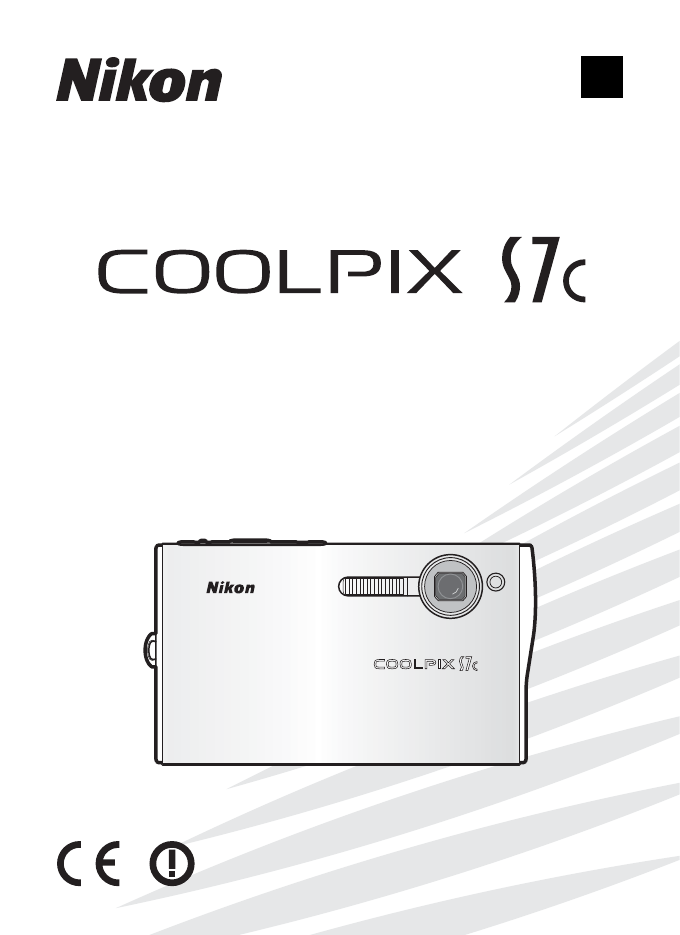
(En)
Printed in Japan
Fuji Bldg., 2-3 Marunouchi 3-chome, TR6H03(11)
Chiyoda-ku, Tokyo 100-8331, Japan 6MA22311--
No reproduction in any form of this manual, in whole or in
part (except for brief quotation in critical articles or
reviews), may be made without written authorization from
NIKON CORPORATION.
The Nikon Guide to Digital Photography
with the
En
DIGITAL CAMERA
Trademark Information
Apple, the Apple logo, Macintosh, Mac OS, and QuickTime are registered trademarks of
Apple Computer, Inc. Finder is trademark of Apple Computer, Inc. Microsoft and Windows
are registered trademarks of Microsoft Corporation. Internet is a trademark of Digital Equip-
ment Corporation. Adobe and Acrobat are registered trademarks of Adobe Systems Inc. The
SD logo is a trademark of the SD Card Association. PictBridge is a trademark. Face-priority AF
technology is provided by Identix®. Pictmotion is powered by muvee Technologies. ImageLink
and the ImageLink print system logo are trademarks of Eastman Kodak Company. D-Lighting
technology is provided by o Apical Limited. All other trade names mentioned in this manual
or the other documentation provided with your Nikon product are trademarks or registered
trademarks of their respective holders.
Apple Public Source License
This product includes Apple mDNS source code that is subject to the terms of the Apple Public
Source License located at URL http://developer.apple.com/darwin/.
Portions Copyright (c) 1999-2004 Apple Computer, Inc. All Rights Reserved.
This file contains Original Code and/or Modifications of Original Code as defined in and that
are subject to the Apple Public Source License Version 2.0 (the ‘License’). You may not use
this file except in compliance with the License.
Please obtain a copy of the License at http://www.opensource.apple.com/apsl/ and read it
before using this file.
The Original Code and all software distributed under the License are distributed on an ‘AS IS’
basis, WITHOUT WARRANTY OF ANY KIND, EITHER EXPRESS OR IMPLIED, AND APPLE
HEREBY DISCLAIMS ALL SUCH WARRANTIES, INCLUDING WITHOUT LIMITATION, ANY WAR-
RANTIES OF MERCHANTABILITY, FITNESS FOR A PARTICULAR PURPOSE, QUIET ENJOYMENT
OR NON-INFRINGEMENT. Please see the License for the specific language governing rights
and limitations under the License.
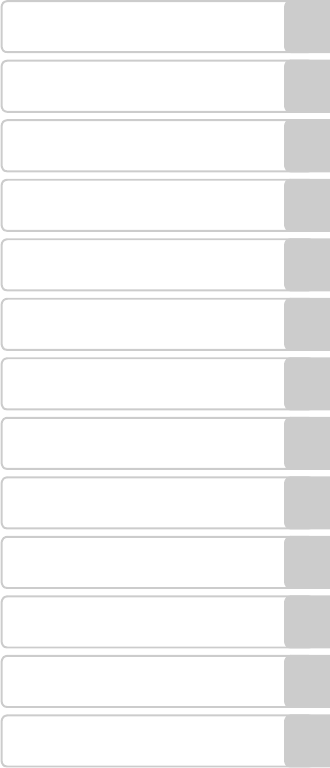
i
Introduction
First Steps
Basic Photography and
Playback: Auto Mode
Shooting Suited for the Scene - High-
sensitivity Shooting Mode, Scene Mode
Anti-shake Mode
One-Touch Portrait Mode
More on Playback
Movies
Voice Recordings
Connecting to Televisions,
Computers, and Printers
Shooting, Playback, and Setup
Menus
Wireless Transfer Mode
Technical Notes
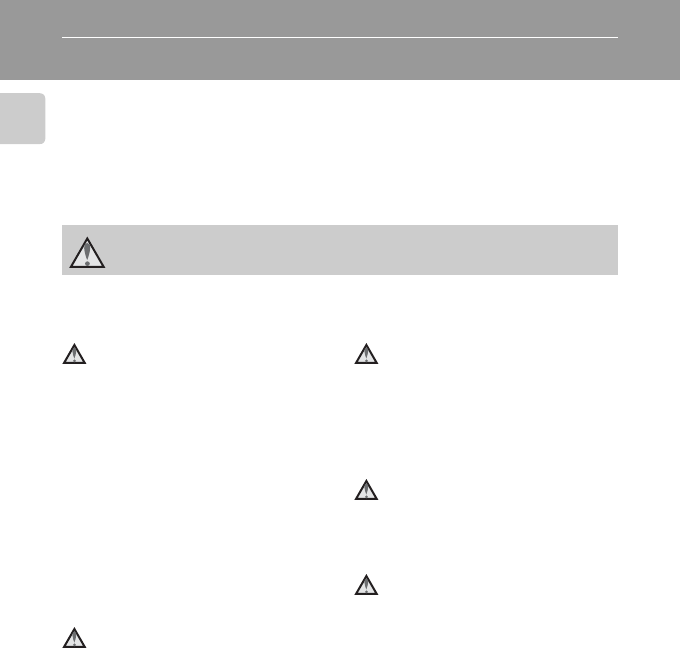
ii
Introduction
Introduction
For Your Safety
To prevent damage to your Nikon product or injury to yourself or to others,
read the following safety precautions in their entirety before using this
equipment. Keep these safety instructions where all those who use the prod-
uct will read them.
The consequences that could result from failure to observe the precautions
listed in this section are indicated by the following symbol:
WARNINGS
Turn off in the event of mal-
function
Should you notice smoke or an
unusual smell coming from the cam-
era or AC adapter, unplug the AC
adapter and, remove the battery
immediately, taking care to avoid
burns. Continued operation could
result in injury. After removing or
disconnecting the power source,
take the equipment to a Nikon-
authorized service representative for
inspection.
Do not disassemble
Touching the internal parts of the
camera or AC adapter could result
in injury. Repairs should be per-
formed only by qualified techni-
cians. Should the camera or AC
adapter break open as the result of
a fall or other accident, take the
product to a Nikon-authorized ser-
vice representative for inspection
after unplugging the product and/or
removing the battery.
Do not use the camera or AC
adapter in the presence of
flammable gas
Do not use electronic equipment in
the presence of flammable gas, as
this could result in explosion or fire.
Handle the camera strap
with care
Never place the strap around the
neck of an infant or child.
Keep out of reach of chil-
dren
Particular care should be taken to
prevent infants from putting the
battery or other small parts into
their mouths.
This icon marks warnings, information that should be read before using this
Nikon product to prevent possible injury.

iii
For Your Safety
Introduction
Observe caution when han-
dling the battery
The battery may leak or explode if
improperly handled. Observe the
following precautions when han-
dling the battery for use in this
product:
• Before replacing the battery, turn
the product off. If you are using
the AC adapter, be sure it is
unplugged.
•
Only use a rechargeable Nikon
EN-EL8 lithium-ion battery (supplied).
Charge the battery either by inserting
it in the camera and connecting the
supplied EH-64 AC adapter, or by
inserting it in an MH-62 battery
charger (available separately).
• When inserting the battery, do
not attempt to insert it upside
down or backwards.
• Do not short or disassemble the
battery or attempt to remove or
break the battery insulation or
casing.
• Do not expose the battery to
flame or to excessive heat.
• Do not immerse in or expose to
water.
• Replace the terminal cover when
transporting the battery. Do not
transport or store with metal
objects such as necklaces or hair-
pins.
• The battery is prone to leakage
when fully discharged. To avoid
damage to the product, be sure
to remove the battery when no
charge remains.
• Discontinue use immediately
should you notice any change in
the battery, such as discoloration
or deformation.
• If liquid from the damaged bat-
tery comes in contact with cloth-
ing or skin, rinse immediately with
plenty of water.
Observe the following pre-
cautions when handling the
AC charger
• Keep dry. Failure to observe this
precaution could result in fire or
electric shock.
• Dust on or near the metal parts of
the plug should be removed with
a dry cloth. Continued use could
result in fire.
• Do not handle the power cable or
go near the battery charger dur-
ing lightening storms. Failure to
observe this precaution could
result in electric shock.
• Do not damage, modify, forcibly
tug or bend the power cable,
place it under heavy objects, or
expose it to heat or flame. Should
the insulation be damaged and
the wires become exposed, take it
to a Nikon-authorized service rep-
resentative for inspection. Failure
to observe these precautions
could result in fire or electric
shock.
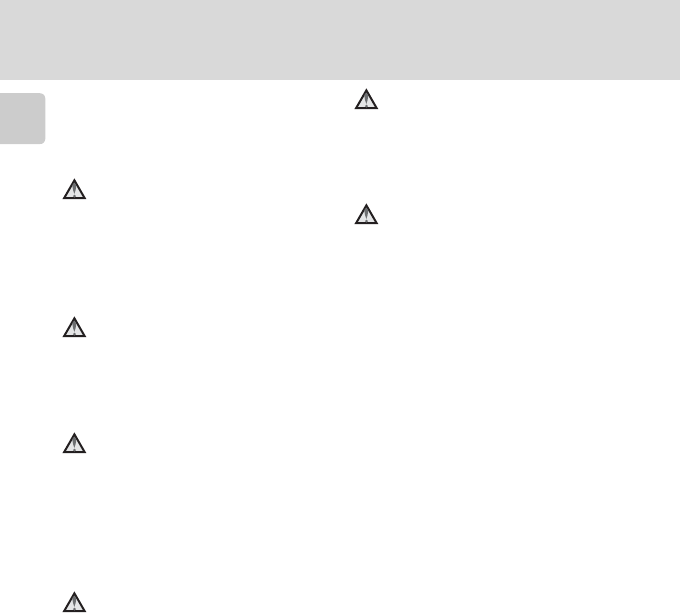
iv
For Your Safety
Introduction
• Do not handle the plug or battery
charger with wet hands. Failure to
observe this precaution could
result in electric shock.
Use appropriate cables
When connecting cables to the
input and output jacks, use only the
cables provided or sold by Nikon for
the purpose, to maintain compli-
ance with product regulations.
Handle moving parts with
care
Be careful that your fingers or other
objects are not pinched by the lens
cover or other moving parts.
CD-ROMs
The CD-ROMs supplied with this
device should not be played back on
audio CD equipment. Playing CD-
ROMs on an audio CD player could
cause hearing loss or damage the
equipment.
Observe caution when using
the flash
Using the flash close to your sub-
ject’s eyes could cause temporary
visual impairment. Particular care
should be observed if photograph-
ing infants, when the flash should
be no less than one meter (39 in.)
from the subject.
Do not operate the flash
with the flash window
touching a person or object
Failure to observe this precaution
could result in burns or fire.
Avoid contact with liquid
crystal
Should the monitor break, care
should be taken to avoid injury
caused by broken glass and to pre-
vent liquid crystal from the monitor
touching the skin or entering the
eyes or mouth.

v
Introduction
Notices
This product, which contains
encryption software developed in
the United States, is controlled by
the United States Export Administra-
tion Regulations and may not be
exported or re-exported to any
country to which the United States
embargoes goods. As of November
2005 the following countries were
subject to embargo: Cuba, Iran,
North Korea, Libya, Sudan, and
Syria.
Restrictions on Wireless Devices
The wireless transceiver included in
this product conforms to wireless
regulations in the country of sale
and is not for use in other countries
(products purchased in the EU or
EFTA can be used anywhere within
the EU and EFTA). Nikon does not
accept liability for use in other coun-
tries. Users who are unsure as to the
original country of sale should con-
sult with their local Nikon service
center or Nikon-authorized service
representative.
This restriction applies to wireless
operation only and not to any other
use of the product.
Notice for customers in the
U.S.A. and Canada
Federal Communications Com-
mission (FCC) and Industry of
Canada (IC)
Declaration of Conformity
This device complies with Part 15 of
the FCC rules and RSS-Gen of IC
rules. Operation of the device is sub-
ject to the following two conditions:
(1) this device may not cause harm-
ful interference, and (2) this device
must accept any interference
received, including interference that
may cause undesired operation.

vi
Notices
Introduction
FCC/IC RF Exposure Statement
The available scientific evidence
does not show that any health prob-
lems are associated with using low
power wireless devices. There is no
proof, however, that these low
power wireless devices are abso-
lutely safe. Low power wireless
devices emit low levels of radio fre-
quency energy (RF) in the micro-
wave range while being used.
Whereas high levels of RF can pro-
duce health effects (by heating tis-
sue), exposure to low-level RF that
does not produce heating effects
causes no known adverse health
effects. Many studies of low-level RF
exposures have not found any bio-
logical effects. Some studies have
suggested that some biological
effects might occur, but such find-
ings have not been confirmed by
additional research. Wireless LAN
Module (2143EB) has been tested
and found to comply with FCC/IC
radiation exposure limits set forth
for an uncontrolled equipment and
meets the FCC radio frequency (RF)
Exposure Guidelines in Supplement
C to OET65 and RSS-102 of the IC
radio frequency (RF) Exposure rules.
Please refer to the SAR test report
that was uploaded at FCC website.
This device should not be co-located
or operated in conjunction with any
other antenna or transmitter.
Notice for customers in the
U.S.A.
FCC RF Interference Statement
This equipment has been tested and
found to comply with the limits for a
Class B digital device, pursuant to
Part 15 of the FCC rules. These lim-
its are designed to provide reason-
able protection against harmful
interference in a residential installa-
tion. This equipment generates,
uses, and can radiate radio fre-
quency energy and, if not installed
and used in accordance with the
instructions, may cause harmful
interference to radio communica-
tions. However, there is no guaran-
tee that interference will not occur
in a particular installation. If this
equipment does cause harmful
interference to radio or television
reception, which can be deter-
mined by turning the equipment off
and on, the user is encouraged to
try to correct the interference by
one or more of the following mea-
sures:
• Reorient or relocate the receiving
antenna.
• Increase the separation between
the equipment and receiver.
• Connect the equipment into an
outlet on a circuit different from
that to which the receiver is con-
nected.
• Consult the dealer or an experi-
enced radio/television technician
for help.

vii
Notices
Introduction
CAUTIONS
Modifications
The FCC requires the user to be
notified that any changes or modifi-
cations made to this device that are
not expressly approved by Nikon
Corporation may void the user’s
authority to operate the equipment.
Interface Cables
Use the interface cables sold or pro-
vided by Nikon for your equipment.
Using other interface cables may
exceed the limits of Class B Part 15
of the FCC rules.
Notice for customers in the State
of California
WARNING: Handling the cord on
this product will expose you to lead,
a chemical known to the State of
California to cause birth defects or
other reproductive harm. Wash
hands after handling.
Nikon Inc.,
1300 Walt Whitman Road
Melville, New York 11747-3064
USA
Tel: 631-547-4200
Notice for customers in Canada
CAUTION
This Class B digital apparatus com-
plies with Canadian ICES-003.
ATTENTION
Cet appareil numérique de la classe
B est conforme à la norme NMB-003
du Canada.
Notice for customers in Europe
Hereby, Nikon, declares that this
digital camera is in compliance with
the essential requirements and other
relevant provisions of Directive
1999/5/EC.
Notice for customers in France
Outdoor use of the wireless trans-
ceiver is prohibited in France.
Symbol for Separate Collec-
tion in European Countries
This symbol indicates that
this product is to be col-
lected separately.
The following apply only to
users in European coun-
tries:
• This product is designated for
separate collection at an appropri-
ate collection point. Do not dis-
pose of as household waste.
• For more information, contact the
retailer or the local authorities in
charge of waste management.

viii
Introduction
Table of Contents
Introduction .....................................................................................................ii
For Your Safety..................................................................................................ii
WARNINGS ................................................................................................... ii
Notices................................................................................................................ v
About This Manual............................................................................................1
Information and Precautions............................................................................2
Parts of the Camera...........................................................................................6
Attaching the Camera Strap ..........................................................................6
The Monitor.......................................................................................................8
Shooting ....................................................................................................... 8
Playback........................................................................................................9
Basic Operations ..............................................................................................10
The o (shooting/playback) Button......................................................... 10
The D (mode) Button............................................................................... 10
The m Button ......................................................................................... 11
The Rotary Multi Selector ............................................................................ 12
Help Displays...............................................................................................13
First Steps........................................................................................................14
The COOL-STATION and AC Adapter .............................................................14
The COOL-STATION ....................................................................................14
The AC Adapter .......................................................................................... 15
Inserting the Battery ....................................................................................... 16
Removing the Battery .................................................................................. 17
Turning On and Off the Camera..................................................................17
Charging the Battery....................................................................................... 18
Setting Display Language, Date, and Time.................................................... 20
Inserting Memory Cards.................................................................................. 22
Removing Memory Cards ............................................................................23

ix
Table of Contents
Introduction
Basic Photography and Playback: Auto Mode .............................................24
Step 1 Turn the Camera On and Select L (Auto) Mode..............................24
Indicators Displayed in L (Auto) Mode ......................................................25
Step 2 Frame a Picture ....................................................................................26
Using the Zoom...........................................................................................26
Electronic VR ...............................................................................................27
Step 3 Focus and Shoot ...................................................................................28
Step 4 Viewing and Deleting Pictures............................................................30
Full-Frame Playback .....................................................................................30
Deleting Pictures .........................................................................................30
Using the Flash ................................................................................................ 32
Taking Pictures with the Self-Timer ............................................................... 34
Macro Close-up Mode ..................................................................................... 35
Shooting Suited for the Scene - High-sensitivity Shooting Mode,
Scene Mode ....................................................................................................36
High-sensitivity Shooting Mode ..................................................................... 36
Assist Modes and Scene Modes ......................................................................37
Assist Modes ....................................................................................................38
Taking Pictures in Assist Modes ...................................................................38
B Portrait Assist ......................................................................................... 39
E Landscape Assist ....................................................................................40
P Sports Assist ........................................................................................... 41
D Night Portrait Assist................................................................................42
Scene Modes ....................................................................................................43
Taking Pictures in Scene Modes...................................................................43
Features ...................................................................................................... 44
Anti-shake Mode............................................................................................49
Shooting in Anti-shake Mode......................................................................... 49
One-Touch Portrait Mode..............................................................................50
Taking Pictures in the One-Touch Portrait Mode..........................................50
The One-Touch Portrait Menu........................................................................51

x
Table of Contents
Introduction
More on Playback ..........................................................................................52
Viewing Multiple Pictures: Thumbnail Playback ........................................... 52
Taking a Closer Look: Playback Zoom............................................................ 53
Editing Pictures................................................................................................ 54
Creating a Cropped Copy: Crop ..................................................................55
Enhancing Brightness and Contrast: D-Lighting ...........................................56
Compensating Blurred Images: Electronic VR ...............................................57
H Resizing Pictures: Small Picture...............................................................58
Voice Memos: Recording and Playback ......................................................... 59
Viewing Pictures by Date ................................................................................60
Pictmotion by muvee ......................................................................................65
Movies.............................................................................................................70
Recording Movies ............................................................................................ 70
The Movie Menu ............................................................................................. 71
Selecting Movie Options..............................................................................72
Time-Lapse Movies ......................................................................................73
Stop-Motion Movies....................................................................................74
Auto-Focus Mode........................................................................................ 75
Electronic VR ...............................................................................................75
Movie Playback................................................................................................76
Deleting Movie Files ....................................................................................76
Voice Recordings............................................................................................77
Making Voice Recordings ............................................................................... 77
Changing the Sound Quality ..........................................................................78
Sound Quality ............................................................................................. 78
Playing Voice Recordings ................................................................................ 79
Copying Voice Recordings ..............................................................................81
Connecting to Televisions, Computers, and Printers ...................................82
Connecting to a TV.......................................................................................... 82
Connecting to a Computer ............................................................................. 83
Before Connecting the Camera ................................................................... 83
Setting the USB Option ............................................................................... 84
Transferring Pictures to a Computer ............................................................ 85
Connecting to a Printer................................................................................... 87
Connecting the Camera and Printer ............................................................88
Printing Pictures One at a Time.................................................................... 89
Printing Multiple Pictures............................................................................. 90
Creating a DPOF Print Order: Print Set .......................................................... 93

xi
Table of Contents
Introduction
Connecting to a ImageLink-compatible Printer ............................................95
Removing the Dock Insert............................................................................ 95
Shooting, Playback, and Setup Menus..........................................................96
Shooting Options: The Shooting Menu ......................................................... 96
Displaying the Shooting Menu and High-sensitivity Menu............................97
Z Image Mode ..........................................................................................97
d White Balance........................................................................................99
I Exp. +/–................................................................................................101
q Continuous..........................................................................................102
A Best Shot Selector (BSS) ....................................................................... 104
W ISO Sensitivity.......................................................................................105
d Color Options.......................................................................................105
k AF Area Mode...................................................................................... 106
c Electronic VR........................................................................................106
Restrictions on Camera Settings ................................................................ 107
Playback Options: The Playback Menu ........................................................ 108
w Print Set ...............................................................................................109
z Slide Show ...........................................................................................110
A Delete ..................................................................................................111
D Protect ...............................................................................................111
E Transfer Marking ................................................................................ 112
G Rotate Image .......................................................................................112
L Copy.................................................................................................... 113
Basic Camera Setup: The Setup Menu.......................................................... 114
Displaying the Setup Menu........................................................................115
R Menus..................................................................................................115
H Quick Startup ....................................................................................... 116
V Welcome Screen ..................................................................................116
W Date.....................................................................................................117
Z Monitor Settings.................................................................................. 120
f Date Imprint.........................................................................................121
u AF Assist .............................................................................................123
h Sound Settings..................................................................................... 123
I Record Orientation ...............................................................................124
i Auto Off .............................................................................................. 124
M Format Memory/O Format Card .......................................................... 125
j Language .............................................................................................126
k Interface............................................................................................... 126
n Reset All............................................................................................... 127
B Firmware Version .................................................................................129

xii
Table of Contents
Introduction
Wireless Transfer Mode ...............................................................................130
What is Wireless Transfer Mode? .................................................................130
Features of Wireless Transfer Mode ...........................................................130
The Features Available in the Wireless Transfer Mode............................... 132
For Connection via Home Wireless LAN ......................................................134
Configuration Procedure ...........................................................................134
Configuring the Camera............................................................................ 136
Settings for the Setup Utility......................................................................141
Transferring Pictures ..................................................................................... 143
Establishing a Wireless Connection............................................................143
Uploading Pictures to COOLPIX CONNECT ................................................145
Transferring Pictures to a Computer (PC Connection) ................................ 149
Transferring Pictures Not Yet Saved on a Computer - Easy Transfer ...........150
Transferring Pictures Taken on Selected Date - Shooting Date ................... 151
Transferring Selected Pictures - Selected Images ........................................ 152
Immediately Transferring Pictures Taken - Shoot & Transfer.......................153
Transferring Pictures Marked with the Transfer Icon - Marked Images........ 155
Transferring Pictures Using a Computer - PC Mode ................................... 156
Printing Pictures (Wireless Printing) ............................................................ 158
Technical Notes ............................................................................................159
Optional Accessories ..................................................................................... 159
Approved Memory Cards ..........................................................................159
Image File and Folder Names ....................................................................... 160
Caring for the Camera ..................................................................................162
Cleaning ...................................................................................................164
Storage ..................................................................................................... 164
Error Messages............................................................................................... 165
Troubleshooting ............................................................................................ 171
Supported Standards.....................................................................................177
Specifications ................................................................................................. 178
Index............................................................................................................... 182

1
Introduction
About This Manual
Thank you for your purchase of a Nikon COOLPIX S7c digital camera. This
manual has been written to help you enjoy taking pictures with your Nikon
digital camera. Read this manual thoroughly before use, and keep it where
all those who use the product will read it.
Symbols and Conventions
To make it easier to find the information you need, the following symbols
and conventions are used:
Notations
• A Secure Digital (SD) memory card is referred to as a “memory card.”
• The setting at the time of purchase is referred to as the “default setting.”
• Menu items, options, and messages displayed in the camera monitor are
shown in brackets ([ ]).
Screen Samples
In this manual, images are sometimes omitted from monitor display samples
so that monitor indicators can be more clearly shown.
Illustrations and Screen Display
Illustrations and text displays shown in this manual may differ from actual
display.
kMemory Cards
Pictures taken with this camera can be stored in the camera’s internal memory or on remov-
able memory cards. If a memory card is inserted, all new pictures will be stored on the mem-
ory card and delete, playback, and format operations will apply only to the pictures on the
memory card. The memory card must be removed before the internal memory can be format-
ted or used to store, delete, or view pictures.
This icon marks cautions, infor-
mation that should be read
before use to prevent damage to
the camera.
This icon marks tips, additional
information that may be helpful
when using the camera.
This icon marks notes, informa-
tion that should be read before
using the camera.
This icon indicates that more
information is available else-
where in this manual or in the
Quick Start Guide.
c
lj
k
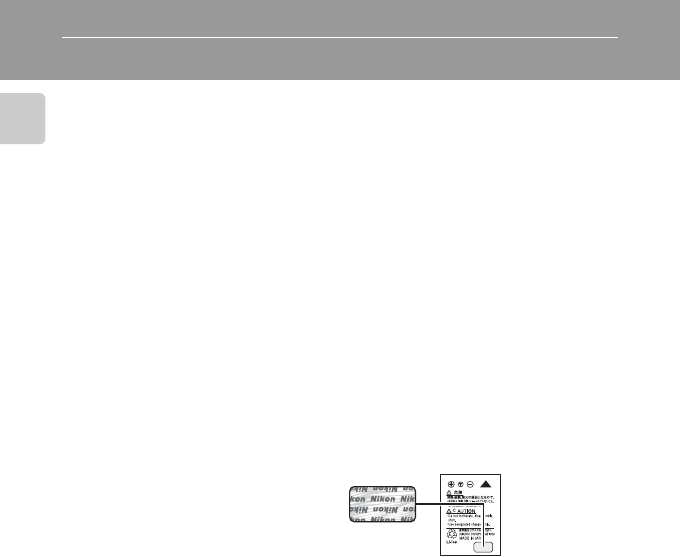
2
Introduction
Information and Precautions
Life-Long Learning
As part of Nikon’s “Life-Long Learning” commitment to ongoing product support and educa-
tion, continually updated information is available online at the following sites:
• For users in the U.S.A.: http://www.nikonusa.com/
• For users in Europe and Africa: http://www.europe-nikon.com/support/
• For users in Asia, Oceania, and the Middle East: http://www.nikon-asia.com/
Visit these sites to keep up-to-date with the latest product information, tips, answers to fre-
quently asked questions (FAQs), and general advice on digital imaging and photography.
Additional information may be available from the Nikon representative in your area. See the
following URL for contact information: http://nikonimaging.com/
Use Only Nikon Brand Electronic Accessories
Nikon COOLPIX cameras are designed to the highest standards and include complex elec-
tronic circuitry. Only Nikon brand electronic accessories (including battery chargers, batteries,
and AC chargers) certified by Nikon specifically for use with this Nikon digital camera are
engineered and proven to operate within the operational and safety requirements of this
electronic circuitry.
THE USE OF NON-NIKON ELECTRONIC ACCESSORIES COULD DAMAGE THE CAMERA AND
MAY VOID YOUR NIKON WARRANTY.
For more information about Nikon brand accessories, contact a local authorized Nikon dealer.
Before Taking Important Pictures
Before taking pictures on important occasions (such as at weddings or before taking the cam-
era on a trip), take a test shot to ensure that the camera is functioning normally. Nikon will
not be held liable for damages or lost profits that may result from product malfunction.
About the Manuals
• No part of the manuals included with this product may be reproduced, transmitted, tran-
scribed, stored in a retrieval system, or translated into any language in any form, by any
means, without Nikon’s prior written permission.
• Nikon reserves the right to change the specifications of the hardware and software
described in these manuals at any time and without prior notice.
• Nikon will not be held liable for any damages resulting from the use of this product.
• While every effort has been made to ensure that the information in these manuals is accu-
rate and complete, we would appreciate it were you to bring any errors or omissions to the
attention of the Nikon representative in your area (address provided separately).
* Holographic seal: Identifies this
device as an authentic Nikon
product.
EN-EL8
rechargeable
battery

3
Information and Precautions
Introduction
Notice Concerning Prohibition of Copying or Reproduction
Note that simply being in possession of material that has been digitally copied or reproduced
by means of a scanner, digital camera or other device may be punishable by law.
•Items prohibited by law from being copied or reproduced
Do not copy or reproduce paper money, coins, securities, government bonds, or local gov-
ernment bonds, even if such copies or reproductions are stamped “Sample.”
The copying or reproduction of paper money, coins, or securities which are circulated in a
foreign country is prohibited.
Unless the prior permission of the government has been obtained, the copying or repro-
duction of unused postage stamps or post cards issued by the government is prohibited.
The copying or reproduction of stamps issued by the government and of certified docu-
ments stipulated by law is prohibited.
•Cautions on certain copies and reproductions
The government has issued cautions on copies or reproductions of securities issued by pri-
vate companies (shares, bills, checks, gift certificates, etc.), commuter passes, or coupon
tickets, except when a minimum of necessary copies are to be provided for business use by
a company. Also, do not copy or reproduce passports issued by the government, licenses
issued by public agencies and private groups, ID cards, and tickets, such as passes and meal
coupons.
•Comply with copyright notices
The copying or reproduction of copyrighted creative works such as books, music, paintings,
woodcut prints, maps, drawings, movies, and photographs is governed by national and
international copyright laws. Do not use this product for the purpose of making illegal cop-
ies or to infringe copyright laws.
Disposing of Data Storage Devices
Please note that deleting images or formatting data storage devices such as memory cards or
built-in camera memory does not completely erase the original image data. Deleted files can
sometimes be recovered from discarded storage devices using commercially available soft-
ware, potentially resulting in the malicious use of personal image data. Ensuring the privacy of
such data is the user’s responsibility.
Before discarding a data storage device or transferring ownership to another person, erase all
data using commercial deletion software, or format the device and then completely refill it
with images containing no private information (for example, pictures of empty sky). Be sure to
also replace any pictures selected for the welcome screen (c116). Care should be taken to
avoid injury or damage to property when physically destroying data storage devices.

4
Information and Precautions
Introduction
Note the following important points before using this product’s wireless LAN function.
Restrictions of Use Under Radio Laws and Precautions when
Using Radio Transmissions
• The wireless transceiver included in this product conforms to wireless regulations in the
country of sale and is not for use in other countries (products purchased in the EU or EFTA
can be used anywhere within the EU and EFTA).
• When using the LAN function of this product, the product will search for wireless networks
automatically. At this time, the product may display wireless networks (SSID) for which you
are not an authorized user. Use of such a wireless network may be regarded as unautho-
rized access. Never connect to an SSID that you are not authorized to use.
• Always keep in mind that radio transmission or reception of data is subject to interception
by third parties.
Personal Information Management and Disclaimer
• User information registered and configured on the product, including wireless LAN connec-
tion settings and other personal information, is susceptible to alteration and loss resulting
from operational error, static electricity, accident, malfunction, repair or other handling.
Always keep separate copies of important information. Nikon is not responsible for any
direct or indirect damages or lost profits resulting from alteration or loss of content that is
not attributable to Nikon.
• Before discarding this product or transferring it to another owner, it is recommended that
you use the included Wireless Camera Setup Utility to delete all user information registered
and configured on the product, including wireless LAN connection settings and other per-
sonal information.
• Nikon is not responsible for any communication charges stemming from unauthorized
access to a public wireless LAN by third parties, or any other damages resulting from theft
of the product.
• Nikon is not responsible for any damages stemming from unauthorized use of e-mail
addresses stored resulting from theft of the product.
Precautions and Limitations when Using the COOLPIX CONNECT Service
• Connection to a public wireless LAN for the COOLPIX CONNECT service (hereinafter
referred to as Service) is not guaranteed or supported outside the United States. Nikon is
not responsible for any direct or indirect damages or lost profits resulting from any connec-
tion made at your own responsibility.
• Use of this Service over a public wireless LAN connection requires a T-Mobile HotSpot sub-
scription if the product was originally purchased in the United States.
• Make sure you specify the e-mail addresses of recipients correctly. An error will not be indi-
cated if the recipient is wrong, nor will an error notification be sent to your e-mail address.
• Access to a COOLPIX CONNECT web site (site for viewing pictures) is not limited to this Ser-
vice. A page can be browsed by anyone after the page’s URL is provided to them or made
public.
• Images uploaded to a COOLPIX CONNECT server are stored for up to two weeks.

5
Information and Precautions
Introduction
• Nikon makes no guarantees whatsoever concerning the ability of this Service to store or
safeguard images. Be sure to maintain separate back-up copies of all important images.
Nikon is not responsible for any direct or indirect damages or lost profits resulting from
alteration or loss of content that is not attributable to Nikon.
• Your use of the Service is completely at your own responsibility, and Nikon accepts no
responsibility on your behalf.
• By using the Service, you agree not to upload, post, e-mail or otherwise transmit or com-
municate any material through the Service that is obscene, pornographic, unlawful, threat-
ening, an invasion of any privacy or publicity rights of any party, defamatory, libelous,
illegal or otherwise objectionable, or infringes any copyright, trademark, or other intellec-
tual property or contractual right of any party.
• You hereby irrevocably and unconditionally waive, discharge and release Nikon, its affiliates
and subsidiaries, and their respective officers, directors, employees, agents, legal represen-
tatives, successors and assigns (“Nikon Parties”) from and against any and all claims by or
against you related to any material you post, e-mail or otherwise transmit or communicate
through the Service.
• Furthermore, you agree to indemnify, defend, and hold harmless the Nikon Parties from
and against any claims, damages, liabilities, costs and expenses (including reasonable attor-
neys’ and professionals’ fees and litigation costs) related to any material you post, e-mail or
otherwise transmit or communicate through the Service.
• You understand that (i) your right to use the Service may be terminated by Nikon and/or (ii)
the materials you post, e-mail or otherwise transmit or communicate through the Service
may be deleted or removed by Nikon in the event you breach the foregoing, or any other
terms and conditions that Nikon may require in connection with your use of the Service.
• This Service is subject to change, suspension, or termination without notice.
• Be sure to read Nikon’s “Privacy Management Policy” at the website located at the follow-
ing URL: http://www.nikon.co.jp/main/eng/privacy/index.htm
• If you are in Europe, click on your country of residence at the website located at the follow-
ing URL and follow the link <privacy policy>: http://www.europe-nikon.com/support/
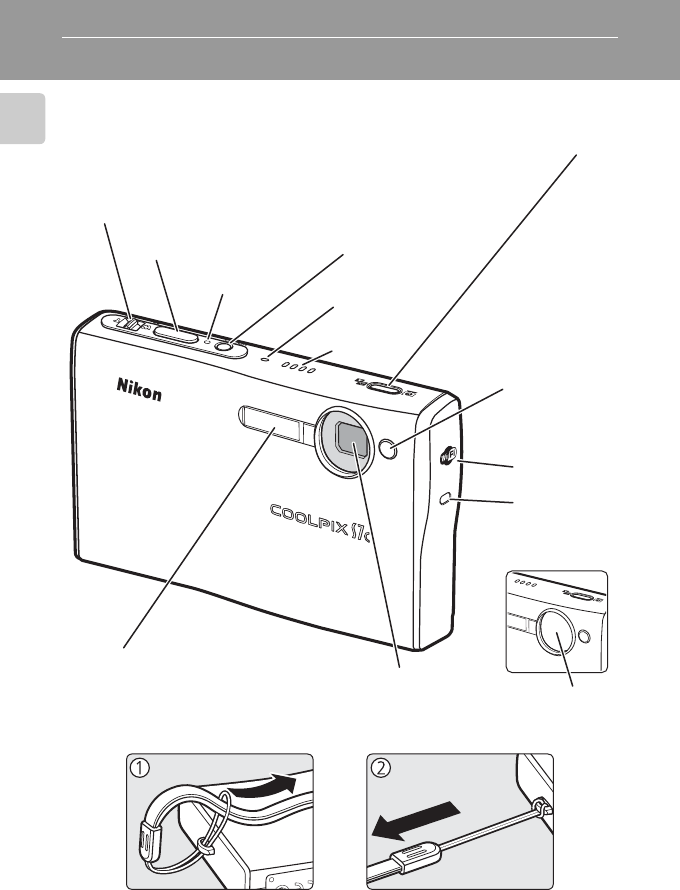
6
Introduction
Parts of the Camera
Attaching the Camera Strap
Power-on lamp
(c24)
Speaker
(c59, 76)
Self-timer lamp
(c34)
AF-assist illumi-
nator (LED;
c33, 37, 123)
Built-in flash (c32)
Built-in microphone
(c59, 70)
Shutter-release button
(c28) Power switch (c24)
m (one-touch portrait) button
(c50)
u (D-Lighting) button (c56)
Zoom control (c26)
See also:
•t (wide): c26
•v (tele): c26
•j (thumbnail playback): c52
•k (playback zoom): c53
•l (help): c13
Lens cover
closed
Lens cover
Lens (c162, 178)
Antenna
(c144, 157)
Wireless LED
(c144)
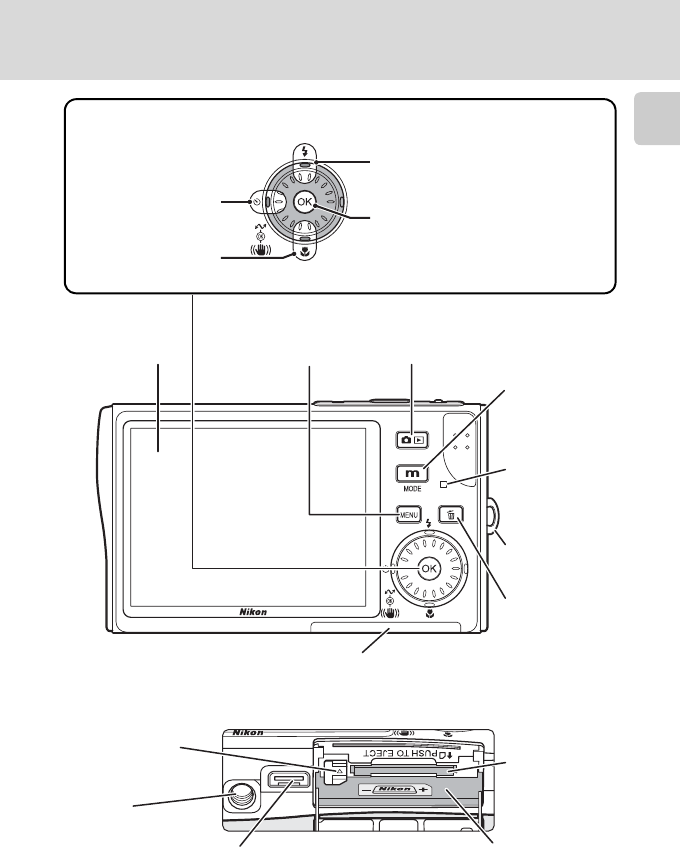
7
Parts of the Camera
Introduction
Indicator lamp
(c18, 73, 77,
103)/Flash
lamp (c33)
Monitor (c8)
Multi connector (c19)
Tripod
socket
o (shooting/playback)
button (c10, 30)
T (delete)
button
(c30, 31, 59,
76)
Battery-chamber/memory
card slot cover (c16, 22)
Battery chamber (c16)
Memory card
slot (c22)
D (mode)
button (c10)
Battery latch
(c16, 17)
J (flash mode) (c32)
d (apply selection) button (c12)
•F anti-shake mode (c49)/
electronic vibration reduction
(c57)
•g (transfer picture) button
(c83, 85)
H (self-timer)
(c34)
F (macro close-up
mode) (c35)
Rotary multi selector (c12)
m button
(c11, 97, 108)
Eyelet for
camera strap
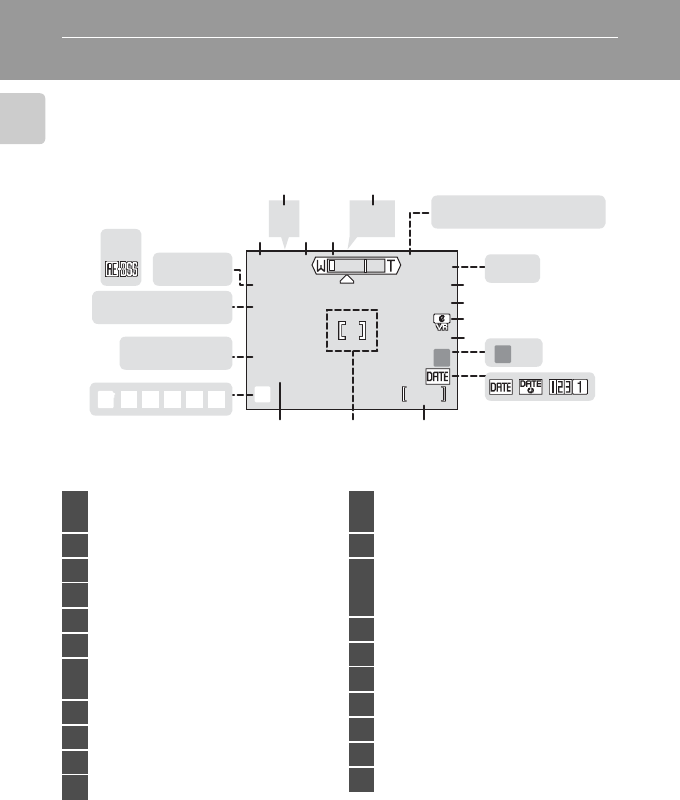
8
Introduction
The Monitor
The following indicators may appear in the monitor during shooting and
playback (actual display varies with current camera settings).
Shooting
* Differs according to the current shooting mode. Refer to the sections on each mode
for details.
9999
9999
MM
ww
WW
HH
s
9999
+1.0
+1.0
+1.0
10
10
10
E
II
CC
gg
qq
MBBFF
AA
qwz
qwz
qwz
fghijl
fghijl
fghijl
CDBA
CDBA
CDBA
FEdehi
WYY
MO
M O
MO
zABCD
ABCD
zABCD
pp
GG
8
9
10
11
141516
17
18
19
134
526
7
20
21
12
13
1Shooting mode*
.................... 24, 36, 37, 49, 70, 77
2Exposure lock ............................. 48
3Macro close-up mode................. 35
4Zoom indicator..................... 26, 35
5Focus indicator ........................... 28
6Flash mode ................................ 32
7Internal memory/memory card
indicator .................................... 25
8Battery level indicator ................. 24
9ISO sensitivity (ISO equivalent) .... 33
10 Vibration reduction icon............. 49
11 Self-timer indicator..................... 34
12 “Date not set” indicator ........... 165
Time zone indicator .................. 117
13 Date imprint ............................. 121
14
Number of exposures
remaining (still pictures).............. 24
Movie length ..............................70
15 Focus area .......................... 28, 106
16 Exposure compensation value...101
17 Image mode ............................... 97
18 Color options ........................... 105
19 White balance mode .................. 99
20 Best shot selector (BSS)............. 104
21 Continuous shooting mode ......102
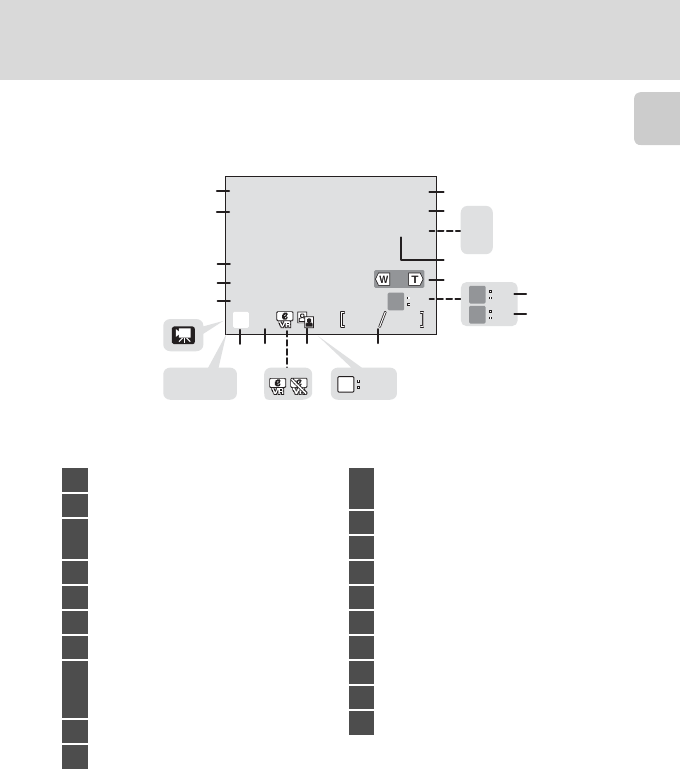
9
The Monitor
Introduction
Playback
100NIKON
100NIKON
12:00
12:00
12:00
100NIKON
9999.JPG
9999.JPG
9999.JPG
2006.10.10
2006.10.10
2006.10.10
9999
9999
9999
9999
O
MMww
99999999
N
DD
ww
EE
O
EPP
hh
MM
OO
O
N O
PPN
OK
START
START
START
IJK
IJK
IJK
1
2
5
3
6
10
7
4
812 9
11
ab
13
15
14
16
17
18
19
20
1Current folder .......................... 160
2File number and type................ 160
3Internal memory/memory card
indicator .................................... 25
4Battery level indicator ................. 24
5Volume indicator.................. 59, 76
6Voice memo recording guide...... 59
7Voice memo playback guide....... 59
8
Current frame number/total
number of frames ...................... 30
Movie length.............................. 76
9D-Lighting icon .......................... 56
10 Movie playback indicator............ 76
11 a Compensated image
b Electronic VR not available....... 57
12 Voice memo icon........................ 59
13 Image mode ............................... 97
14 Small picture .............................. 58
15 Movie indicator .......................... 76
16 Protect icon .............................. 111
17 Print-order icon .......................... 93
18 Transfer icon ...................... 86, 112
19 Time of recording ....................... 20
20 Date of recording ....................... 20
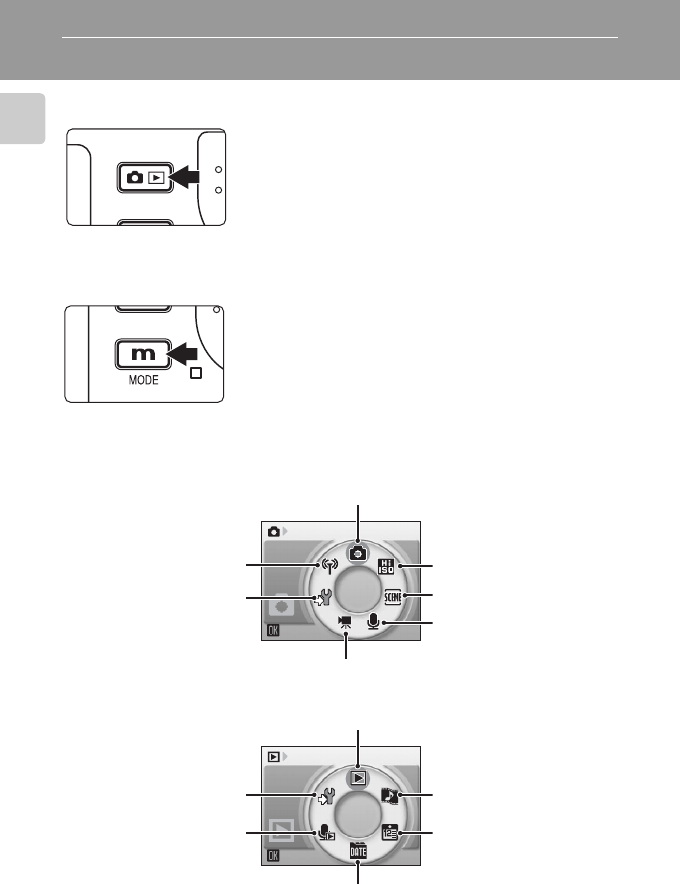
10
Introduction
Basic Operations
The o (shooting/playback) Button
The D (mode) Button
Press D during shooting or playback to display
each mode-selection menu. Use the rotary multi
selector (c12) to choose the desired mode.
•Press o to switch between the mode-selec-
tion menus for shooting mode and playback
mode.
Shooting Modes
Playback Modes
Press o once in shooting mode to enter full-
frame playback; press again to switch back to shoot-
ing mode.
If the camera is turned off, press o for about a
second to turn the camera on in playback mode
(c30).
Shooting
Auto mode (c24)
Voice recording mode
(c77)
Scene mode (c37)
High-sensitivity shoot-
ing mode (c36)
Movie mode (c70)
Setup mode (c114)
Wireless transfer mode
(c130)
Play
Playback mode (c30)
Pictmotion mode
(c65)
Calendar mode
(c60)
List by date mode (c61)
Voice playback mode
(c79)
Setup mode (c114)
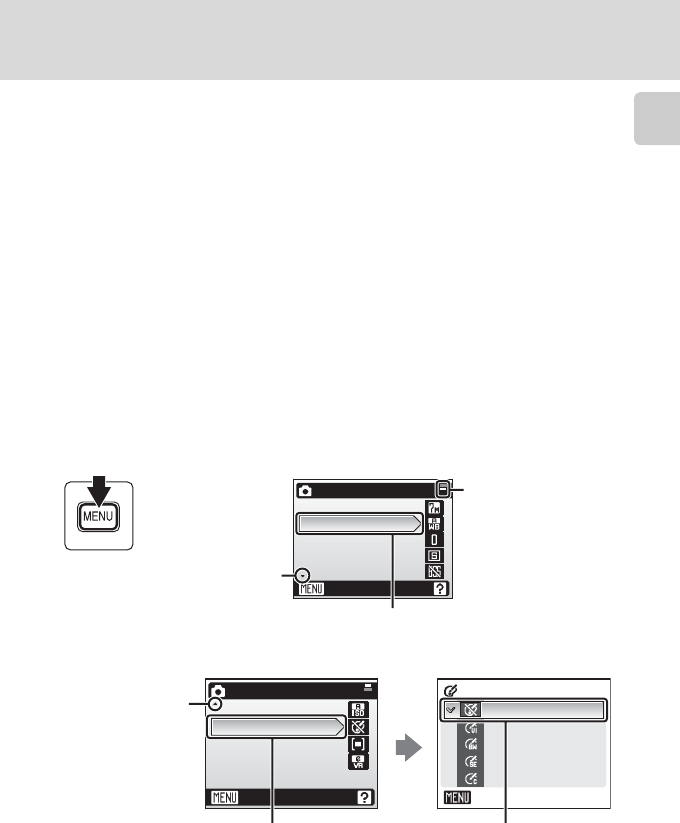
11
Basic Operations
Introduction
The m Button
Press m to display the menu for the selected mode. Use the rotary multi
selector to navigate the menus (c12).
*1 To display the anti-shake menu, enter anti-shake mode by pressing F
and then press m.
*2 To display the one-touch portrait menu, enter one-touch portrait mode by
pressing m and then press m.
*3 To display the setup menu, choose Z in the mode-selection menu and
then press d (c114).
•LShooting menu (c96) • iPlayback menu (c108)
•K High-sensitivity menu (c36) • JCalendar menu (c64)
•nScene menu (c37) • LList-by-date menu (c64)
•FAnti-shake menu*1 (c49) • wPrint menu (c90)
•m
One-touch portrait menu
*2
(
c
51)
•ZSetup menu*3 (c114)
•TMovie menu (c71) • aShoot-and-transfer menu
(c154)
Shooting menu
Exit
Image mode
White balance
Exp. +/-
Continuous
BSS
The selected option
Displayed when
there are one or
more menu items
to follow
Displayed when the
menu contains two
or more pages
Displayed when
there are one or
more previous
menu items
Shooting menu
Exit
ISO sensitivity
Color options
AF area mode
Electronic VR
Color options
Exit
Standard color
Black-and-white
Black-and-white
Sepia
Sepia
Cyanotype
Cyanotype
Vivid color
Vivid color
Black-and-white
Sepia
Cyanotype
Vivid color
Press the rotary multi selec-
tor J or d to proceed to
the next set of options.
Press the rotary multi
selector J or d to
apply selection.
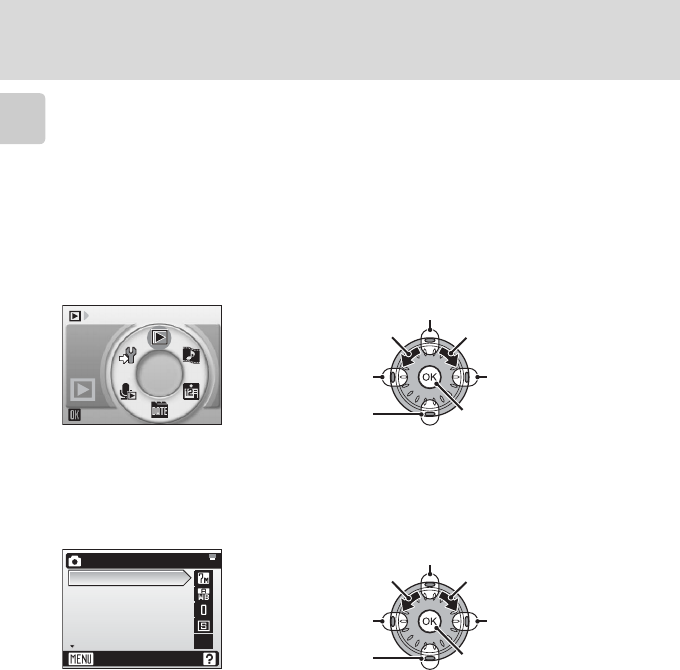
12
Basic Operations
Introduction
The Rotary Multi Selector
The rotary multi selector is made up of the outer ring, the rotating inner ring
(between the outer ring and
d
button), and the
d
button. When selecting
menus or pictures, you can either press the outer ring up, down, left, or right, or
rotate the inner ring. When choosing from numerous menu items or pictures, it is
recommended to rotate the inner ring for easy scrolling, and faster operation.
This section describes standard uses of the rotary multi selector to select modes,
select menu options, and to apply selection.
For the Mode-selection Menu
• To move the highlight clockwise, turn clockwise, press down or right.
• To move the highlight counterclockwise, turn counterclockwise, press up or left.
• To apply selection, press d.
For the Menu Screen
• To move the highlight upward, turn counterclockwise, or press up.
• To move the highlight downward, turn clockwise, or press down.
• To apply selection, press right or d.
• To cancel setting and return to the previous screen, press left.
kNotes on the Rotary Multi Selector
• In many cases, you can choose how to use the rotary multi selector to perform an opera-
tion. For example, rotating the selector clockwise and pressing the selector right may pro-
duce the same results. Since the selector can be used in various ways, concrete descriptions
such as “Press the rotary multi selector J” are included only in cases where necessary.
• In the manual, the button indicating up, down, left, and right of the rotary multi selector is
shown as GHIJ.
Press up.
Turn clockwise.
Press right.
Press down.
Press left.
Turn counterclockwise.
Play
Press d.
Press up.
Turn clockwise.
Press right.
Press d.
Press down.
Press left.
Turn counterclockwise.
B
Shooting menu
Exit
Image mode
White balance
Exp. +/-
Continuous
BSS
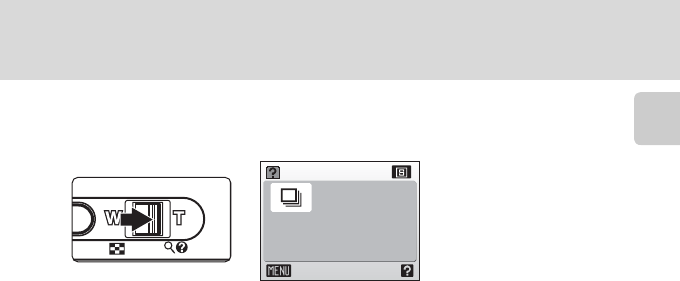
13
Basic Operations
Introduction
Help Displays
Press the zoom control to v (l) to view a description of the currently
selected menu option.
• Use the rotary multi selector to show the previous or next menu option.
•Press d to display the shooting menu or setup menu for the selected
menu option.
• To return to the original menu, press the zoom control to v (l) again.
•Press m to return to shooting or playback mode.
Continuous
Exit
Keep the
shutter-release button
pressed to take pictures
continuously.
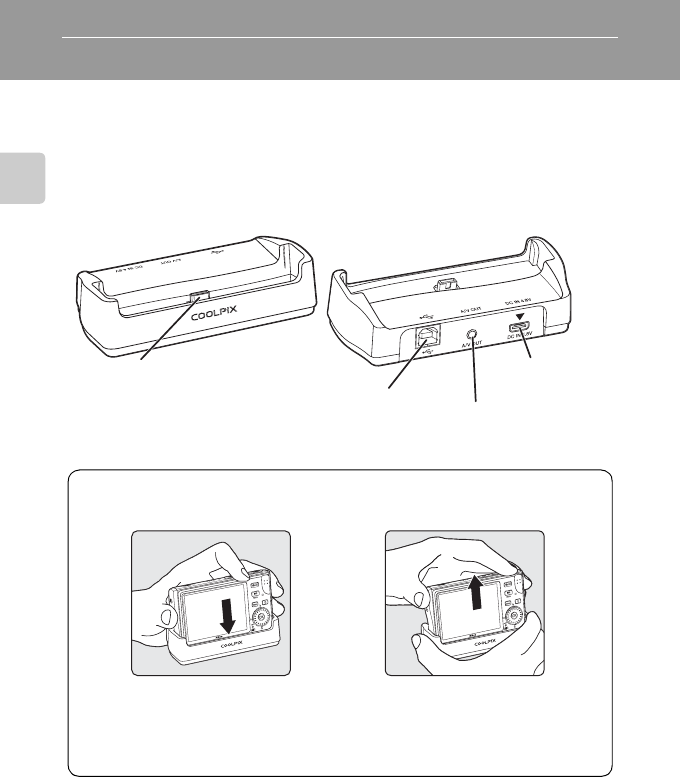
14
First Steps
First Steps
The COOL-STATION and AC Adapter
The COOL-STATION
The supplied MV-15 COOL-STATION can be used to:
• Charge the camera battery (when the camera is turned off) (c18)
• View pictures on a television (c82)
• Copy pictures to a computer (c83)
• Print pictures via direct USB connection (c87)
jNote on the Power Cord Supplied for the Camera (c15)
Only use the power cord for the EH-64 AC adapter supplied for the COOLPIX S7c.
Camera connector
USB connector
(c85, 88) Audio / video connec-
tor (c82)
DC-IN connector
(c15)
Placing the Camera in
the COOL-STATION Removing the Camera
The multi connector should be
fully inserted in the COOL-
STATION camera connector as
shown.
Remove the camera as shown.
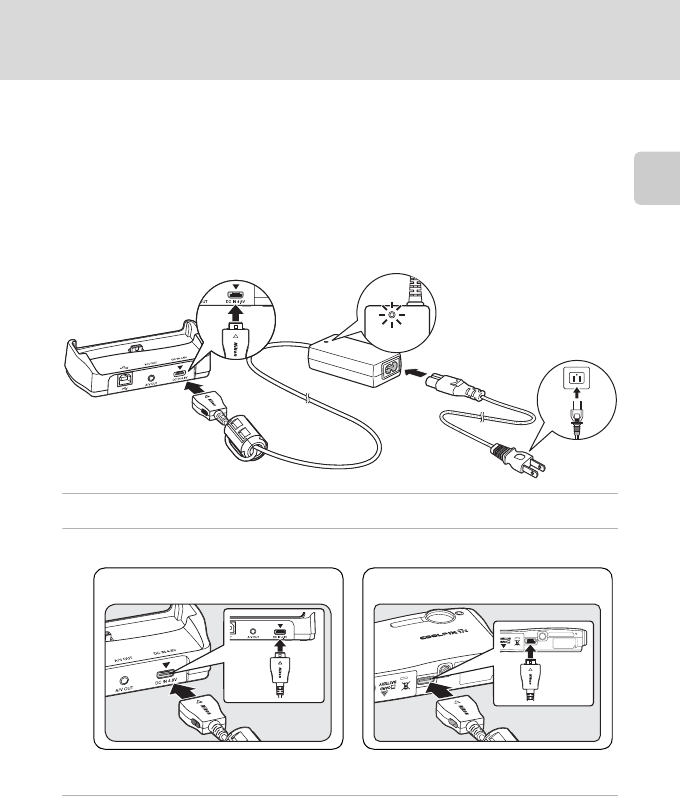
15
The COOL-STATION and AC Adapter
First Steps
The AC Adapter
The supplied EH-64 AC adapter can:
• When the camera is turned on, power the camera from a power outlet.
• When the camera is turned off, charge the battery in the camera (c18).
It can also be used to power the camera for playback, data transfer, or print-
ing (recommended). Do not use any other make or model of AC adapter;
failure to observe this precaution could result in fire or product malfunction.
Connecting the AC adapter
1Connect the power cord. (1)
2Plug the AC adapter into the COOL-STATION or camera. (2)
Make sure that the plugs are in the correct orientation. Inserting the plugs incor-
rectly may damage the COOL-STATION.
3Plug the adapter in. (3)
When the adapter is connected correctly, the power on lamp will light. (4)
24
1
3
COOL-STATION Camera
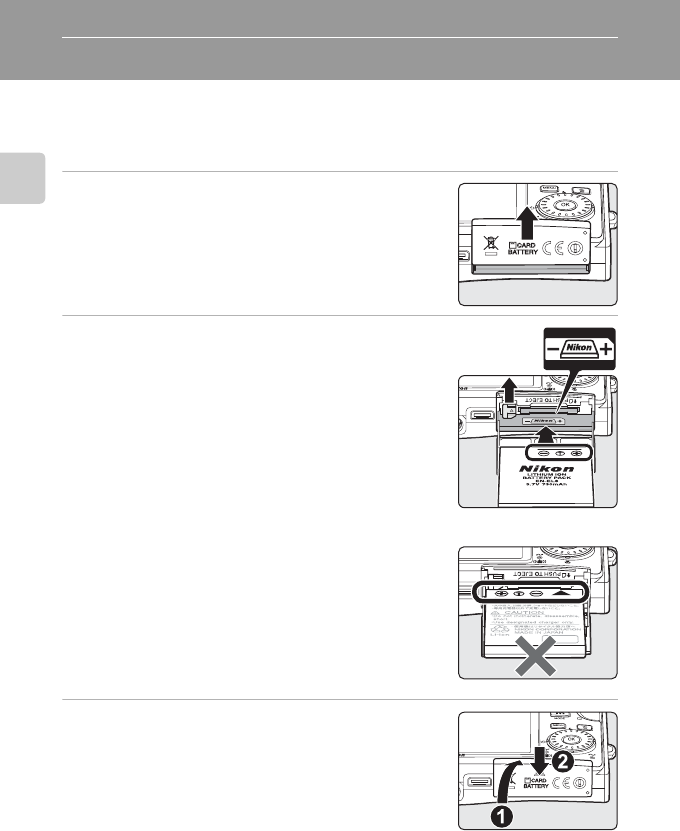
16
First Steps
Inserting the Battery
The camera uses a rechargeable EN-EL8 lithium-ion battery (supplied).
Charge the battery before first use or when the battery is running low
(c18).
1Open the battery-chamber/memory card
slot cover.
2Insert the battery.
Confirm that the positive (+) and negative (-) termi-
nals are oriented correctly as described on the label at
the entrance of the battery chamber, and insert the
battery.
The orange battery latch is pushed aside as the bat-
tery is inserted. The battery is fully inserted when the
latch clicks back into place.
jInserting the Battery
Inserting the battery upside down or backwards
could damage the camera. Check to be sure the
battery is in the correct orientation.
3Close the battery-chamber/memory card
slot cover.
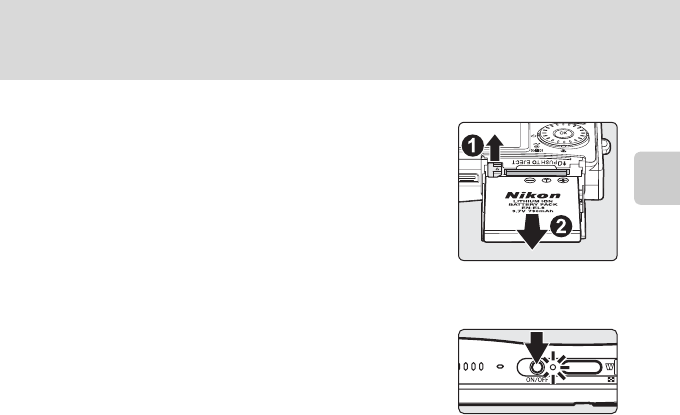
17
Inserting the Battery
First Steps
Removing the Battery
Turn the camera off before removing the battery.
To eject the battery, open the battery-chamber/
memory card slot cover and slide the battery latch
in the direction shown (1). The battery can then be
removed by hand (2).
• Note that the battery may become hot during
use; observe due caution when removing the
battery.
Turning On and Off the Camera
To turn on the camera, press the power switch. The
power-on lamp will light and the monitor will turn
on. To turn off the camera, press the power switch
again.
If the camera is turned off, press o for about a
second to turn the camera on in playback mode (c30).
jNote on the Battery
Be sure to read the warnings for the battery on page ii and “Caring for the Camera” (c162)
to make use of this camera.
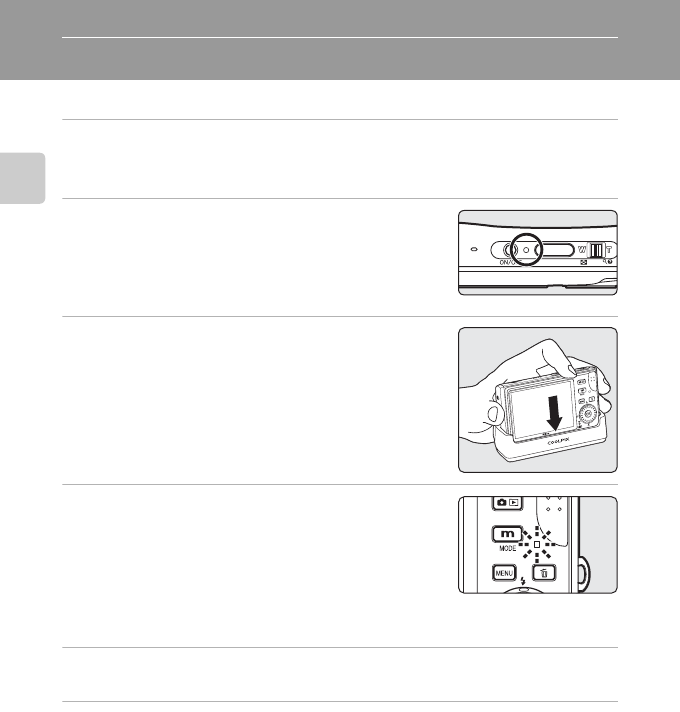
18
First Steps
Charging the Battery
Charge the battery before first use or when the battery is running low.
1Connect the COOL-STATION and AC adapter, and plug the
power cable into an outlet (c15).
The AC adapter power-on lamp will light.
2Turn the camera off.
If the power-on lamp is lit, press the power switch to
turn off the camera. You cannot charge the bat-
tery while the camera is turned on.
3Place the camera in the COOL-STATION
(c14).
The multi connector should be fully inserted.
4Charge the battery.
The indicator lamp next to the camera monitor will
blink green as the battery charges. If the lamp flickers
rapidly, the camera is not correctly inserted or the
battery is faulty. Reinsert the camera or replace the
battery.
A fully exhausted battery will recharge in about
two hours.
5Charging is complete.
The indicator lamp stops blinking when charging is complete.
6Remove the camera.
Make sure to unplug the power cable from the power outlet.
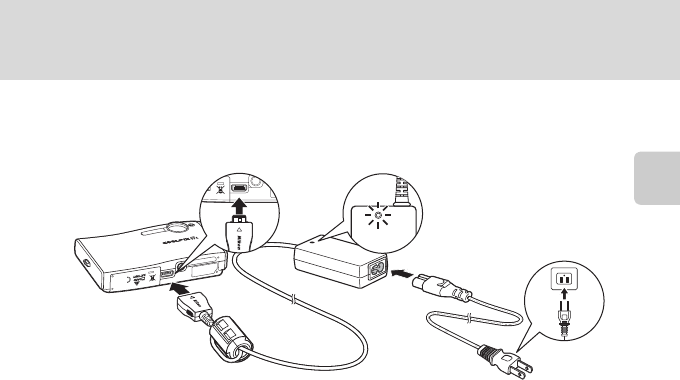
19
Charging the Battery
First Steps
lCharging Without the COOL-STATION
• Charging the battery is possible without using the COOL-STATION. Insert the battery into
the camera, make sure that the camera is turned off, and connect the AC adapter to the
multi connector of the camera directly (c15).
• The battery can also be charged using the optional MH-62 battery charger (c159).
1
24
3
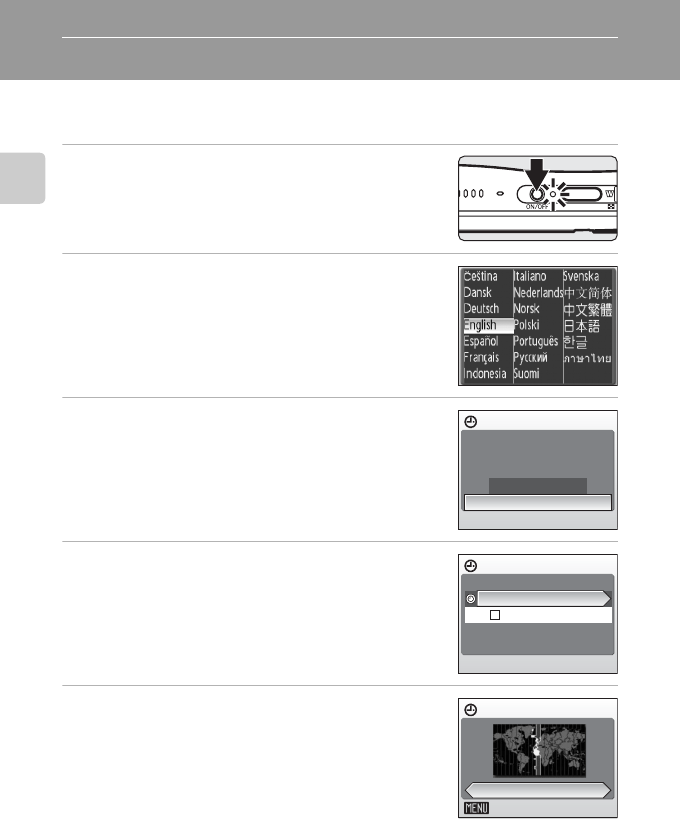
20
First Steps
Setting Display Language, Date, and Time
A language-selection dialog is displayed the first time the camera is turned
on.
1Press the power switch to turn on the
camera.
The power-on lamp (green) will light and the monitor
will turn on.
2Use the rotary multi selector to choose
the desired language and press d.
For information on using the multi selector, see “The
Rotary Multi Selector” (c12).
3Choose [Yes] and press d.
If [No] is selected, the date and time will not be set.
4Press d.
The home time zone menu is displayed.
If daylight saving time is in effect in the local time
zone, see “Daylight Saving Time” on the next page.
5Select your home time zone and press d.
The date menu is displayed.
Date
Set time and date?
No
Yes
X
Time zone
London,Casablanca
DaylightSaving
X
Home time zone
Back
London,Casablanca
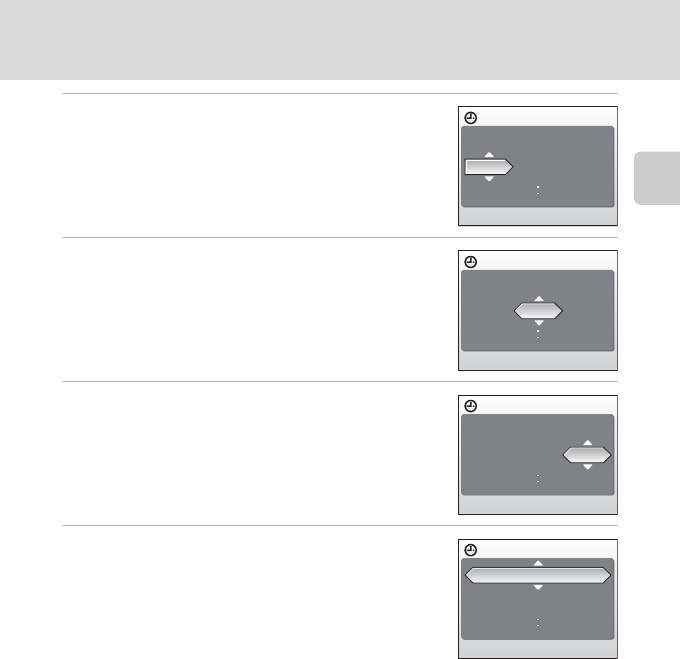
21
Setting Display Language, Date, and Time
First Steps
6Edit the day ([D]) (order of the day,
month, and year may differ in some
areas) and press d.
7Edit the month ([M]) and press d.
8Repeat steps 6 and 7 to edit the year
([Y]), hour, and minutes. Press d after
setting each item.
The row for setting the order in which the date is dis-
played will blink.
9Choose the order in which the day,
month, and year are displayed and press
d.
The settings are applied and monitor display returns to
shooting mode.
kDaylight Saving Time
If daylight saving time is in effect, turn on [DaylightSaving] in the time zone menu in step 4
and set the date.
1 Use the rotary multi selector to choose [DaylightSaving].
2Press d to enable daylight saving time (y).
The d button toggles the daylight saving time option on and off.
3 Use the rotary multi selector to return to step 4 and proceed to step 5.
When daylight saving time ends, turn [DaylightSaving] off from the date menu (c117) in the
setup menu. The camera’s clock is automatically set back one hour.
Date
DMY
01
0000
200609
Date
DMY
10
0000
200609
Date
DMY
10
0000
200610
Date
DMY
10
1015
200610
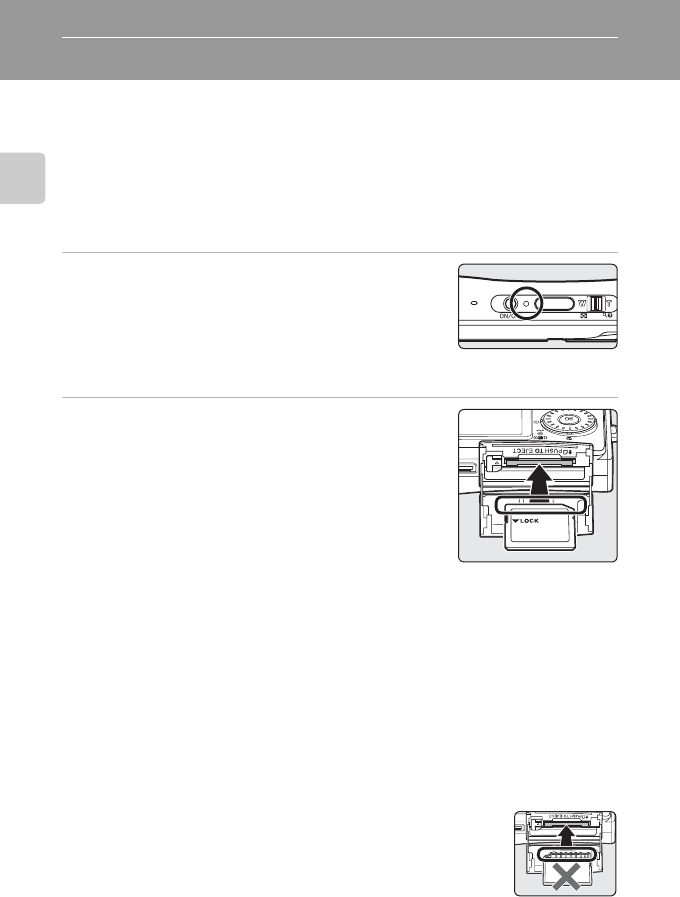
22
First Steps
Inserting Memory Cards
Pictures are stored in the camera’s internal memory (14 MB) or on removable
Secure Digital (SD) memory cards (available separately) (c159).
If a memory card is inserted in the camera, pictures are automatically
stored on the memory card and only pictures recorded to the memory
card can be played back, deleted, or transferred. Remove the memory
card to store pictures in the internal memory, or play back or delete
pictures from the internal memory.
1Turn the camera off and open the bat-
tery-chamber/memory card slot cover.
If the power-on lamp is lit, press the power switch to
turn off the camera.
Make sure that the camera is off (power-on lamp is
off) before inserting or removing the memory card.
2Insert the memory card.
Slide the memory card in until it clicks into place.
Close the battery-chamber/memory card slot cover.
jInserting Memory Cards
Inserting the memory card upside down or backwards could damage the
camera or the memory card. Make sure that the memory card is correctly
oriented when inserting.
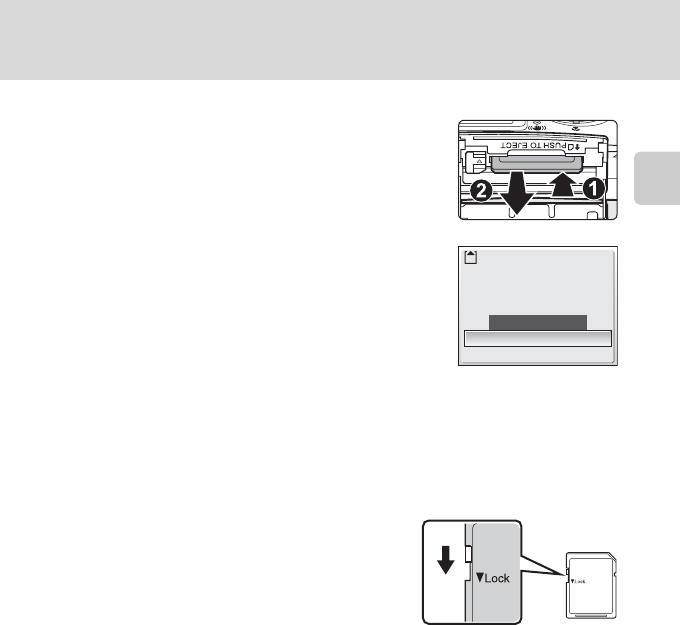
23
Inserting Memory Cards
First Steps
Removing Memory Cards
Before removing memory cards, turn the cam-
era off and confirm that the power-on and indi-
cator lamps are off. Open the battery-chamber/
memory card slot cover and press the card in (1)
to partially eject the card (2). The card can then
be removed by hand.
jFormatting Memory Cards
If the message at right is displayed, the memory card must be
formatted before use (c125). Note that formatting per-
manently deletes all pictures and other data on the mem-
ory card. Be sure to make copies of any pictures you wish to
keep before formatting the memory card.
Use the rotary multi selector to choose [Format] and press d. The
screen shown at right will be displayed. To start formatting, choose [Format] again and press d.
•Do not turn the camera off or remove the battery or memory card until formatting
is complete.
• The first time you insert the memory cards used in other devices into the COOLPIX S7c, be
sure to format them with [Format] (c125).
jThe Write Protect Switch
SD memory cards are equipped with a write protect
switch. Pictures cannot be recorded or deleted and the
memory card cannot be formatted when this switch is in
the “lock” position. Unlock by sliding the switch to the
“write” position.
jMemory Cards
• Use only Secure Digital memory cards.
• Do not perform the following during formatting, while data are being written to or deleted
from the memory card, or during data transfer to a computer. Failure to observe this pre-
caution could result in the loss of data or in damage to the camera or memory card.
- Eject the memory card
- Remove the battery
- Turn off the camera
- Disconnect the AC adapter
• Do not disassemble or modify.
• Do not drop, bend, or expose to water or strong physical shocks.
• Do not touch the metal terminals with your fingers or metal objects.
• Do not affix labels or stickers to the memory card.
• Do not leave in direct sunlight, closed vehicles, or areas exposed to high temperatures.
• Do not expose to humidity or to corrosive gases.
Card is not formatted
No
Format
Write protect switch
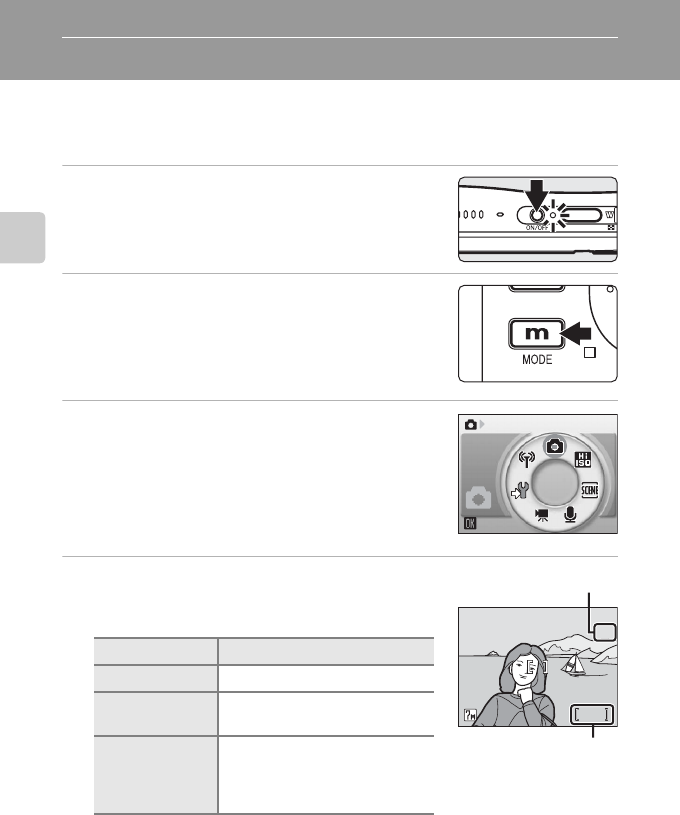
24
Basic Photography and Playback: Auto Mode
Basic Photography and Playback: Auto Mode
Step 1 Turn the Camera On and Select
L
(Auto) Mode
This section describes how to take pictures in L (auto) mode, an automatic,
“point-and-shoot” mode recommended for first-time users of digital cam-
eras.
1Press the power switch.
The power-on lamp will light and the monitor will turn
on.
Proceed to step 4 when M is displayed.
2Press D.
3Use the rotary multi selector to choose
L and press d.
The camera enters L (auto) mode.
4Check the battery level and number of
exposures remaining.
Battery level
Number of exposures remaining
The number of pictures that can be stored depends on the capacity of the memory
or memory card and image mode setting.
Monitor Description
NO INDICATOR Battery fully charged.
wBattery low; charge or replace
the battery.
Warning!
Battery
exhausted
w
Battery exhausted. Recharge or
replace with a fully charged
battery.
Shooting
88
MM
M
ww
Battery level indicator
Number of exposures
remaining
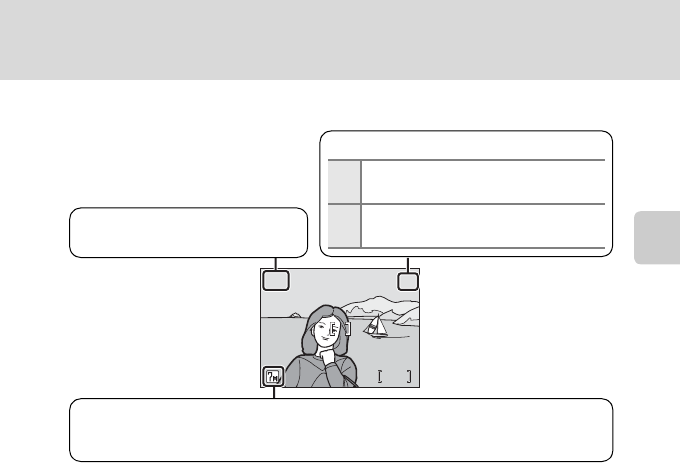
25
Step 1 Turn the Camera On and Select L (Auto) Mode
Basic Photography and Playback: Auto Mode
Indicators Displayed in L (Auto) Mode
lAvailable Functions in L (Auto) Mode
In L (auto) mode, macro close-up mode (c35) can be applied and pictures can be taken
using the flash (c32) and self-timer (c34). Pressing m in L (auto) mode displays the
shooting menu. This menu allows you to specify the image mode (c97), white balance set-
ting (c99), and to apply exposure compensation (c101), continuous shooting (c102),
BSS (c104), ISO sensitivity (c105), color options (c105), AF area (c106), and electronic
VR (c57) to suit shooting conditions or your own preferences.
lAuto Power Off in L (Auto) Mode (Standby Mode)
The monitor will dim to reduce the drain on the battery if no operations are performed for
about five seconds. The monitor will brighten when camera controls are used. At default set-
tings, the monitor will turn off altogether if no operations are performed for about a minute
during shooting and playback. The camera will turn off automatically if no operations are per-
formed for another three minutes (c124).
88
MM
M
Shooting mode
M
displayed in
L
(auto) mode
Image mode
Choose from six options depending on how you plan to use the picture.
The default setting is E Normal(3072 × 2304).
Internal memory/memory card
MPictures will be recorded to internal
memory.
OPictures will be recorded to memory
card.
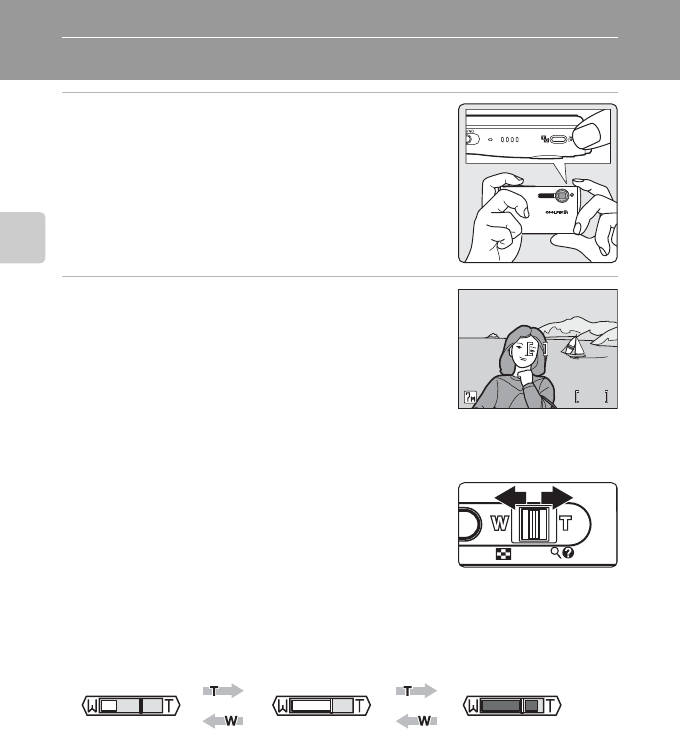
26
Basic Photography and Playback: Auto Mode
Step 2 Frame a Picture
1Ready the camera.
Hold the camera steadily in both hands, keeping your
fingers and other objects away from the lens, flash,
and self-timer lamp.
When taking pictures in “tall” orientation, turn the
camera so that the built-in flash is above the lens.
2Frame the picture.
Position the main subject near the center of the mon-
itor.
Using the Zoom
Use the zoom control to activate optical zoom.
Press to t (j) to zoom out, increasing the area
visible in the frame, or to v (k) to zoom in so that
the subject fills a larger area of the frame.
When the camera is zoomed in to the maximum magnification (3×), holding
the zoom control down to v (k) triggers digital zoom. The subject is magni-
fied up to 4×, for a total magnification of 12×.
A monitor indicator shows the current zoom ratio.
jDigital Zoom
Unlike optical zoom, data from the camera’s image sensor are processed digitally with digital
zoom. Details visible at maximum optical zoom are simply enlarged, producing a slightly
“grainy” image.
88
MM
M
Zoom out Zoom in
Optical zoom
(up to 3×)
Zoom indicator turns
yellow when digital
zoom is in effect.
Zoom indicator dis-
played when the zoom
control is pressed.
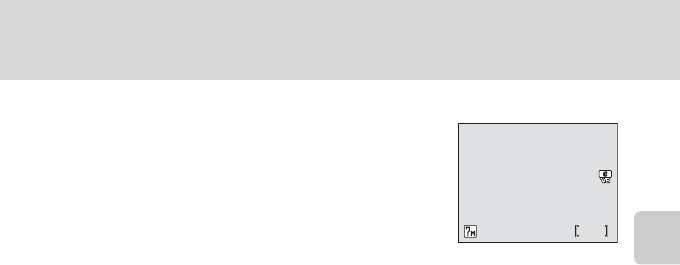
27
Step 2 Frame a Picture
Basic Photography and Playback: Auto Mode
Electronic VR
Electronic VR (c106) will be enabled in L (auto)
mode according to shooting conditions and may be
applied to blurred pictures when they are recorded
(L is displayed in the monitor when shooting).
Electronic VR can be set to [Off] in the [Electronic
VR] option of the shooting menu (c96).
• [Electronic VR] is enabled in [Night portrait] and
[Party/indoor] scene modes. Note that in these scene modes, [Electronic
VR] cannot be set to [Off].
• [Electronic VR] can also be applied to pictures taken during playback
(c57).
lHigh-sensitivity Shooting Mode
With high-sensitivity shooting mode (c36), a higher sensitivity is set and the shutter speed is
faster than in L (auto) mode, reducing blurred pictures resulting from subject movement.
This mode is also suited for reducing the effects of camera shake when taking pictures in dark
places.
lAnti-shake Mode
When anti-shake mode (c49) is used, [Electronic VR] (c106) and [BSS] (best shot selector)
(c104) are enabled to reduce effects of camera shake and blurred subjects, producing clear
images. With BSS enabled, the camera takes shots to a maximum of ten, they are compared,
and the sharpest picture (picture with the highest level of detail) is saved. A higher sensitivity
is set, and the shutter speed will be faster than in L (auto) mode.
88
MM
M

28
Basic Photography and Playback: Auto Mode
Step 3 Focus and Shoot
1Press the shutter-release button halfway.
The camera focuses on the subject at the center of
the frame.
When the subject is in focus, the focus indicator
(p) is green.
When the camera is unable to focus, the focus indica-
tor blinks red. Change the composition and try again.
2Press the shutter-release button the rest
of the way down.
The picture will be recorded to the memory card or
internal memory.
The flash may fire or the AF-assist illuminator may
light if the subject is poorly lit.
lShutter-Release Button
The camera features a two-stage shutter-release button. To set focus and exposure,
press the shutter-release button halfway, stopping when you feel resistance. Focus and
exposure lock while the shutter-release button is held in this position. To release the
shutter and take a picture, press the shutter-release button the rest of the way down.
Do not use force when pressing the shutter-release button, as this may result in camera
shake and blurred pictures.
88
MM
M
Take pictureSet focus and
exposure
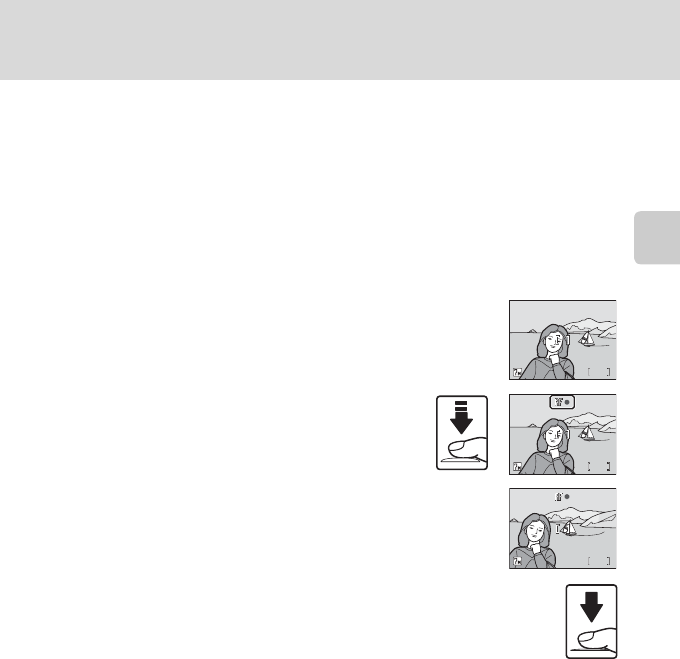
29
Step 3 Focus and Shoot
Basic Photography and Playback: Auto Mode
jDuring Recording
While pictures are being recorded, the y (wait) icon will be displayed, and the O (recording
to memory card) or M (recording to internal memory) icon will blink. Do not turn the camera
off, eject the memory card, or remove or disconnect the power source while these icons are
displayed. Cutting power or removing the memory card in these circumstances could result in
loss of data or in damage to the camera or card.
lFocus Lock
To focus on off-center subjects when [Center] is selected for [AF area mode] (c106), use
focus lock as described below. Focus lock is also effective to situations where focusing is diffi-
cult.*
1Position the subject in the center of the frame.
2Press the shutter-release button halfway.
• Confirm that the focus indicator (p) is green.
3Continue holding down the shutter-release button
halfway and recompose the picture.
• Be sure that the distance between the camera and
the subject does not change.
4Press the shutter-release button the rest of the way
down.
* Focus lock is recommended in the following situations, where auto focus may not produce
the desired results:
• Subject is very dark
• Objects of sharply differing brightness are included in the scene (e.g., the sun is behind the
subject and is in deep shadow)
• No contrast between the subject and surroundings (e.g., when the subject is standing in
front of a white wall, wearing a white shirt)
• Several objects are at different distances from the camera (e.g., the subject is inside a cage)
• Subject is moving rapidly
88
MM
M
88
MM
M
88
MM
M
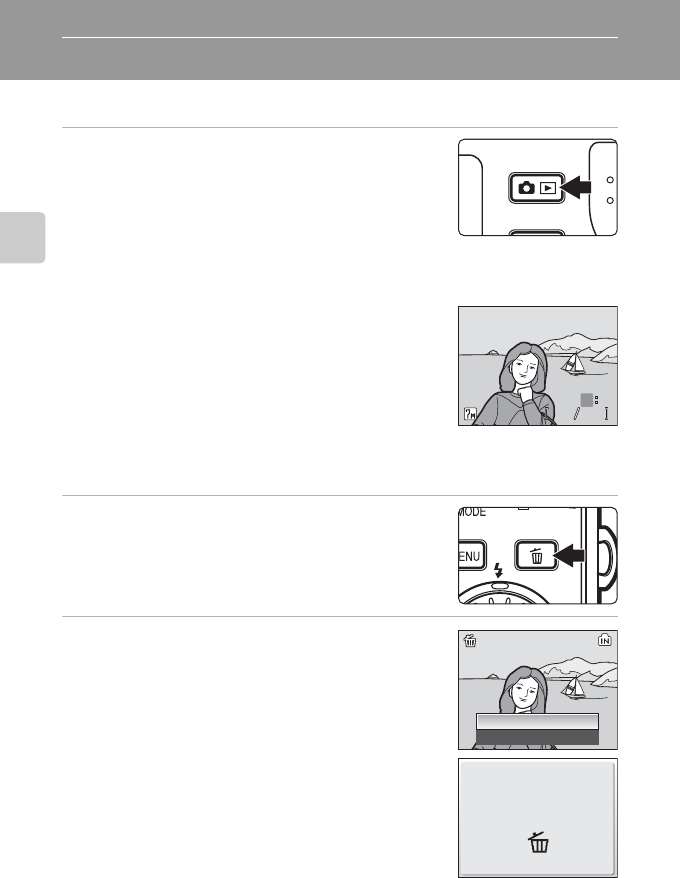
30
Basic Photography and Playback: Auto Mode
Step 4 Viewing and Deleting Pictures
Full-Frame Playback
Press o.
The last picture taken will be displayed.
Use the rotary multi selector to view additional pictures.
Rotate quickly to scroll rapidly to the desired picture.
Pictures taken in “tall” orientation will be rotated auto-
matically (c124). The rotating direction can be
changed (c112).
Pictures may be displayed briefly at low resolution while
being read from the memory card or internal memory.
Press o again to switch to shooting mode.
Deleting Pictures
1Press T to delete the picture currently
displayed in the monitor.
2Use the rotary multi selector to select
[Yes] and press d.
To exit without deleting the picture, choose [No] and
press d.
100NIKON
100NIKON
15:30
15:30
15:30
100NIKON
0004.JPG
0004.JPG
0004.JPG
2006.10.10
2006.10.10
2006.10.10
44
O
MM
44
N
EE
O
Erase 1 image?
Erase 1 image?
Erase 1 image?
No
Yes
Done
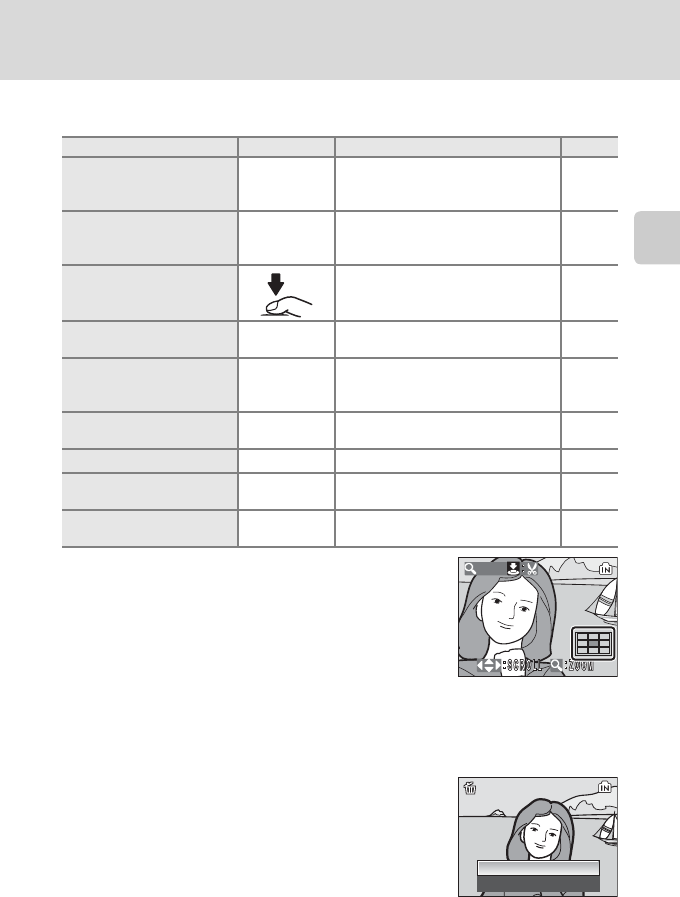
31
Step 4 Viewing and Deleting Pictures
Basic Photography and Playback: Auto Mode
kFull-Frame Playback Mode
The following options are available in full-frame playback mode.
Quick Playback Zoom
Pressing the zoom control to v (k) during full-frame playback
zooms the current picture in 3×, with the center of the picture
displayed in the monitor (Quick Playback Zoom) (c53).
Press d to return to full-frame playback.
In Quick Playback Zoom, even pictures displayed in “tall” ori-
entation will be displayed in “wide” orientation.
kViewing Pictures
•
When the camera is off, pressing
o
for one second will turn the camera on in playback mode.
• Pictures stored in the internal memory can only be viewed if no memory card is inserted.
kDeleting the Last Picture Taken
In shooting mode, press T to delete the last picture taken. The
confirmation dialog shown at right will be displayed. Use the
rotary multi selector to choose [Yes] and press d.
• To exit without deleting the picture, choose [No] and press
d.
Option Press Description c
Playback zoom Zoom con-
trol to v (k)
Enlarge view of picture currently
displayed in monitor up to about
10×.
53
View thumbnails
Zoom con-
trol to t
(j)
Display four, nine, sixteen or
twenty-five picture thumbnails. 52
Record/play voice
memo
Record or play back voice memos
up to 20 seconds in length. 59
D-Lighting i (m)Enhance brightness and contrast
in dark portions of pictures. 56
Electronic VR d
Press d while displaying a pic-
ture to compensate a blurred
image.
57
Play back movies dPress d while displaying a movie
to play back movies. 76
View playback menu mDisplay the playback menu. 108
View playback mode
menu DDisplay the playback mode-selec-
tion menu. 10
Switch to shooting
mode oSwitch to the shooting mode
selected last time. 30
X3.0
Erase 1 image?
Erase 1 image?
Erase 1 image?
No
Yes
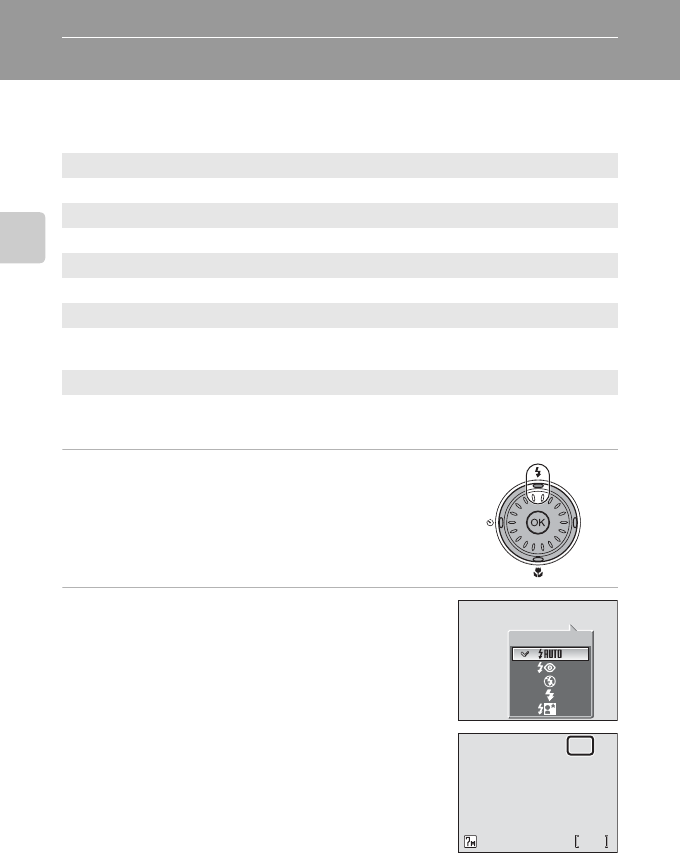
32
Basic Photography and Playback: Auto Mode
Using the Flash
The flash has a range of 0.3–7.5 m (1 ft.–24 ft.) when the camera is zoomed
out all the way. With maximum optical zoom applied, the range is 0.3–4 m
(1 ft.–13 ft.). The following flash modes are available:
1Press J (flash mode).
The flash menu is displayed.
2Use the rotary multi selector to choose
the desired flash mode and press d.
The icon for the selected flash mode is displayed at
the top of the monitor.
When [Monitor settings] (c120) is set to [Auto info],
the icon for the selected flash mode is only displayed
for five seconds after the setting is applied. When set
to [Show info], the z icon will only be displayed for
five seconds after the setting is applied. All other
icons will remain displayed.
The flash mode applied in L (auto) mode and high-
sensitivity shooting mode is stored in the camera’s
memory even after the camera is turned off.
If a setting is not applied by pressing d within five
seconds, the selection will be cancelled.
zAuto (default for L (auto) mode)
Flash fires automatically when lighting is poor.
AAuto with red-eye reduction
Reduces “red-eye” in portraits (c33).
BOff
Flash will not fire even when lighting is poor.
JFill flash
Flash fires whenever a picture is taken. Use to “fill-in” (illuminate) shadows
and back-lit subjects.
DSlow sync
Flash illuminates main subject; slow shutter speeds are used to capture back-
ground at night or under dim light.
zz
Flash
88
MM
Mzz
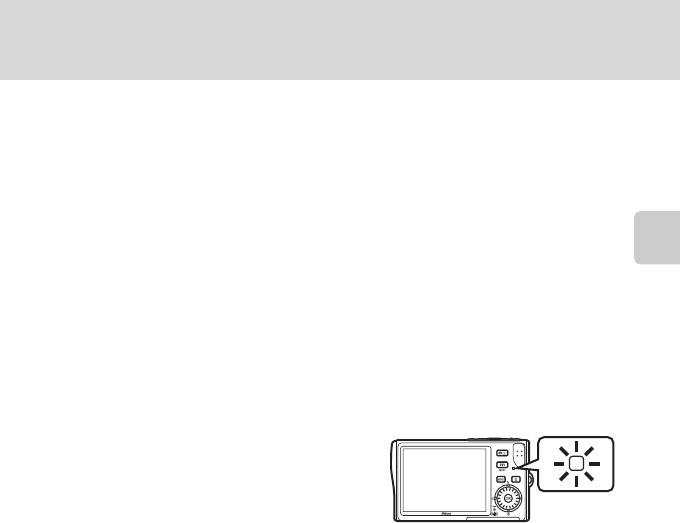
33
Using the Flash
Basic Photography and Playback: Auto Mode
jThe B (Off) Indicator
Note the following when lighting is poor and the flash is off (B).
• Place the camera on a flat, level surface or use a tripod (recommended).
•The W is displayed when the camera automatically increases sensitivity to minimize blur
caused by slow shutter speed. Pictures taken when W is displayed may be slightly mottled.
jNote on Using the Flash
When using the flash at a wide-angle zoom position, reflections from dust particles in the air
may appear as bright spots in pictures. To reduce these reflections, set the flash to B (Off) or
zoom in on the subject.
kThe AF-assist Illuminator
If lighting is poor, the AF-assist illuminator may light to assist the focus operation when the
shutter-release button is pressed halfway. The illuminator has a maximum range of about
1.9 m/6 ft. 2 in. (t) to 1.1 m/3 ft. 6 in. (v). The AF-assist illuminator can be turned off man-
ually (c123), although in this case the camera may not focus when lighting is poor.
kThe Flash Lamp
The flash lamp indicates flash status when the shut-
ter-release button is pressed halfway.
•On: Flash will fire when picture is taken.
•Blinks: Flash charging. Wait a few seconds and
try again.
•Off: Flash will not fire when picture is taken.
kRed-Eye Reduction
The COOLPIX S7c is equipped with an advanced red-eye reduction system. Pre-flashes are
fired several times at low intensity before the main flash to reduce “red-eye.” If the camera
detects “red-eye” after a picture is taken, Nikon’s own In-Camera Red-Eye Fix processes the
image as it is recorded. Therefore, there is a slight delay before the shutter-release button
operates normally to take another picture.
• Not recommended for when shutter-release timing is essential.
• Red-eye reduction may not always produce the desired results.
• In some rare cases, other portions of pictures may be affected.
Use flash modes other than auto with red-eye reduction in above cases.
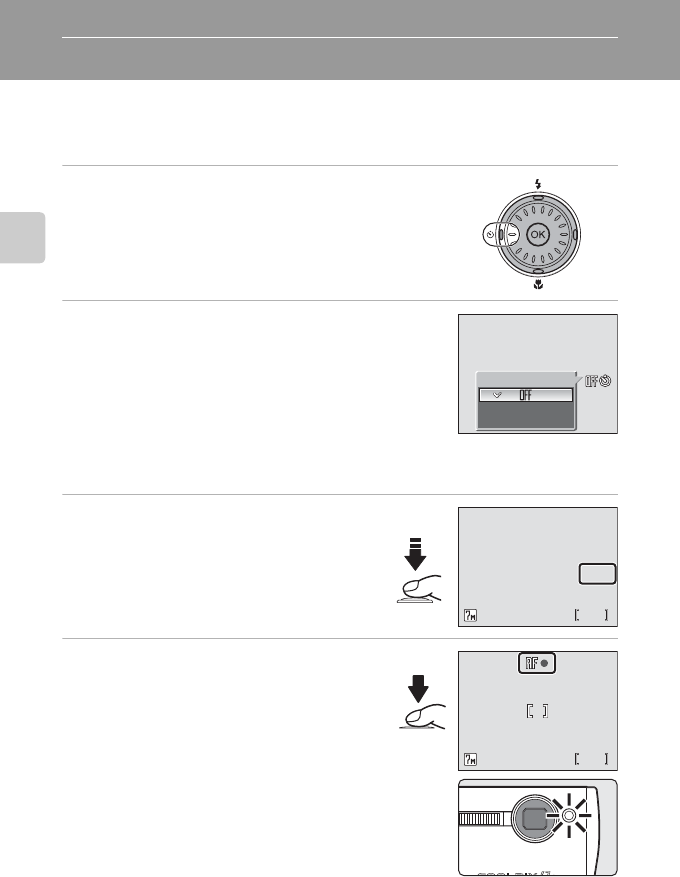
34
Basic Photography and Playback: Auto Mode
Taking Pictures with the Self-Timer
The camera is equipped with a ten-second and three-second timer for self-
portraits. When using the self-timer, mount the camera on a tripod (recom-
mended) or rest it on a flat, level surface.
1Press H (self-timer).
The self-timer menu is displayed.
2Use the rotary multi selector to choose
[10s] or [3s] and press d.
[10s] (10 seconds): suited for important occasions
(such as weddings)
[3s] (3 seconds): suited for preventing camera shake
The mode selected for self-timer is displayed.
If a setting is not applied by pressing d within five seconds, the selection will be
cancelled.
3Frame the picture and press the
shutter-release button halfway.
Focus and exposure will be set.
4Press the shutter-release button
fully.
The self-timer starts and the self-timer lamp
will blink. The lamp stops blinking one sec-
ond before the photograph is taken and
remains lit until the shutter is released.
The number of seconds remaining before
the shutter is released is displayed in the
monitor.
To stop the timer before a picture is taken,
press the shutter-release button again.
Self-timer
3s
10s
88
MM
HH
10
10
10
M
88
MM
HH
10
10
10
M
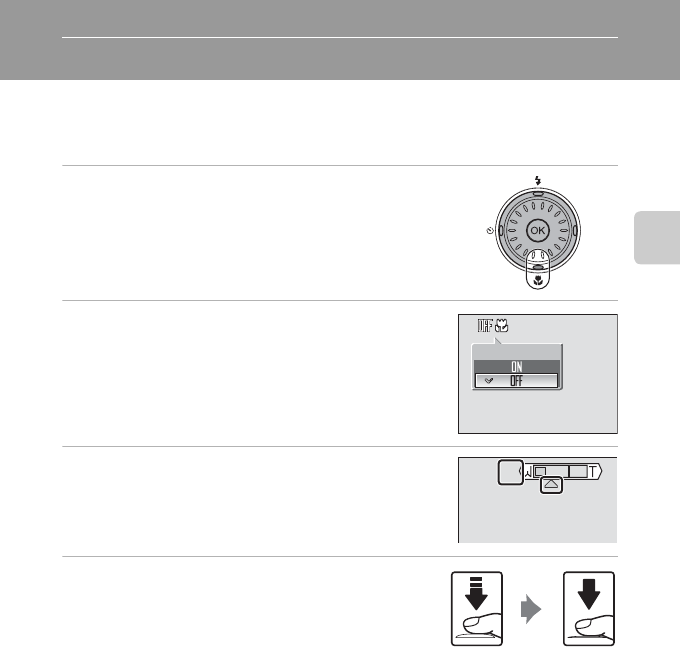
35
Basic Photography and Playback: Auto Mode
Macro Close-up Mode
Macro close-up mode is used for taking shots of pictures as close as 4 cm
(1.6 in.). Note that the flash may be unable to light entire subject at distances
of less than 30 cm (11.8 in.).
1Press L (macro mode).
The macro close-up menu is displayed.
2Use the rotary multi selector to choose
[ON] and press d.
The macro close-up mode icon (F) is displayed.
The monitor will return to the normal display for the
current mode if the setting is not applied by pressing
d within five seconds.
3Press the zoom control to v (k) or to t
(j) to frame the picture.
The camera can focus at distances as close as 4 cm
(1.6 in.). Zoom is available when F (F) is green.
4Press the shutter-release button fully.
The macro close-up mode applied in L (auto) mode
is stored in the camera’s memory even after the cam-
era is turned off.
kMacro Close-up Mode
In macro close-up mode, the camera focuses continuously, even when the shutter-release
button is not pressed halfway.
Macro close-up
M
F
F
F
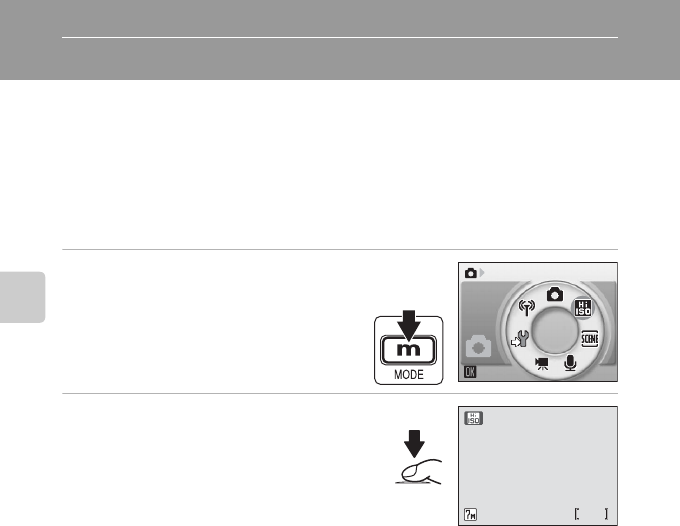
36
Shooting Suited for the Scene - High-sensitivity Shooting Mode, Scene Mode
Shooting Suited for the Scene - High-sensitivity Shooting Mode, Scene Mode
High-sensitivity Shooting Mode
High-sensitivity shooting mode offers the following features:
• A higher sensitivity is set and the shutter speed will be faster than in L
(auto) mode.
• Camera shake or blurred subjects will be avoided even in poorly-lit rooms,
in sunset, or in night view scenes.
• This mode is suited for shooting in dark places compared with shooting in
anti-shake mode (c49).
1Enter high-sensitivity shooting
mode by pressing D in shoot-
ing mode, selecting K (use the
rotary multi selector), and then
pressing d.
2Frame the subject and take the
picture.
jNotes on High-sensitivity Shooting Mode
• This mode reduces effects of camera shake or blurred subjects even in dark places; use of a
tripod is recommended when the shutter speed is low.
• Pictures taken in this mode may become somewhat grainy.
• Focus may not be precisely fixed in extremely dark places.
lMenus for High-sensitivity Shooting
Press m in high-sensitivity shooting mode to display the high-sensitivity menu. The same
menu items can be set as in the shooting menu (c96) for L (auto) mode. [ISO sensitivity]
and [Electronic VR] are not available in high-sensitivity shooting mode.
High sensitivity
88
MM
WW
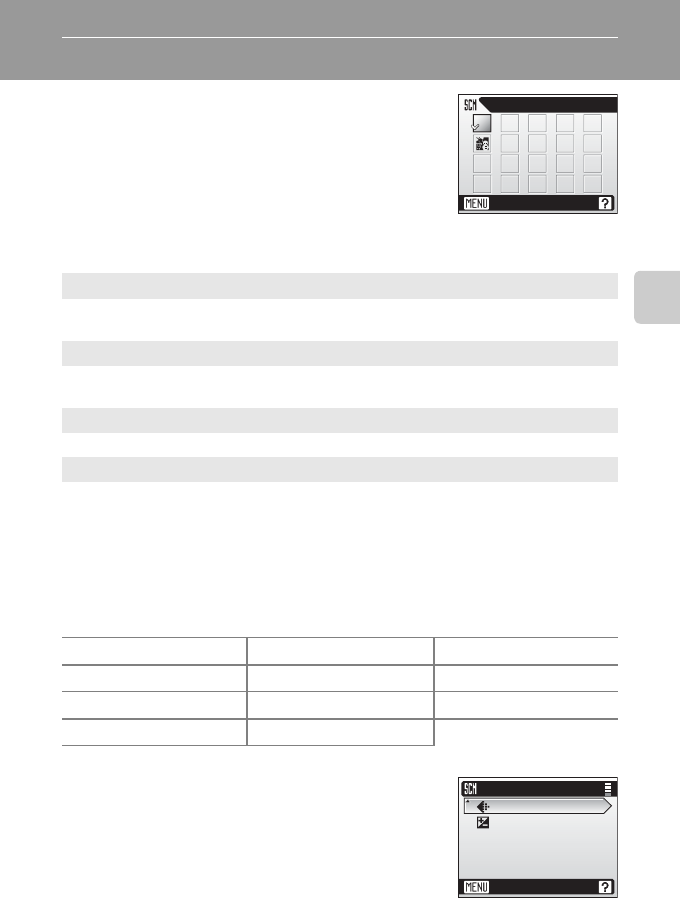
37
Shooting Suited for the Scene - High-sensitivity Shooting Mode, Scene Mode
Assist Modes and Scene Modes
The camera offers a choice of fifteen “scene”
options. Camera settings are automatically opti-
mized for the selected subject type.
Assist Modes (Four Options)
The following modes offer framing assist options to help you compose your shots.
Scene Modes (Eleven Options)
The following modes allow you to take pictures optimized for a particular
subject type by simply choosing a scene mode and pressing the shutter-
release button.
lImage Mode and Exposure Compensation
[Z Image mode] (c97) and [I Exp. +/–] (c101) can be set
in the scene menu and framing assist menu. Changes made to
these settings apply to all shooting modes. Settings made for
exposure compensation are reset when the camera is switched
to another mode.
B Portrait
Use for portraits. The main subject stands out clearly while the background
details are softened, lending a sense of depth to the composition.
E Landscape
Use for vivid landscape shots that enhance outlines, colors, and contrast in
subjects such as skyscapes and forests.
P Sports
Fast shutter speeds freeze fast-moving subjects for dynamic sports scenes.
D Night portrait
Use for a natural balance between the main subject and background lighting
in portraits taken at night.
C Party/indoor G Night landscape O Copy
H Beach/snow M Close up L Back light
I Sunset N Museum F Panorama assist
J Dusk/dawn K Fireworks show
BEPD
IJG
NK
ZI
OL
C
M
F
Exit
Portrait
Scene menu
Image mode
Exp. +/-
Exit
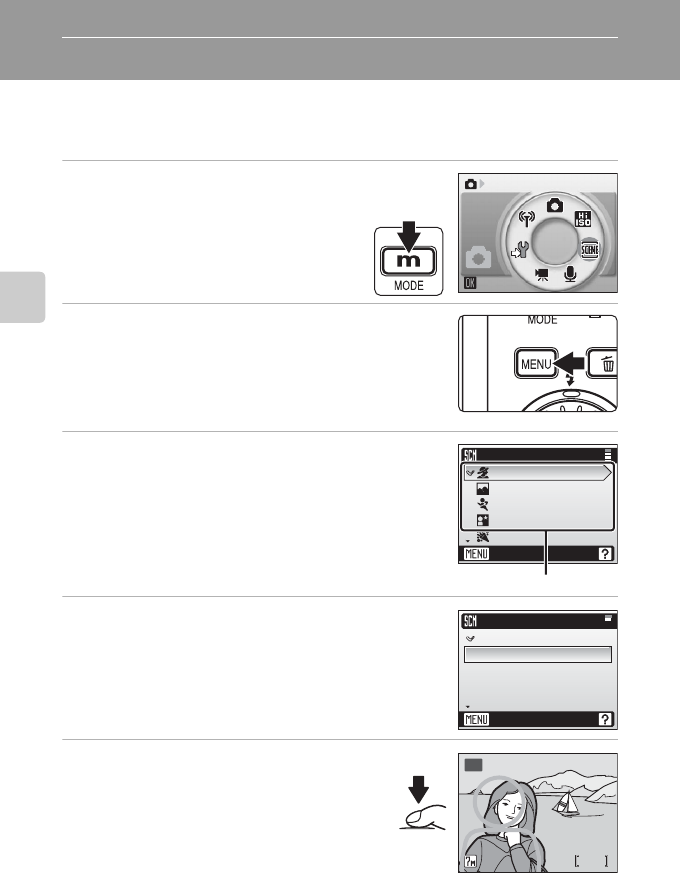
38
Shooting Suited for the Scene - High-sensitivity Shooting Mode, Scene Mode
Assist Modes
Compose pictures with the help of framing guides displayed in the monitor.
Taking Pictures in Assist Modes
1Enter scene mode by pressing D
in shooting mode, selecting n
(use the rotary multi selector), and
then pressing d.
2Press m to display the scene menu.
3Choose an assist mode and press d.
The framing assist menu is displayed.
4Choose the appropriate composition and
press d.
5Position the subject in the fram-
ing guide and take the picture.
Framing guides are displayed if available.
Scene
Scene menu
Exit
Portrait
Landscape
Sports
Night portrait
Party/indoor
Assist modes
B
N
O
P
Q
Portrait
Exit
Portrait
Portrait left
Portrait right
Portrait close-up
Portrait couple
88
MM
BAA

39
Assist Modes
Shooting Suited for the Scene - High-sensitivity Shooting Mode, Scene Mode
B Portrait Assist
Use this mode for portraits in which the main sub-
ject stands out clearly. Portrait subjects exhibit
smooth, natural-looking skin tones.
1Other settings can be selected.
2AF-assist illumination is automatically enabled for [Portrait].
ku (AF-Assist Illumination)
u stands for the AF-assist illumination, which has two options; [Auto] and [Off] (c123).
Even when set to [Auto], the u indicator will not be displayed in the monitor.
BPortrait
Camera focuses on subject in the center of the monitor. No guides are dis-
played in the monitor.
NPortrait left
Compose shot with subject in left half of frame. Camera focuses on subject
inside the framing guides.
OPortrait right
Compose shot with subject in the right half of frame. Camera focuses on sub-
ject inside the framing guides.
PPortrait close-up
Compose shot with subject’s face in top half of frame. Camera focuses on
face inside the framing guides.
QPortrait couple
Compose shot with two subjects side-by-side. Camera focuses on subjects
inside the framing guides.
CPortrait figure
Compose shot in “tall” orientation. Camera focuses on subject inside the
framing guides. Pictures taken in “tall” orientation are displayed in the same
“tall” orientation in the monitor.
CA1HOff1FOff uOff2
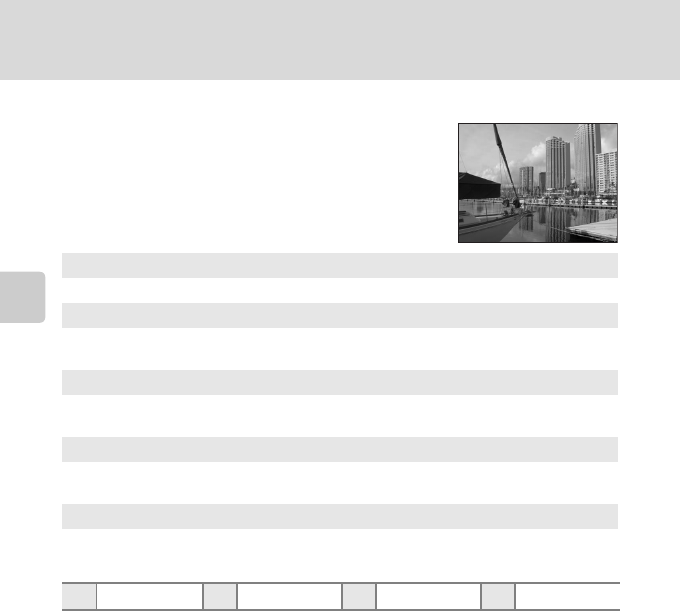
40
Assist Modes
Shooting Suited for the Scene - High-sensitivity Shooting Mode, Scene Mode
E Landscape Assist
Use this mode for vivid landscapes, cityscapes, and
portraits featuring a landmark in the background.
1Flash is set to z for [Group left] and [Group right]. Other settings can be selected.
2Other settings can be selected.
lFocusing at Infinity
The focus indicator (c28) is always green when the shutter-release button is pressed half-
way when [Landscape], [Scenic view], or [Architecture] is selected for landscape assist mode.
Note, however, that objects in the foreground may not always be in focus.
ELandscape
Camera focuses at infinity. No guides are displayed in the monitor.
SScenic view
Use to photograph distant skylines. Camera focuses at infinity. Match top of
skyline with wavy yellow guide.
UArchitecture
Use to photograph buildings. Camera focuses at infinity. A grid is displayed in
the monitor to help keep verticals and horizontals aligned with the frame.
VGroup right
Use to compose portraits with portrait subjects to right and landmark or other
objects in background at left of frame.
WGroup left
Use to compose portraits with portrait subjects to left and landmark or other
objects in background at right of frame.
CB1HOff2FOff uOff
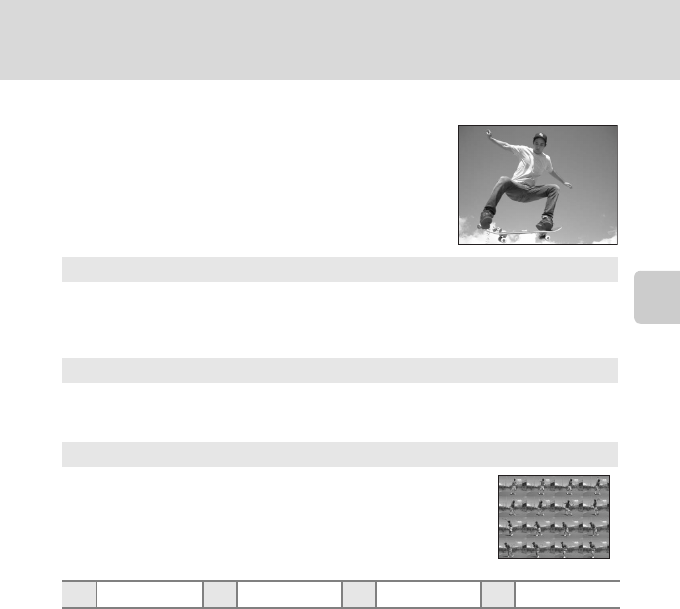
41
Assist Modes
Shooting Suited for the Scene - High-sensitivity Shooting Mode, Scene Mode
P Sports Assist
Use this mode for dynamic action shots that freeze
the action in a single shot or record motion in a
series of pictures. No framing guides are displayed.
lSports Assist
When [Sports] or [Sport composite] is selected in sports assist mode, the camera focuses con-
tinuously on the center of the frame, even when the shutter-release button is not pressed
halfway.
PSports
Pictures are taken continuously while the shutter-release button is pressed.
When the image mode is E Normal(3072), camera takes 7 shots at about 1.4
frames per second. Camera focuses continuously even when the shutter-
release button is not pressed halfway.
XSport spectator
As above, except that camera focuses at ranges of about 4.5 m (14.8 ft.) to
infinity at maximum wide-angle zoom position and about 6 m (19.7 ft.) to
infinity at maximum telephoto position.
YSport composite
Each time shutter-release button is pressed, camera takes
16 shots in about 2.4 seconds and arranges them in four
rows to form a single picture (f Normal (1600)). Camera
focuses continuously even when the shutter-release but-
ton is not pressed halfway.
CB H Off FOff uOff
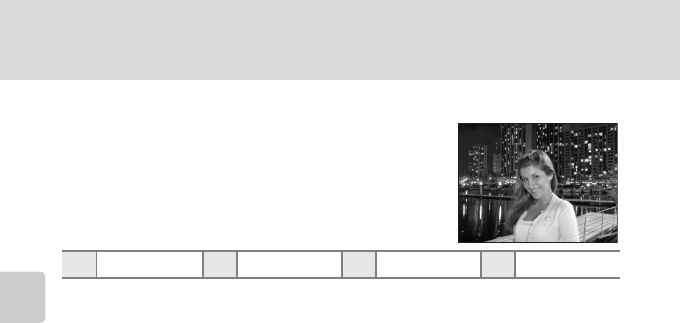
42
Assist Modes
Shooting Suited for the Scene - High-sensitivity Shooting Mode, Scene Mode
D Night Portrait Assist
Use this mode to achieve a natural balance
between the main subject and background lighting
in portraits taken at night. This mode offers the
same assist options as portrait assist mode (c39).
• Electronic VR will be applied when shooting at
slow shutter speeds (c106).
1Fill flash with slow sync and red-eye reduction.
2Other settings can be selected.
3AF-assist illumination is automatically enabled for [Night portrait].
Q: Use of a tripod is recommended.
R: Noise reduction may be automatically applied as pictures taken are
recorded; results in increased recording times.
CA1HOff2FOff uOff3
QR
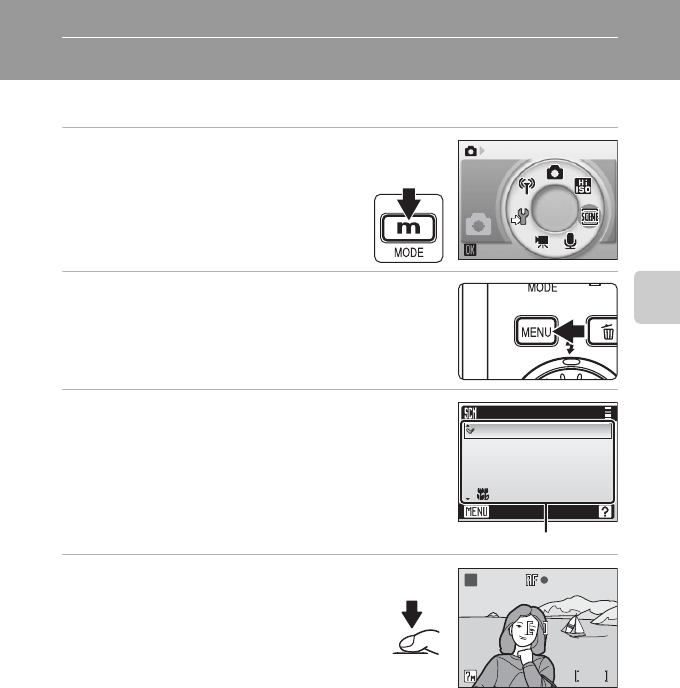
43
Shooting Suited for the Scene - High-sensitivity Shooting Mode, Scene Mode
Scene Modes
Taking Pictures in Scene Modes
1Enter scene mode by pressing
D in shooting mode, selecting
n (use the rotary multi selec-
tor), and then pressing d.
2Press m.
3Choose a scene mode and press d.
Three pages of scene modes are available, beginning
with [Party/indoor] and ending with [Panorama
assist].
4Frame the subject and take the
picture.
Scene
H
I
J
G
Scene menu
Exit
Beach/snow
Sunset
Dusk/dawn
Night landscape
Close up
Scene modes
88
MM
H
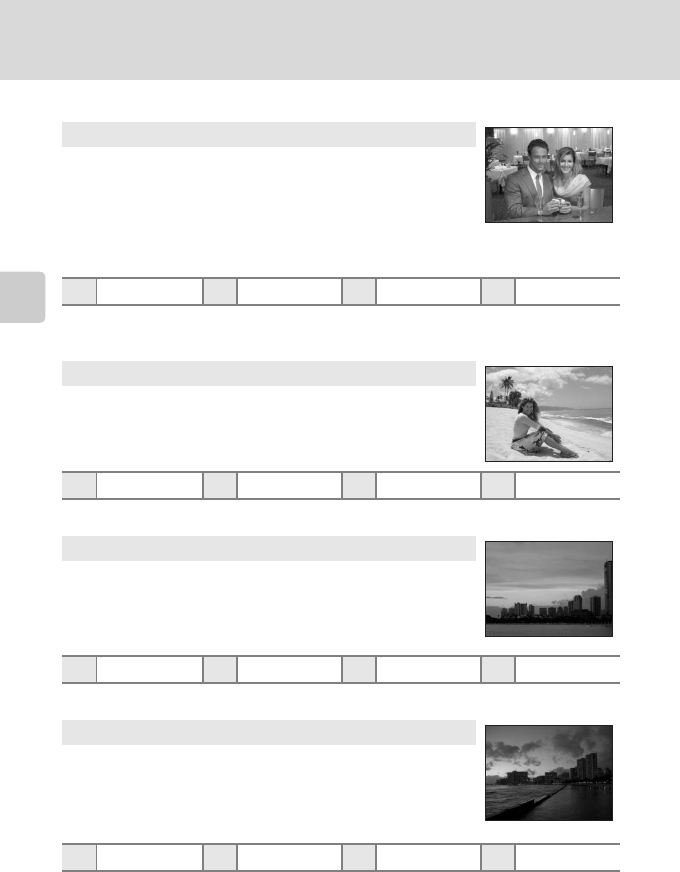
44
Scene Modes
Shooting Suited for the Scene - High-sensitivity Shooting Mode, Scene Mode
Features
1Fill flash with slow sync and red-eye reduction. Other settings can be selected.
2Other settings can be selected.
1Other settings can be selected.
1Other settings can be selected.
1Other settings can be selected.
C Party/indoor
Captures the effects of candlelight and other indoor back-
ground lighting.
• Camera focuses on subject in center of frame.
•
Hold the camera steadily to prevent camera shake in dark places.
• Electronic VR (c106) will be applied when flash mode is set
to fill flash with slow sync and red-eye reduction, off, slow
sync, or when shutter speed is slow.
CA1HOff2FOff uAuto
H Beach/snow
Captures the brightness of such subjects as snowfields,
beaches, or sunlit expanses of water.
• Camera focuses on subject in center of frame.
Cz1HOff1FOff uAuto
I Sunset Q
Preserves the deep hues seen in sunsets and sunrises.
• Camera focuses on the subject in the center of the frame.
CB1HOff1FOff uAuto
J Dusk/dawn QR
Preserves the colors seen in the weak natural light before sun-
rise or after sunset.
• Camera focuses at infinity. The AF indicator (c28) always
lights; however, focus may not be set for near subjects, while
the camera focuses at infinity.
CB H Off1FOff uOff
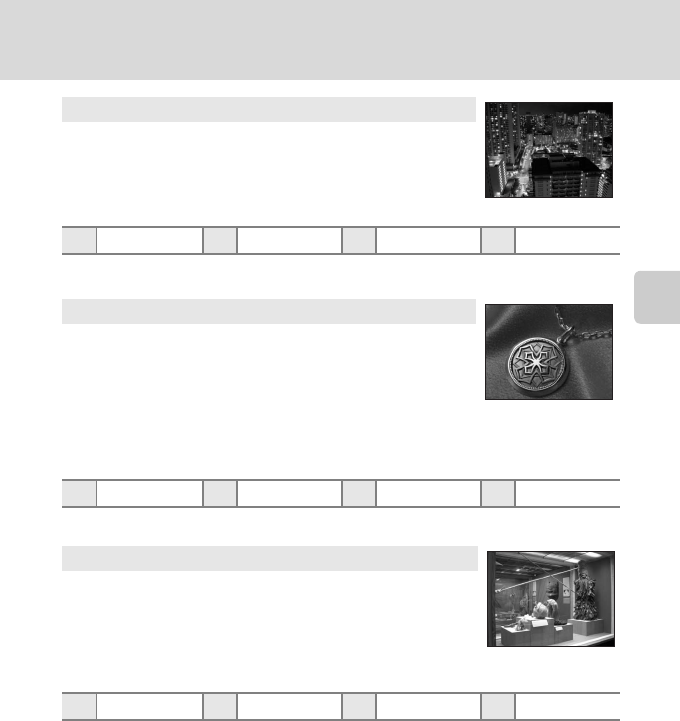
45
Scene Modes
Shooting Suited for the Scene - High-sensitivity Shooting Mode, Scene Mode
1Other settings can be selected.
1Other settings can be selected.
1Other settings can be selected.
Q: Use of a tripod is recommended.
R: Noise reduction may be automatically applied as pictures taken are
recorded; results in increased recording times.
G Night landscape QR
Slow shutter speeds are used to produce stunning night land-
scapes.
• Camera focuses at infinity. The AF indicator (c28) always
lights; however, focus may not be set for near subjects, while
the camera focuses at infinity.
CB H Off1FOff uOff
M Close up
Photograph flowers, insects, and other small objects at close
range.
• The camera can focus at distances as close as 4 cm (1.6 in.).
Zoom is available when F is green.
• Camera focuses continuously until shutter-release button is
pressed halfway to lock focus.
• Macro close-up shooting (c35) can be used for this option.
• Hold the camera steadily to prevent camera shake.
Cz1HOff1FOn uAuto
N Museum
Use indoors where flash photography is prohibited (for exam-
ple, in museums and art galleries) or in other settings in which
you do not want to use the flash.
• Camera focuses on subject in center of frame.
•BSS (c104) turns on automatically.
• Hold the camera steadily to prevent camera shake.
CB H Off1FOff1uOff
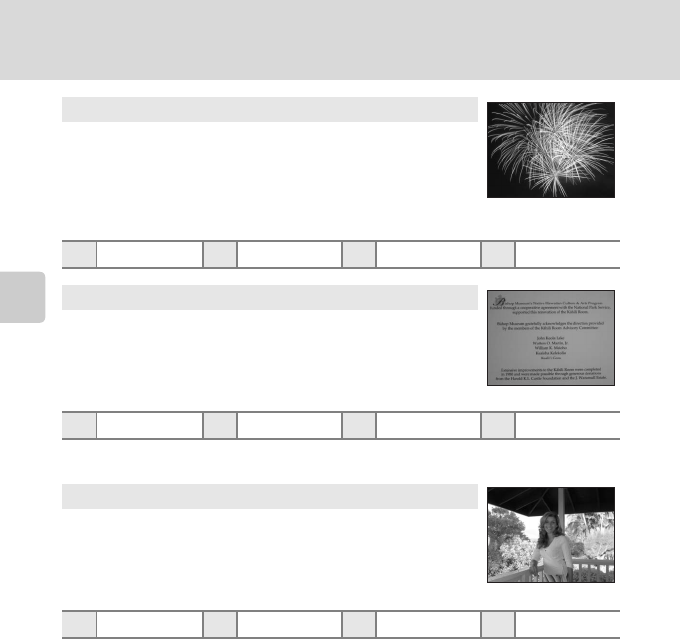
46
Scene Modes
Shooting Suited for the Scene - High-sensitivity Shooting Mode, Scene Mode
1Other settings can be selected.
1Other settings can be selected.
K Fireworks show Q
Slow shutter speeds are used to capture the expanding burst of
light from a firework.
• Camera focuses at infinity. The AF indicator (c28) always
lights; however, focus may not be set for near subjects, while
the camera focuses at infinity.
• [Exp +/-] cannot be applied.
CB H Off FOff uOff
O Copy
Provides clear pictures of text or drawings on a white board or in print.
• Camera focuses on subject in center of frame.
• Use macro close-up mode (c35) to focus at short ranges.
• Colored text and drawings may not show up well.
CB1HOff1FOff1uAuto
L Back light
Use when light is coming from behind your subject, throwing
features or details into shadow. The flash fires automatically to
“fill in” (illuminate) shadows.
• Camera focuses on subject in center of frame.
CJ H Off1FOff uAuto
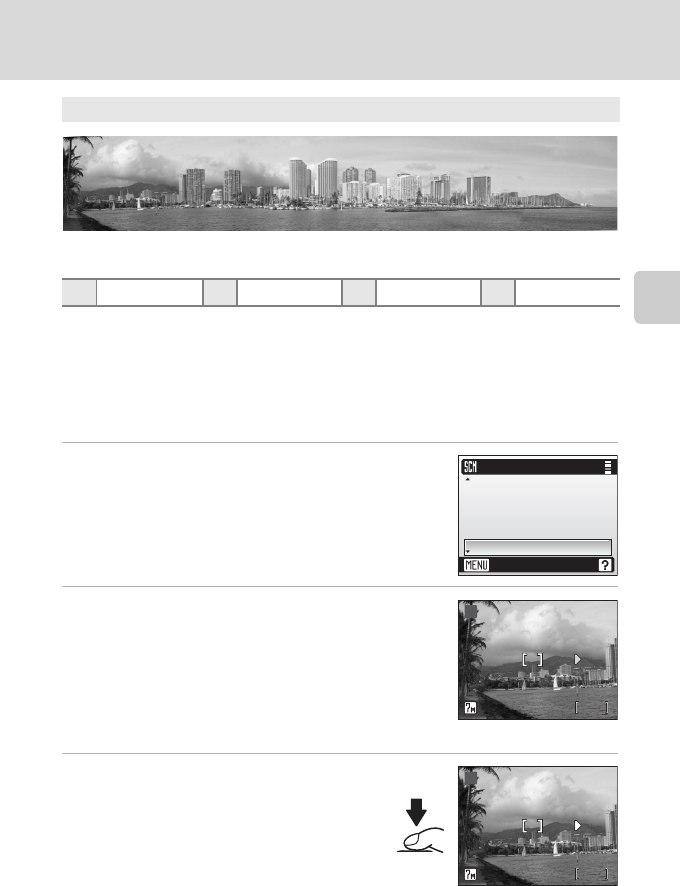
47
Scene Modes
Shooting Suited for the Scene - High-sensitivity Shooting Mode, Scene Mode
1Other settings can be selected.
Taking Pictures for a Panorama
The camera focuses on the subject in the center of the frame. Use a tripod
for best results.
1Use the rotary multi selector to choose
[F Panorama assist] in the scene menu
and press d.
The yellow panorama direction icon (E) is displayed to
show the direction in which pictures will be joined.
2Choose the direction and press d.
Select how pictures will be joined together in the com-
pleted panorama; right (
V
), left (
U
), up (
S
), or down (
T
).
The panorama direction icon (
E
) is displayed to the direc-
tion pressed, and changes to white when
d
is pressed.
Set the flash (
c
32), self-timer (
c
34), and macro close-
up mode (
c
35) in this step, if necessary.
Press
J
to reselect the direction.
3Take the first picture.
The first picture is displayed in the first third
of the monitor.
F Panorama assist
Use when taking a series of pictures that will later be joined to form a single pan-
orama using PictureProject.
CB1HOff1FOff1uAuto
K
O
L
N
F
Scene menu
Exit
Museum
Panorama assist
Back light
Copy
Fireworks show
88
MM
FBB
88
MM
FBB
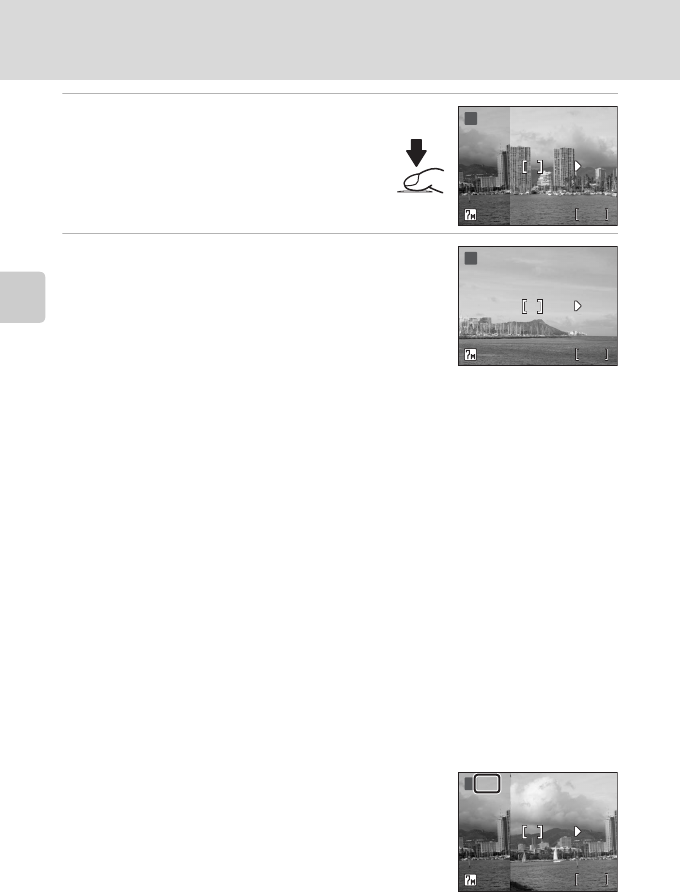
48
Scene Modes
Shooting Suited for the Scene - High-sensitivity Shooting Mode, Scene Mode
4Take the second picture.
Compose the next picture so that it over-
laps the first picture.
Repeat until you have taken the necessary
number of pictures to complete the scene.
5Press the rotary multi selector J when
shooting is completed.
The camera returns to step 2.
jPanorama Assist
Flash mode (c32), self-timer (c34), and macro close-up (c35) cannot be adjusted after
the first picture is taken. Pictures cannot be deleted, nor can zoom or image-mode setting
(c97) be adjusted until the series is finalized.
lExposure Lock
G (white) is displayed to show that white balance and expo-
sure have been locked at the values set with the first shot. All
pictures taken in a panorama series have the same exposure
and white-balance settings.
77
MM
FGGBB
44
MM
FBB
GG
77
MM
FGGBB
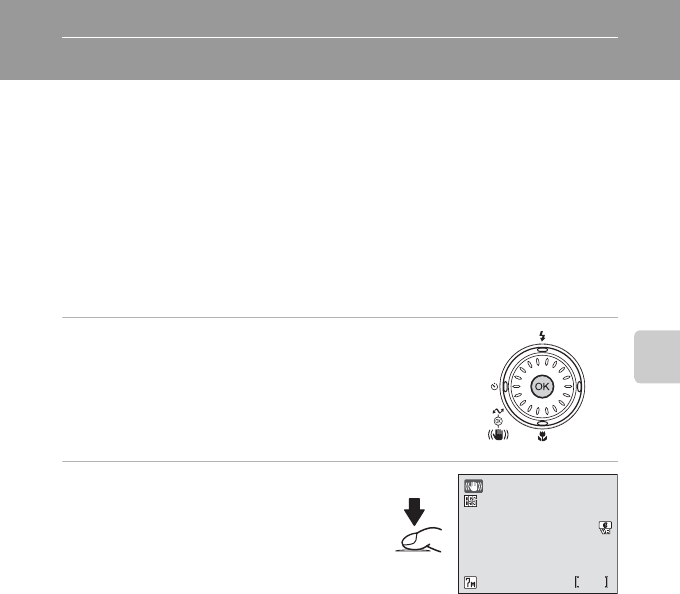
49
Anti-shake Mode
Anti-shake Mode
Shooting in Anti-shake Mode
Anti-shake mode offers the following features:
• This mode reduces effects of camera shake or blurred subjects, and pro-
duces clear images.
• [Electronic VR] (c106) and [BSS] (best shot selector) are enabled. Elec-
tronic VR compensates blurred images. BSS is on, camera takes shots to a
maximum of ten, they are compared and sharpest picture (picture with
highest level of detail) is saved (c104).
• The higher sensitivity is set and the shutter speed will be faster than in L
(auto) mode.
• Flash mode and self-timer are set to off.
1Press d (F) (anti-shake).
The camera enters anti-shake mode. Press again to
return to the shooting mode selected with the mode-
selection menu.
2Frame the subject and take the
picture.
When vibration is detected during shooting,
automatic compensation is activated.
When compensation is complete, new copy
is stored. The L icon (c8) for the new
copy is displayed when played back.
jNotes on Anti-shake Mode
• Shutter speed is limited to a certain value for dark subjects.
• Use of the high-sensitivity mode (c36) is recommended for shooting subjects in dark
places.
• Pictures taken in this mode may become somewhat grainy.
• Even if [Date imprint] (c121) is enabled, the date will not be imprinted.
lImage Mode and Exposure Compensation in Anti-shake Mode
When m is pressed in anti-shake mode, the menu is displayed to enable set the image
mode (c97) or exposure compensation (c101). Settings made for exposure compensation
are reset when the camera is switched to another mode.
88
MM
WW
BB
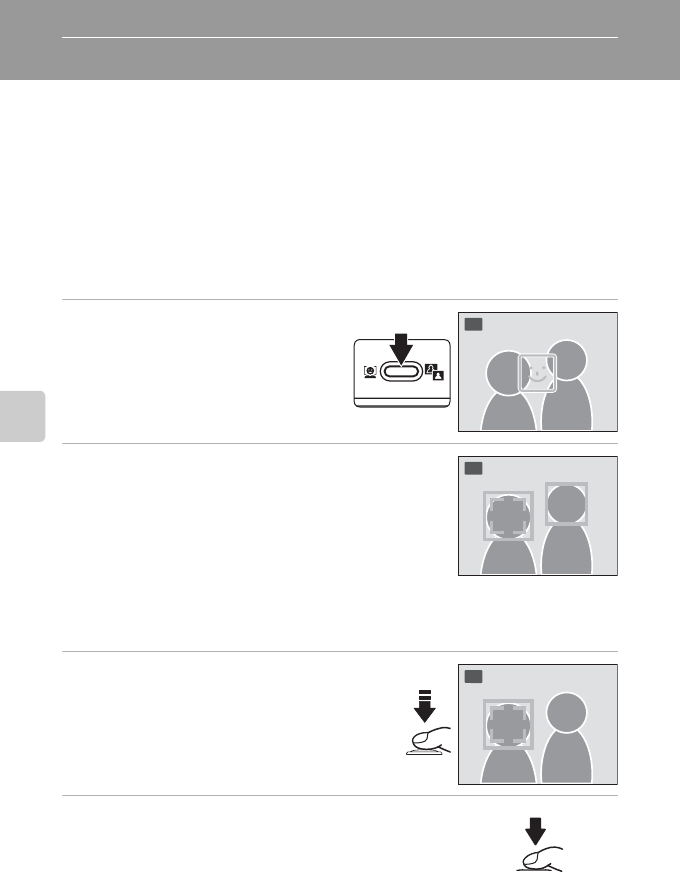
50
One-Touch Portrait Mode
One-Touch Portrait Mode
Taking Pictures in the One-Touch Portrait Mode
For portrait shots, press the
m
button when the camera is in
L
(auto) mode,
high-sensitivity shooting mode, scene mode, movie mode, and anti-shake mode.
The following features are automatically activated:
• Portrait: The portrait subject stands out clearly.
• Face-priority AF: The camera automatically detects and focuses on faces.
• Advanced red-eye reduction: Reduces “red-eye” caused by the flash
(c33). Macro close-up is not available in one-touch portrait mode.
Press m again to return to the shooting mode selected with the mode-selec-
tion menu.
1Press m (one-touch portrait
mode).
A yellow K guide is displayed.
2Frame a picture using the K guide.
When the camera detects a face, the guide is dis-
played with a double yellow border.
When the camera detects more than one face, the
closest face is framed by a double border and the rest
by a single border. The camera focuses on the face
framed by the double border. If the camera loses its
ability to detect a face (for example, because the subject has looked away from
the camera), borders are no longer displayed and monitor display returns to that
shown in step 1.
3Press the shutter-release button
halfway.
Focus and exposure are set, and the double
border turns green.
4Press the shutter-release button the rest
of the way down to take a picture.
A
A
A

51
One-Touch Portrait Mode
The One-Touch Portrait Menu
Press m in one-touch portrait mode to display the one-touch portrait
menu. In addition to image mode and exposure compensation, portrait
effects (reducing vividness of skin tones, softening overall image) can be set.
1The options chosen in this menu are stored until [Reset all] (c127) is performed in
the setup menu.
2The options chosen in this menu will be reset by switching to other shooting modes.
jFace-Priority AF
• The camera’s ability to detect faces depends on a variety of factors, including whether or
not the subject is facing the camera.
• The camera focuses continuously until a face is detected.
• If the yellow double border blinks when the shutter-release button is pressed halfway, the
camera was unable to focus. Release the button and try again.
• If no face is recognized when the shutter-release button is pressed halfway, the camera
focuses on the center of the frame.
• The camera may be unable to detect faces in the following situations:
- When faces are partially hidden by sunglasses or other obstructions
- When faces take up too much or too little of the frame
kSettings for One-Touch Portrait Mode
• Flash: Changeable
• Self-timer: Available
• Macro close-up: Off
ZImage mode1
Choose an image size and quality (c97).
IExp. +/– 2
Adjust exposure for very bright or very dark subjects (c101).
BPortrait effect1
Choose from [Normal], [Brighter] (reduces vividness of skin tones), and [Softer]
(soft effect).
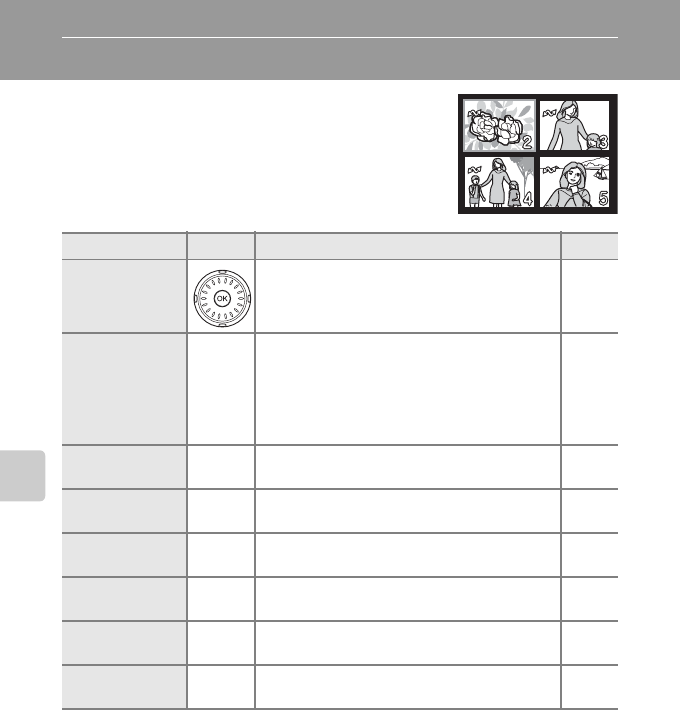
52
More on Playback
More on Playback
Viewing Multiple Pictures: Thumbnail Playback
Press the zoom control to t (j) in full-frame
playback (c30) to display pictures in “contact
sheets” of thumbnail images. The following opera-
tions can be performed while thumbnails are dis-
played:
To Press Description c
Choose pictures Use the rotary multi selector to choose pic-
tures. 12
Change number
of pictures dis-
played
x
Display 4, 9, 16 or 25 picture thumbnails in
the following order, when the zoom control is
pressed to t (j): 4→9→16→25
When the zoom control is pressed to v (k),
the number of picture thumbnails changes
reversely.
–
Cancel thumb-
nail playback dCancel thumbnail playback and return to full-
screen playback. 30
D-Lighting i(m)Enhance brightness and contrast in dark por-
tions of pictures. 56
Delete picture TConfirmation dialog will be displayed. Choose
[Yes] and press d to delete. 30
View playback
menu mDisplay the playback menu. 108
View playback
mode menu DDisplay the playback mode-selection menu. 10
Switch to shoot-
ing mode oSwitch to the shooting mode selected last
time. 30
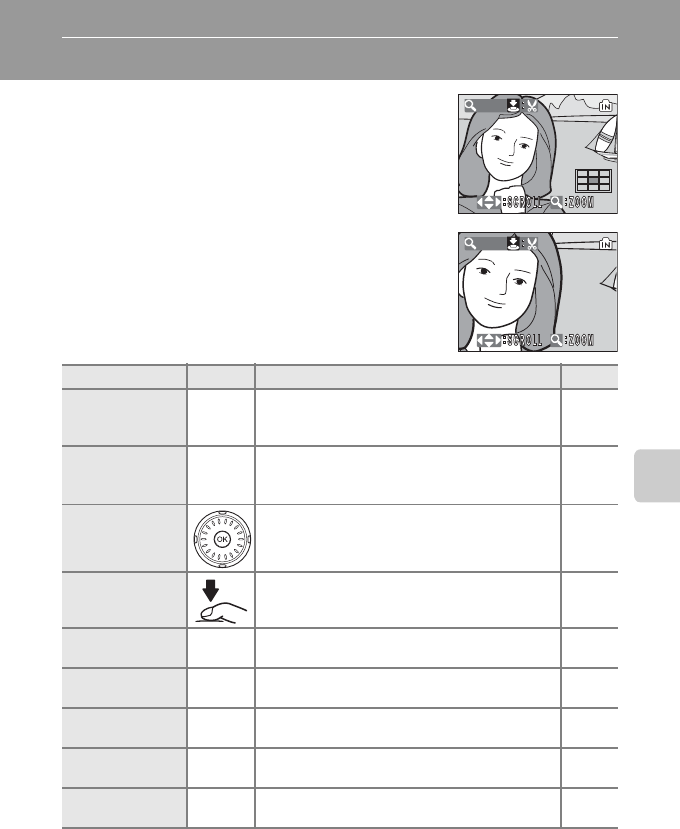
53
More on Playback
Taking a Closer Look: Playback Zoom
Pressing the zoom control to
v
(
k
) during full-frame
playback (
c
30) zooms the current picture in 3×,
with the center of the picture displayed in the moni-
tor (Quick Playback Zoom).
The guide in the lower right shows where the part of the
picture is enlarged. The part of the picture displayed is
changed by pressing the rotary multi selector
GHIJ
.
With the zoom control in quick zoom playback, you
can enlarge pictures in the desired magnification
ratio. While image is zoomed in, the zoom ratio is
displayed on the monitor. The following operations
can be performed while pictures are zoomed in:
jNote on Enlarging Vertically Taken Images
Vertically taken images (c124) cannot be rotated in quick playback zoom or zoom mode.
Images can be displayed by pressing the zoom control to v (k) in full-frame playback. Press
again to v (k) to display the image enlarged horizontally.
To Press Description c
Zoom in
Zoom
control
to v (k)
Zoom increases each time the zoom control is
pressed to v (k), to a maximum of 10×. –
Zoom out
Zoom
control to
t
(
j
)
Zoom decreases each time the zoom control is
pressed to
t
(
j
). When the magnification ratio
reaches 1×, the display returns to full-frame playback.
–
View other
areas of picture
Press the rotary multi selector GHIJ to
scroll to areas of the picture not visible in the
monitor.
12
Crop picture Crop current picture to contain only the por-
tion visible in the monitor. 55
Switch to full-
frame playback dCancel playback zoom and return to full-
screen playback. 30
Delete picture TConfirmation dialog will be displayed. Choose
[Yes] and press d to select. 30
View playback
menu mDisplay the playback menu. 108
View playback
mode menu DDisplay the playback mode-selection menu. 10
Switch to shoot-
ing mode oSwitch to the shooting mode selected last
time. 30
X3.0
X4.0
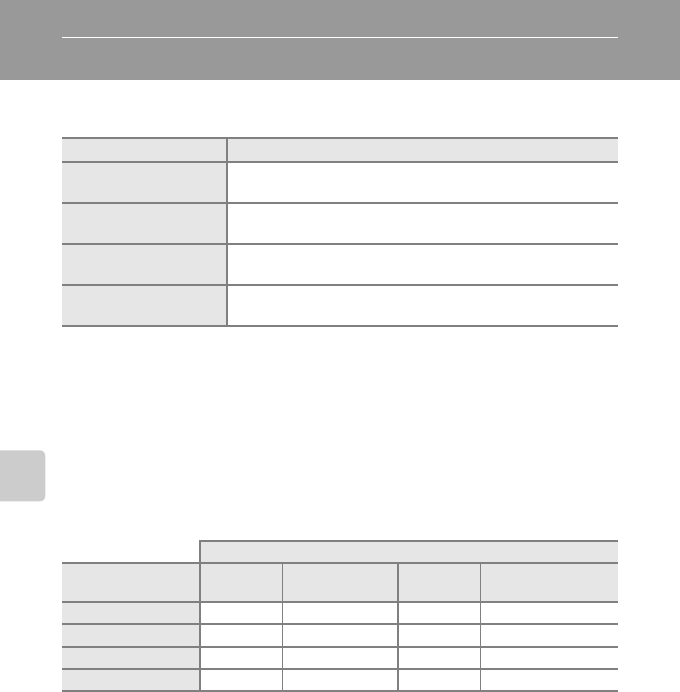
54
More on Playback
Editing Pictures
Use the COOLPIX S7c to edit pictures in-camera and store them as separate
files (c160). The editing features described below are available.
kPicture Editing
• The COOLPIX S7c editing functions may not be available for pictures taken with non-
COOLPIX S7c digital cameras.
• If a copy created using the COOLPIX S7c is viewed on a different digital camera, the picture
may not be displayed or may not be transferred to a computer.
• Editing functions are not available when there is not enough free space in the internal
memory or on the memory card.
lRestrictions on Picture Editing
* Includes pictures taken in anti-shake mode.
• Pictures cannot be edited twice with the same editing function.
• The D-Lighting or electronic VR should be done first while the restricted use of combination
exists.
lOriginal Pictures and Edited
• Copies created with editing functions are not deleted if the original pictures are deleted.
The original pictures are not deleted if copies created with editing functions are deleted.
• Edited copies are stored with the same recording date and time as the original.
• Edited copies have the same transfer marking (c112) as the original but are not marked
for printing (c93) or protecting (c111).
Editing function Description
Crop Enlarge the image or refine the composition and create a
copy containing only the portion visible in the monitor.
D-Lighting Create a copy of the current picture with enhanced bright-
ness and contrast, brightening dark portions of the picture.
Electronic VR Sharpen blurred images digitally after they are taken. Cor-
rected images are stored as new files.
Small picture Create a small copy of pictures suitable for use on web
pages or as e-mail attachments.
2nd editing
1st editing Crop D-Lighting
Electronic
VR
Small picture
Crop ––– –
D-Lighting y–yy
Electronic VR* yy –y
Small picture ––– –
(y: available, –: not available)
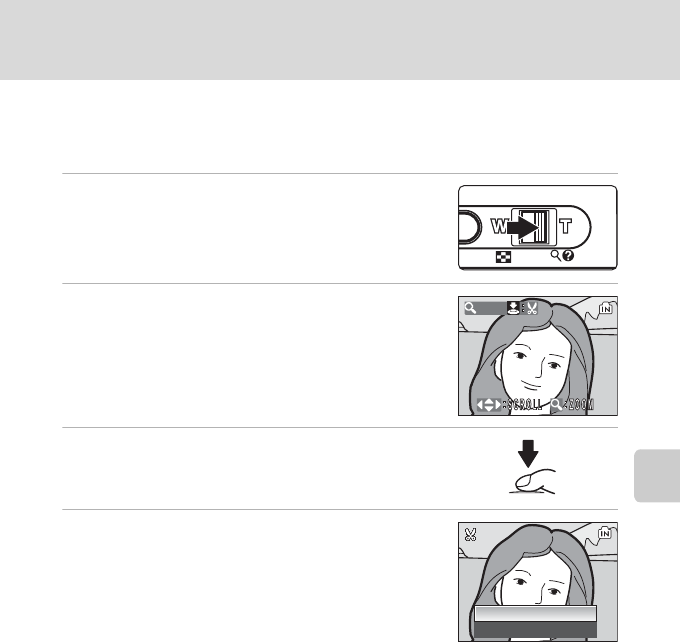
55
Editing Pictures
More on Playback
Creating a Cropped Copy: Crop
This function is only available when N:u is displayed in the monitor with
playback zoom (c53) enabled. Cropped copies are stored as separate files.
1Press the zoom control to v (k) to zoom
in on the image.
2Refine copy composition.
Press the zoom control to v or t to adjust the zoom
ratio.
Press the rotary multi selector GHIJ to scroll the
picture until only the portion you want to copy is visi-
ble in the monitor.
3Press the shutter-release button.
The confirmation dialog will be displayed.
4Use the rotary multi selector to choose
[Yes] and press d.
A new picture, containing only the portion visible in
the monitor, is created.
Depending on the size of the original picture and the zoom ratio in effect at the time the copy
was created, the camera will automatically select one of the following image-mode settings
for cropped copies (unit: pixels).
•d 2,592 × 1,944 • a 2,288 × 1,712 • e 2,048 × 1,536
•f 1,600 × 1,200 • g 1,280 × 960 • h 1,024 × 768
•i 640 × 480 • J 320 × 240 • K 160 × 120
X4.0
Save this image
Save this image
as displayed?
as displayed?
Save this image
as displayed?
No
Yes
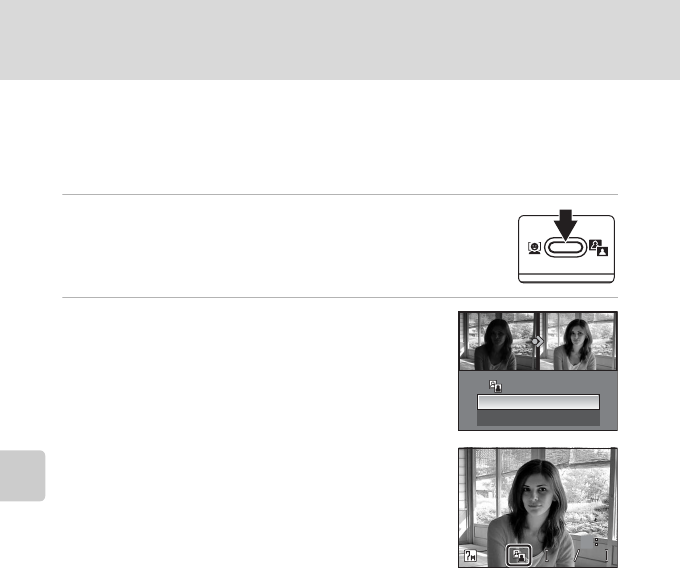
56
Editing Pictures
More on Playback
Enhancing Brightness and Contrast: D-Lighting
D-Lighting can be used to create copies with enhanced brightness and con-
trast, brightening dark portions of a picture. Enhanced copies are stored as
separate files.
1Display the desired picture in full-frame (c30) or
thumbnail (c52) playback and press i (m).
The results of D-Lighting enhancement can be confirmed in the
monitor.
2Use the rotary multi selector to choose
[OK] and press d.
A new copy with enhanced brightness and contrast is
created.
To cancel D-Lighting, choose [Cancel] and press d.
D-Lighting copies can be recognized by the i icon
displayed during playback.
D-Lighting
OK
Cancel
100NIKON
100NIKON
15:30
15:30
15:30
100NIKON
2006.10.10
2006.10.10
2006.10.10
0003.JPG
0003.JPG
0003.JPG
433 4
O
MM
N
EE
DDO
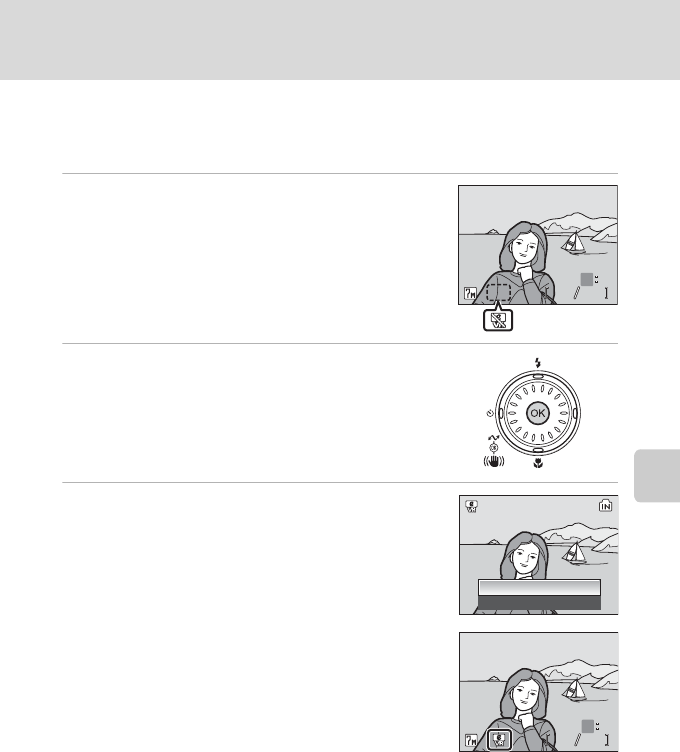
57
Editing Pictures
More on Playback
Compensating Blurred Images: Electronic VR
Vibration reduction is used to create a new image by compensating the
blurred image. Created copies are stored as separated files.
1Choose the desired image in full-frame
playback (c30).
When the X indicator is displayed, vibration reduc-
tion is not available.
2Press d (F) (electronic VR).
3Use the rotary multi selector to choose
[OK] and press d.
Compensated image is created.
To cancel vibration reduction, choose [Cancel] and
press d.
For compensated images, the L indicator is dis-
played in the monitor during playback.
jNote on Electronic VR
In addition to the restrictions described in “Restrictions on Picture Editing” (c54), electronic
VR cannot be used for the following pictures:
•
Pictures taken with Multi-shot 16 (
c
102), with slow shutter speeds, or with other cameras.
• Pictures with date imprint (c121).
• Pictures with minor blur, or pictures that are badly blurred.
100NIKON
100NIKON
15:30
15:30
15:30
100NIKON
0004.JPG
0004.JPG
0004.JPG
2006.10.10
2006.10.10
2006.10.10
44
O
MM
44
N
EE
O
Reduce blur?
Reduce blur?
Reduce blur?
OK
Cancel
100NIKON
100NIKON
15:30
15:30
15:30
100NIKON
0004.JPG
0004.JPG
0004.JPG
2006.10.10
2006.10.10
2006.10.10
44
O
MM
44
N
EE
O
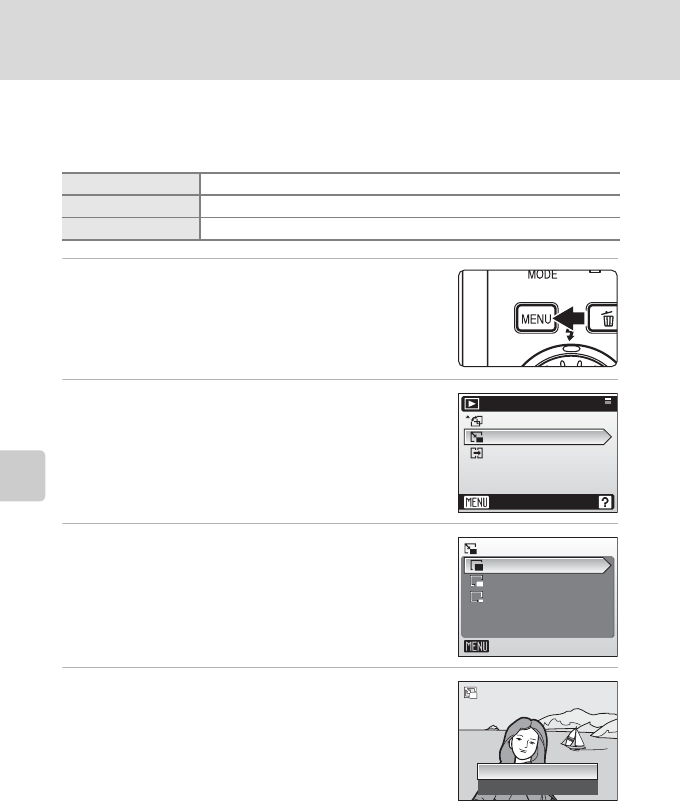
58
Editing Pictures
More on Playback
H Resizing Pictures: Small Picture
Create a small copy of the current picture. Small copies are stored as JPEG
files with a compression ratio of 1:16. The following sizes are available.
1Display the desired picture in full-frame
(c30) or thumbnail (c52) playback
mode and press m.
The playback menu is displayed.
2Use the rotary multi selector to choose
[Small pic.] and press d.
3Choose the desired copy size and press
d.
A confirmation dialog will be displayed.
To cancel, press m.
4Choose [Yes] and press d.
A new, smaller copy is created.
I 640×480 Suited to television playback.
J 320×240 Suited to display on web pages.
K 160×120 Suitable for e-mail attachments.
Playback menu
Exit
Rotate image
Small pic.
Copy
Small pic.
320X240
Exit
640X480
160X120
Yes
No
Create small picture file?
Create small picture file?
Create small picture file?
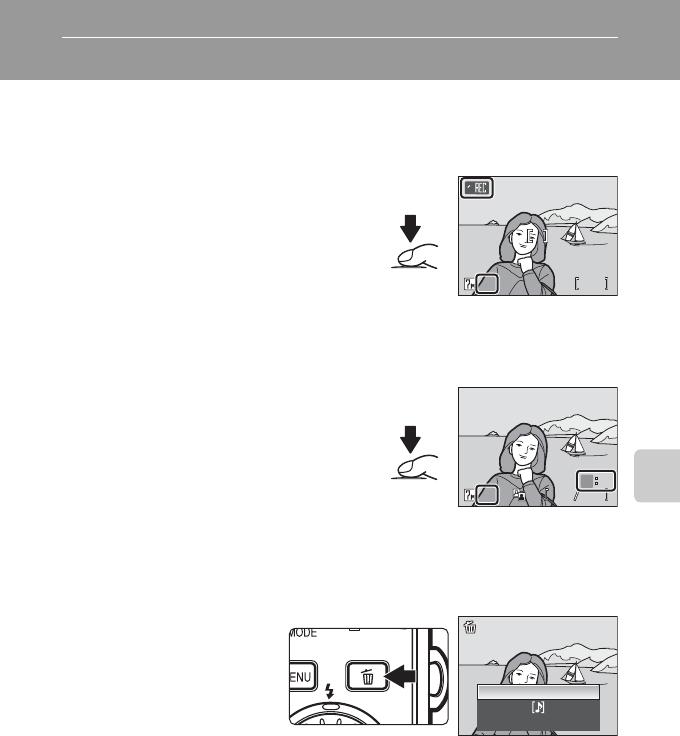
59
More on Playback
Voice Memos: Recording and Playback
Use the camera’s built-in microphone to record voice memos for pictures
marked with N:O in full-frame playback (c30).
Recording Voice Memos
A voice memo will be recorded while the
shutter-release button is held down.
Recording ends after about 20 seconds or
when the shutter-release button is released.
• Do not touch the built-in microphone
during recording.
• During recording, y and P blink in
the monitor display.
Playing Voice Memos
Press the shutter-release button while a pic-
ture is displayed in full-frame playback to
play voice memo. Playback ends when the
voice memo ends or the shutter-release
button is pressed again.
• Pictures with voice memos can be recog-
nized by the N:P and P icons.
• Use the zoom control to adjust playback volume. Press to t (j) to lower
volume, or to v (k) to raise volume.
Deleting Voice Memos
Select a picture with a voice
memo and press T. Use the
rotary multi selector to
choose [P] and press d.
Only the voice memo will be
deleted.
jVoice Memos
• Voice memos are assigned the picture file name they are attached to with the three-letter
extension “.WAV” (e.g., DSCN0015.WAV) (c160).
• If a voice memo already exists for the current picture, it must be deleted before a new voice
memo can be recorded.
17s
17s
17s
MM
y
PP
100NIKON
100NIKON
15:30
15:30
15:30
100NIKON
2006.10.10
2006.10.10
0004.JPG
0004.JPG
0004.JPG
2006.10.10
44 44
MM
N
EE
DD
PP
PP
MM
Erase 1 image?
Erase 1 image?
Erase 1 image?
No
Yes
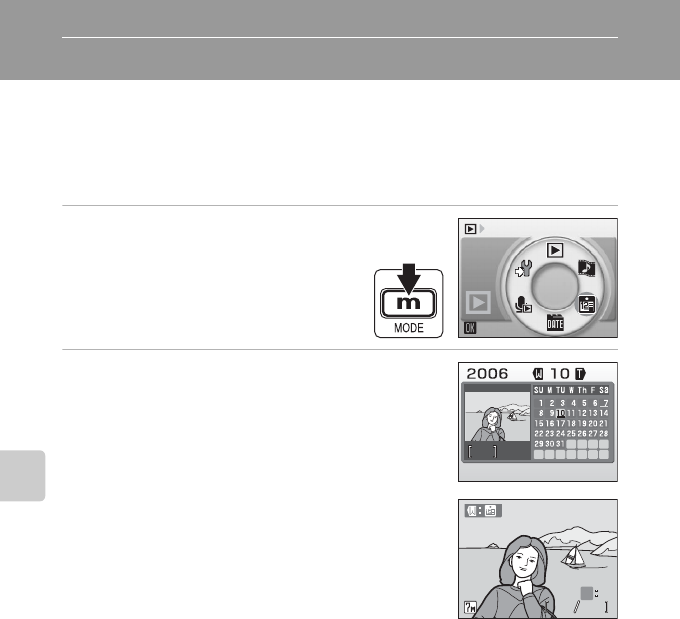
60
More on Playback
Viewing Pictures by Date
Pictures taken on a specific date can be selected for viewing, deletion, print-
ing, protection, and transfer.
The date can be selected from a calendar or a list.
Selecting a Date in Calendar Mode
1Enter calendar mode by pressing
D in playback mode, selecting
J (use the rotary multi selec-
tor), and then pressing d.
2Choose a date and press d.
Dates for which pictures exist are underlined in yel-
low.
Press the zoom control to t (j) to view previous
month, press to v (k) to view following month.
The first picture for that date will be displayed full-
frame.
Press the zoom control in full-frame playback to t
(j) to return to calendar mode.
Calendar
33
2006.10.10
2006.10.10
15:30
15:30
2006.10.10
15:30
31 31
O
MM
N
EE
O
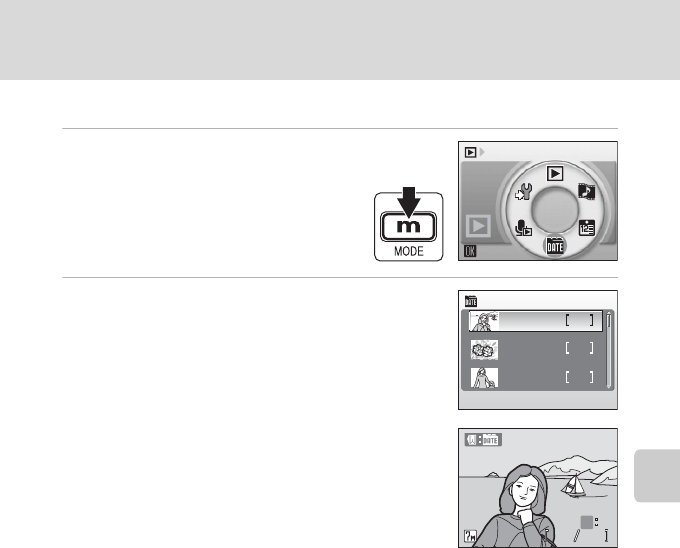
61
Viewing Pictures by Date
More on Playback
Selecting a Date in List-by-Date Mode
1Enter list-by-date mode by
pressing D, selecting L (use
the rotary multi selector) in
playback mode, and then press-
ing d.
Dates for which pictures exist will be listed.
2Choose date and press d.
Camera lists up to 30 dates. If pictures exist for more
than 30 dates, all pictures recorded earlier than most
recent 29 dates will be listed together as [Others].
The first picture for that date will be displayed full-
frame.
Press the zoom control in full-frame playback to t
(j) to return to the date list.
List by date
List by date
10.10.2006 3
2
5
09.10.2006
08.10.2006
2006.10.10
2006.10.10
15:30
15:30
2006.10.10
15:30
31 31
O
MM
N
EE
O
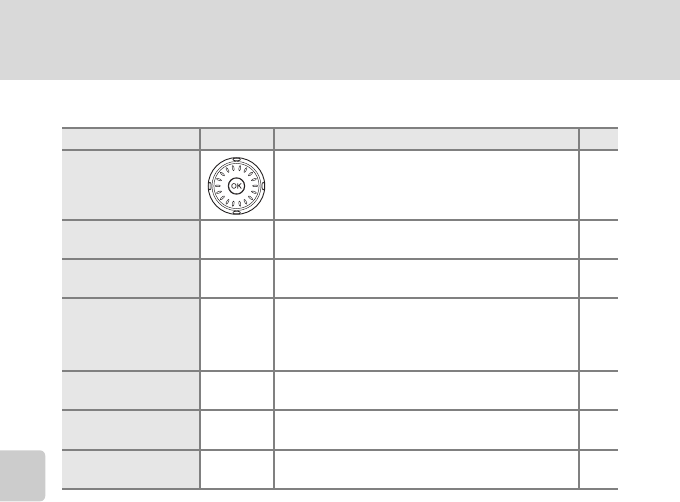
62
Viewing Pictures by Date
More on Playback
Using Calendar Mode and List-by-Date Mode
jNotes on Calendar Mode and List-by-date Mode
• Up to 9,000 pictures can be registered in calendar mode or in list-by-date mode. If more
pictures exist, “*” is displayed next to the number.
• Pictures taken with no date stamp are not listed in these modes.
To Press Description c
Select date Use the rotary multi selector to select a date. –
Select month (cal-
endar mode only) xPress to t (j) to view previous month,
press to v (k) to view following month. –
Switch to full-
frame playback dDisplay the first picture taken on the selected
date. –
Delete picture T
Press after selecting a date, and a confirma-
tion dialog will be displayed. Choose [Yes]
and press d to delete all pictures taken on
the selected date.
30
View calendar or
list-by-date menu mDisplay the calendar or list-by-date menu. 64
View playback
mode menu DDisplay the playback mode-selection menu. 10
Switch to shoot-
ing mode oSwitch to the shooting mode selected last
time. 30
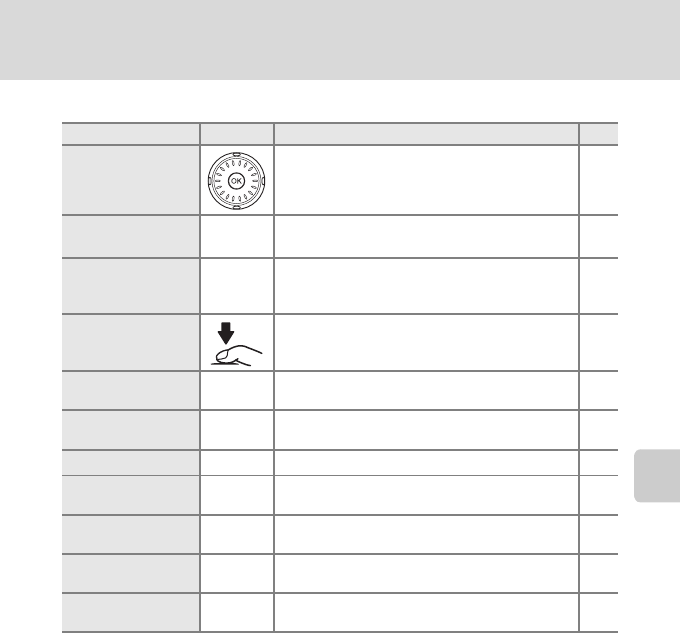
63
Viewing Pictures by Date
More on Playback
The following operations are available when in full-frame playback:
To Press Description c
View other pic-
tures
Use the rotary multi selector to choose and
view other pictures. 30
Zoom in v
(k)
A maximum of 10× zoom in is available after
using Quick Playback Zoom. 53
Switch to calen-
dar/list-by-date
mode playback
t
(j)
Switch to the calendar or list-by-date mode
selected before viewing in full-frame play-
back.
–
Record/play voice
memo
Record or play back voice memos up to 20
seconds in length. 59
D-Lighting i (m)Enhance brightness and contrast in dark por-
tions of pictures. 56
Electronic VR dPress d while displaying a picture to com-
pensate a blurred image. 57
View movie dMovie playback will start. 76
Delete picture TConfirmation dialog will be displayed. Choose
[Yes] and press d to delete. 30
View calendar or
list-by-date menu mDisplay the calendar or list-by-date menu. 64
View playback
mode menu DDisplay the playback mode-selection menu. 10
Switch to shoot-
ing mode oSwitch to the shooting mode selected last
time. 30

64
Viewing Pictures by Date
More on Playback
Calendar Mode and List-by-Date Mode Menus
Press m in either mode to display the following menus for only the pic-
tures taken on the specified date.
Print set c93
Slide show c110
Delete c111
Protect c111
Transfer marking c112
Rotate image* c112
Small picture* c58
* During full-frame playback only
The procedure for selecting pictures in calendar or date list playback differs
from that in full-frame playback.
• In calendar or date list playback, the options apply to all pictures taken on
the currently selected date.
• In full-frame playback, although the options apply only to the picture cur-
rently displayed full frame, other pictures taken on the same date can be
selected.
jPrint Set and Transfer Marking
If [Print set] or [Transfer marking] is selected from the menu for the calendar or date list when
print or transfer marking already exists for dates other than the specified date, a confirmation
dialog [Save print marking for other dates?] or [Save transfer marking for other dates?] will be
displayed. Select [Yes] to add to the existing print or transfer marking. Selecting [No] removes
the existing print or transfer marking from all pictures in the internal memory or on the mem-
ory card, ensuring that only pictures taken on the specific date are selected for printing or
transfer.
lFull-Frame Playback
When pictures are displayed full frame in calendar or list-by-date mode, the respective icon is
displayed in the top left corner, and the date and time of recording are displayed in place of
the folder name and file number and type.
2006.10.10
2006.10.10
15:30
15:30
2006.10.10
15:30
31 31
O
MM
N
EE
O
Date/time
Calendar mode/
List-by-date mode
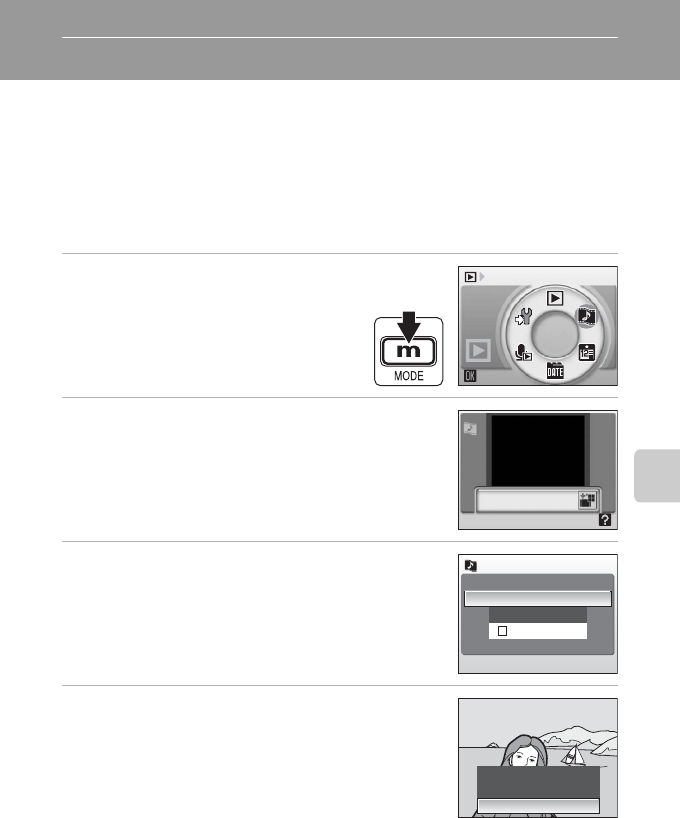
65
More on Playback
Pictmotion by muvee
Pictmotion* creates slide show movies with custom transitions and back-
ground music.
It is only available when a memory card is inserted in the camera.
* Pictmotion is powered by muvee Technologies.
Creating a Pictmotion Movie
This section describes the easiest way to create a Pictmotion movie.
1Enter Pictmotion mode by press-
ing D in playback mode,
selecting P (use the rotary
multi selector), and then press-
ing d.
2Choose M and press d.
3Choose [All images] and press d.
A Pictmotion movie using the ten most recent pic-
tures (default setting) will be created.
After the created Pictmotion movie is automatically
played back, a confirmation dialog will be displayed.
4Choose [Yes] and press d.
The Pictmotion movie is saved and the monitor dis-
play returns to that shown in step 2.
Settings for saved Pictmotion movies cannot be
changed. If you wish to change the settings, delete
the Pictmotion movie and create a new Pictmotion
movie with the desired settings.
Pictmotion by muvee
All images
Choose date
Confirm
Picture selection
Save Pictmotion?
Save Pictmotion?
Save Pictmotion?
No
Change settings
Yes
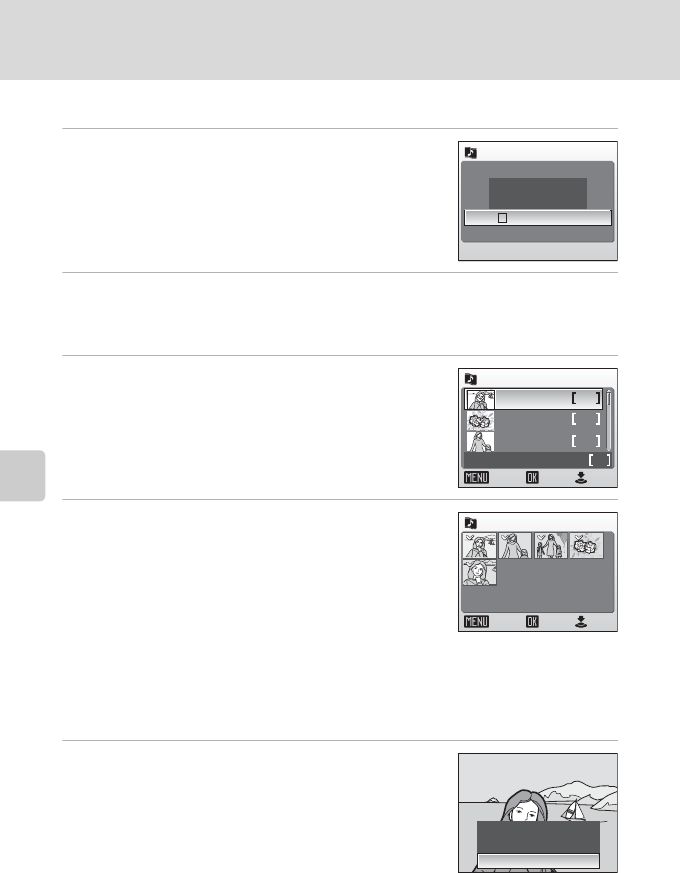
66
Pictmotion by muvee
More on Playback
Creating a Custom Pictmotion Movie
1Use the rotary multi selector to choose
[Confirm] in the picture selection menu
(c65, step 3) and press d.
The check box is selected (y).
2Choose [All images] or [Choose date] and press d.
[All images]: Proceed to step 4
[Choose date]: Proceed to step 3
3Select a date and press the shutter-
release button.
Choose a date and press d to mark (y).
4Select pictures and press the shutter-
release button.
If [All images] is selected in step 2, all pictures will be
displayed. If [Choose date] is selected, only pictures
taken on the date selected in step 3 will be displayed.
Choose pictures and press d to select (up to 30).
Press the zoom control to v (k) to view selected pic-
ture full-frame; press to t (j) to return to thumb-
nail display.
After the created Pictmotion movie is automatically played back, a confirmation
dialog will be displayed.
5Choose [Yes] and press d.
The Pictmotion movie is saved.
All images
Choose date
Confirm
Picture selection
Choose date
Confirm
images total
ON/OFF
10.10.2006 3
2
5
5
09.10.2006
08.10.2006
Back
Select image
ConfirmON/OFF
Back
5/30
[Choose date]
Save Pictmotion?
Save Pictmotion?
Save Pictmotion?
No
Change settings
Yes

67
Pictmotion by muvee
More on Playback
jNotes on Pictmotion
• Pictmotion supports both still pictures and movie files; note, however, that in the case of
movies only a small portion selected from the first 60 seconds of each movie will be
included.
• If the current memory card holds 20 Pictmotion movies, no additional movies can be cre-
ated until an existing movie has been deleted.
• The pictures in a Pictmotion movie are automatically protected when the movie is saved
(c111).
lPictureProject (Windows only)
• The Windows version of the supplied PictureProject software can be used to transfer Pict-
motion movies to a computer for viewing and to copy up to five three-minute custom
sound tracks to a memory card inserted in the camera; see the PictureProject Reference
Manual (on CD) for details.
• Pictmotion movies can also be transferred to a computer using the [Easy Transfer (PM)] or
[PC mode] option of wireless transfer mode (c130).
lDeleting Pictmotion Movies
To delete a Pictmotion movie, choose the desired movie file in the Pictmotion menu (c65,
step 2), and press T. Protection (c111) is not removed when the Pictmotion is deleted.
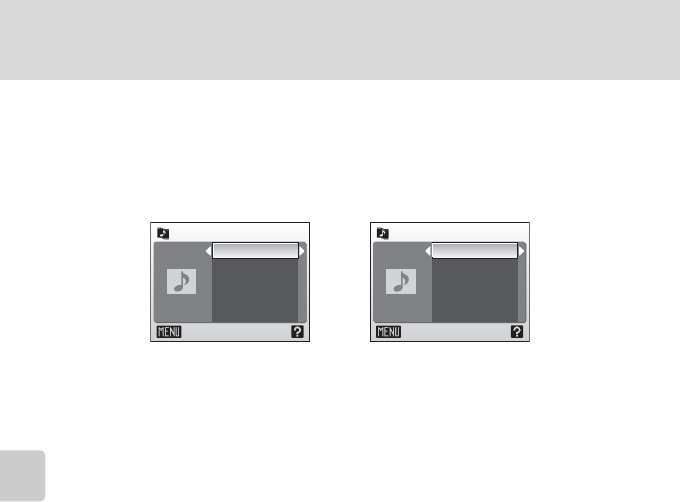
68
Pictmotion by muvee
More on Playback
Other Options for Pictmotion Movies
Pressing
m
in the Pictmotion screen (
c
65, step 2) displays the Pictmotion
settings menu, while pressing it in the save confirmation dialog (
c
65, step 4)
displays the change settings menu. The following options are available.
Background Music
Choose from five preset music tracks and five user-defined tracks. Preset music
tracks include [High-speed], [Emotional], [Natural], [Up-tempo], and [Relaxed].
• Preset tracks can be played back by pressing the zoom control to v (k).
User-defined tracks cannot be played back.
•
Music tracks from a computer will be added to the user-defined track list. Names
of the tracks are displayed in the list only when transferred from a computer.
Effects
Choose from [Motion], [Moody], [Pro-slow], [Pro-fast], and [Classic].
•
Press the zoom control to
v
(
k
) to preview selected style on the left side of the monitor.
Playback Order
Random: Play back pictures in random order.
Play in order: Play back pictures in order recorded.
Loop
Repeat music: Repeat background track until all pictures have been
played at least once (some pictures may be repeated).
Repeat photos: Play background track once, repeating or omitting
pictures as necessary.
• In some cases, pictures may be shown repeatedly regardless of the setting.
Selected Images
This option can only be set from the Pictmotion settings menu.
Choose from 10, 20, 30 or [No auto select].
For example, if [20 pictures] is selected, the last 20 pictures are chosen for the
Pictmotion movie. This number can be changed, however, when creating a
customized Pictmotion movie. When [Confirm] is selected in picture selection
screen (c66, step 1), the number of pictures chosen in step 4 will be used.
Background music
Exit
Motion
Random
Repeat photos
10 pictures
High-speed
Background music
Back
Motion
Random
Repeat photos
High-speed
Pictmotion settings
menu
Change settings
menu
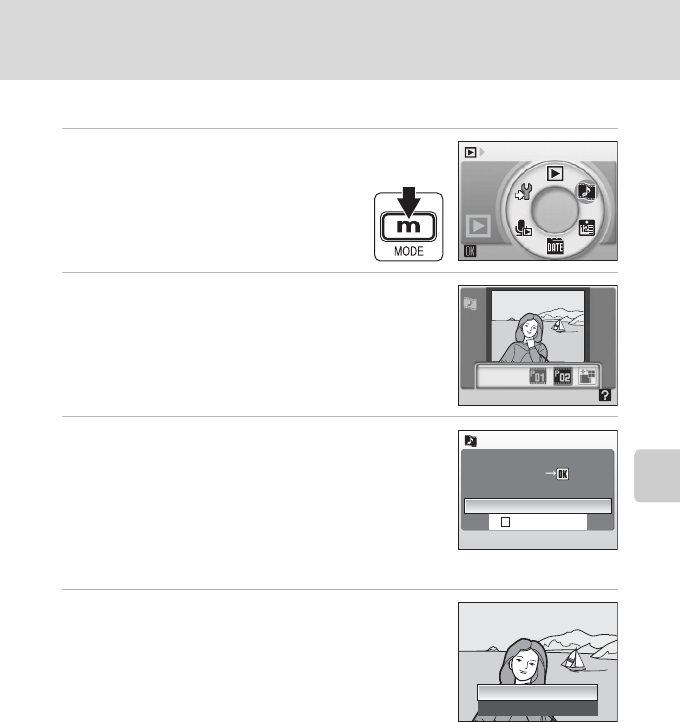
69
Pictmotion by muvee
More on Playback
Viewing Pictmotion Movies
1Enter Pictmotion playback mode
by pressing D in playback
mode, selecting P (use the
rotary multi selector), and then
pressing d.
2Use the rotary multi selector to choose
the desired Pictmotion movie and press
d.
3Choose [Play] and press d.
Playback starts.
If [Loop] is selected, the movie will repeat automati-
cally. To select or deselect [Loop], choose [Loop] and
press d.
Zoom control controls volume.
To pause the movie, press d during playback.
4Choose [End] and press d.
Monitor returns to that shown in step 2.
To resume playback, choose [Restart] and press d.
Pictmotion by muvee
Loop
Play
Pause
Pictmotion
Restart
End
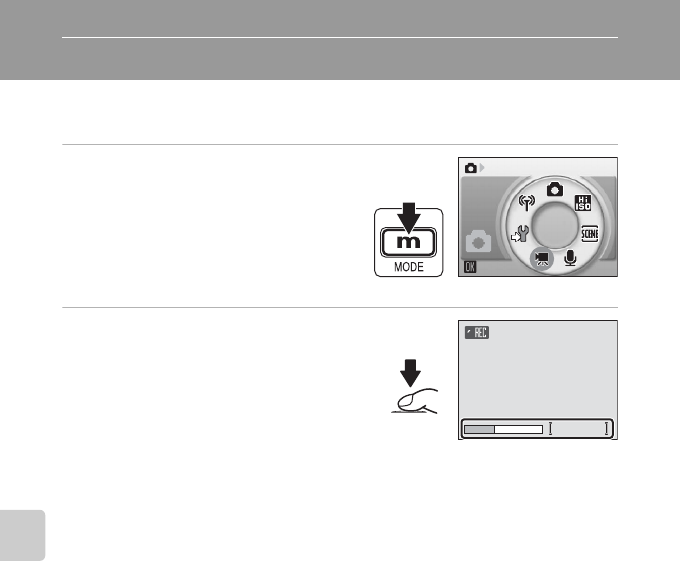
70
Movies
Movies
Recording Movies
To shoot movies with sound recorded via the built-in microphone, select
shooting mode and follow the steps below.
1Enter movie mode by pressing
D in shooting mode, selecting
S (use the rotary multi selec-
tor), and then pressing d.
Exposure count display shows maximum
total length of movie that can be
recorded.
2Press the shutter-release button
fully to start recording.
A progress bar at the bottom of the monitor
shows the amount of recording time remain-
ing.
To end recording, press the shutter-release
button all the way down a second time.
Recording will automatically stop if the internal memory or memory card becomes
full.
jRecording Movies
• The flash (c32) can only be used for time-lapse and stop-motion movies. The self-timer
(c34) cannot be used, and exposure compensation (c101) is not available. Macro mode
(c35), however, is available in all modes.
• Digital zoom (up to 2×) can be applied while movies are being recorded. Adjust optical
zoom before beginning recording. Once recording begins, optical zoom cannot be
adjusted.
lChanging Movie Settings
Movie options, auto-focus mode, or electronic VR can be changed (c71).
Movie
MM
29s
29s
29s
y

71
Movies
The Movie Menu
Press m in movie mode to display the movie menu.
TMovie options c72
Choose type of movie that will be recorded.
YAuto-focus mode c75
Choose how camera focuses in movie mode.
cElectronic VR c75
Reduce effects of camera shake.
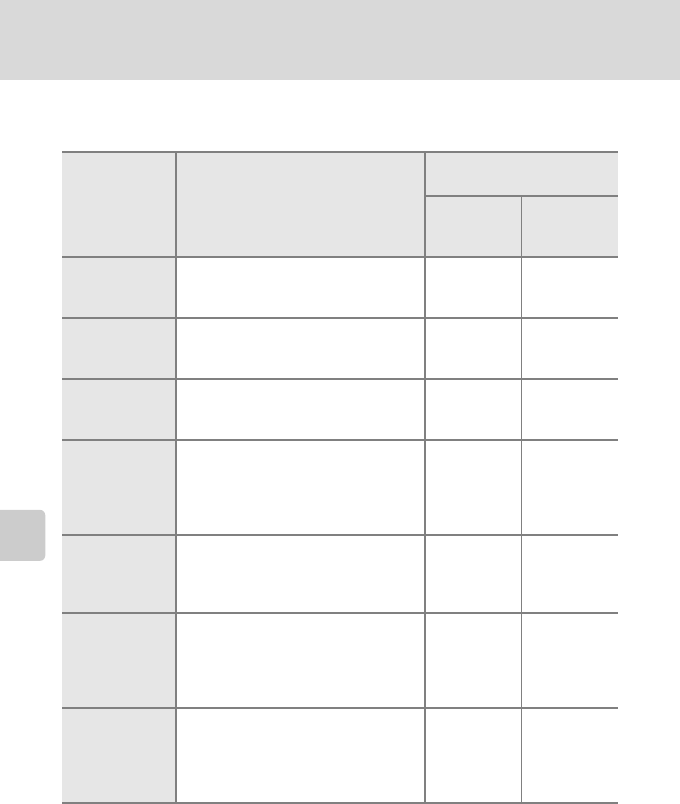
72
The Movie Menu
Movies
Selecting Movie Options
The movie menu offers the options shown below.
* Movies can be as long as free space in the internal memory or on the memory card
allows. All figures are approximate. Maximum movie length or frames varies with
make of memory card.
Option Description
Maximum movie length/
frames*
Internal
memory
(14 MB)
Memory
card
(256 MB)
Q
TV movie
640A
Movies are recorded at 30 frames per
second. Each frame is 640 × 480 pix-
els in size.
12 sec. 3 min.
40 sec.
u
Small size
320A
Movies are recorded at 30 frames per
second. Each frame is 320 × 240 pix-
els in size.
25 sec. 7 min.
20 sec.
S
Small size 320
(default)
Movies are recorded at 15 frames per
second. Each frame is 320 × 240 pix-
els in size.
49 sec. 14 min.
30 sec.
W
Pictmotion 320
Movies are recorded at 15 frames per
second. Each frame is 320 × 240 pix-
els in size. Recording automatically
stops after 60 seconds. Suited for
Pictmotion movies (c65).
49 sec. 1 min.
U
Smaller size
160
Movies are recorded at 15 frames per
second. Each frame is 160 × 120 pix-
els in size. Small size allows for
recording of longer movies.
2 min.
44 sec. 48 min.
V
Time-lapse
movieA
The camera takes pictures at speci-
fied intervals and joins them into a
silent movie. Each frame is 640 × 480
pixels in size. Playback frame rate is
30 fps.
149 frames 1,800
frames
E
Stop-motion
movie
Pictures can be taken at desired
intervals and joined into a silent
movie. Each frame is 640 × 480 pix-
els in size. Playback frame rate is 15
fps.
149 frames 1,800
frames
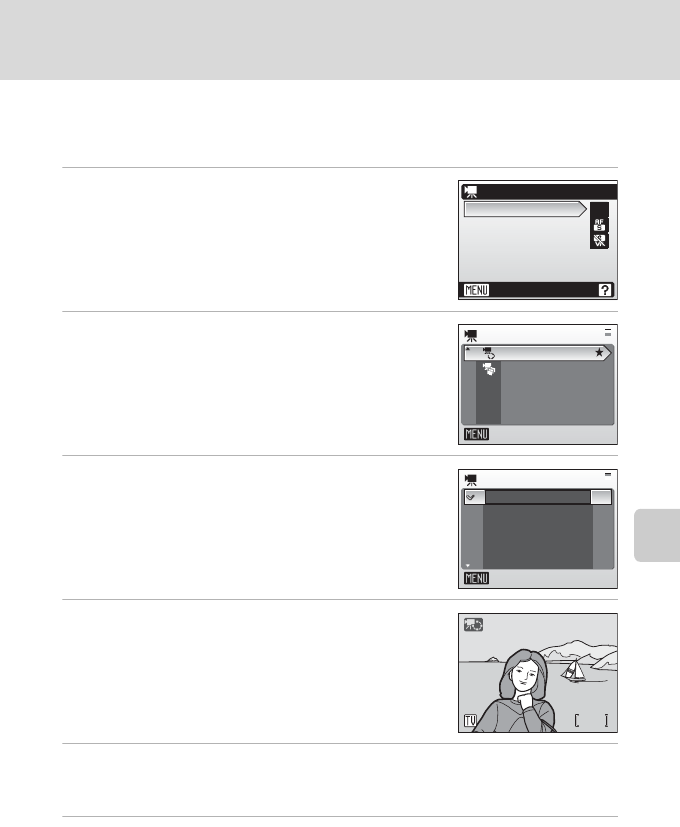
73
The Movie Menu
Movies
Time-Lapse Movies
Record flowers opening or butterflies emerging from cocoons. Charge the
battery before shooting begins.
1Use the rotary multi selector to choose
[Movie options] and press d.
2Choose [Time-lapse movieA] and press
d.
3Choose the interval between shots and
press d.
4Press m.
The camera returns to shooting mode.
5
Press the shutter-release button all the way down to start recording.
Monitor turns off and indicator lamp blinks green between shots.
Monitor reactivates automatically for the next shot.
6Press the shutter-release button all the way down a second
time to end recording.
Recording will automatically stop if the internal memory or memory card becomes
full, or when a maximum of 1,800 frames (up to 60 seconds) have been recorded.
S
Movie
Exit
Movie options
Auto-focus mode
Electronic VR
Movie options
Exit
Time-lapse movie
Stop-motion movie
Set interval time
30s
1m
5m
10m
30m
Exit
149
149
149
MM
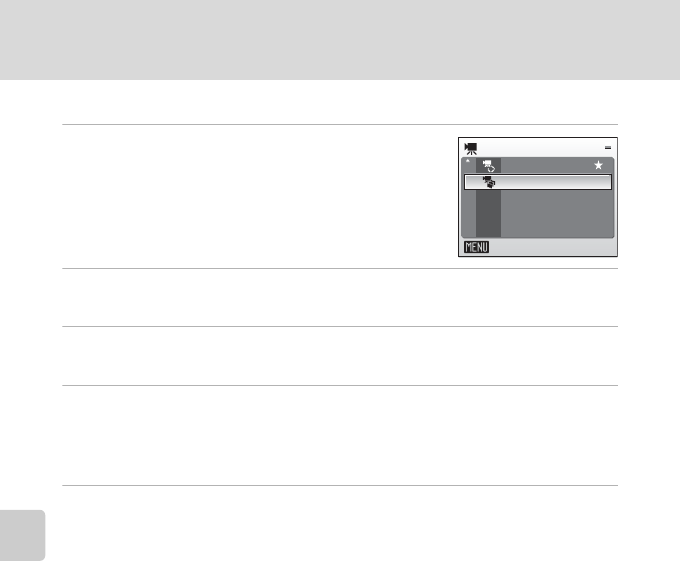
74
The Movie Menu
Movies
Stop-Motion Movies
1Use the rotary multi selector to choose
[Movie options] > [Stop-motion movie]
and press d.
2Press m.
The camera returns to shooting mode.
3Press the shutter-release button to record the first frame.
The recorded picture will be superimposed on the view through the lens.
4Press the shutter-release button to record the second frame.
The second frame will be superimposed on the first frame.
The monitor turns off automatically if no operations are performed for 30 minutes
(auto off), and recording ends.
5Press d to end recording.
Recording automatically ends when 1,800 pictures are taken.
jTime-Lapse Movie and Stop-Motion Movie
To prevent the camera from turning off unexpectedly during recording, use a fully charged
battery.
Movie options
Exit
Time-lapse movie
Stop-motion movie
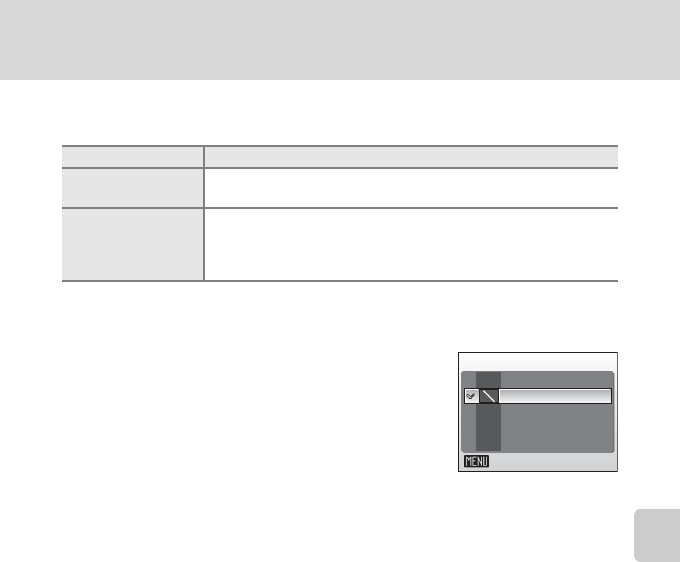
75
The Movie Menu
Movies
Auto-Focus Mode
Choose how the camera focuses in movie mode.
Electronic VR
Choose [On] to reduce the effects of camera shake
in all movie modes except [Time-lapse movieA] and
[Stop-motion movie].
At settings other than [Off], an electronic VR indica-
tor is displayed in the monitor (c8).
kMovie File Names and Folder Names
See “Image File and Folder Names” (c160).
Option Description
Z Single AF
(default)
Camera focuses when shutter-release button is pressed half-
way and locks at this position during shooting.
a Full-time AF
Camera focuses continuously, even when shutter-release but-
ton is not pressed halfway.
To prevent sound of camera focusing from interfering with
recording, it is recommended to use [Single AF].
L
L
c
Electronic VR
Exit
On
Off
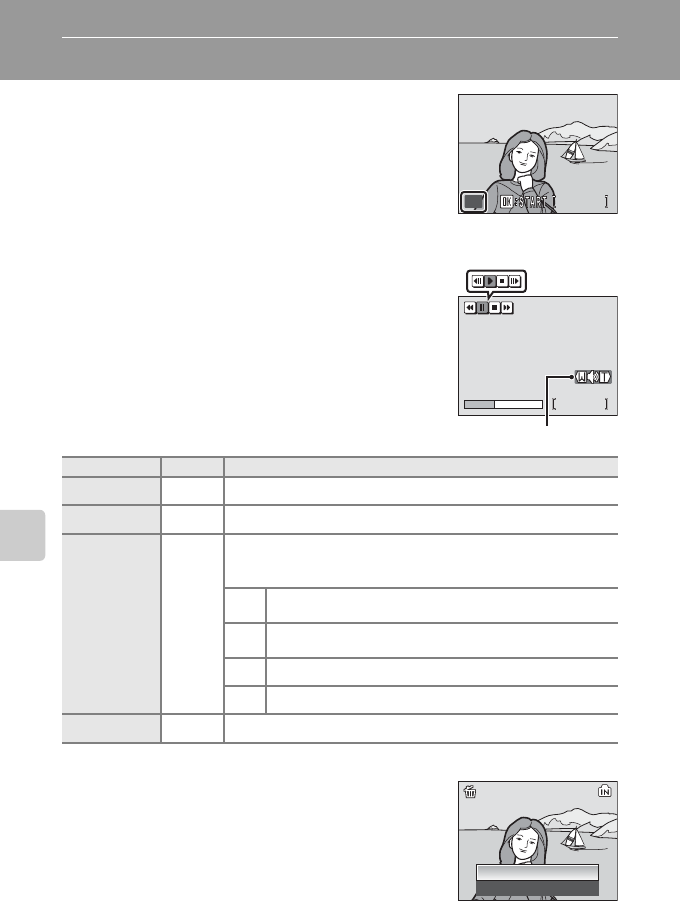
76
Movies
Movie Playback
In full-frame playback (c30), movies are recog-
nized by the T icon. To play a movie, display it in
full-frame playback and press d.
Use the zoom control to adjust playback volume.
Press to t (j) to lower volume, or to v (k) to
raise volume.
Rotate the rotary multi selector to advance or
rewind the movie at twice the normal speed.
Playback controls appear at the top of the monitor.
Press the rotary multi selector IJ to choose a con-
trol, then press d to perform the selected opera-
tion. The following operations are available:
Deleting Movie Files
Press T during movie playback or when displayed in
full-frame (c30) or thumbnail (c52) playback
mode. A confirmation dialog is displayed. Choose
[Yes] and press d to delete the movie, or choose
[No] and press d to return to the normal playback
display without deleting the movie.
To Press Description
Rewind QRewind movie. Playback resumes when d is released.
Advance UAdvance movie. Playback resumes when d is released.
Pause R
Pause playback.
While paused, use the rotary multi selector to advance or rewind the movie.
The following operations can be performed while playback is paused.
VRewind movie by one frame. Rewind continues while
d is pressed.
WAdvance movie by one frame. Advance continues
while d is pressed.
zResume playback.
SEnd playback and return to full-frame playback.
End SEnd playback and return to full-frame playback.
100NIKON
100NIKON
15:31
15:31
15:31
100NIKON
2006.10.10
2006.10.10
2006.10.10
0010.MOV
0010.MOV
0010.MOV
10s
10s
10s
MM
EE
S
During playback
4s
4s
4s
MM
Volume indicator
Pausing
Erase 1 image?
Erase 1 image?
Erase 1 image?
No
Yes
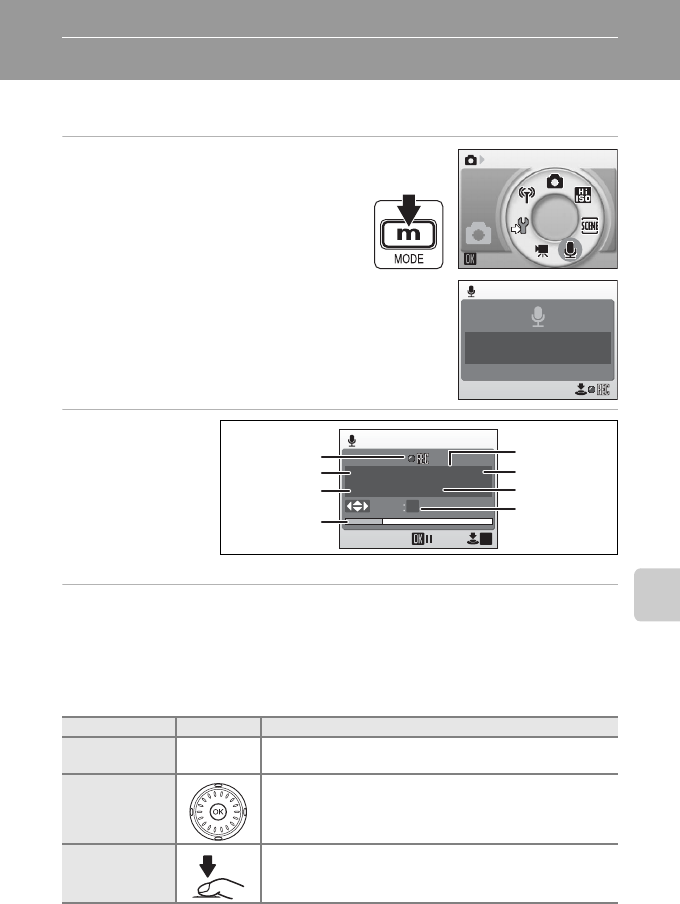
77
Voice Recordings
Voice Recordings
Making Voice Recordings
Audio voice recordings can be recorded over the built-in microphone and
played back over the built-in speaker.
1
Enter voice recording mode by
pressing
D
in shooting mode,
selecting
O
(use the rotary multi
selector), and then pressing
d
.
The length of recording that can be made
will be displayed.
2
Press the shut-
ter-release but-
ton fully to
start recording.
Camera enters
standby mode dur-
ing recording. The
monitor turns off and the indicator lamp turns green.
3
Press the shutter-release button fully a second time to end recording.
Recording will end automatically if the internal memory or memory card becomes
full, or after five hours of recording on the memory card.
Operations During Recording
The following operations are available during recording. If the monitor has
turned off, press o to reactivate.
To Press Description
Pause/resume
recording dPress once to pause recording; self-timer and indicator
lamps will blink.
Create index
During recording, press the rotary multi selector to create
index. Camera can skip to any index during playback.
Start of recording is index number 1; other numbers are
assigned in ascending order, to a maximum of 98.
End recording Press the shutter-release button fully a second time to
end recording.
Voice recording
Voice recording
00:05:00
Max rec time
001 10:3010.10.06
N
Voice recording
Index
01
00:00:05
/
00:05:00
001 10:3010.10.06
N
Recording
indicator
Progress
indicator
Index number
Time remaining
Date of
recording
Length of
recording
File number Sound quality
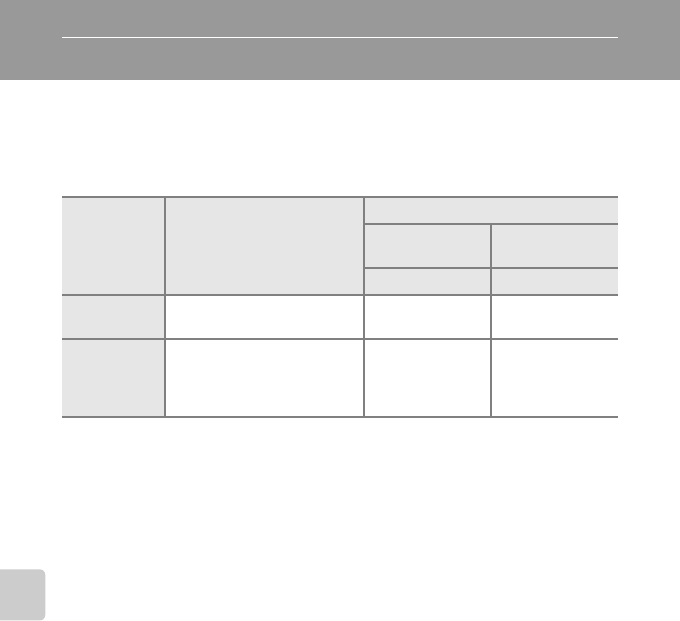
78
Voice Recordings
Changing the Sound Quality
Press m in voice recording mode to display the following sound quality
options.
Sound Quality
Choose the sound quality for the recording.
* Movies can be as long as free space in the internal memory or on the memory card
allows (up to five hours). All figures are approximate. Maximum movie length varies
with make of memory card.
jVoice Recordings
• PictureProject cannot be used to transfer or play voice recordings. Select [Interface] > [Mass
storage] for [USB], copy the files manually.
• The copied files can be played back using QuickTime or any other WAV-compatible audio
player.
• Note that index points created with the camera cannot be used when voice recordings are
played back on computers.
Option Description
Maximum movie length*
Internal
memory Memory card
14 MB 256 MB
O
Normal Suited for longer recordings. 30 min. 36 sec. 5 hours
N
High
(default)
Record with high quality
sound. Note that sound will
not be heard while fast for-
warding or rewinding.
11 min. 5 sec. 3 hours 14 min.
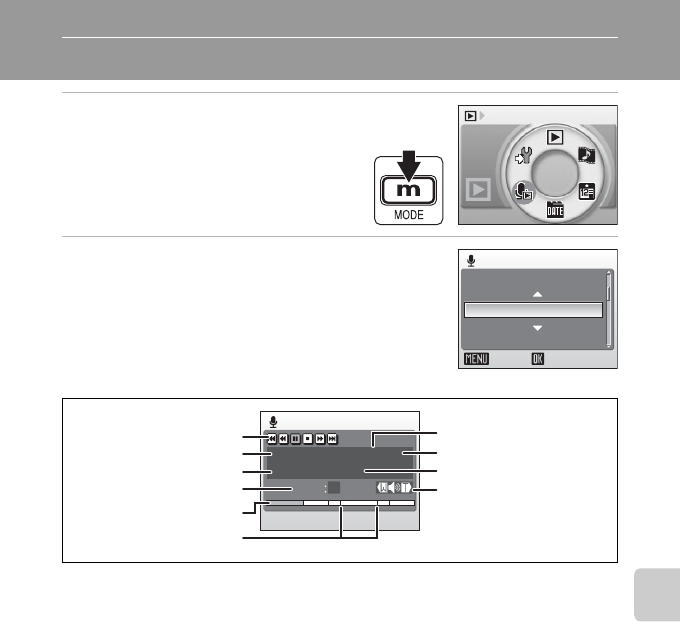
79
Voice Recordings
Playing Voice Recordings
1Enter audio playback mode by
pressing D in playback mode,
selecting q (use the rotary
multi selector), and then press-
ing d.
2Choose the desired file and press d.
The selected file will be played back.
Audio playback
Select sound file
002 11:05
Copy Play
10.10.06
001 10:30
N
N
N
10.10.06
003 10:0515.10.06
Audio playback
Index
01
00:00:10
/
00:00:20
001 10:30
10.10.06
N
Control icons
File number
Playback time
Index number
Progress indicator
Date and time of
recording
Length of recording
Volume
Index
Sound quality
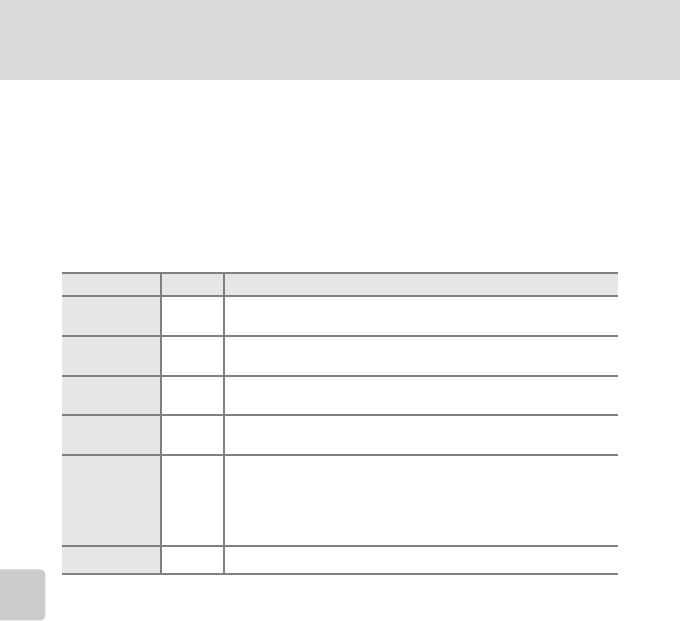
80
Playing Voice Recordings
Voice Recordings
Operations During Playback
Use the zoom control to adjust playback volume. Press to t (j) to lower
volume, or to v (k) to raise volume.
Rotate the rotary multi selector to advance or rewind the voice recording at
twice the normal speed.
Playback controls appear at the top of the monitor. Press the rotary multi
selector IJ to choose a control, then press d to perform the selected
operation. The following operations are available:
lDeleting Sound Files
Press T during playback or after selecting a sound file (use the rotary multi selector). A confir-
mation dialog will be displayed. To delete the file, choose [Yes] and press d. To cancel dele-
tion, choose [No] and press d.
To Press Description
Rewind QRewind voice recording. Playback resumes when d is
released.
Advance UAdvance voice recording. Playback resumes when d is
released.
Skip to pre-
vious index VSkip to previous index.
Skip to next
index WSkip to next index.
Pause
R
z
S
Pause playback.
The following operations can be performed while playback
is paused.
Resume playback.
End playback and return to full-frame playback.
End SEnd playback and return to full-frame playback.
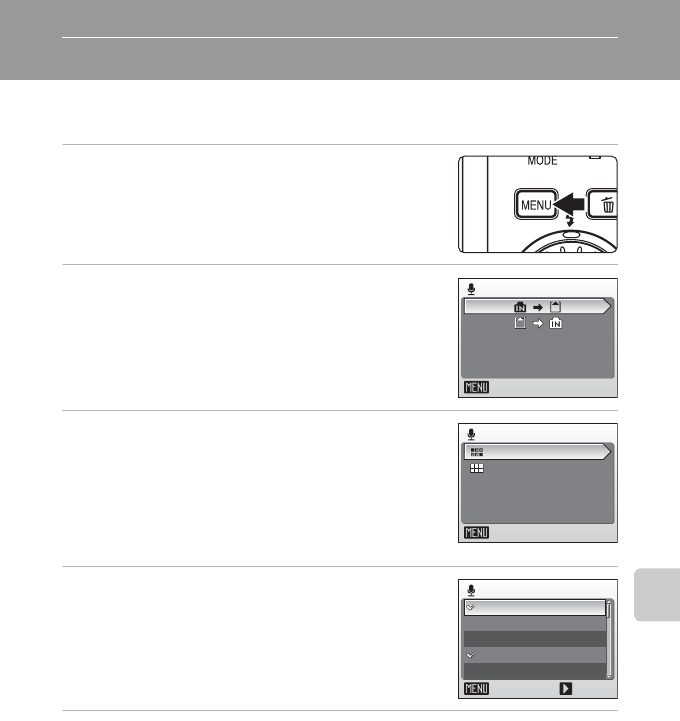
81
Voice Recordings
Copying Voice Recordings
Copy voice recordings between the internal memory and a memory card.
This option is available only when a memory card is inserted.
1Press m in the select sound file screen
(c79, step 2).
2Use the rotary multi selector to choose
the option and press d.
MNO: Copy recordings from internal memory to
memory card
ONM: Copy recordings from memory card to inter-
nal memory
3Choose the copy option and press d.
[Selected files]: Proceed to step 4
[Copy all files]: Proceed to step 5
4Choose the desired file and press d.
Choose the desired file and press J to mark.
A confirmation dialog will be displayed.
5Choose [Yes] and press d.
Copying starts.
kVoice Recordings
The COOLPIX S7c may be unable to play or copy sound files created with other make of cam-
era.
Copy sound files
Exit
Camera to card
Copy all files
Exit
Selected files
Select sound files
Exit Select
003 10:0515.10.06
001 10:3010.10.06
002 11:0510.10.06
004 13:2325.10.06
005 15:0025.10.06
N
N
N
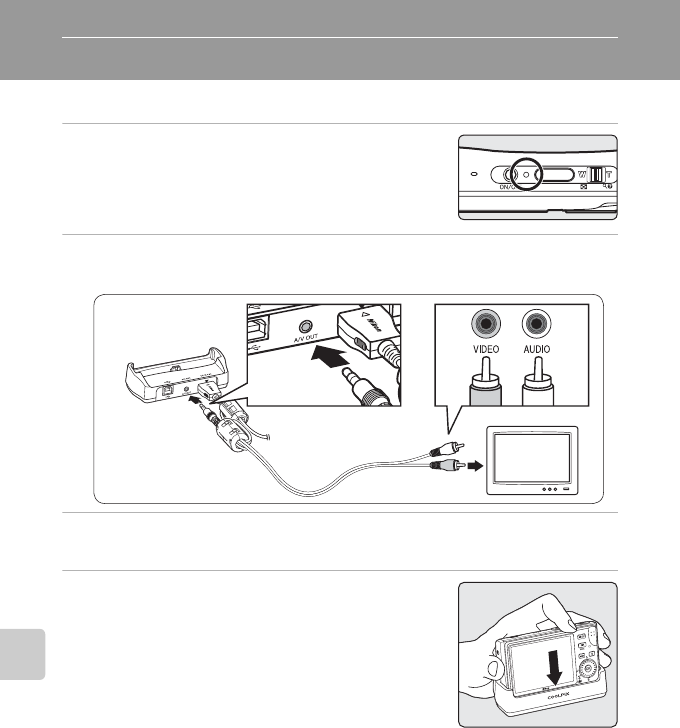
82
Connecting to Televisions, Computers, and Printers
Connecting to Televisions, Computers, and Printers
Connecting to a TV
Connect the camera to a television using the A/V cable to play back pictures on the television.
1Turn off the camera.
2
Connect the COOL-STATION to the TV using the supplied A/V cable.
Connect the yellow plug to the video-in jack on the TV, and the white plug to the audio-in jack.
3Tune the television to the video channel.
See the documentation provided with your television for details.
4Place the camera in the COOL-STATION
and press o for more than one sec-
ond to turn on the camera.
The camera enters playback mode, and the pictures
taken will be displayed on the television.
While connected to the TV, the camera monitor will
remain off.
jConnecting an A/V Cable
When connecting the A/V cable, be sure that the camera connector is oriented correctly. Do
not use force when connecting the A/V cable to the camera. When disconnecting the A/V
cable, do not pull the connector at an angle.
jVideo Mode
Be sure that the camera’s video mode setting conforms to the standard used by your television.
The video mode setting is an option set from setup menu (c114) > [Interface] (c126) >
[Video mode].
WhiteYellow

83
Connecting to Televisions, Computers, and Printers
Connecting to a Computer
Use the USB cable and PictureProject software supplied with your camera to
copy (transfer) pictures to a computer.
• You can play back pictures on a computer transferred via wireless LAN.
See “Wireless Transfer Mode” (c130) for more information.
Before Connecting the Camera
Installing PictureProject
Before transferring pictures or movies to a computer, PictureProject must be
installed. For more information on installing and using PictureProject, see the
Quick Start Guide or the PictureProject Reference Manual (on CD).
Confirming USB Option
The following two methods can be used to transfer pictures from the camera
to a computer:
• Click [Transfer] in PictureProject.
•Press E (d) on the camera.
The method used will depend on your computer’s operating system and the
USB option selected in the camera’s setup menu.
1This camera supports the USB options, [Mass storage] and [PTP] (default setting).
Choose [PTP] to transfer pictures stored in the internal memory. Pictures cannot be
transferred when [Mass storage] is chosen.
2The camera’s E (d) button cannot be used to transfer pictures in the following
cases. Use the [Transfer] button in PictureProject.
• When transferring pictures from the camera’s internal memory and [Mass storage]
is selected in the USB menu.
• When the memory card write-protect switch is in the “lock” position. Unlock by
sliding the switch to the “write” position before transferring pictures.
3If your computer is running Windows 2000 Professional, be sure to set the USB
option to [Mass storage]. If [PTP] is selected, the [Found New Hardware Wizard] will
be displayed when the camera is connected to the computer. Select [Cancel], close
the window, and disconnect the camera from the computer.
Operating system
USB mode1
Camera E (d)
button2PictureProject Transfer
button
Windows XP Home Edition
Windows XP Professional Choose [Mass storage] or [PTP].
Windows 2000 Professional3Choose [Mass storage].
Mac OS X 10.3.9 or later Choose [PTP]. Choose [Mass storage] or
[PTP].
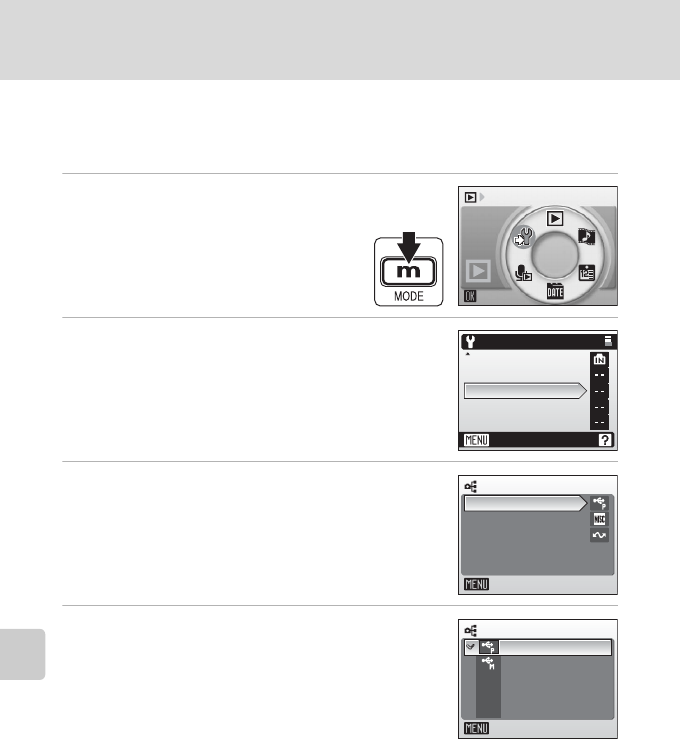
84
Connecting to a Computer
Connecting to Televisions, Computers, and Printers
Setting the USB Option
Set the USB option in the setup menu (c114) on the camera before con-
necting the camera to a computer or printer.
1Display the setup menu by
pressing D, selecting Z (use
the rotary multi selector), and
then pressing d.
2Choose [Interface] and press d.
3Choose [USB] and press d.
4Choose [PTP] or [Mass storage] and press
d (c83).
The setting is enabled.
Press m to exit setup menu.
Set up
Exit
Set up
Format memory
Language
Interface
Reset all
Firmware version
Interface
Exit
USB
Video mode
Auto transfer
USB
Exit
PTP
Mass storage
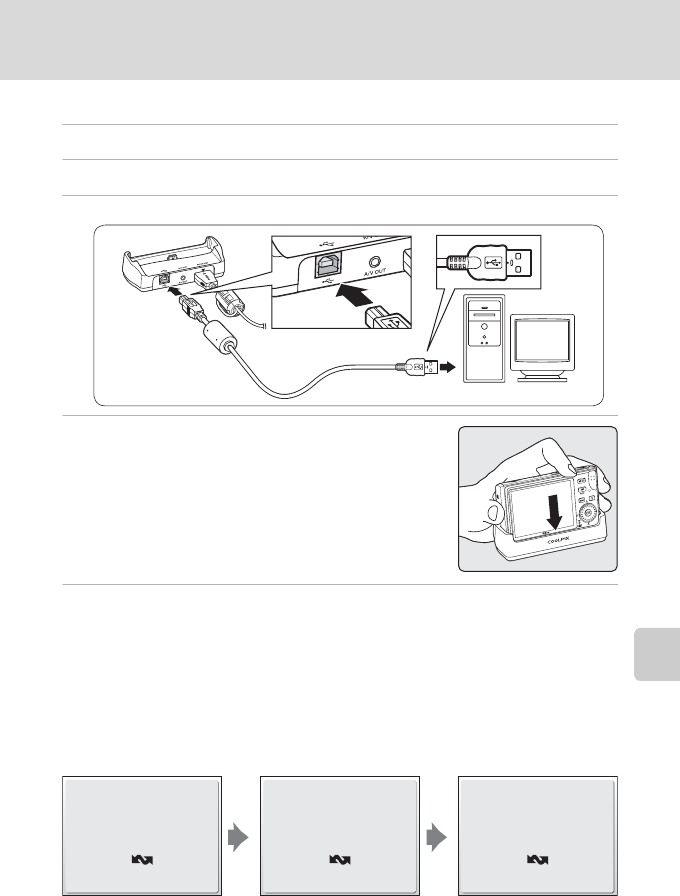
85
Connecting to a Computer
Connecting to Televisions, Computers, and Printers
Transferring Pictures to a Computer
1Start a computer to which PictureProject has been installed.
2Turn off the camera.
3
Connect the COOL-STATION to the computer using the supplied USB cable.
4Turn the camera on after placing it in the
COOL-STATION.
At default PictureProject settings, PictureProject Trans-
fer is launched immediately with recognition of cam-
era connection.
5Transfer pictures.
Transfer using PictureProject
Click [Transfer] button in PictureProject Transfer.
All pictures and movies marked for transfer are copied to the computer. Once
transfer is complete, pictures are displayed in PictureProject.
Transfer using the camera’s d (E) button
While PictureProject Transfer is launched, press d (E) to copy pictures marked
for transfer (c86) to the computer. The following messages are displayed in the
camera monitor during transfer.
Preparing to transfer
Transferring images to
computer Transfer completed
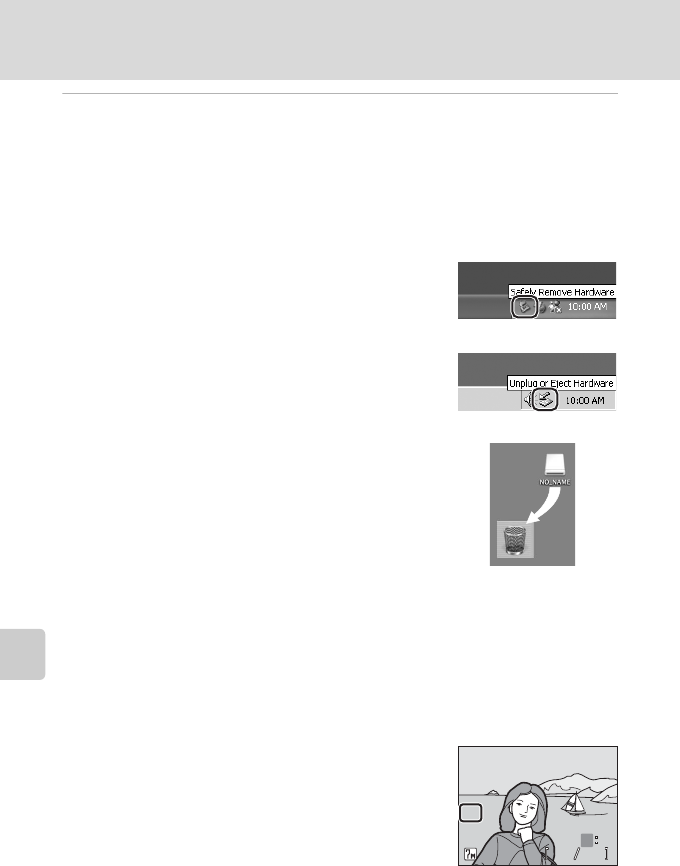
86
Connecting to a Computer
Connecting to Televisions, Computers, and Printers
6Disconnect the camera once transfer is complete.
If the USB option is set to [PTP]
Turn the camera off and disconnect the USB cable.
If the USB option is set to [Mass storage]
Remove the camera from the system as described below before turning the
camera off and disconnecting the USB cable.
Windows XP Home Edition/Windows XP Professional
Click the [Safely Remove Hardware] icon in the
taskbar and select [Safely remove USB Mass Stor-
age Device] from the menu displayed.
Windows 2000 Professional
Click the [Unplug or Eject Hardware] icon in the
taskbar and select [Stop USB Mass Storage Device]
from the menu displayed.
Macintosh
Drag the untitled camera volume (“NO_NAME”) to
the Trash.
jConnecting the USB Cable
When connecting the USB cable, be sure that the connectors are oriented correctly. Do not
use force when connecting the USB cable. When disconnecting the USB cable, do not pull the
connector at an angle.
kMarking Pictures for Transfer
When d is pressed while the camera is connected to a com-
puter, pictures marked with the E icon during playback will
be transferred to the computer. As the default setting, all pic-
tures are automatically marked for transfer. Two options con-
trol transfer marking:
• [Interface] > [Auto transfer] in the setup menu (c126):
Choose [On] to mark all new pictures for transfer (default
setting).
• [Transfer marking] in the playback menu (c112): Change marking for existing pictures.
100NIKON
100NIKON
15:30
15:30
15:30
100NIKON
2006.10.10
2006.10.10
0004.JPG
0004.JPG
0004.JPG
2006.10.10
44 44
O
MM
N
EE
O
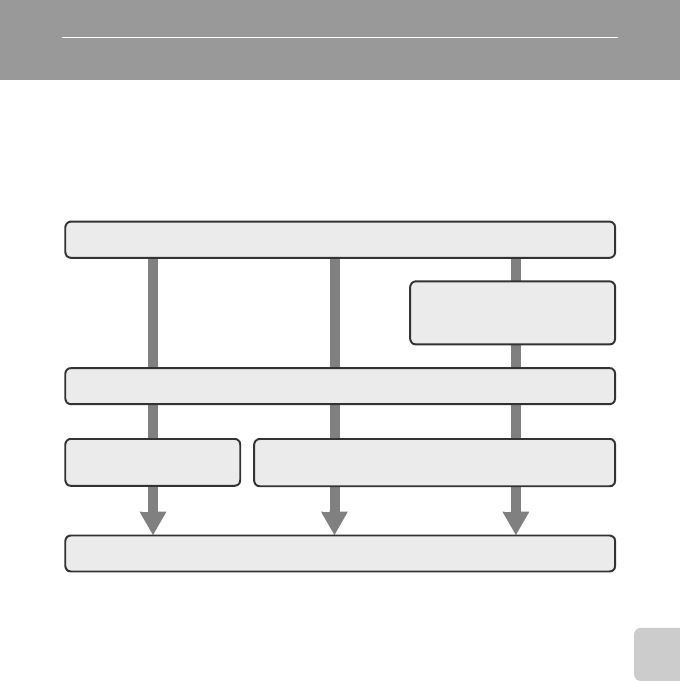
87
Connecting to Televisions, Computers, and Printers
Connecting to a Printer
Users of PictBridge-compatible (c177) printers can connect the camera
directly to the printer and print pictures without using a computer.
• To print pictures directly from the camera, configure the printer connected
to the computer as a profile device for wireless transfer mode (c130).
You can also use the optional PD-10 wireless printer adapter in wireless
transfer mode (c158).
jBefore Connecting the Camera
Use a fully charged battery or the supplied EH-64 AC adapter to prevent the camera from
turning off unexpectedly while connected.
lPrinting Pictures
In addition to printing pictures transferred to a computer from your personal printer and
printing over a direct camera-to-printer connection, the following options are also available
for printing pictures:
• Insert a memory card into a DPOF-compatible printer’s card slot
• Take a memory card to a digital photo lab
For printing using these methods, specify the pictures and the number of prints each using
your camera’s print set menu (c93).
lImageLink-compatible Printers
Users of ImageLink-compatible printers can connect the camera directly to the printer and
print pictures without using a computer. See “Connecting to a ImageLink-compatible Printer”
(c95) and the documentation provided with your printer for details.
Take pictures
Select pictures for printing
using [Print set] option
(c93)
Connect to printer (c88)
Print pictures one at
a time (c89) Print multiple pictures (c90)
Turn camera off and disconnect USB cable
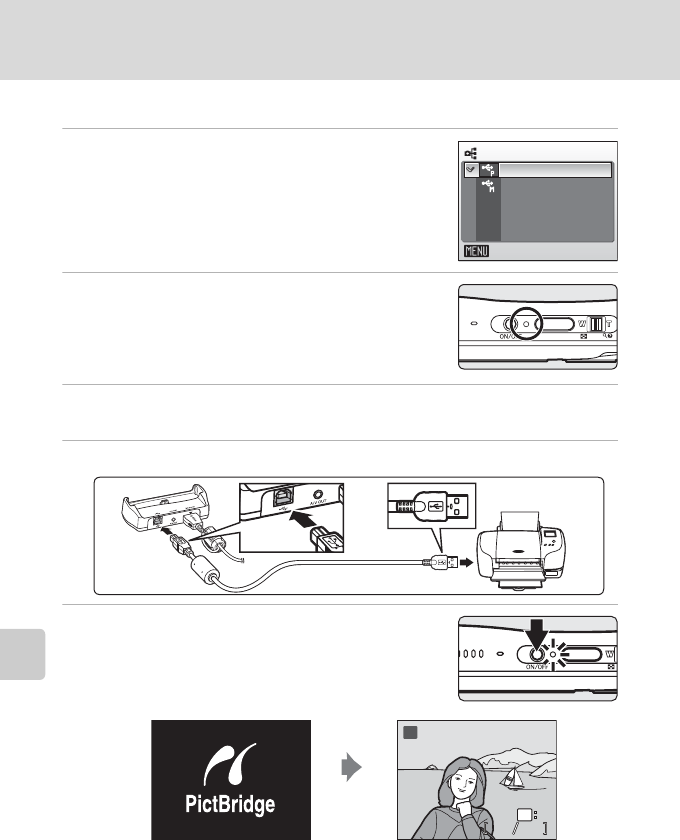
88
Connecting to a Printer
Connecting to Televisions, Computers, and Printers
Connecting the Camera and Printer
1Set the USB option (c84) to [PTP].
2Turn off the camera.
3Turn on the printer.
Check printer settings.
4
Connect the COOL-STATION to the printer using the supplied USB cable.
5Turn the camera on after placing it in the
COOL-STATION.
When connected correctly, the PictBridge start-up
screen (1) will be displayed in the camera monitor.
Then the picture will be displayed (2).
jConnecting the USB Cable
When connecting the USB cable, be sure that the connectors are oriented correctly. Do not use force when
connecting the USB cable. When disconnecting the USB cable, do not pull the connector at an angle.
USB
Exit
PTP
Mass storage
44 44
ww
MM
v
OK
12
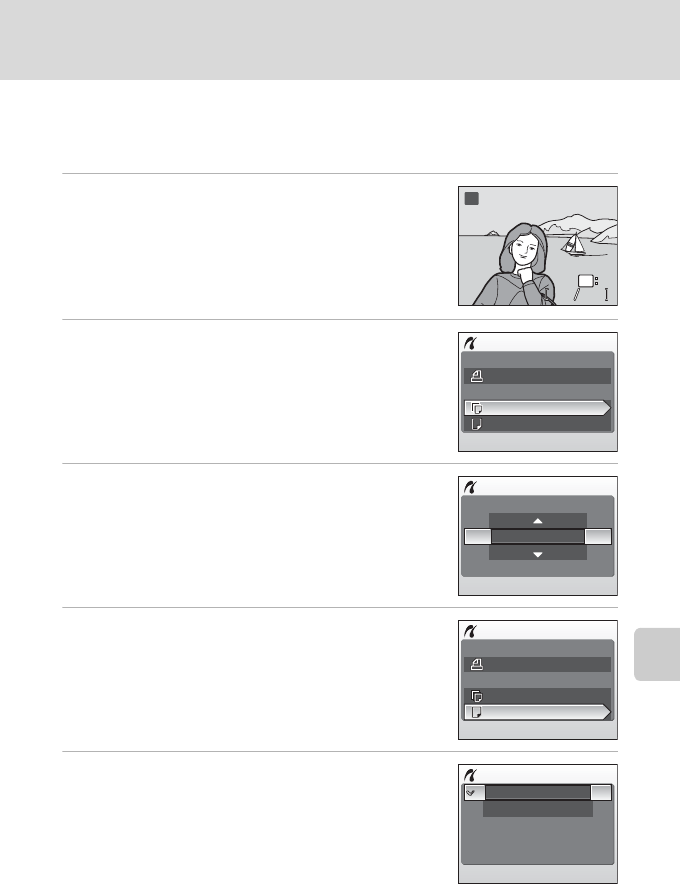
89
Connecting to a Printer
Connecting to Televisions, Computers, and Printers
Printing Pictures One at a Time
After connecting the camera to the printer correctly (c88), print pictures by
following the procedure below.
1Use the rotary multi selector to choose a
picture and press d.
The PictBridge menu is displayed.
To choose a picture from a list of six thumbnails, press
the zoom control to t (j). Or, press to v (k) to
switch back to full-frame playback.
2Choose [Copies] and press d.
3Choose number of copies (up to 9) and
press d.
4Choose [Paper size] and press d.
5Choose the desired paper size and press
d.
To specify paper size using printer settings, choose
[Default] in the paper size menu and press d.
44 44
ww
MM
v
OK
PictBridge
Start print
Copies
Paper size
Copies
4
PictBridge
Start print
Copies
Paper size
Paper size
Default
3.5 x 5 in.
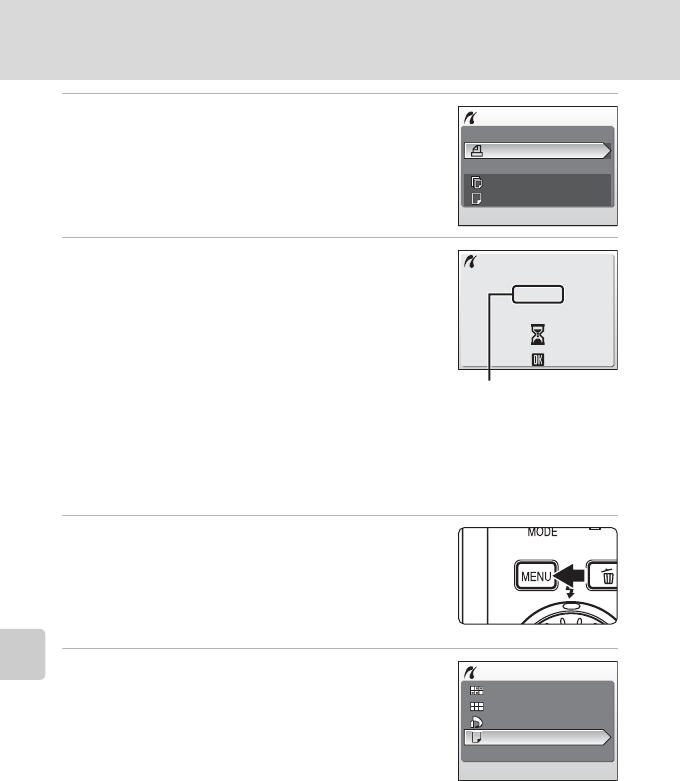
90
Connecting to a Printer
Connecting to Televisions, Computers, and Printers
6Choose [Start print] and press d.
7Printing starts.
Monitor display returns to that shown in step 1 when
printing is complete.
To cancel before all copies have been printed, press
d.
Printing Multiple Pictures
After connecting the camera to the printer correctly (c88), print pictures by
following the procedure below.
1Press m when a picture is displayed.
The print menu is displayed.
2Use the rotary multi selector to choose
[Paper size] and press d.
PictBridge
Start print
Copies
Paper size
Cancel
Printing
002/004
Current print/total
number of prints
Print menu
Print all images
Print selection
Paper size
DPOF printing
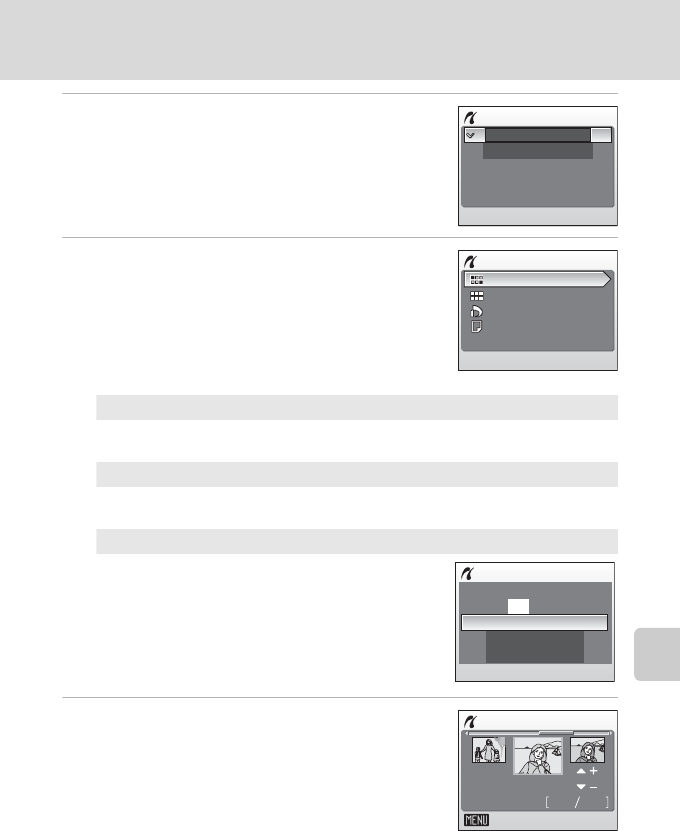
91
Connecting to a Printer
Connecting to Televisions, Computers, and Printers
3Choose the desired paper size and press
d.
To specify paper size using printer settings, choose
[Default] in the paper size menu and press d.
4Choose [Print selection], [Print all images]
or [DPOF printing] and press d.
5Choose the pictures and number of cop-
ies (up to 9) of each and press d.
The current picture is shown at the center of the display.
Select pictures and set the number of copies for each.
Pictures selected for printing are recognized by the w
icon and the number of copies to be printed. w is not
displayed with pictures for which 0 copies have been
specified and these pictures will not be printed.
Press d when setting is complete.
Paper size
Default
3.5 x 5 in.
Print menu
Print all images
Print selection
Paper size
DPOF printing
Print selection
Select pictures and specify the number of prints for each picture. Proceed
to step 5.
Print all images
All pictures stored in the internal memory or memory card are printed.
Proceed to step 7.
DPOF printing
Print pictures for which a print order has
been created in [Print set] (c93).
• The menu shown at right will be displayed.
• To print, choose [Start print] and press d.
Proceed to step 7.
• To view the current print order, choose
[Confirm] and press d. Proceed to step 6.
DPOF printing
Cancel
Confirm
004 prints
Start print
Print selection
Back
43
01.12.2006
12:00
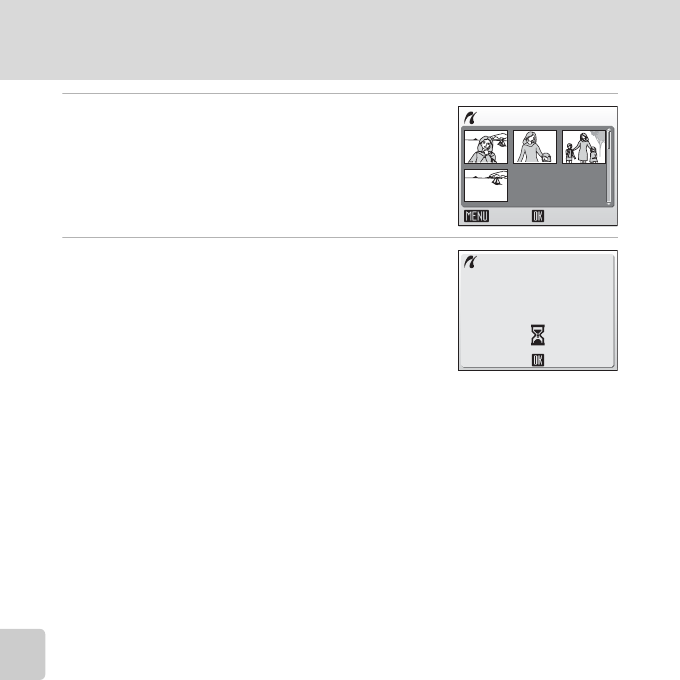
92
Connecting to a Printer
Connecting to Televisions, Computers, and Printers
6Check the selected pictures you wish to
print and press d.
To modify selection, press m to return to the previ-
ous screen.
7Printing starts.
Monitor display returns to the print menu (step 2)
when printing is complete.
To cancel before all copies have been printed, press
d.
jPaper Size
The camera supports the following paper sizes: [Default] (the default paper size for the cur-
rent printer), [3.5 × 5 in.], [5 × 7 in.], [Postcard], [100 × 150 mm], [4 × 6 in.], [8 × 10 in.],
[Letter], [A3], and [A4]. Only sizes supported by the current printer will be displayed. To spec-
ify paper size using printer settings, choose [Default] in the paper size menu.
004 prints
Back Print
1 2 3
4
123
4
Cancel
Printing
002/004
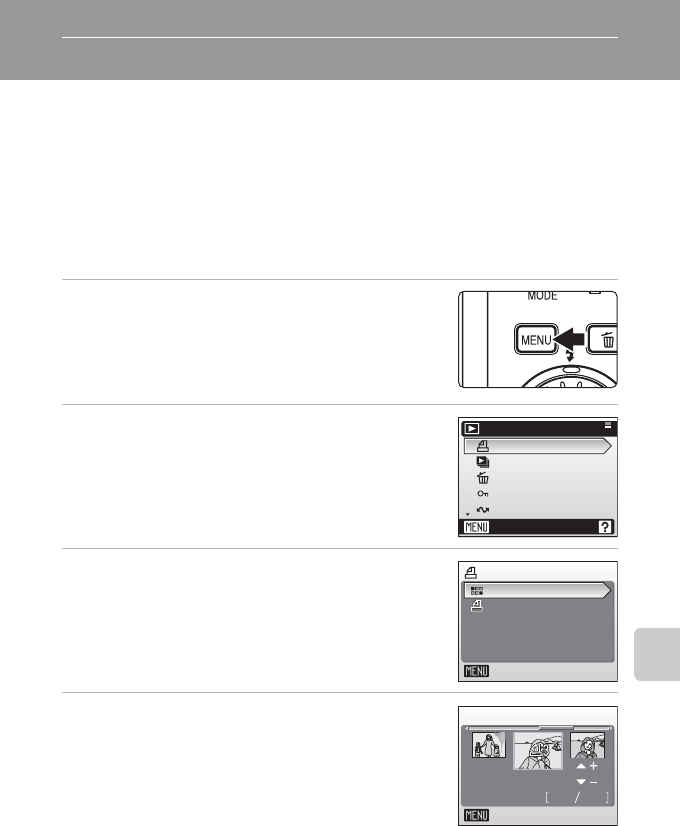
93
Connecting to Televisions, Computers, and Printers
Creating a DPOF Print Order: Print Set
The [Print set] option in the playback menu is used to create digital “print
orders” for printing on DPOF-compatible devices (c177).
In addition to pictures themselves, shooting date and photo information
(shutter speed, aperture, etc.) can also be printed.
When the camera is connected to a PictBridge-compatible printer, pictures
can be printed from the printer according to the DPOF print order you have
created for pictures on the memory card. If the memory card is removed
from the camera, you can create the DPOF print order for pictures in the
internal memory and print pictures according to the DPOF print order.
1Press m in playback mode.
The playback menu is displayed.
2Use the rotary multi selector to choose
[Print set] and press d.
The print set menu is displayed.
3Choose [Print selected] and press d.
4Choose the pictures and number of cop-
ies (up to 9) of each.
The current picture is shown at the center of the display.
Press IJ to select pictures and GH to set the num-
ber of copies for each.
Pictures selected for printing are recognized by the w
icon and the number of copies to be printed. w is not
displayed with pictures for which 0 copies have been specified and these pictures
will not be printed.
Press d when setting is complete.
Playback menu
Print set
Slide show
Delete
Protect
Transfer marking
Exit
Print set
Delete print set
Exit
Print selected
w
Print selection
Back
43
01.12.2006
12:00
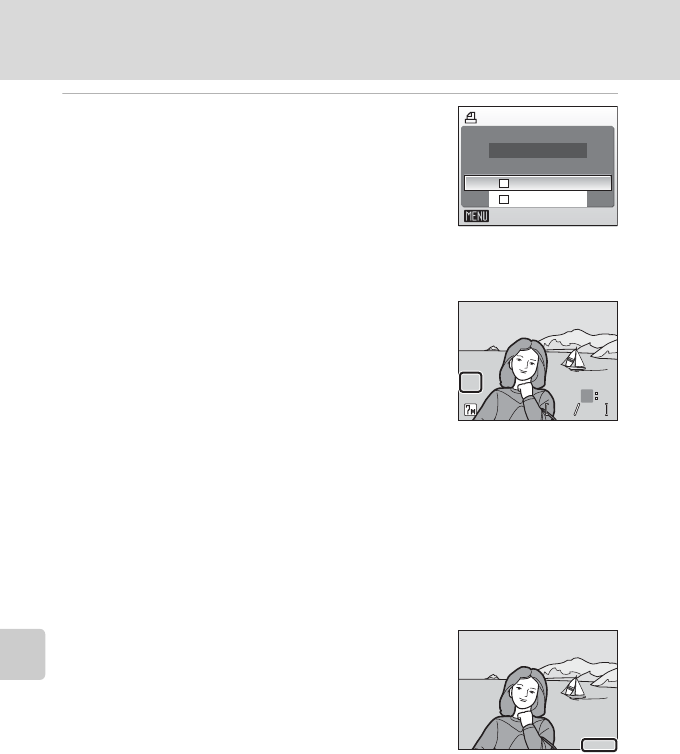
94
Creating a DPOF Print Order: Print Set
Connecting to Televisions, Computers, and Printers
5Choose whether or not to also print
shooting date and photo information.
[Date]: Print date of recording on all pictures in the
print order.
[Info]: Print shutter speed and aperture on all pictures
in the print order. Note that this information is not
printed with direct connection to a printer.
[Done]: Complete the print order and exit.
Pictures selected for printing are recognized by the
w icon displayed with playback.
jPrint Set
[Date] and [Info] are reset each time the print set menu is displayed.
kDeleting All Print Orders
Choose [Delete print set] in step 3 and press d. Print orders for all pictures will be deleted.
kNote on the Print Set [Date] Option
The date and time printed on pictures with DPOF printing
when [Date] in the print set menu is enabled are those
recorded with the picture when it was taken. Date and time
printed using this option are not affected when the camera’s
date and time setting are changed from the setup menu after
pictures are recorded.
lDifferences Between Print Set and Date Imprint
Date and time can only be printed on pictures using the [Date] option in the print set menu
when pictures are printed from a DPOF-compatible printer (c177). Use the [Date imprint]
(c121) option in the setup menu to print the date on pictures from a printer that does not
support DPOF (position of the date is fixed). When the date option for both [Print set] and
[Date imprint] is enabled, only the date from the [Date imprint] option is printed, even when a
DPOF-compatible printer is used.
Print set
Exit
Info
Date
Done
100NIKON
100NIKON
15:30
15:30
15:30
100NIKON
2006.10.10
2006.10.10
0004.JPG
0004.JPG
0004.JPG
2006.10.10
44 44
O
MM
N
EE
ww
O
2006.10.10
20 0 6.1 0 .10
2006.10.10
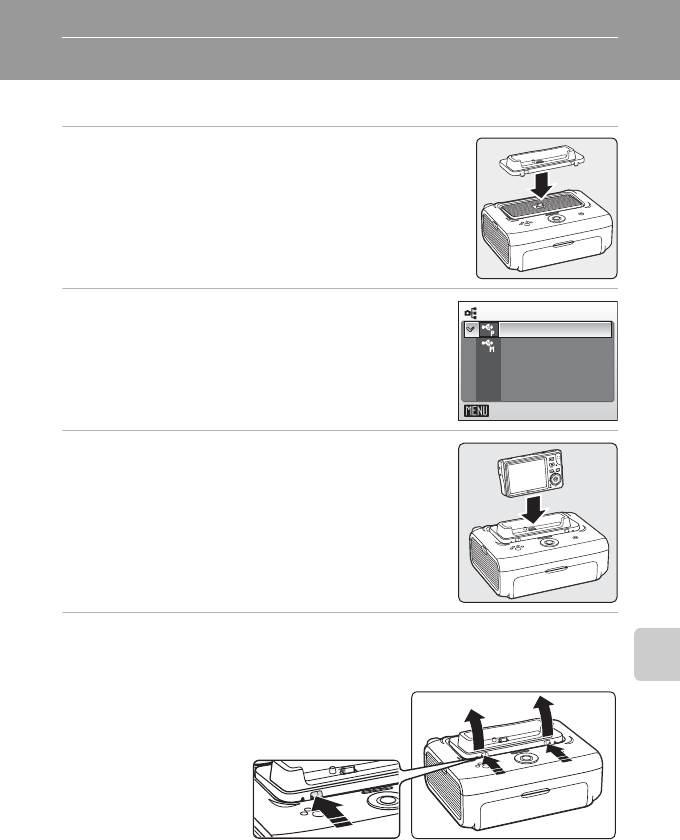
95
Connecting to Televisions, Computers, and Printers
Connecting to a ImageLink-compatible Printer
See documentation provided with your printer for information on how to
operate the printer.
1Attach the supplied PV-11 dock insert to
the printer.
2Set the USB option (c84) to [PTP].
3Turn the camera off and attach it to the
dock insert.
4Print pictures.
Follow the procedures described in the printer manual.
Removing the Dock Insert
Place your thumbs where
indicated, press, and lift.
jNote on Connecting
to an ImageLink-
compatible Printer
The monitor will dim auto-
matically if no operations are performed for about one minute while the camera is connected
to an ImageLink printer. The camera will turn off if no operations are performed for another
seven minutes.
USB
Exit
PTP
Mass storage

96
Shooting, Playback, and Setup Menus
Shooting, Playback, and Setup Menus
Shooting Options: The Shooting Menu
The shooting menu and high-sensitivity menu contain the following options.
1See the information on restrictions that may apply to these settings (c107).
2These settings cannot be set from the high-sensitivity menu.
ZImage mode c97
Choose image size and quality.
dWhite balance1c99
Match white balance to the light source.
IExp. +/– c101
Adjust exposure for very bright or very dark subjects.
qContinuous1c102
Take pictures one at a time or in a sequence.
ABSS1c104
Use the “best shot selector” to choose the sharpest picture.
WISO sensitivity2c105
Control camera’s sensitivity to light.
dColor options1c105
Apply color effects to pictures as they are recorded.
kAF area mode c106
Choose where the camera focuses.
cElectronic VR2c106
Choose whether or not to apply electronic vibration reduction to
reduce camera shake while taking pictures.
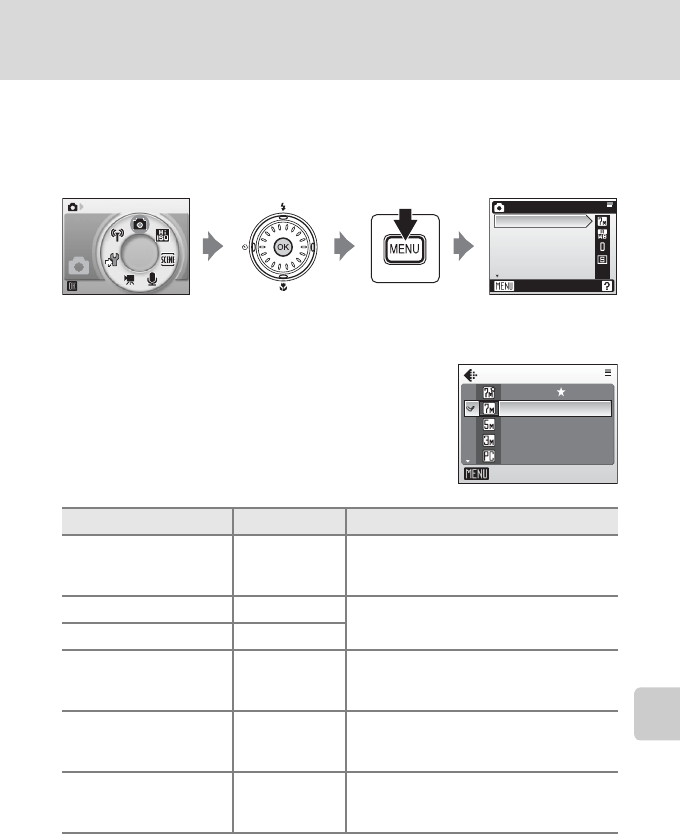
97
Shooting Options: The Shooting Menu
Shooting, Playback, and Setup Menus
Displaying the Shooting Menu and High-sensitivity Menu
Enter L (auto) or high-sensitivity shooting mode by pressing D in shooting
mode, selecting the L (auto) or K (high-sensitivity), and then pressing d.
Press m to display the shooting menu or high-sensitivity menu.
• Use the rotary multi selector (c12) to choose and apply settings.
• To exit the shooting or high-sensitivity menu, press m.
Z Image Mode
Pictures taken with a digital camera are recorded as
image files. The size of the files, and with it the
number of images that can be recorded, depends
on the size and quality of the images. Before shoot-
ing, choose an image mode according to how you
plan to use the picture.
The icon for the current setting is displayed in the monitor in shooting and
playback modes (c8, 9).
Options Size (pixels) Description
FHigh(3072A)3,072 × 2,304
Highest quality, suitable for enlarge-
ments or high-quality prints. The com-
pression ratio is approximately 1/4.
ENormal(3072) 3,072 × 2,304 Best choice in most situations. The com-
pression ratio is approximately 1/8.
dNormal(2592) 2,592 × 1,944
eNormal(2048) 2,048 × 1,536
Smaller size allows more pictures to be
stored. The compression ratio is approxi-
mately 1/8.
hPC screen(1024) 1,024 × 768
Suited to display on computer monitor.
The compression ratio is approximately
1/8.
iTV screen(640) 640 × 480
Suited to full-screen display on a television
or distribution by e-mail or the web. The
compression ratio is approximately 1/8.
Shooting
B
Shooting menu
Exit
Image mode
White balance
Exp. +/-
Continuous
BSS
Image mode
Exit
High(3072 )
Normal(3072)
Normal(2592)
Normal(2048)
PC screen(1024)
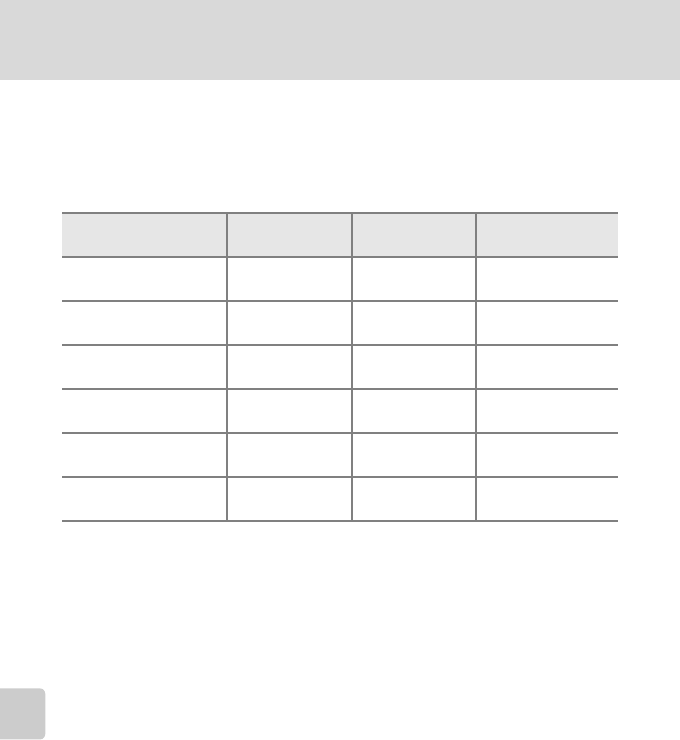
98
Shooting Options: The Shooting Menu
Shooting, Playback, and Setup Menus
kImage Mode and the Number of Exposures Remaining
The following table lists the number of pictures that can be stored in internal memory and on
a 256 MB memory card, together with the size of still pictures. Note that the number of pic-
tures that can be stored will differ depending on the composition of the picture (due to JPEG
compression). In addition, this number may differ depending on the make of memory card,
even if the capacity for the memory card is the same.
* All figures are approximate. If the number of exposures remaining is 10,000 or more,
the number of exposure remaining display shows [9999].
lImage Mode
The image mode setting can also be applied from the scene, anti-shake, and one-touch por-
trait menus. Changes made to the image mode setting from any of the three menus apply to
all shooting modes.
Setting Internal mem-
ory (14 MB)
256 MB mem-
ory card
Print size (printed
at 300 dpi; cm/in.)
FHigh(3072A)470
26 × 19.5 cm /
10.4 ×7.8 in.
ENormal(3072) 8 140 26 × 19.5 cm /
10.4 ×7.8 in.
dNormal(2592) 11 190 22 × 16.5 cm /
8.8 ×6.6 in.
eNormal(2048) 17 300 17 × 13 cm /
6.8 ×5.2 in.
hPC screen(1024) 59 1,040 9 × 7 cm /
3.6 ×2.8 in.
iTV screen(640) 112 1,960 5 × 4 cm /
2×1.6 in.
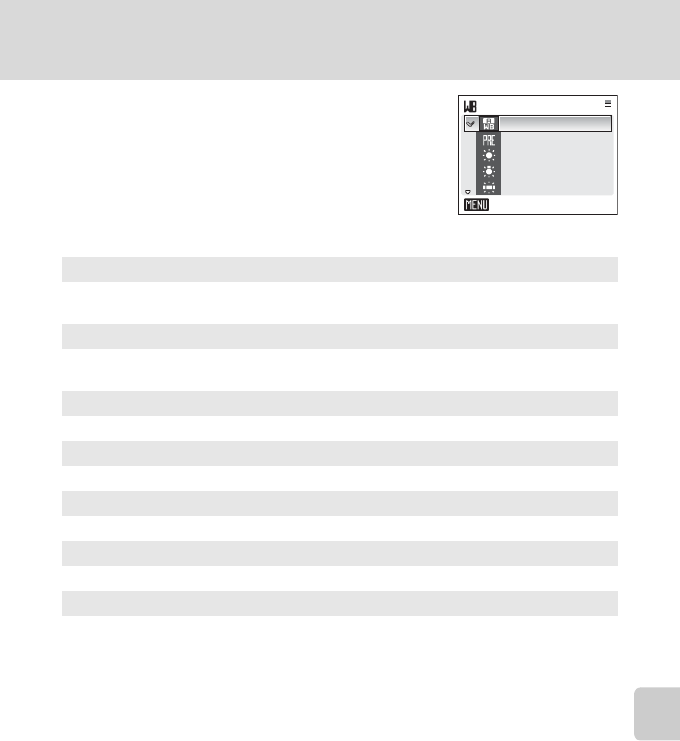
99
Shooting Options: The Shooting Menu
Shooting, Playback, and Setup Menus
d White Balance
Adjust white balance based on the light source to
give pictures the most realistic colors possible.
Although the default setting, [Auto], can be used
under most types of lighting, you can apply the
white balance setting suited to a particular light
source to achieve more accurate results.
At settings other than [Auto], the icon for the current setting is displayed in
the monitor (c8).
jFlash Mode
At white-balance settings other than [Auto] or [Flash], turn the flash off (B) (c32).
eAuto
White balance automatically adjusted to suit lighting conditions. Best choice in
most situations.
fWhite bal. preset
Neutral-colored object used as reference to set white balance under unusual
lighting conditions. See the next page for more information.
gDaylight
White balance adjusted for direct sunlight.
hIncandescent
Use under incandescent lighting.
iFluorescent
Use under most types of fluorescent lighting.
jCloudy
Use when taking pictures under overcast skies.
lFlash
Use with the flash.
White balance
Exit
Auto
Daylight
Daylight
Incandescent
Incandescent
Fluorescent
Fluorescent
White bal. preset
White bal. preset
Daylight
Incandescent
Fluorescent
White bal. preset
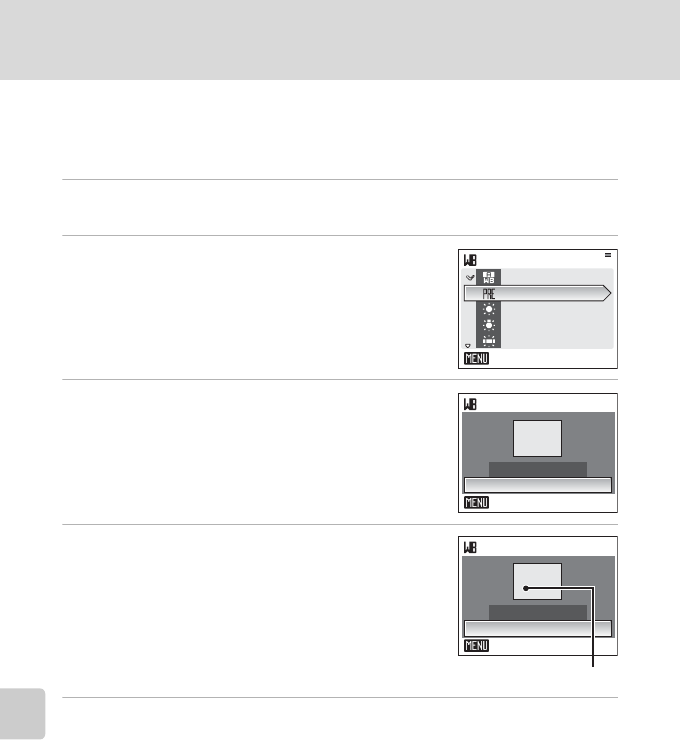
100
Shooting Options: The Shooting Menu
Shooting, Playback, and Setup Menus
f Preset White Balance
Preset white balance is used with mixed lighting or to compensate for light
sources with a strong color cast (for example, to make pictures taken under a
lamp with a red shade look as though they had been taken under white light).
1Place a white or gray reference object under the lighting that
will be used during shooting.
2Use the rotary multi selector to choose
[White bal. preset] in the white balance
menu, and press d.
The camera zooms in.
3Choose [Measure].
To apply the most recently measured value for preset
white balance, choose [Cancel] and press d.
4Frame the reference object.
5Press d.
The shutter is released and the new white balance value is set.
No pictures are recorded.
kNote on Preset White Balance
Regardless of the flash mode selected, the flash will not fire when d is pressed in step 5. There-
fore, the camera cannot measure a value for preset white balance for when the flash is used.
White balance
Exit
Auto
Auto
Daylight
Daylight
Auto
Daylight
Incandescent
Incandescent
Fluorescent
Fluorescent
White bal. preset
Incandescent
Fluorescent
White bal. preset
Exit
Measure
Cancel
White bal. preset
Exit
Measure
Cancel
Reference object frame
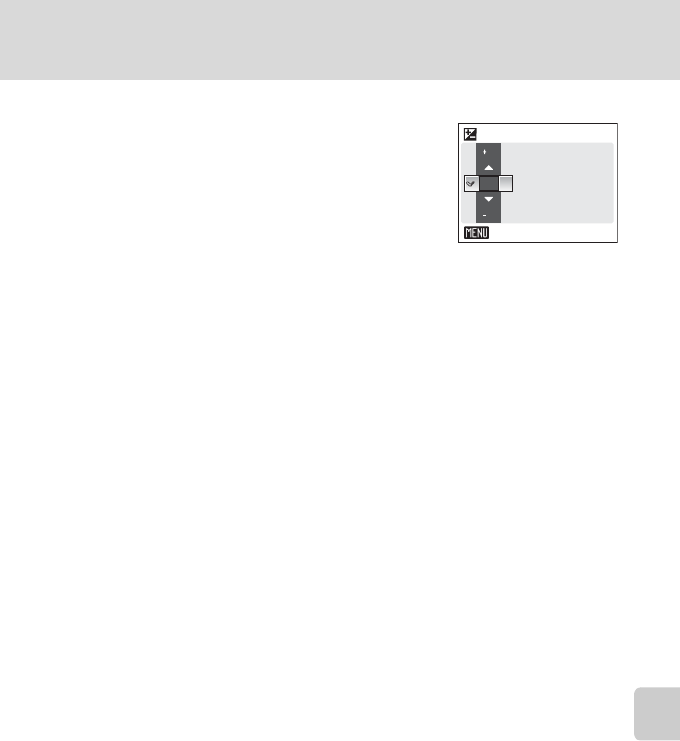
101
Shooting Options: The Shooting Menu
Shooting, Playback, and Setup Menus
I Exp. +/–
Exposure compensation is used to alter exposure
from the value selected by the camera. Choose
from values between –2.0 EV and +2.0 EV in incre-
ments of 1/3 EV. Negative values produce darker
pictures, positive values brighter pictures.
The icon for the current setting is displayed in the
monitor (c8).
Exp. +/-
Exit
0.3
0
0.3
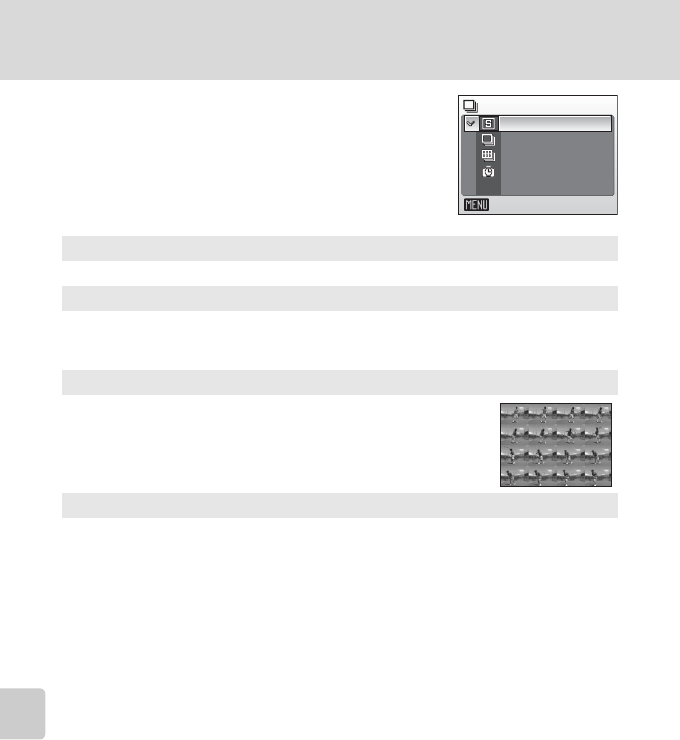
102
Shooting Options: The Shooting Menu
Shooting, Playback, and Setup Menus
q Continuous
Capture a fleeting expression on a portrait subject,
photograph a subject that is moving unpredictably,
or capture motion in a series of pictures. Focus,
exposure, and white balance are fixed at the values
for the first picture in each series.
At settings other than [Single], the indicator for the current setting is dis-
played in the monitor (c8).
rSingle
One shot is taken each time shutter-release button is pressed.
qContinuous
Pictures are taken continuously while the shutter-release button is pressed.
When the image mode is E Normal(3072), camera takes 7 shots at about 1.4
frames per second.
wMulti-shot 16
Each time shutter-release button is pressed, camera takes
16 shots at about 1.6 frames per second and arrange
them in a single picture d Normal(2592) pixels as shown
at right.
zIntvl timer shooting
Camera takes pictures automatically at specified interval (up to 1,800 frames).
Continuous
Exit
Single
Continuous
Multi-shot 16
Intvl timer shooting
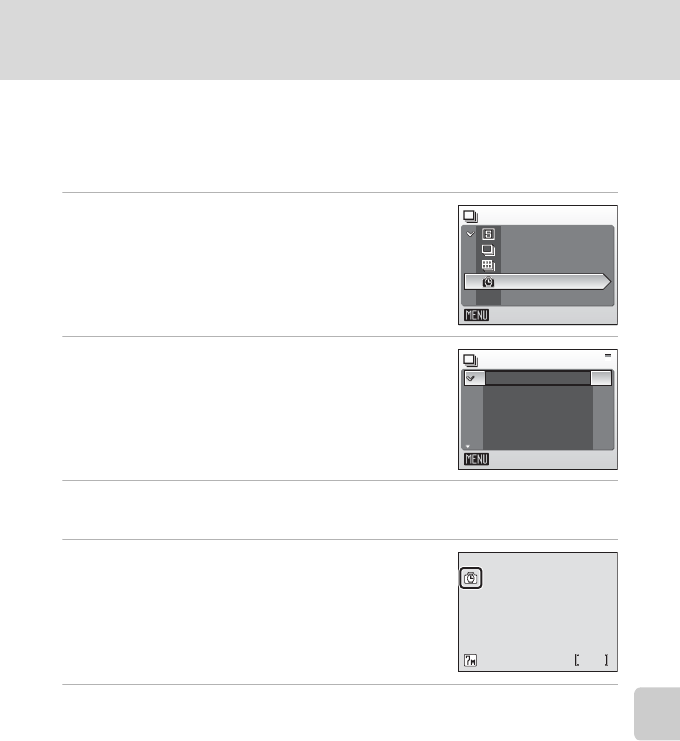
103
Shooting Options: The Shooting Menu
Shooting, Playback, and Setup Menus
z Interval Timer Photography
Pictures are taken automatically at specified intervals. Choose from intervals
between 30 seconds and 60 minutes. To prevent the camera from turning
off unexpectedly during recording, use a fully charged battery.
1Use the rotary multi selector to choose
[Intvl timer shooting] in the continuous
menu, and press d.
2Choose interval between shots and press
d.
3Press m.
The camera returns to shooting mode.
4Press the shutter-release button fully to
start recording.
Monitor turns off and indicator lamp blinks green
between shots.
The monitor turns on automatically right before the
next shot is taken.
5Press the shutter-release button fully a second time to end
recording.
Recording will end automatically if the internal memory or memory card becomes
full, or after 1,800 pictures are taken.
Continuous
Exit
Single
Continuous
Multi-shot 16
Intvl timer shooting
Set interval time
30s
1m
5m
10m
30m
Exit
88
MM
M
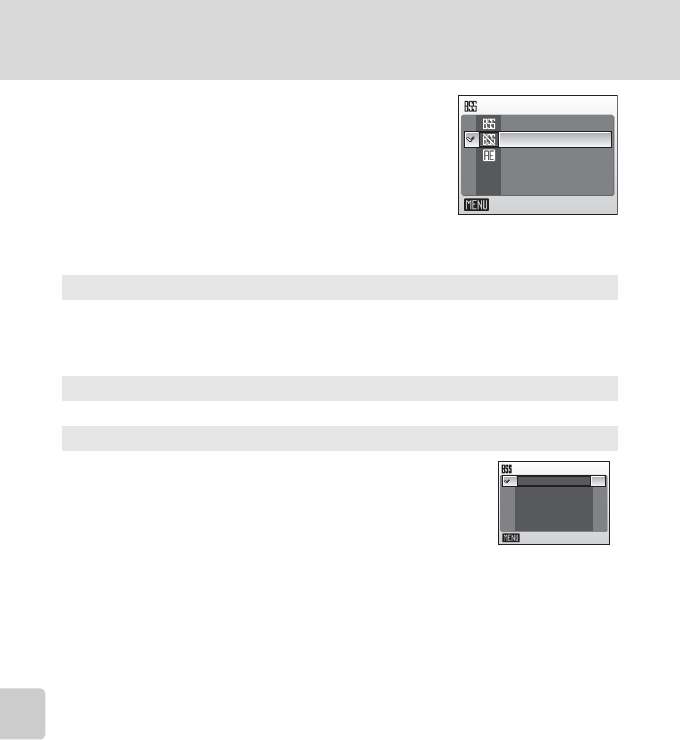
104
Shooting Options: The Shooting Menu
Shooting, Playback, and Setup Menus
A Best Shot Selector (BSS)
The “best shot selector” is recommended from situ-
ations in which inadvertent camera movement can
result in blurred pictures, or when parts of the
image are prone to under- or overexposure.
At [On] and [Exposure BSS] settings, the flash auto-
matically turns off and focus, exposure, and white balance for all pictures are
determined by the first picture in each series.
The icon for the current setting is displayed in the monitor (c8).
jNote on Best Shot Selector
BSS may not produce the desired results if the subject moves or the composition changes
while the shutter-release button is fully pressed.
AOn
Recommended for taking pictures in poorly lit places, or in other situations
where camera shake may occur. Camera takes shots while shutter-release but-
ton is pressed, to a maximum of ten. These images are then compared and the
sharpest picture (picture with highest level of detail) is saved.
BOff
Only one picture is taken.
wExposure BSS
Recommended for high-contrast subjects, when it is diffi-
cult to set exposure correctly.
[Highlight BSS]: picture with smallest area of
overexposure is selected.
[Shadow BSS]: picture with smallest area of underexposure is selected.
[Histogram BSS]: of pictures with least under- and over-exposure, camera
chooses picture with overall exposure closest to optimum.
Camera takes five shots each time shutter-release button is pressed, but only
the picture that best meets the selected criterion is saved.
BSS
Exit
On
Off
Exposure BSS
Exposure BSS
Highlight BSS
Shadow BSS
Histogram BSS
Exit
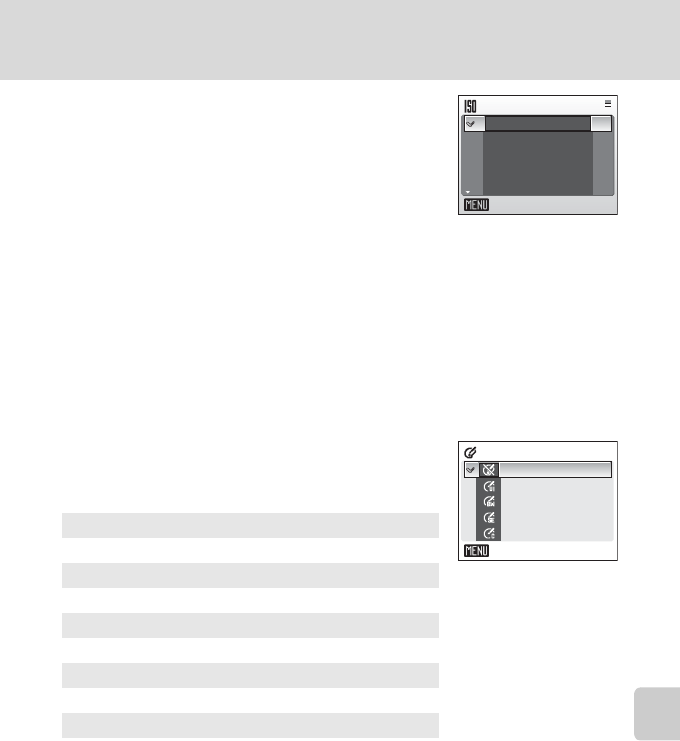
105
Shooting Options: The Shooting Menu
Shooting, Playback, and Setup Menus
W ISO Sensitivity
Sensitivity is a measure of how quickly the camera
reacts to light. The higher the sensitivity, the less
light needed to make an exposure. Although a high
ISO rating is suited for taking pictures of subjects in
action or in poor lighting, high sensitivity is often
associated with “noise” -randomly spaced, brightly colored pixels concen-
trated in dark parts of the image.
[Auto] is equivalent to ISO 50 under normal conditions; when lighting is poor
and the flash is off, the camera compensates by raising sensitivity to a maxi-
mum of ISO 800 equivalent. Choose from values between ISO 50 and 1600
equivalent.
At settings other than [Auto], the current setting is displayed in the monitor
(c8). If [Auto] is selected and the sensitivity is raised above an ISO 50 equiv-
alent, the W icon will be displayed (c33).
d Color Options
Make colors more vivid or record pictures in mono-
chrome.
The effects of the selected option can be previewed in the monitor. At set-
tings other than [Standard color], the icon for the current setting is displayed
in the monitor (c8).
eStandard color
Use for pictures exhibiting natural color.
CVivid color
Use to achieve a vivid, “photoprint” effect.
DBlack-and-white
Record pictures in black-and-white.
BSepia
Record pictures in sepia tones.
ACyanotype
Record pictures in cyan-blue monochrome.
ISO sensitivity
Auto
50
100
200
400
Exit
Color options
Exit
Standard color
Black-and-white
Black-and-white
Sepia
Sepia
Cyanotype
Cyanotype
Vivid color
Vivid color
Black-and-white
Sepia
Cyanotype
Vivid color
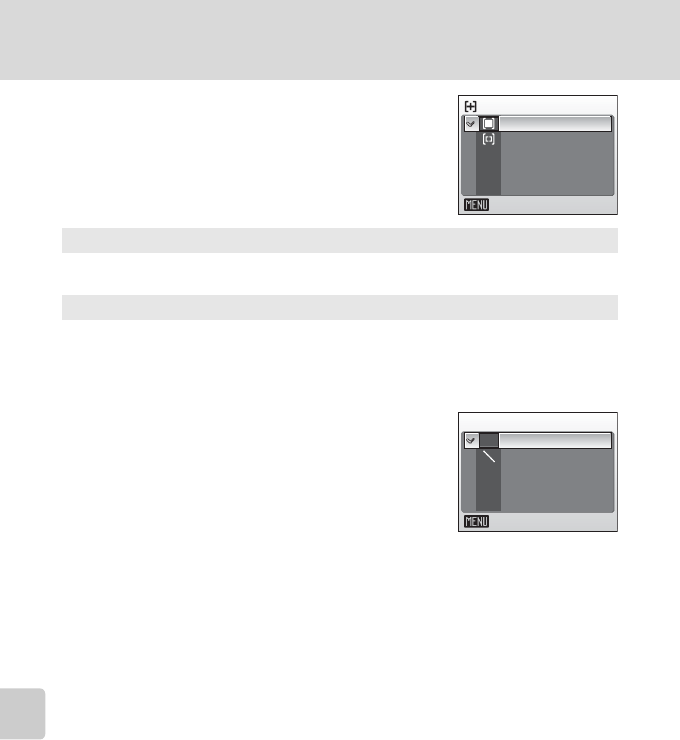
106
Shooting Options: The Shooting Menu
Shooting, Playback, and Setup Menus
k AF Area Mode
Use this option to determine where the camera
focuses.
c Electronic VR
When set to [Auto], the affects of camera shake
and blurred subjects are reduced while pictures are
taken under the following conditions:
• Flash mode is set to B or D
• Shutter speed is slow
• [Single] is selected in the continuous shooting menu
At settings other than [Off], the icon for the current setting is displayed in the
monitor (c8).
jNotes on Electronic VR
• The electronic VR may not work properly immediately after the camera is turned on or reac-
tivated from standby mode.
• The electronic VR does not work when the exposure time is faster than a certain value.
• The electronic VR is less effective for when pictures are considerably blurred.
• Blurred subjects cannot be compensated.
nCenter
Camera focuses on subject in center of frame.
Center focus area is used.
mManual
Press the rotary multi selector GHIJ to select from 99 focus areas in the
frame. Pictures can be taken while focus area selection screen is displayed.
To end focus area selection and adjust the flash, macro close-up, and self-
timer settings, press d. Press J to change selection.
AF area mode
Exit
Center
Manual
L
L
c
Electronic VR
Exit
Auto
Off

107
Shooting Options: The Shooting Menu
Shooting, Playback, and Setup Menus
Restrictions on Camera Settings
Restrictions apply to the following settings in L (auto) mode:
Flash mode
Flash turns off at [Continuous] settings of [Continuous] or [Multi-shot
16], or when [BSS] is on. Applied setting is restored when [Single] or
[Intvl timer shooting] is selected, or [BSS] is turned off.
Self-timer
If self-timer is on, only one shot will be taken when shutter is
released, regardless of settings chosen for [Continuous] and [BSS].
Applied [Continuous] and [BSS] settings are restored when picture is
taken or self-timer is turned off.
Continuous
Selecting [Continuous], [Multi-shot 16], or [Intvl timer shooting] turns
[BSS] off.
Applied [BSS] setting is not restored when [Single] is selected.
BSS
[Continuous] is automatically set to [Single] when [On] or [Exposure
BSS] is selected for [BSS].
Applied setting is not restored when [BSS] is turned off.
White balance
White balance is automatically set to [Auto] and cannot be adjusted
when [Black-and-white], [Sepia], or [Cyanotype] is selected for [Color
options].
Applied white balance setting is restored when [Standard color] or
[Vivid color] is selected.
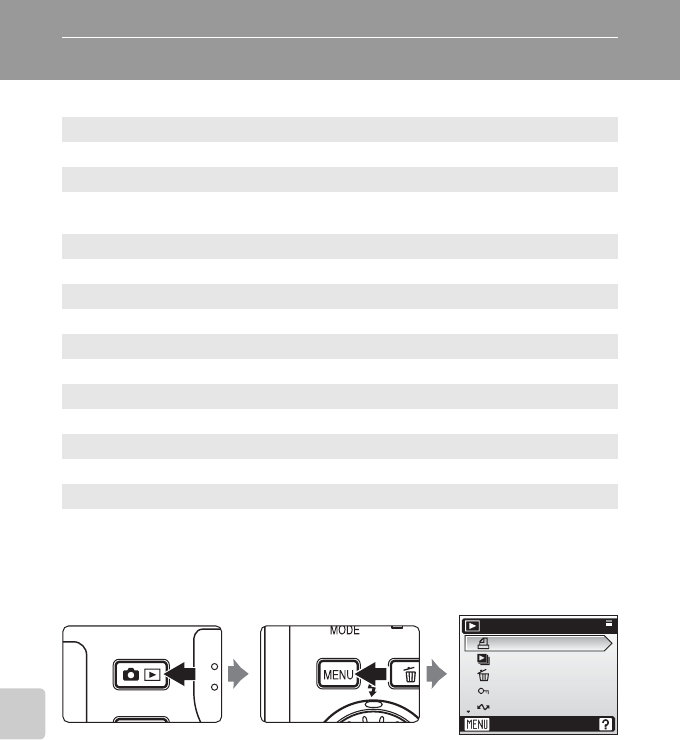
108
Shooting, Playback, and Setup Menus
Playback Options: The Playback Menu
The playback menu contains the following options.
Displaying the Playback Menu
Display the playback menu by pressing o and pressing m.
• Use the rotary multi selector to choose and apply settings. (c12)
• To exit the playback menu, press m.
wPrint set c109
Select pictures to print and the number of copies for each.
zSlide show c110
View pictures stored in the internal memory or on a memory card in
an automatic slide show.
ADelete c111
Delete all or selected pictures.
DProtect c111
Protect selected pictures from accidental deletion.
ETransfer marking c112
Mark existing pictures to transfer to a computer.
GRotate image c112
Change the orientation of an existing picture.
HSmall pic. c58
Create a small copy of the current picture.
LCopy c113
Copy files between memory card and internal memory.
Playback menu
Print set
Slide show
Delete
Protect
Transfer marking
Exit
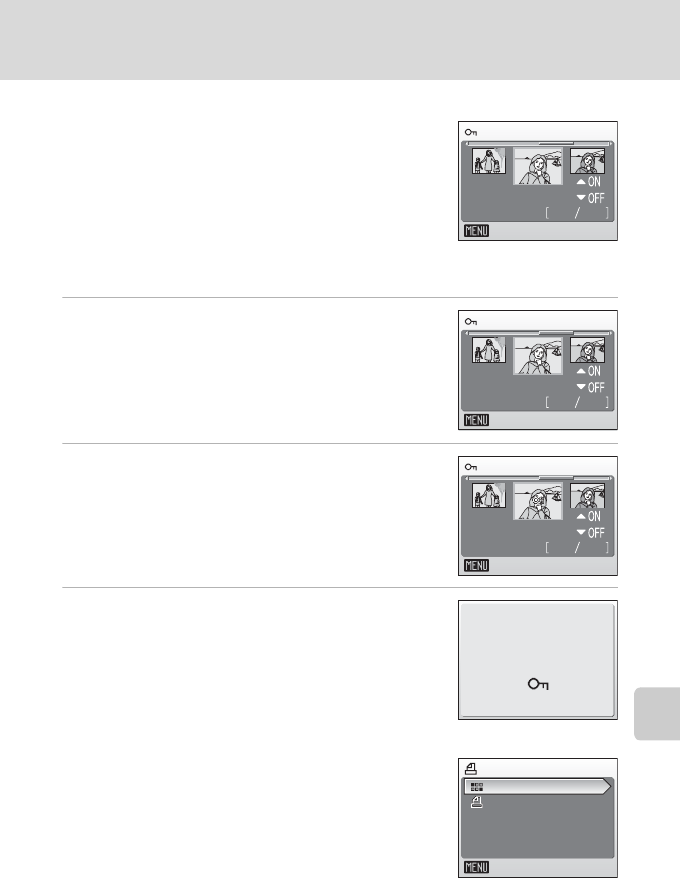
109
Playback Options: The Playback Menu
Shooting, Playback, and Setup Menus
Selecting Multiple Pictures
Follow the steps below to select multiple pictures
for a print set (c93), deletion (c111), protection
from deletion (c111), transfer (c112), rotate
(c112), copying between internal memory and
the memory card (c113), or for the welcome
screen (c116). When pictures are selected, the
screen at right is displayed. The process for protect-
ing multiple pictures is shown here as example.
1Use the rotary multi selector to choose a
desired picture.
The current picture is displayed at the center of the
monitor.
Only one picture can be selected for [Rotate image]
and [Welcome screen]. Proceed to step 3.
2Press GH to select [ON] or [OFF] (or the
number of copies).
When [ON] is selected, the indicator for the specified
function is displayed in the center of the current pic-
ture. Repeat steps 1 and 2 to select additional pic-
tures.
3Press d.
The setting is enabled.
w Print Set
Create digital “print orders” for PictBridge printers
(c177) and DPOF-compatible devices (c93).
Protect
Back
43
01.12.2006
12:00
Protect
Back
43
01.12.2006
12:00
Protect
Back
43
01.12.2006
12:00
Done
Print set
Delete print set
Exit
Print selected
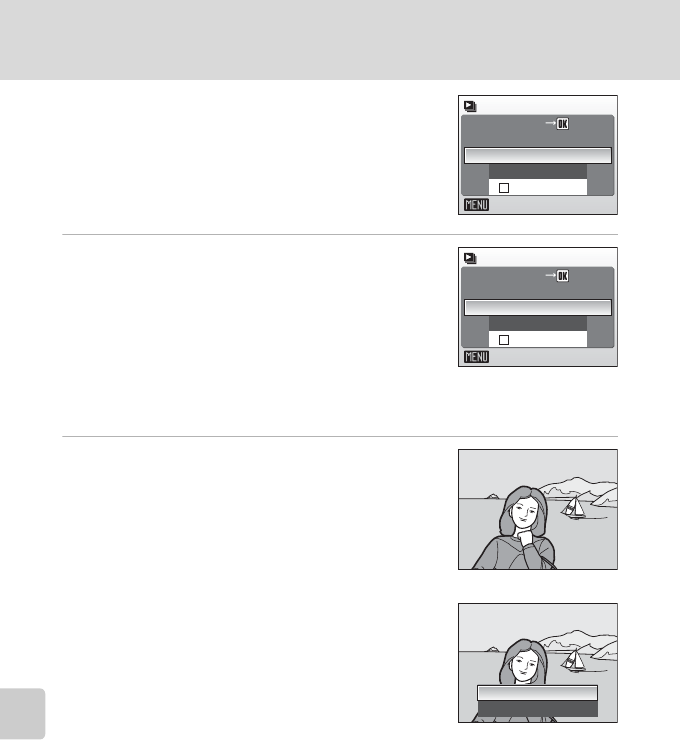
110
Playback Options: The Playback Menu
Shooting, Playback, and Setup Menus
z Slide Show
Play back pictures stored in the internal memory or
on a memory card in an automated “slide show”.
1Display the slide show menu; use the
rotary multi selector to choose [Start]
and press d.
To change the interval between pictures, choose
[Frame intvl], select the desired interval time, and
press d before choosing [Start].
To repeat the slide show automatically, enable [Loop]
and press d before choosing [Start]. y will be added to the loop option when
enabled.
2The slide show begins.
While the slide show is in progress, the following
operations can be performed:
• Use the rotary multi selector to switch pictures.
Continue rotating in either direction to fast forward
(clockwise) or rewind (counterclockwise).
• Press d to pause the slide show.
The menu shown at right is displayed when the slide
show ends or is paused. Choose [Restart] and press
d to play the slide show again, or choose [End] to
stop the slide show and return to the playback menu.
jNotes on Slide Show
• Only the first frame of movies (c76) included in slide shows is displayed.
• Even if [Loop] is selected, the monitor will turn off automatically if no operations are per-
formed for 30 minutes. The camera will turn off automatically if no operations are per-
formed for another three minutes.
Slide show
Exit
Loop
Frame intvl
Start
Pause
Slide show
Exit
Loop
Frame intvl
Start
Pause
Restart
End
Pause
Pause
Pause
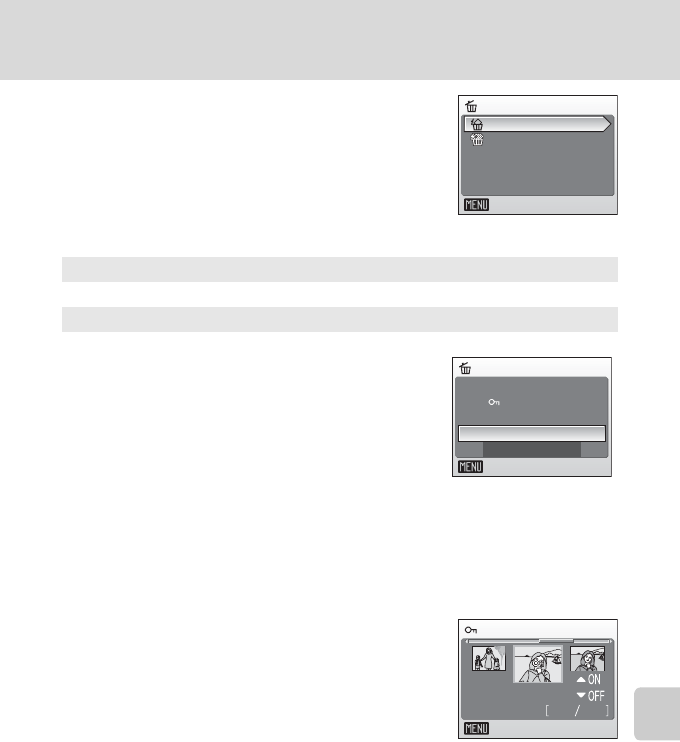
111
Playback Options: The Playback Menu
Shooting, Playback, and Setup Menus
A Delete
The delete menu contains the options shown
below.
If no memory card is inserted in the camera, pic-
tures in the internal memory will be deleted.
If a memory card is inserted, pictures on the mem-
ory card will be deleted.
kNotes on Deletion
• Once deleted, pictures cannot be recovered. Transfer important images to a computer
before deletion.
• Pictures marked with the D icon are protected and cannot be deleted.
D Protect
Protect selected pictures from accidental deletion.
Note, however, that formatting will delete pro-
tected files (c125).
See “Selecting Multiple Pictures” (c109) for
more information on using this function.
Protected pictures are recognized by the D icon (c9) displayed during
playback.
BErase selected images
Delete selected pictures (c109).
CErase all images
Delete all pictures stored in the internal memory or on the memory card.
• Choose [Yes] and press d in the confirmation
dialog to delete all pictures.
• To exit without deleting pictures, choose [No]
and press d.
Delete
Erase all images
Exit
Erase selected images
Delete
Exit
Yes
No
Erasing all images
( excluded)
Protect
Back
43
01.12.2006
12:00
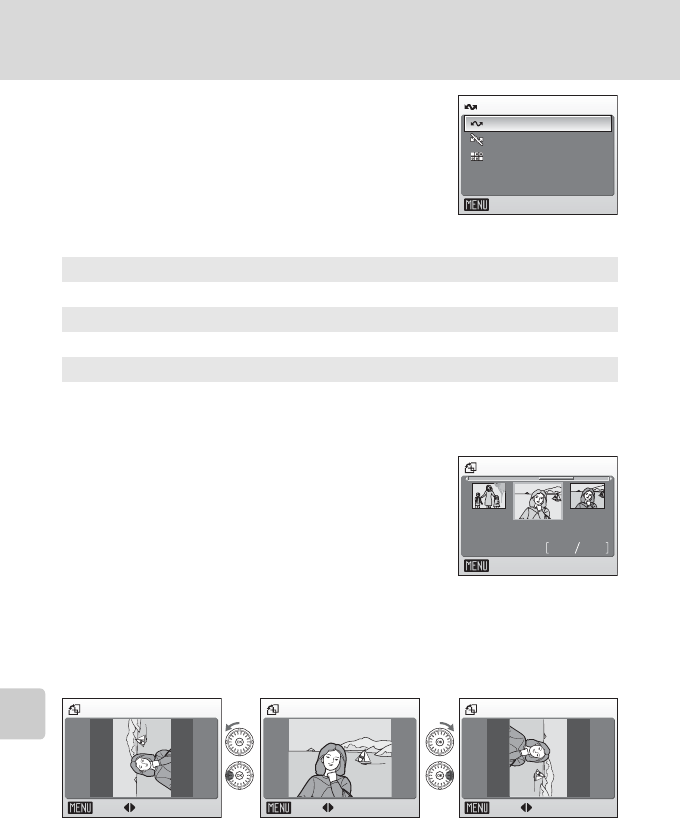
112
Playback Options: The Playback Menu
Shooting, Playback, and Setup Menus
E Transfer Marking
Change transfer marking (E) for existing pictures.
When the camera is connected to a computer with
PictureProject installed via the supplied USB cable,
pressing d transfers only the pictures marked with
a E icon (c85, 155). At the default setting, all
pictures are marked for transfer.
Pictures selected for transfer are recognized by the E icon (c9).
G Rotate Image
Record pictures rotated 90° clockwise or counter-
clockwise.
Choose a file to be rotated in the picture selection
screen (c109). To select the direction to rotate
the chosen picture, rotate the rotary multi selector
clockwise (or press J) or counterclockwise (or
press I) in the rotate image screen.
When [Record orientation] (c124) is set to [Auto] (default setting), you can
rotate (up to 180°) pictures taken in “tall” orientation by rotating the rotary
multi selector either clockwise or counterclockwise.
Press d to record the orientation for the picture as shown in the rotate
image screen.
EAll on
Mark all images for transfer.
FAll off
Remove transfer marking from all images.
PSelect Image(s)
Mark selected pictures for transfer in the picture selection screen (c109).
Transfer marking
All off
Exit
All on
Select image(s)
43
01.12.2006
12:00
Select image
Back
Rotate image
Back Rotate
Rotate image
Back Rotate
Rotate image
Back Rotate
Rotate 90°
counterclockwise
Rotate 90°
clockwise
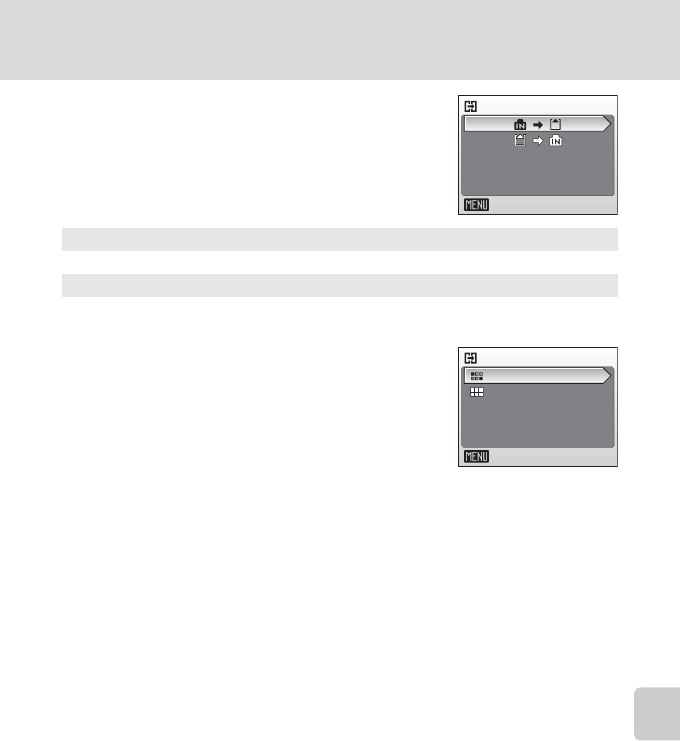
113
Playback Options: The Playback Menu
Shooting, Playback, and Setup Menus
L Copy
Copy pictures between the internal memory and a
memory card.
First, select from the following options.
Then, select the desired copy option.
Choose [Selected images] (c109) to copy specific
pictures in the internal memory or memory card. To
copy all pictures, choose [All images].
jNotes on Copying Pictures
• If there is not enough space in the memory or on the memory card to receive the copy, an
error message will be displayed. Delete unwanted pictures or insert a new memory card (if
using a memory card) before trying again.
• The file format of images that can be copied is JPEG, MOV, or WAV.
• Pictures taken with another make of camera or that have been modified on a computer
cannot be copied.
kFile Names of Copied Pictures
•
When pictures are copied using the [Selected images] option, the newly copied pictures are
numbered consecutively from the largest number existing between the two memory sources.
Ex: when the last number in the source memory is 32 (DSCN0032.JPG) and the last num-
ber in the destination memory is 18 (DSCN0018.JPG), the copied pictures are assigned
numbers starting from DSCN0033.
• When pictures are copied using the [All images] option, all the pictures in the folder are
copied with the same file numbers. New folder numbers are assigned in ascending order
starting from the largest folder number available. If a new folder cannot be created, the
folder is not copied and an error message will be displayed.
kCopies
Edited copies have the same protection marking (c111) as the original but are not marked
for printing (c93) or transfer (c112).
MNO
Copy pictures from internal memory to memory card.
ONM
Copy pictures from memory card to internal memory.
Copy
Exit
Camera to card
All images
Exit
Selected images

114
Shooting, Playback, and Setup Menus
Basic Camera Setup: The Setup Menu
The setup menu contains the following options.
RMenus c115
Choose how menus are displayed.
HQuick startup c116
Enable or disable welcome screen and start-up sound.
VWelcome screen c116
Select screen displayed when camera is turned on.
WDate c117
Set camera clock and choose home and destination time zones.
ZMonitor settings c120
Adjust monitor brightness and choose display style.
fDate imprint c121
Imprint date or date counter on pictures.
uAF assist c123
Enable or disable AF assist illumination.
hSound settings c123
Adjust sound and volume settings.
IRecord orientation c124
Choose whether or not to record the orientation of a picture
taken.
iAuto off c124
Set time before camera enters standby mode to save power.
M/OFormat memory/Format card c125
Format internal memory or memory card.
jLanguage c126
Choose language for camera menus and messages.
kInterface c126
Adjust settings for connection to television or computer.
nReset all c127
Restore camera settings to default values.
BFirmware version c129
Display camera firmware version.
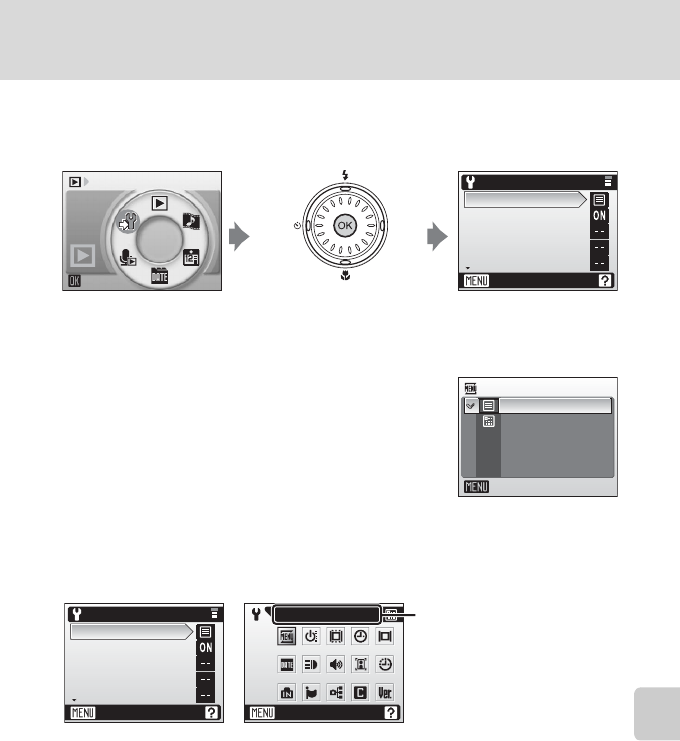
115
Basic Camera Setup: The Setup Menu
Shooting, Playback, and Setup Menus
Displaying the Setup Menu
First, display the mode-selection menu by pressing D. Then select Z (use
the rotary multi selector), press d.
• Use the rotary multi selector to choose and apply settings. (c12)
• To exit the setup menu, press m.
R Menus
Choose whether the initial menus displayed for the
shooting menu (c96), high-sensitivity (c97),
scene menu (c37), movie menu (c71), one-
touch portrait menu (c51), anti-shake menu
(c49), playback menu (c108), and setup menu
(displayed when m is pressed) (c114) use text
or icons.
When [Icons] is selected, all menu items can be displayed in a single page
and the highlighted menu name appears at the top of the monitor.
Set up
Menus
Quick startup
Welcome screen
Date
Monitor settings
Exit
Set up
Menus
Exit
Text
Icons
Exit
Menus
Set up
Menus
Quick startup
Welcome screen
Date
Monitor settings
Exit
[Text] [Icons]
Menu names
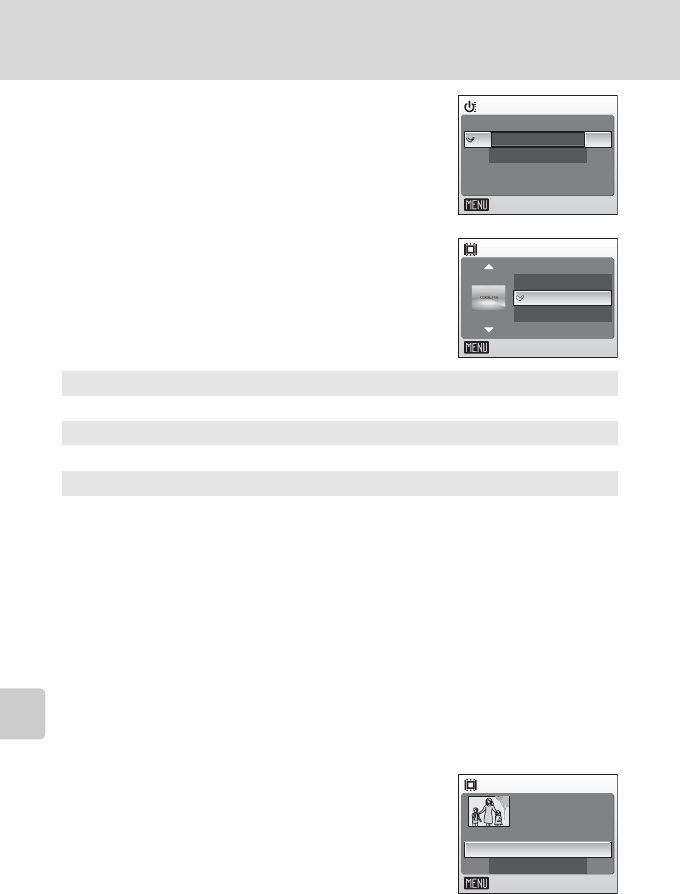
116
Basic Camera Setup: The Setup Menu
Shooting, Playback, and Setup Menus
H Quick Startup
Choose [On] to disable the welcome screen and
start-up sound. The camera will be ready for shoot-
ing as soon as it is turned on.
Set to [Off] when enabling the welcome screen.
V Welcome Screen
You can select the welcome screen to be displayed
when the camera is turned on.
To set the welcome screen, [Quick startup] must be
set to [Off].
lWhen [Select an image] is Selected
If you have already selected a welcome screen picture, you can
select a new one by following the confirmation dialog.
Nikon
Displays a welcome screen when the camera is turned on.
Animation (default)
Displays a short animation when the camera is turned on.
Select an image
Select a picture in the internal memory or on the memory card for the wel-
come screen. The image used in the welcome screen is a copy of the selected
picture and, therefore, is not affected if the original picture is deleted or the
memory card is removed.
1 Choose a picture in the picture selection screen.
• See “Selecting Multiple Pictures” (c109) for more information.
2 Press d.
Quick startup
On
Off
Exit
Welcome screen
Exit
Nikon
Animation
Select an image
Welcome screen
Exit
Yes
No
Replace current
image?
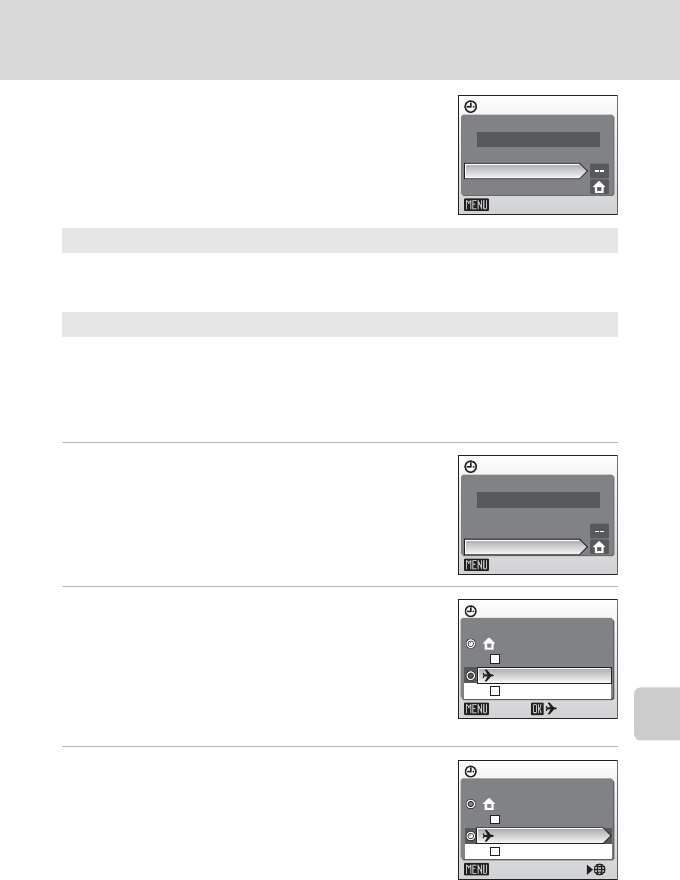
117
Basic Camera Setup: The Setup Menu
Shooting, Playback, and Setup Menus
W Date
Set the camera clock and choose home and travel
destination time zones.
Setting Travel Destination Time Zone
1Use the rotary multi selector to choose
[Time zone] and press d.
The time zone menu is displayed.
2Choose Y and press d.
The date and time displayed on the monitor changes
according to the region currently selected.
If daylight saving time is in effect, use the rotary multi
selector to choose [DaylightSaving] press d and then
press G. The time is automatically advanced one
hour.
3Press J.
The new city time zone menu is displayed.
Date
Set camera clock to current date and time.
See “Setting Display Language, Date, and Time” (c20-21) for more informa-
tion.
Time zone
Useful when travelling. When Y (destination time zone) is selected, the time
difference (c119) is automatically calculated and the date and time in the
selected region are displayed.
Date
10.10.2006 15:30
Date
Time zone
Exit
Date
10.10.2006 15:30
Date
Time zone
Exit
01.10.2006 10:00
Time zone
Exit
Tokyo, Seoul
London,Casablanca
DaylightSaving
DaylightSaving
Time zone
Exit
Tokyo, Seoul
London,Casablanca
DaylightSaving
DaylightSaving
01.10.2006 18:00
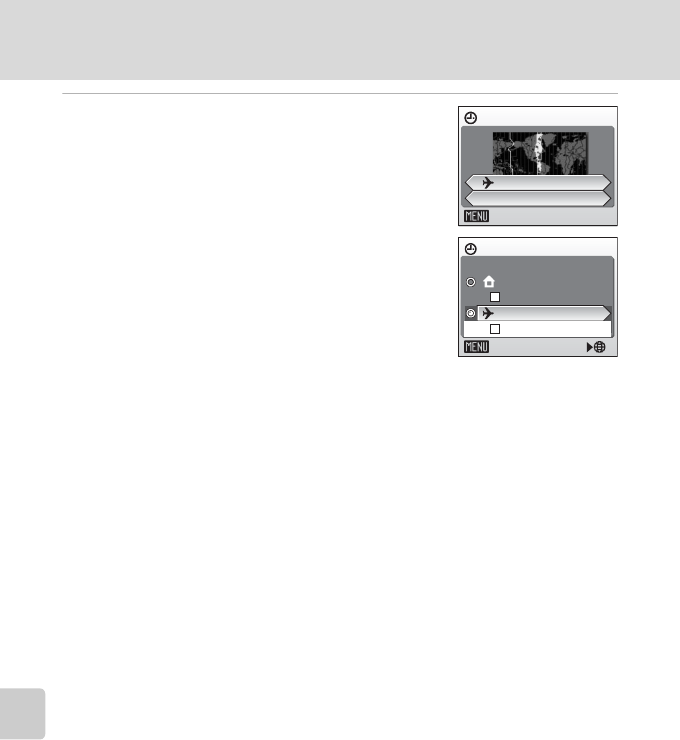
118
Basic Camera Setup: The Setup Menu
Shooting, Playback, and Setup Menus
4Choose the travel destination time zone
and press d.
The setting is enabled.
Press m to return to shooting or playback mode.
While the travel destination time zone is selected, the
Y icon will be displayed in the monitor when the
camera is in shooting mode.
jThe Clock Battery
The clock battery charges when the main battery is installed or an AC adapter is connected,
and can provide several days of backup power after about 10 hours of charging.
kX (Home Time Zone)
• To switch to the home time zone, choose X in step 2.
• To change the home time zone, choose X in step 2 and perform the following steps for
the home time zone.
kDaylight Saving Time
To disable daylight saving time, turn [DaylightSaving] off (y) in the time zone menu.
1 Use the rotary multi selector to choose X (home time zone) or Y (destination time zone)
and press d.
2 Choose [DaylightSaving].
3Press d to turn off the check box (y).
- The camera clock is automatically set back one hour.
- Press d again to turn on the check box (y).
4Press m.
- The setting is enabled and the camera returns to shooting or playback mode.
New city time zone
Back
Toronto, Lima
EST:New York
01.10.2006 05:00
Time zone
Exit
EST:New York
London,Casablanca
DaylightSaving
DaylightSaving
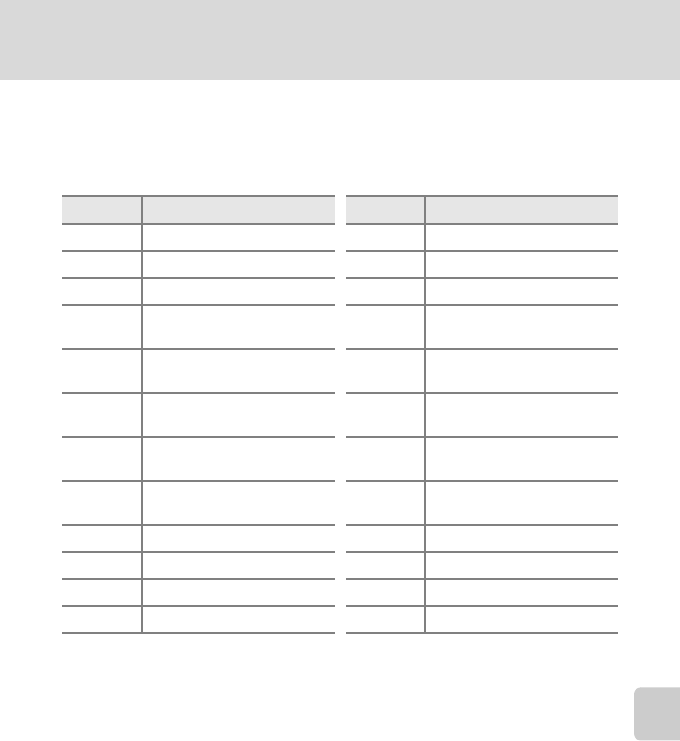
119
Basic Camera Setup: The Setup Menu
Shooting, Playback, and Setup Menus
kTime Zones (c20)
The camera supports the time zones listed below. Increments of less than one hour are not
supported; when travelling to or from destinations at half- or quarter-hour increments from
Greenwich Mean Time (GMT), such as Afghanistan, Central Australia, India, Iran, Nepal, or
Newfoundland, set the camera clock to local time (c20, 117).
GMT +/– Location GMT +/– Location
–11 Midway, Samoa +1 Madrid, Paris, Berlin
–10 Hawaii, Tahiti +2 Athens, Helsinki
–9 Alaska, Anchorage +3 Moscow, Nairobi
–8 PST (PDT): Los Angeles,
Seattle, Vancouver +4 Abu Dhabi, Dubai
–7 MST (MDT): Denver,
Phoenix, La Paz +5 Islamabad, Karachi
–6 CST (CDT): Chicago,
Houston, Mexico City +6 Colombo, Dhaka
–5 EST (EDT): New York,
Toronto, Lima +7 Bangkok, Jakarta
–4 Caracas, Manaus +8 Beijing, Hong Kong,
Singapore
–3 Buenos Aires, São Paulo +9 Tokyo, Seoul
–2 Fernando de Noronha +10 Sydney, Guam
–1 Azores +11 New Caledonia
±0 London, Casablanca +12 Auckland, Fiji
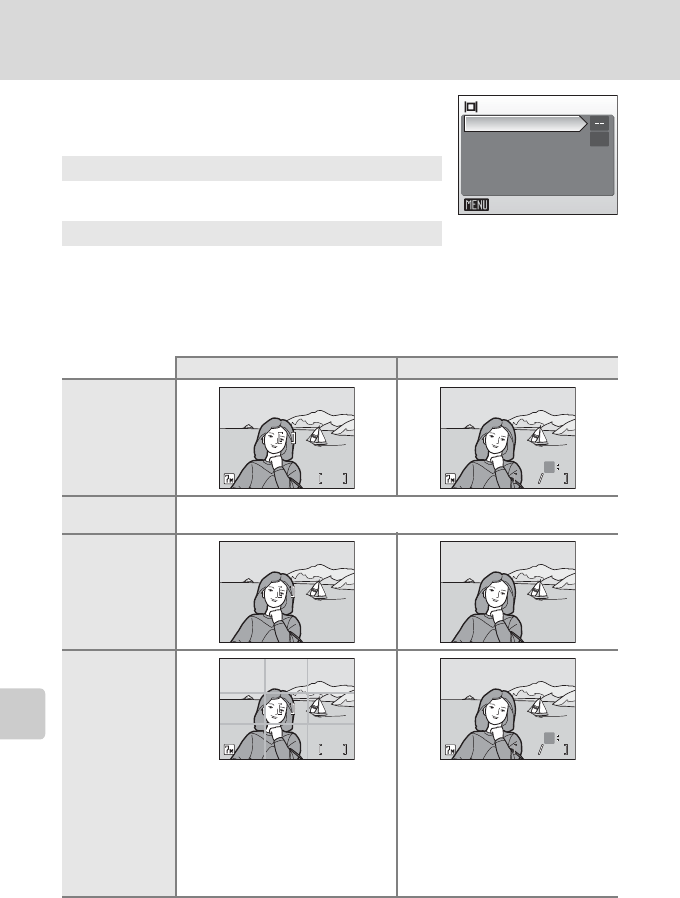
120
Basic Camera Setup: The Setup Menu
Shooting, Playback, and Setup Menus
Z Monitor Settings
Choose whether or not to display information in
the monitor, and set the monitor brightness.
Photo Info
The following display options are available.
See “The Monitor” (c8) for information on indicators in the monitor.
Photo info
Choose information displayed in monitor during
shooting and playback mode.
Brightness
Choose from five settings for monitor brightness.
Shooting mode Playback mode
Show info
Auto info
The current settings or operation guide is displayed for five seconds as in
[Show info] above. After five seconds, display will be the same as [Hide info].
Hide info
Framing grid
Monitor settings
Exit
Photo info
Brightness 4
88
MM
M
100NIKON
100NIKON
15:30
15:30
15:30
100NIKON
0009.JPG
0009.JPG
2006.10.10
2006.10.10
0009.JPG
2006.10.10
44
O
MM
44
N
EE
O
M
88
MM
M
In
L
(auto) mode, a framing grid
is displayed to help frame pictures;
other current settings or operation
guide is displayed for five seconds
as in [Auto info] above.
In other shooting modes, the cur-
rent settings or operation guide is
displayed as in [Show info] above.
100NIKON
100NIKON
15:30
15:30
15:30
100NIKON
0009.JPG
0009.JPG
2006.10.10
2006.10.10
0009.JPG
2006.10.10
44
O
MM
44
N
EE
O
The current settings or opera-
tion guide is displayed as in
[Show info] above.
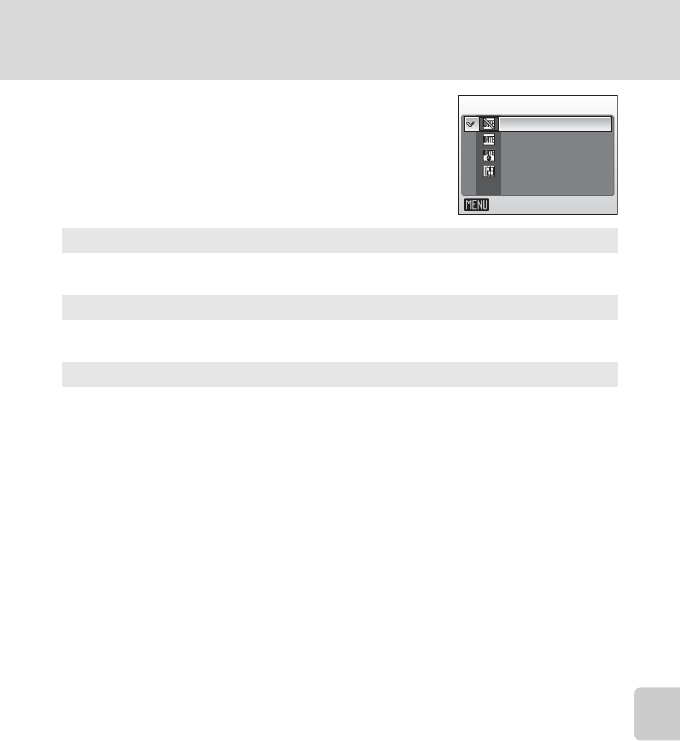
121
Basic Camera Setup: The Setup Menu
Shooting, Playback, and Setup Menus
f Date Imprint
Date and time of recording can be imprinted on
pictures for printing this information from printers
that are not DPOF-compatible (c168).
At settings other than [Off], the icon for the current setting is displayed in the
monitor (c8).
jDate Imprint
• Imprinted dates form a permanent part of image data and cannot be deleted.
• When [Date imprint] is set, [Electronic VR] will automatically be disabled even if set to
[Auto] (c106). In L (auto) and scene modes, vibration reduction will not function even
for conditions where it is normally applied. Note that enabling [Electronic VR] again will dis-
able [Date imprint].
• Even if [Date imprint] is enabled, the date will not be imprinted on pictures taken in anti-
shake mode (c49).
• Dates imprinted at an image-mode setting of [TV screen(640)] (c97) may be difficult to
read. Choose [PC screen(1024)] or larger when using date imprint.
• The date is recorded using the format selected in the setup menu’s [Date] item (c20, 117).
kDate Imprint and Print Set
When using DPOF-compatible devices, shooting date or photo information will be printed if
[Date] or [Info] is selected in the print set menu (c93). See “Differences Between Print Set
and Date Imprint” (c94) for more information on the difference between [Date imprint] and
[Print set].
Date
Date is imprinted on the bottom right corner of pictures taken while this
option is in effect.
Date and time
Date and time are imprinted on the bottom right corner of pictures taken
while this option is in effect.
Date counter
Time stamp shows number of days between date of recording and selected
date.
f
Date imprint
Exit
Off
Date
Date and time
Date counter
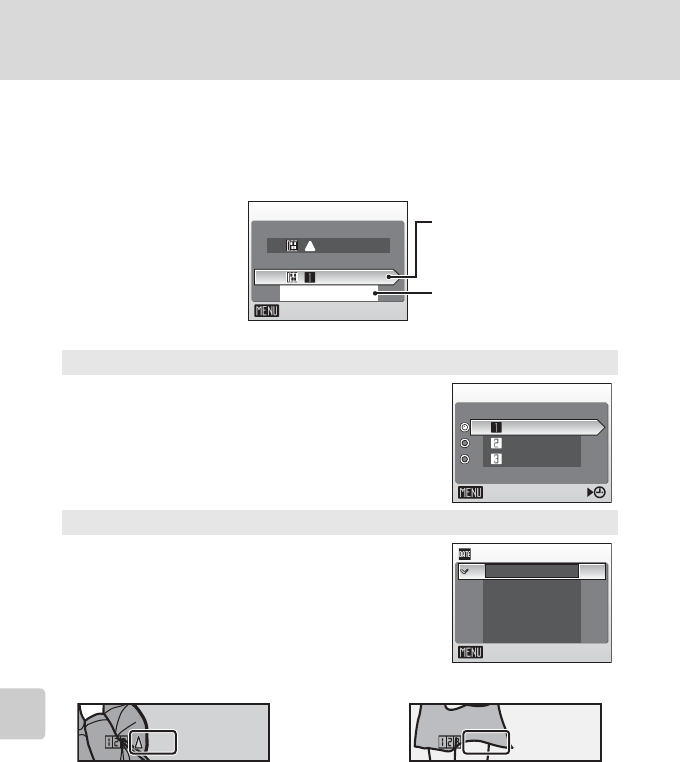
122
Basic Camera Setup: The Setup Menu
Shooting, Playback, and Setup Menus
Date Counter
Pictures taken while this option is in effect are imprinted with the number of
days remaining until, or the number of days elapsed since a specified date.
Use it to track the growth of a child or count down the days until a birthday
or wedding.
Sample date counter time stamps are shown below.
Stored dates
Up to three dates can be stored. To set, choose an
option, press the rotary multi selector J, enter a
date (c20), and press d. To select a different
date, choose an option and press d.
Display options
Choose [Number of days], [Years and days], or
[Yrs, mnths, days] and press d.
f
Date counter
Exit
15.10.2006
Number of days
5
Press d to display the
stored dates option.
Press d to display the
display option.
f
Stored dates
Exit
15.10.2006
--
.
--
.
----
03.03.2006
Display options
Number of days
Years and days
Yrs, mnths, days
Exit
02/ 2006.10.08
02/ 2006.10.08
02/ 2006.10.08 02/ 2006.10.12
02/ 20 06.1 0.1 2
02/ 2006.10.12
Two days remaining Two days elapsed
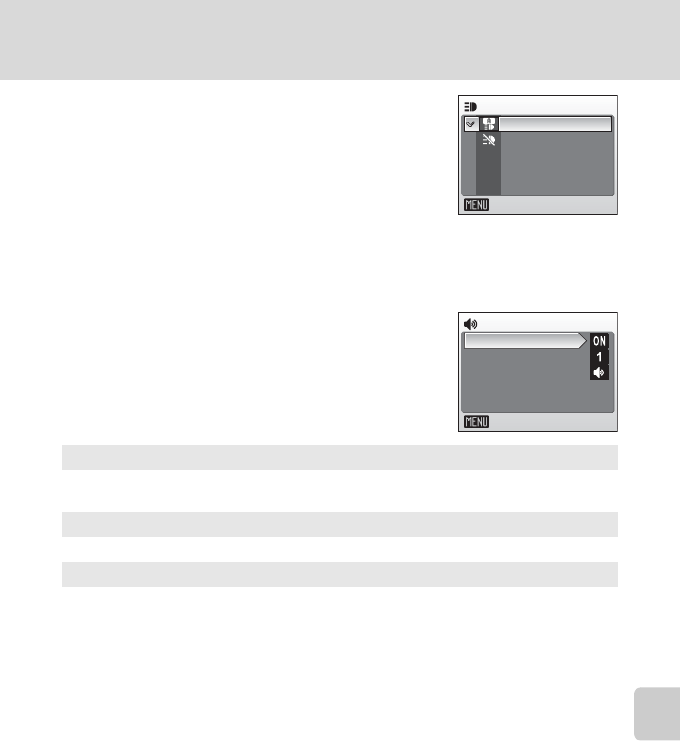
123
Basic Camera Setup: The Setup Menu
Shooting, Playback, and Setup Menus
u AF Assist
If [Auto] is selected, AF-assist illumination will be
used to assist the focus operation when the subject
is poorly lit.
Note that for some modes, AF-assist illumination
turns off automatically.
To disable this function, choose [Off]. When set to [Off], the camera may be
unable to focus if lighting is poor.
h Sound Settings
Adjust the following sound settings.
Button sound
When [On] is selected, beep will sound once when operations are completed
successfully, three times when error is detected.
Shutter sound
Choose shutter sound from [1], [2], [3], and [Off].
Volume
Choose volume of shutter sound from [Loud], [Normal], and [Off].
AF assist
Exit
Auto
Off
Button sound
Shutter sound
Volume
Sound settings
Exit
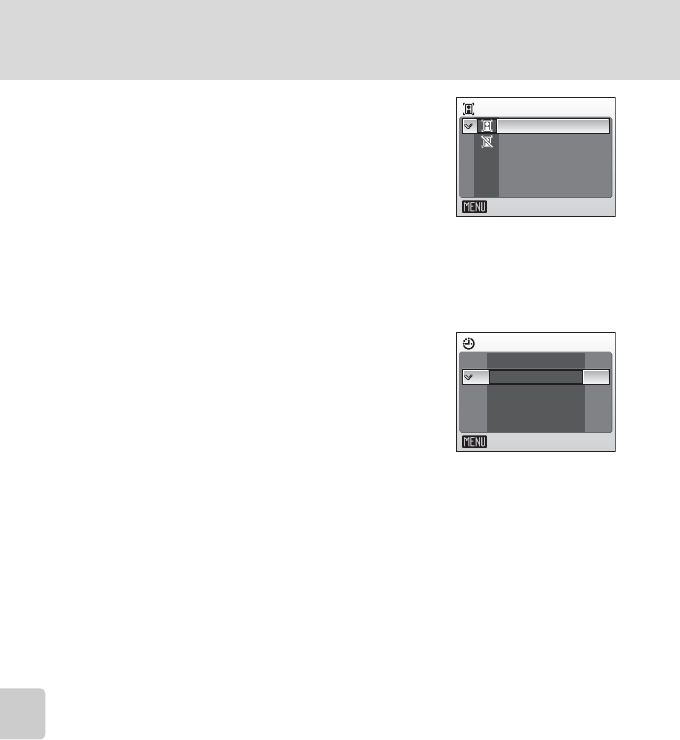
124
Basic Camera Setup: The Setup Menu
Shooting, Playback, and Setup Menus
I Record Orientation
Choose whether or not to record the orientation of
pictures taken in “tall” orientation.
Choose [Auto] to record the picture’s orientation
detected by the camera’s sensor. The taken picture
will be automatically rotated when played back on
the camera monitor or with PictureProject. When
[Off] is selected, the picture will be displayed in the same orientation as it
was taken.
i Auto Off
Choose the time allowed to elapse before the cam-
era enters standby mode to save power (c25).
The time options are 30 seconds, one minute, five
minutes, and 30 minutes. The power-on lamp
flashes in standby mode. If no operations are per-
formed for another three minutes, the camera turns
off.
jNotes on Auto Off
The monitor will remain on for a minimum of:
• Three minutes when menus are displayed
• Thirty minutes during continuous playback for slide shows and Pictmotion movies, or when
the AC adapter is connected
Exit
Auto
Off
Record orientation
Auto off
Exit
30s
1m
5m
30m
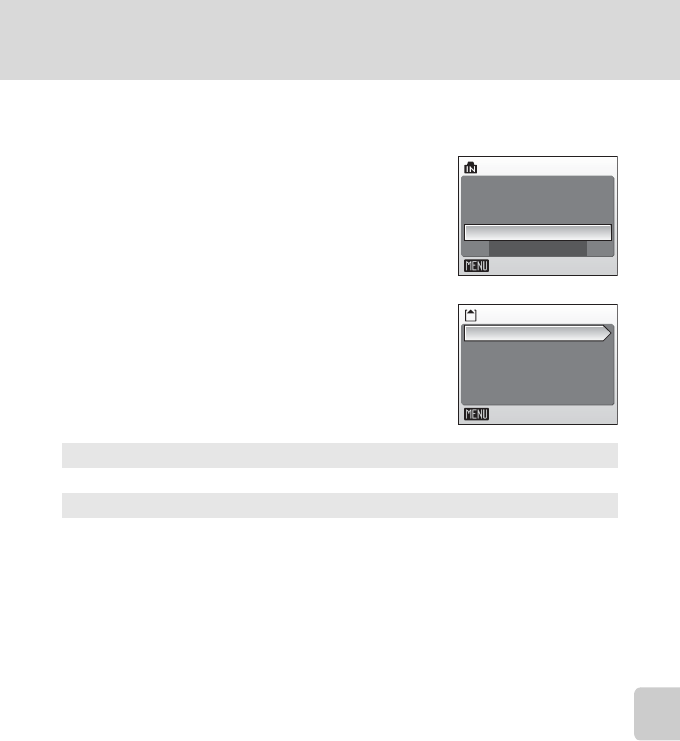
125
Basic Camera Setup: The Setup Menu
Shooting, Playback, and Setup Menus
M
Format Memory/
O
Format Card
Format the internal memory or a memory card.
Formatting the Internal Memory
If no memory card is inserted, this option is labeled
[Format memory] and formats internal memory.
Remove the memory card from the camera to for-
mat the internal memory.
Formatting a Memory Card
If a memory card is inserted, the option is labeled
[Format card] and formats the memory card.
j Formatting Internal Memory and Memory Cards
• Formatting the internal memory or memory cards permanently deletes all data. Be sure to
transfer important pictures to a computer before formatting.
• Do not turn the camera off, disconnect the AC charger, or remove the battery or memory
card during formatting.
• The first time you insert the memory cards used in other devices into the COOLPIX S7c, for-
mat them with [Format]. Repeated recording and deleting of pictures without regular for-
matting reduces memory card performance.
• Regular formatting of memory cards is recommended to maintain maximum performance.
• [Format] is not available when the battery is low.
Quick format
Formats only portions of the memory card containing data.
Format
Formats the entire memory card including portions with no recorded data.
[Format] takes longer than [Quick format].
Format memory
WARNING!
All images will be deleted!
Exit
Format
No
Format card
Exit
Quick format
Format
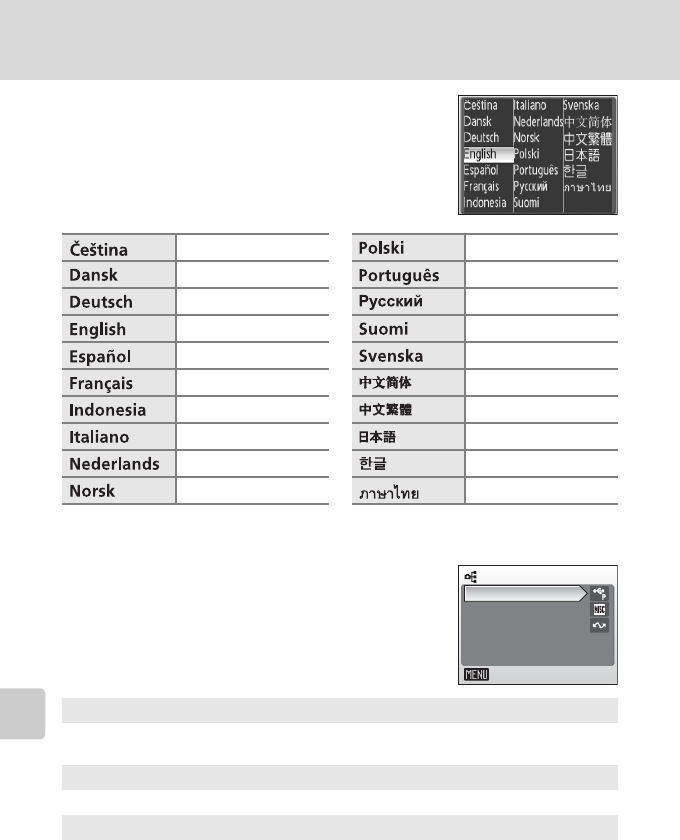
126
Basic Camera Setup: The Setup Menu
Shooting, Playback, and Setup Menus
j Language
Choose one of 20 languages for display of camera
menus and messages.
k Interface
Adjust settings for connection to a computer or
television.
Czech Polish
Danish Portuguese
German Russian
(default) Finnish
Spanish Swedish
French Simplified Chinese
Indonesian Traditional Chinese
Italian Japanese
Dutch Korean
Norwegian Thai
USB
Select [Mass storage] or [PTP] for connection to computer (c83) or printer
(c88).
Video mode
Choose from [NTSC] and [PAL].
Auto transfer
Choose [On] to mark all new pictures for transfer to computer (c86).
Interface
Exit
USB
Video mode
Auto transfer
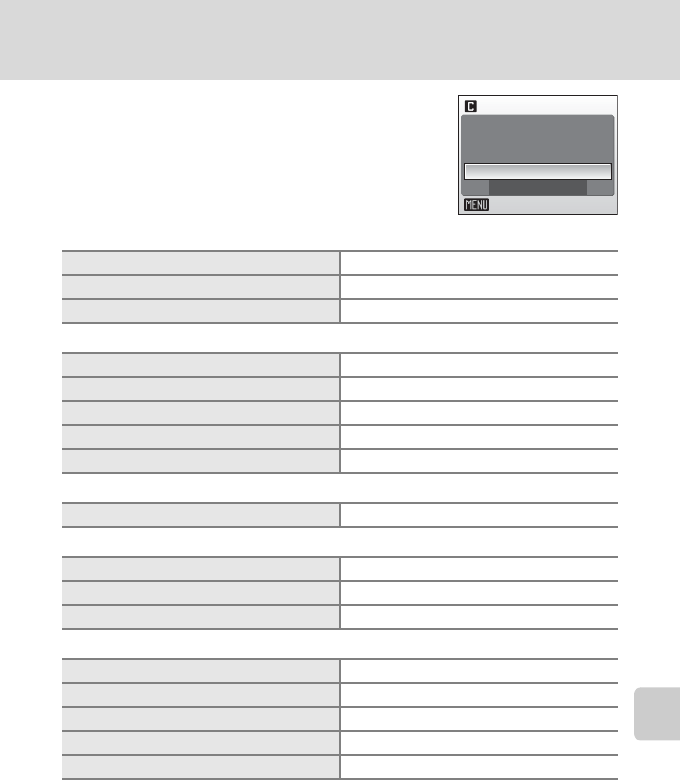
127
Basic Camera Setup: The Setup Menu
Shooting, Playback, and Setup Menus
n Reset All
This option restores the following settings to their
default values:
Pop-up menu
Scene mode
One-touch portrait menu
Movie menu
Pictmotion menu
Flash mode (c32) Auto
Self-timer (c34) Off
Macro close-up (c35) Off
Scene mode (c37) Portrait
Portrait assist (c39) Portrait
Landscape assist (c40) Landscape
Sports assist (c41) Sports
Night portrait assist (c42) Night portrait
Portrait effect (c51) Normal
Movie options (c72) Small size 320
Auto-focus mode (c75) Single AF
Electronic VR (c75) Off
Background music (c68) High-speed
Effects (c68) Motion
Playback order (c68) Random
Loop (c68) Repeat photos
Selected images (c68) 10 pictures
Reset all
Reset all settings to default
values
Exit
Reset
No
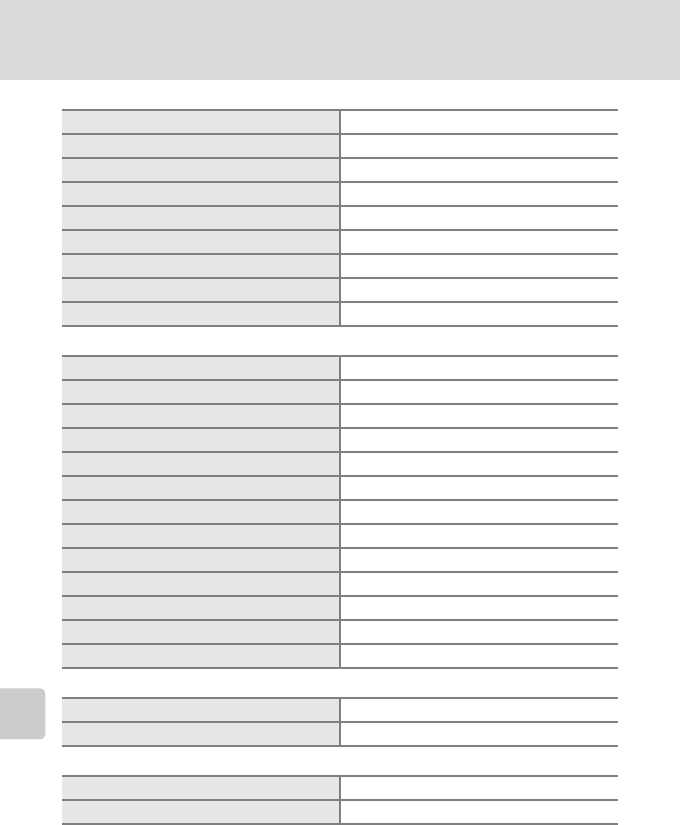
128
Basic Camera Setup: The Setup Menu
Shooting, Playback, and Setup Menus
Shooting menu
Setup menu
Others
Wireless Transfer Menu
Image mode (c97) Normal(3072)
White balance (c99) Auto
Exposure compensation (c101) 0
Continuous (c102) Single
BSS (c104) Off
ISO sensitivity (c105) Auto
Color options (c105) Standard color
AF area mode (c106) Center
Electronic VR (c106) Auto
Menus (c115) Text
Quick startup (c116) On
Welcome screen (c116) Animation
Photo info (c120) Auto info
Brightness (c120) 4
Date imprint (c121) Off
AF assist (c123) Auto
Button sound (c123) On
Shutter sound (c123) 1
Volume (c123) Normal
Record orientation (c124) Auto
Auto off (c124) 1m
Auto transfer (c126) On
Sound quality (c78) High
Paper size (c89, 90) Default
Confirm Transfer (c154) Off
Save Images (c154) Off
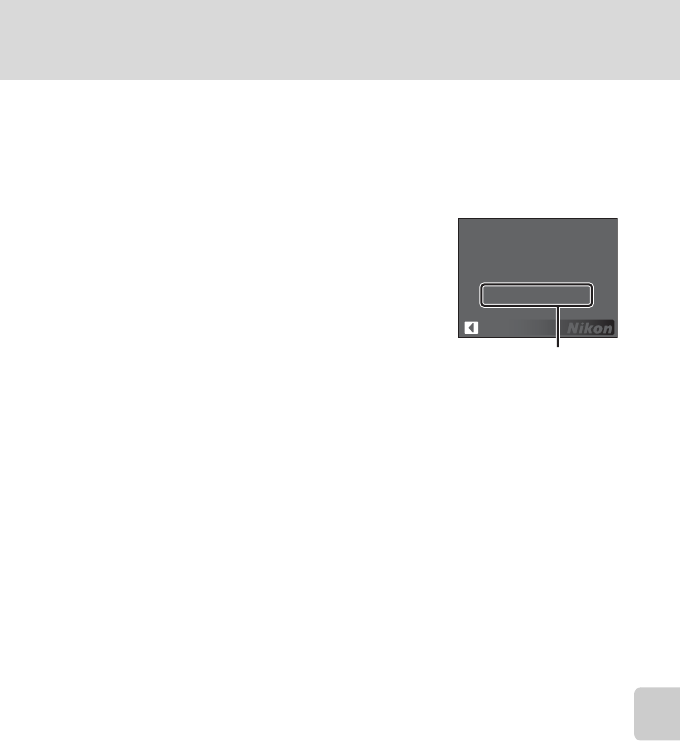
129
Basic Camera Setup: The Setup Menu
Shooting, Playback, and Setup Menus
• Choosing [Reset all] also clears the current file number (c160) from the memory. Num-
bering will continue from the lowest number available. To reset file numbering to “0001”,
delete all pictures (c111) before selecting [Reset all].
• Settings for [Date] (c117), [Date counter] (c122), [Language] (c126), [USB] (c126),
and [Video mode] (c126) will remain unaffected even if [Reset all] is performed.
B Firmware Version
View the current camera firmware version.
The 12-digit number displayed below the firmware
version is the camera’s MAC address.
Back
XX-XX-XX-XX-XX-XX
MAC address
COOLPIX S7c Ver. X.X
MAC address

130
Wireless Transfer Mode
Wireless Transfer Mode
What is Wireless Transfer Mode?
COOLPIX S7c is equipped with a wireless transfer mode, which is based on
the IEEE 802.11b/g standard. This section describes how the wireless transfer
mode works using the wireless LAN communication feature, and also
describes the configuration necessary for wireless transfer mode.
Features of Wireless Transfer Mode
COOLPIX CONNECT
Pictures stored in the camera’s internal memory or on a memory card can be
viewed by your family and friends via e-mail and webpage. For more infor-
mation on the COOLPIX CONNECT service, refer to “Uploading Pictures to
COOLPIX CONNECT” (c145).
PC Connection
• Pictures stored in the camera’s internal memory or on a memory card can
be transferred to a computer via home wireless LAN.
• Just-taken pictures can be immediately transferred to a computer wire-
lessly connected.
Wireless Printing
• Pictures can be printed with a printer connected to a computer that is
wirelessly connected via home wireless LAN.
• Pictures can be directly transferred to a PictBridge-compatible printer and
printed using the optional wireless printer adapter PD-10.
kNote on Screen Images
Screen images in monitor may differ from the actual display.
lNote on Wireless LAN Configuration
For more information on wireless LAN configuration, contact the manufacturer of the wireless
LAN adapter or access point, or see other commercially available references.
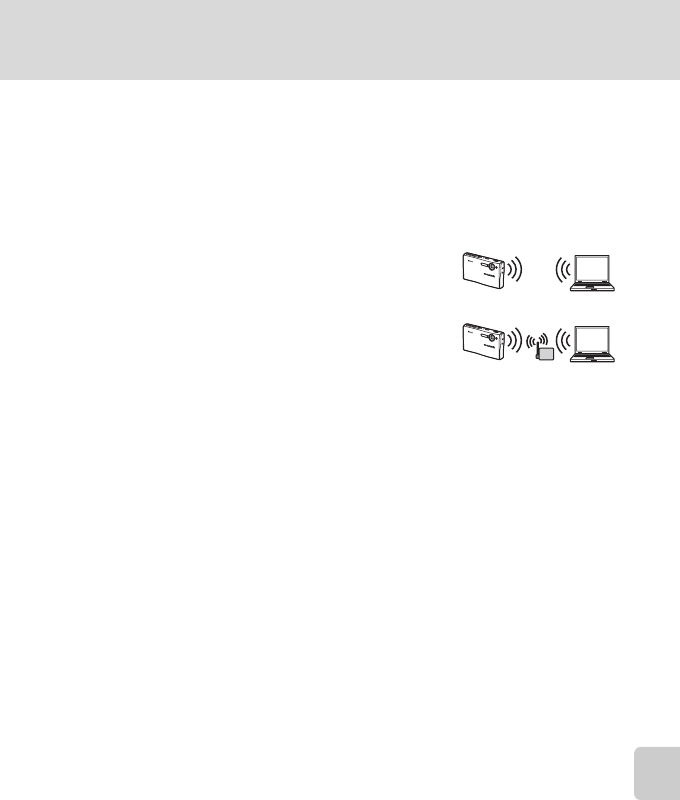
131
What is Wireless Transfer Mode?
Wireless Transfer Mode
lHome Wireless LAN
• This refers to wireless LAN networks connected via ad-hoc mode or infrastructure mode at
home or at the office.
• If Internet connection is possible from the home wireless LAN (Infrastructure mode), you
can use the COOLPIX CONNECT service. However, if the home wireless LAN uses a proxy
server to connect to the Internet, the COOLPIX CONNECT service is not available.
lAd-hoc Mode and Infrastructure Mode
• Ad-hoc mode establishes a peer-to-peer (one-to-one) connec-
tion with a wireless LAN-capable device. With the
COOLPIX S7c’s wireless transfer mode, a peer-to-peer connec-
tion is established between the camera and computer.
• Infrastructure mode connects a wireless LAN-capable device to
a wireless LAN network via an access point. With the
COOLPIX S7c’s wireless transfer mode, this mode connects the
camera and computer via a wireless LAN access point.
lThe Wireless Camera Setup Utility
• To use wireless transfer mode (for configuration and transferring pictures), the Wireless
Camera Setup Utility 2.0 (Setup Utility hereafter) is necessary. Use the supplied Wireless
Camera Setup Utility/PictureProject Software CD to install the Setup Utility.
• The Setup Utility is used for configuring profiles, and must be installed to the computer
used for PC connection (c130, 150). Also, the Setup Utility is used for renaming or delet-
ing profiles, changing the destination folder when transferring pictures to the computer,
and switching the printer used for wireless printing.
• See the Quick Start Guide for more information on installing the Setup Utility.
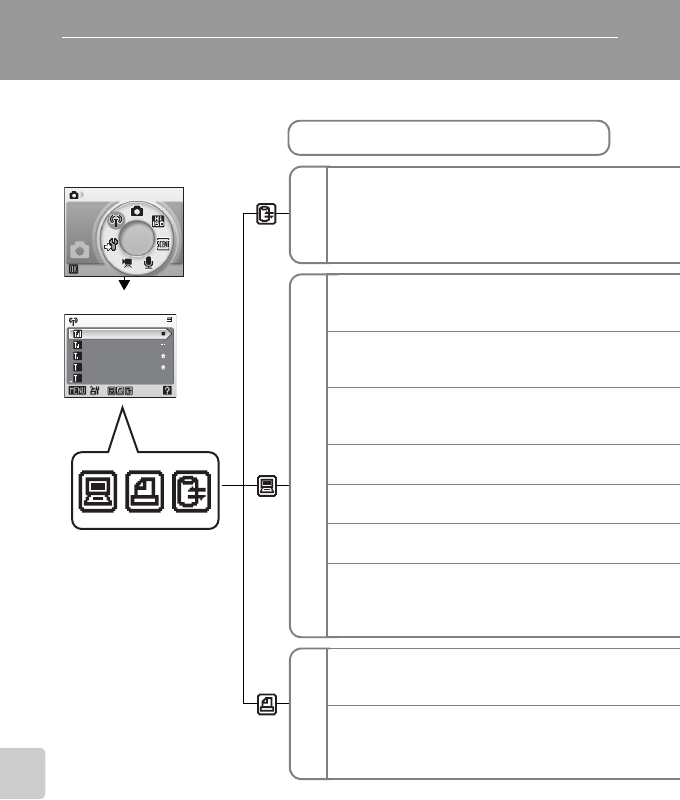
132
Wireless Transfer Mode
The Features Available in the Wireless Transfer Mode
The features below are available in the COOLPIX S7c’s wireless transfer mode.
1
2
COOLPIX CONNECT
(via home wireless LAN)
COOLPIX CONNECT can be used by connect-
ing the camera directly to the Internet via
home wireless LAN.
Easy Transfer (including Pictmotion movies)
Transfer pictures and Pictmotion movies not
yet saved in the computer.
Easy Transfer (excluding Pictmotion movies)
Transfer pictures not yet saved in the computer
(excluding Pictmotion movies).
Shooting Date
Transfer all pictures taken on a specific
recording date.
Selected Images
Transfer only selected pictures.
Shoot & Transfer
Immediately transfer taken pictures.
Marked Images
Transfer pictures with the transfer icon (E).
PC Mode
After connecting the camera and the com-
puter wirelessly, transfer pictures by operating
the computer.
Wireless Printing
Print pictures wirelessly from the camera via a
computer.
Wireless Printing
Print pictures wirelessly from the camera
directly via an optional PD-10 wireless printer
adapter connected with a printer.
Wireless LAN
Select SSID
mobilepoint
HOTSPOT2
AP1
PC1
123456789012345
3
When wireless transfer
mode is selected in the
mode menu (1), after
required configurations are
made, the list of network
names (SSID) detected by
the camera is displayed
(2).
When selecting the
desired SSID, the features
available with that SSID
are displayed by icon (3)
(actual display varies with
current settings).
Features
COOLPIX CONNECT
PC Connection Wireless Printing
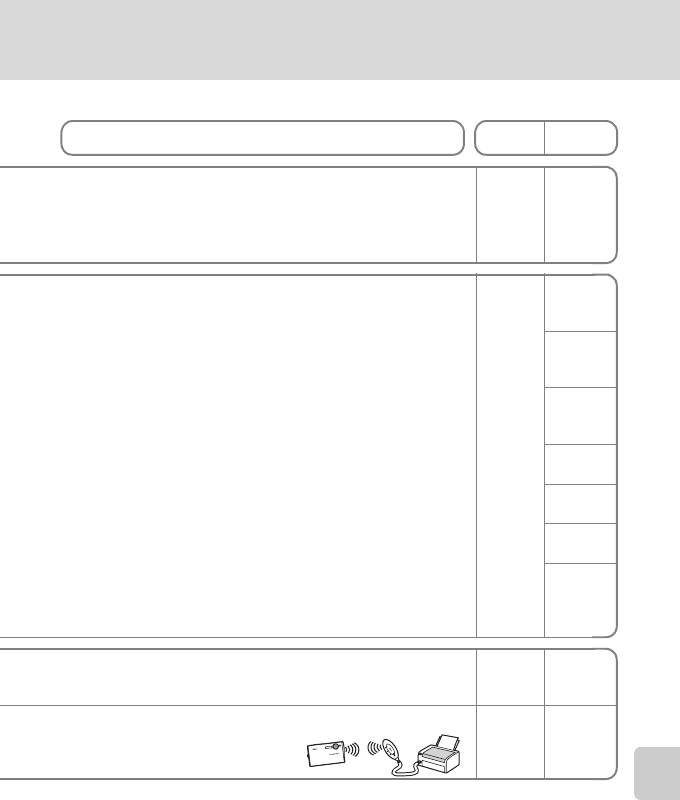
133
The Features Available in the Wireless Transfer Mode
Wireless Transfer Mode
• Internet-capable wireless LAN (c134)
• Wireless LAN-capable computer with the Setup Utility. c134 c145
• Home wireless LAN (Ad-hoc mode or Infrastructure mode)
• Wireless LAN-capable computer with the Setup Utility. c134
c150
c150
c151
c152
c153
c155
c156
• Printer connected with computer is needed in addition to the
requirements for PC connection above. c134 c158
• Optional PD-10 wireless printer adapter
• Connection setup for the camera
and the PD-10. c158
Requirements
Configuring Operating
LINK
BUSY
S
T
A
R
T
P
O
W
E
R
Re
f
er to t
h
e
PD-10
instruction
manual.
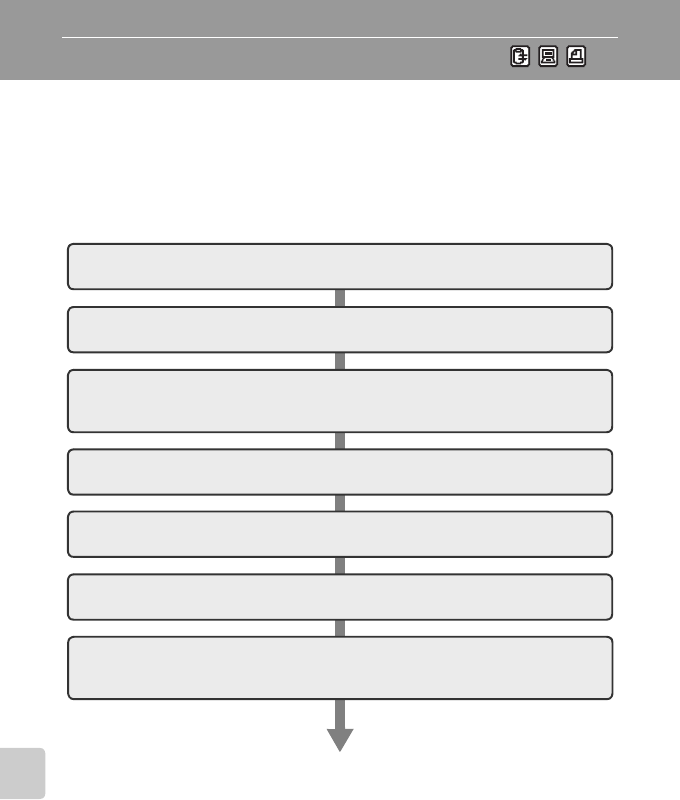
134
Wireless Transfer Mode
For Connection via Home Wireless LAN
Connect to a home wireless LAN wirelessly and make necessary configura-
tions for connecting to COOLPIX CONNECT (via home wireless LAN), con-
necting to a computer wirelessly, and for wireless printing.
Configuration Procedure
This section gives a brief description about the procedure for creating a wire-
less connection. See “Configuring the Camera” (c136) for details.
1Prepare a wireless LAN-capable computer.
3
Check that the USB setting is correctly selected in the camera
and the battery is not exhausted, and turn off the camera.
4Connect the computer and camera using the USB cable.
5Start the Setup Utility.
7Choose the profile type [Add Profile at Home Wireless
LAN].
2Install the Setup Utility to the computer.
6Choose the action [Add profiles].
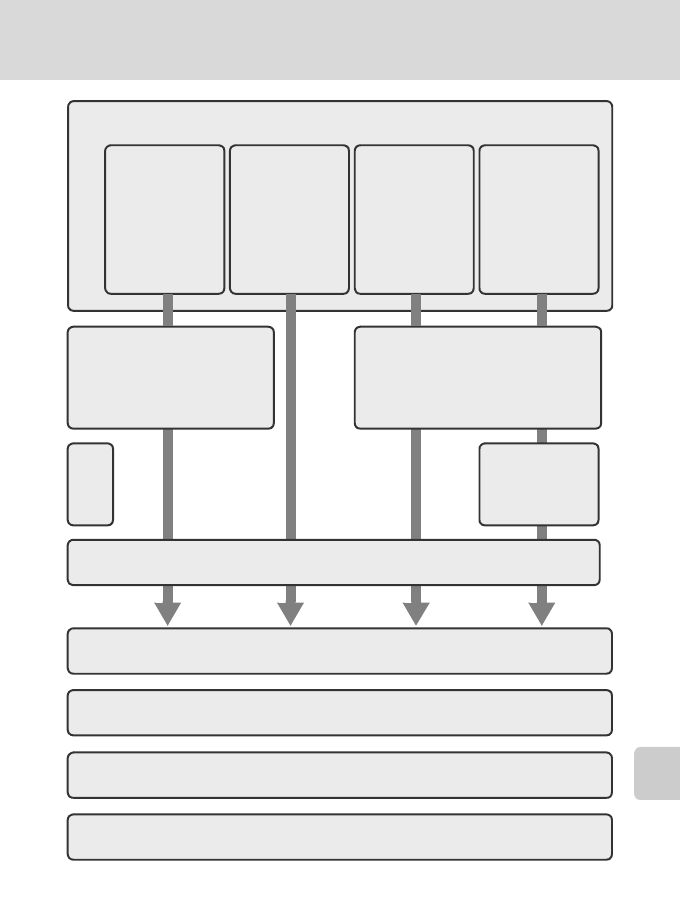
135
For Connection via Home Wireless LAN
Wireless Transfer Mode
12Configure wireless printing.
9Configure wireless
LAN settings
between the cam-
era and computer.
11Set profile name and icon.
13Configure COOLPIX CONNECT.
14Configuration completed.
15Disconnect the computer and camera.
Configure
TCP/IP.
Configure wireless LAN set-
tings between the camera
and computer.
8Choose the connection method.
Create an Infra-
structure
(Access Point)
network profile
Create an Ad-
hoc (Camera to
Computer) net-
work profile
Create Infra-
structure (Access
Point) and Ad-
hoc (Camera to
Computer) net-
work profiles
Create Profile
manually:
•
Fixed IP addressing
•
Operating sys-
tem other than
Windows
•
Windows XP SP1
•Macintosh
10
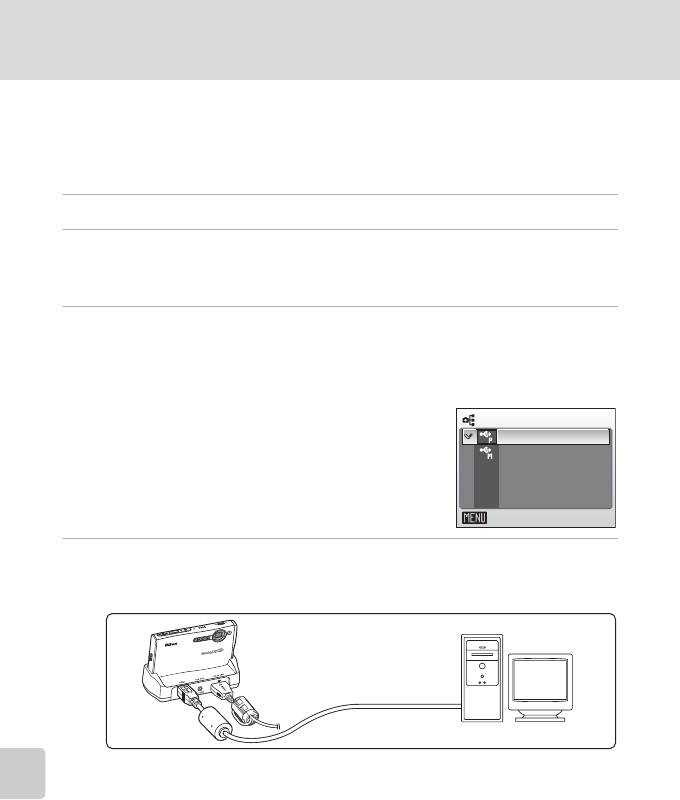
136
For Connection via Home Wireless LAN
Wireless Transfer Mode
Configuring the Camera
This section describes the “Configuration Procedure” (c134) in detail.
• To display more information on each step, click [Help]. To cancel configur-
ing a profile device, click [Cancel].
1Prepare a wireless LAN-capable computer.
2Install the Setup Utility to the computer.
Check whether the Setup Utility (c131) is installed on the computer used for
configuring.
3Check that the USB setting is correctly selected in the camera
and the battery is not exhausted, and turn off the camera.
Check the following before starting the Setup Utility on the computer. After
checking is complete, turn off the camera.
• [Interface] > [USB] (c126) is set to [PTP].
• The battery is fully charged or the supplied AC
adapter is connected. If the battery runs out while
configuring a profile, settings will not be entered
correctly.
4Connect the computer and camera using the USB cable.
Place the camera in the COOL-STATION and connect to the computer using the
supplied USB cable. Then, turn on the camera.
USB
Exit
PTP
Mass storage
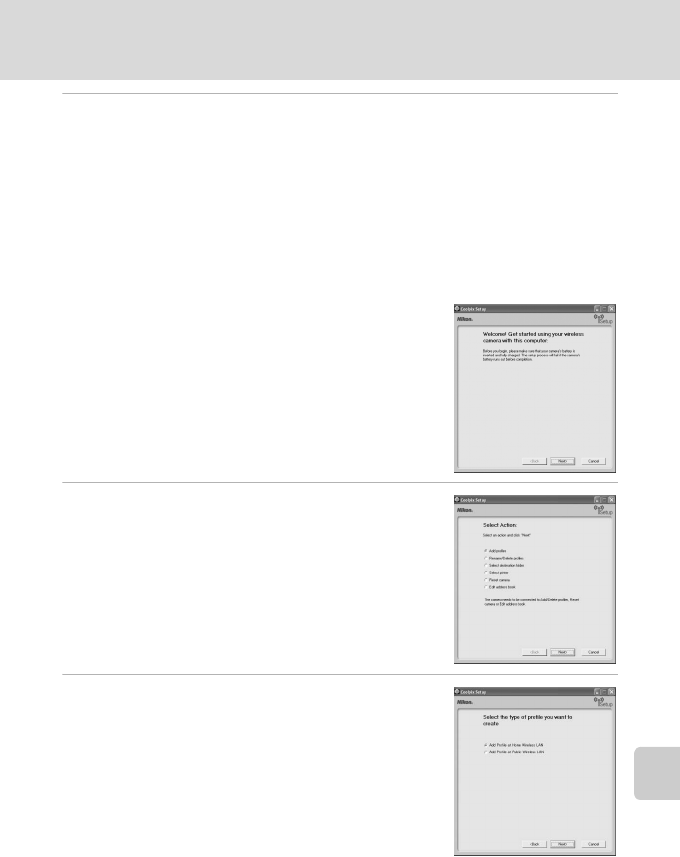
137
For Connection via Home Wireless LAN
Wireless Transfer Mode
5Start the Setup Utility.
For the initial installation run, the Setup Utility will launch automatically when
installation is complete.
From the second time, start the Setup Utility by following the procedure below:
Windows: Start the computer and select [Start] > [All programs] > [Wireless
Camera Setup Utility] > [Wireless Camera Setup Utility].
Macintosh: Start the computer and open [Applications] > [Nikon Software] >
[Wireless Camera Setup Utility] folder. Then double-click the [NkWire-
lessSetup] icon.
• Click [Next] after checking the contents shown in
the screen at right.
6Choose the action [Add profiles].
7Choose the profile type [Add Profile at
Home Wireless LAN].
You can start configuration of infrastructure mode or
ad-hoc mode for the computer connected to the wire-
less LAN.
Set up for Public Wireless LAN is available only for
T-Mobile HotSpot in United States.
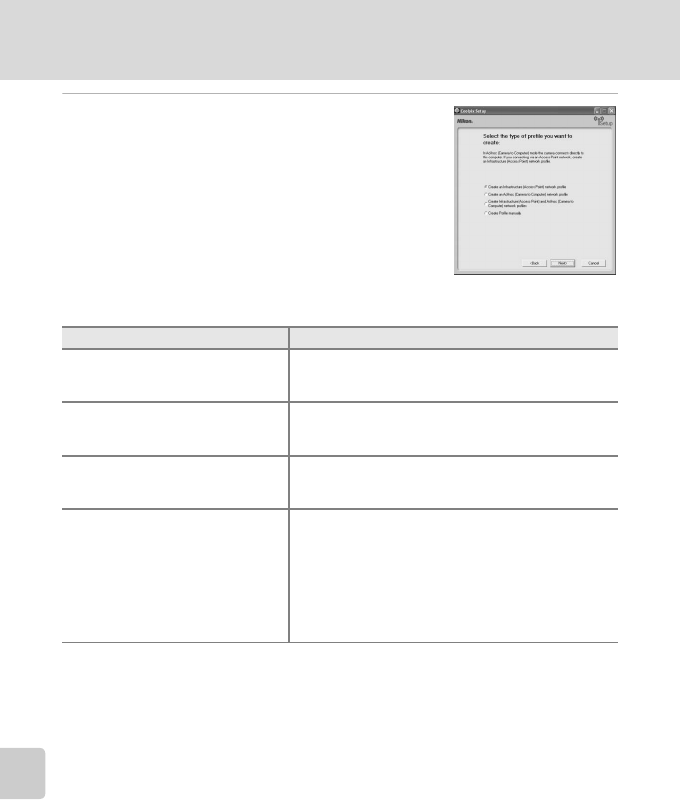
138
For Connection via Home Wireless LAN
Wireless Transfer Mode
8Choose the connection method.
Available profile types (see the list below) for your
wireless LAN will be displayed on screen. Select the
desired profile type and click [Next].
When selecting [Create an Ad-hoc (Camera to Com-
puter) network profile], proceed to step 11 (c139).
If multiple wireless LAN devices are connected to the
computer, choose a device from the pop-up menu.
Select the desired configuration type from the options
listed. Options displayed will differ depending on the
selected wireless device.
jNote on Choosing [Create an Ad-hoc (Camera to Computer) network
profile] on Windows XP
• When configuring a profile device using an ad-hoc network between the camera and com-
puter, the computer’s fixed IP address (manually entered IP address) will be automatically
set to “169.254.x.x”. When adding an infrastructure network later, set the computer to
automatically obtain an IP address. For the added network profiles, configure wireless set-
tings between the camera and computer again.
• [Create an Ad-hoc (Camera to Computer) network profile] cannot be selected if an infra-
structure network has already been set up in your computer, or the fixed IP address is not
“169.254.x.x”.
Type of Profile Descriptions
Infrastructure (Access Point)
network profile
For use when connecting the camera and com-
puter via an infrastructure network. An infrastruc-
ture network must be configured beforehand.
Ad-hoc (Camera to Computer)
network profile
For use when establishing a one-to-one connec-
tion (when a wireless LAN access point is not avail-
able) between the camera and computer.
Infrastructure (Access Point)
and Ad-hoc (Camera to Com-
puter) network profiles
Recommended for users of multiple wireless net-
work profiles.
Create Profile manually
For use with manual settings. Only [Create Profile
manually] is available when:
- configuration for wireless LAN network is not
performed using the wireless network setting
function (Zero Config) for Windows XP
- using a Windows XP SP1 or Mac OS X operating
system
- your computer has a fixed IP address
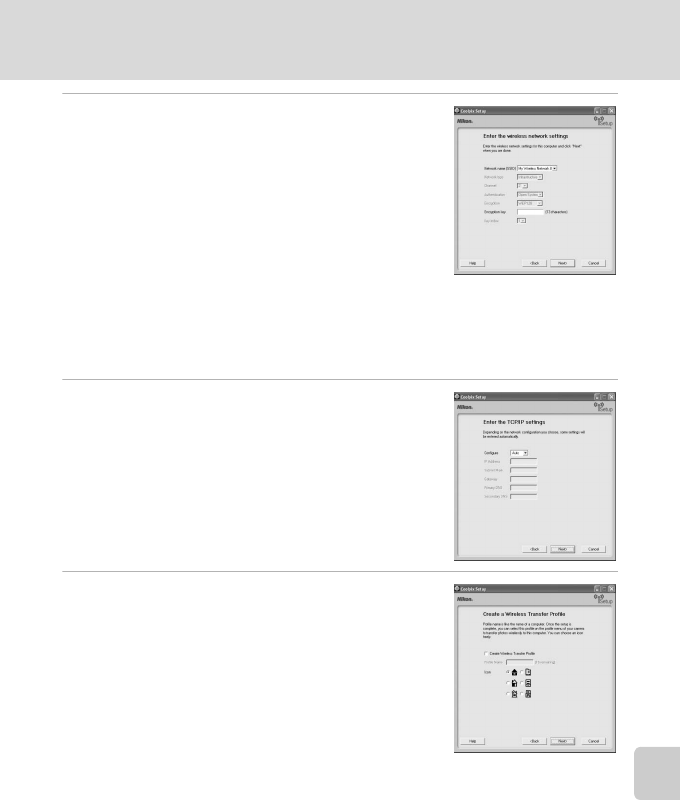
139
For Connection via Home Wireless LAN
Wireless Transfer Mode
9Enter network settings.
Enter the settings for connecting the camera and com-
puter via a wireless network.
When selecting [Create an Infrastructure (Access
Point) network profile] or [Create Infrastructure
(Access Point) and Ad-hoc (Camera to Computer) net-
work profiles] in step 8, select a network name from
the [Network Name (SSID)] list. This name will be used
when connecting the camera and computer.
When selecting [Create Profile manually] in step 8,
manually enter the same values set in the computer for all items except those that
are automatically provided. See “Settings for the Setup Utility” for reference
(c141).
When settings are complete, click [Next].
10Configure TCP/IP.
When selecting [Create Profile manually] in step 8, or
if the screen in step 8 does not appear, manually enter
the address type and IP address, referring to those
used in “Settings for the Setup Utility” (c141).
When settings are complete, click [Next].
11Set profile name and icon.
Enter a profile name (up to 16 single-byte alphanu-
meric characters).
The entered profile name will appear in the selection
list for the profile device (c144). We recommend
selecting a name that will let you easily tell devices
apart, such as “Desktop-Home”.
When settings are complete, click [Next].
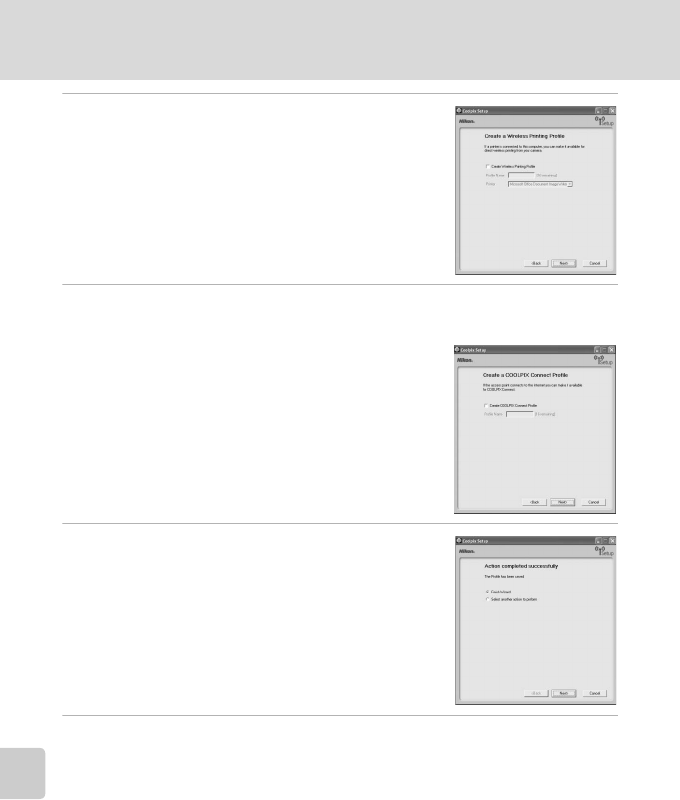
140
For Connection via Home Wireless LAN
Wireless Transfer Mode
12Configure wireless printing.
If a printer is connected to the computer, check [Cre-
ate Wireless Printing Profile] and select the printer to
be used for wireless printing (c158).
Enter a profile name (up to 16 single-byte alphanu-
meric characters), select a printer, and click [Next].
If no printers are connected to the computer, click
[Next] without selecting a printer.
13Configure COOLPIX CONNECT.
If using COOLPIX CONNECT, enter the profile name for COOLPIX CONNECT.
• Check [Create a COOLPIX CONNECT Profile] and
enter a profile name (up to 16 single byte alphanu-
merical characters) and click [Next].
14Settings are complete.
Select [Finish wizard] and click [Next].
15Disconnect the computer and camera.
Turn off the camera before removing it from the COOL-STATION.
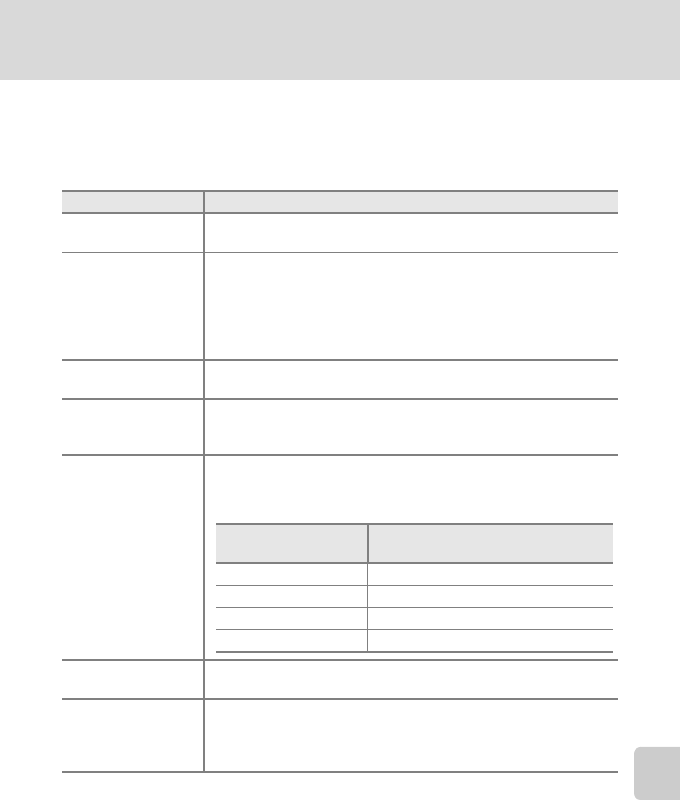
141
For Connection via Home Wireless LAN
Wireless Transfer Mode
Settings for the Setup Utility
When configuring a profile using the Setup Utility, refer to the description for
each item listed below. Settings are the same for Windows and Macintosh.
* Mandatory items
Settings Descriptions
Network name
(SSID)*
Enter the network ID for the computer. Choose a value dis-
played. If multiple values are displayed, select one.
Network type*
Select [Ad-hoc] or [Infrastructure]. The camera and computer
must be set to the same configuration.
• Ad-hoc mode: This mode establishes a peer-to-peer (one-to-
one) connection between the camera and computer.
• Infrastructure mode: This mode connects the camera and
computer via a wireless LAN access point.
Channel Mandatory if [Ad-hoc] is selected for [Network type]. Select the
same channel (1 to 11) set in the computer.
Authentication
Select [Open System], [Shared Key], [WPA-PSK]* or [WPA2-
PSK]* (* [Infrastructure] only). Select the same method set in
the computer or access point.
Encryption
Available methods for the camera differ depending on the
selected authentication method (see below). Select the same
method set in the computer or access point.
Encryption key Enter the security key set in the computer or access point
(unnecessary when [Encryption] is set to [None]).
Key index
When [Encryption] is set to [WEP], and infrastructure mode is
used, select the same key index set in the computer or access
point (unnecessary when [Encryption] is set to [None], [TKIP] or
[AES]). The default setting is [1].
Selected authentica-
tion method
Available security method(s) for
the camera
[Open System] [None], [WEP]
[Shared Key] [WEP]
[WPA-PSK] [TKIP]
[WPA2-PSK] [AES]

142
For Connection via Home Wireless LAN
Wireless Transfer Mode
jWireless LAN Channels
Wireless LAN channels for the COOLPIX S7c are from 1 to 11. Make sure that the channel for
your computer’s wireless LAN device is set to a channel between 1 and 11 (inclusive).
jMAC Address Filtering
When MAC address filtering is enabled, only devices with an authorized MAC address can
access the wireless LAN. Check the camera’s MAC address in [Firmware Version] of the setup
menu (c129) and add it to the authorized list.
jPort Number
For wireless communication, the UDP port number is “5353” and the TCP port number is
“15740”. If the computer or access point has a firewall, the firewall settings may need to be
changed.
lNotes on Profile Devices
• Configure profiles for each computer using the Setup Utility and install the Setup Utility to
each computer to transfer (receive) pictures from the camera remotely.
• You can configure a maximum of nine profile devices (computers, printers connected to a
computer, the optional PD-10 wireless printer adapter, etc.) in the camera. If nine have
already been configured and you want to add a new one, delete an unneeded profile
device using the Setup Utility.
• Start the Setup Utility while the camera is connected to a computer via USB cable, and you
can rename or delete profiles. Choose [Rename/Delete profiles] in the action selection
screen of the Setup Utility and click [Next]. Then choose a profile you wish to rename or
delete and click [Rename] or [Delete]. You can also confirm the details of a profile by click-
ing [View Profile]. Choose [Reset camera] in the action selection screen to delete all profiles
(all address book contents are also deleted).
Configure* Select [Auto] (default setting) or [Manual] for the method of
setting the camera IP address.
IP Address When [Configure] is set to [Manual], enter the IP address for
the camera.
Settings Descriptions
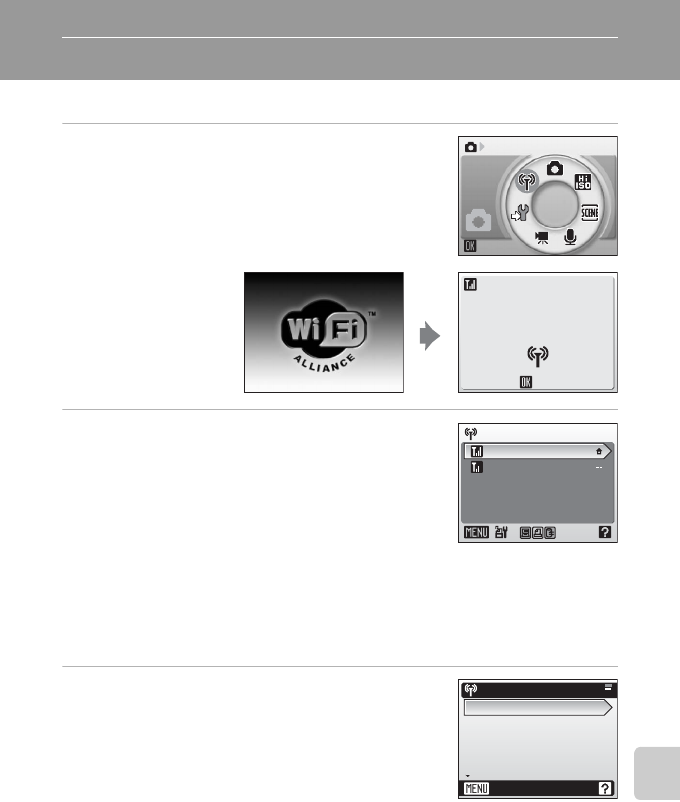
143
Wireless Transfer Mode
Transferring Pictures
Establishing a Wireless Connection
1Enter wireless transfer mode by pressing
D in shooting mode, selecting n (use
the rotary multi selector), and then
pressing d.
The wireless LAN start-up screen will be displayed and
the camera will search for available SSIDs.
2Choose the SSID and press d.
The SSIDs are listed in order of radio field strength.
Wireless connection has not yet been established.
The left icon of each SSID is indicated in red when
outside the network area.
The right icon indicates the type of the profile regis-
tered to each SSID:
Z (profiles with home wireless LAN information),
-- (profiles with no information)
Connection is attempted with the selected network (SSID) when picture transfer is
attempted.
3Choose the desired transfer or printing
method and press d.
When selecting [COOLPIX CONNECT], see “Upload-
ing Pictures to COOLPIX CONNECT” (c145).
When selecting [Wireless Printing], see “Printing Pic-
tures (Wireless Printing)” (c158).
When selecting other options, see “Transferring Pic-
tures to a Computer (PC Connection)” (c149).
If no operations are performed about three minutes, auto power off will take
effect and the monitor turns off. Although auto power off will also take effect
during wireless transfer mode, transfer will continue.
Wireless LAN
Cancel
Searching for SSID
Select SSID
My Network
HOTSPOT
Function selection menu
COOLPIX CONNECT
Easy Transfer (PM)
Easy Trans. (no PM)
Shooting date
Selected Images
Back
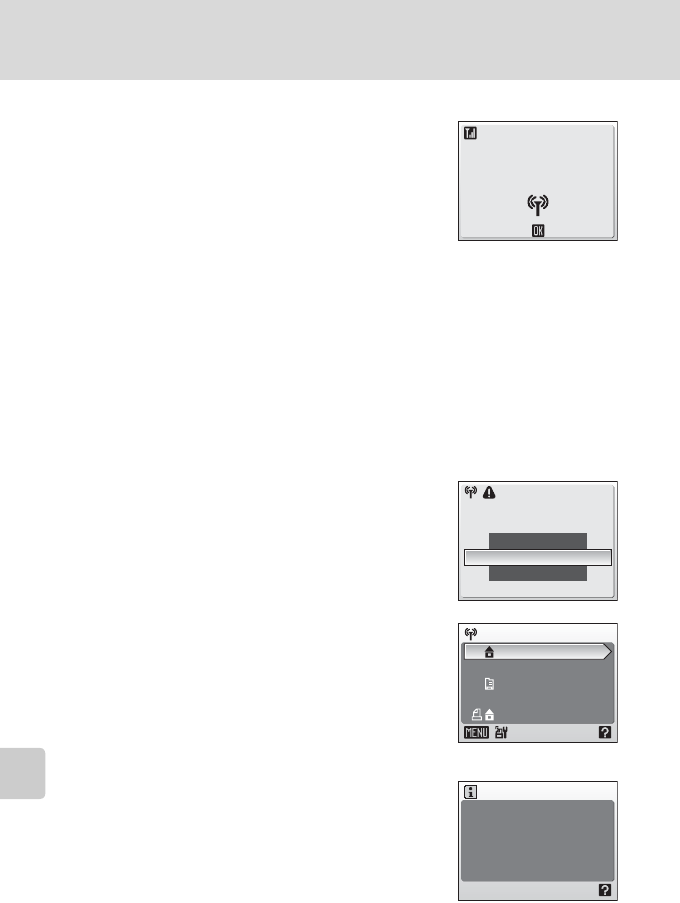
144
Transferring Pictures
Wireless Transfer Mode
When Transfer is Complete
The message shown at right is displayed when the
transfer is complete.
• To repeat the transfer, press d.
• To exit wireless transfer mode, press D and
choose another mode, or turn off the camera.
kWireless Transfer LED
The wireless transfer LED (c6) is located on the side of the camera (inside the antenna). The
camera is searching for profiles when the LED blinks, a wireless connection is established
when the LED is lit, and the camera is disconnected from a wireless LAN when the LED is off.
If transfer is not performed for a while, the LED may blink to save power.
kNote on Wireless Transfer Mode
The camera strap eyelet may become hot during wireless communication (i.e., when the wire-
less transfer LED is lit or is blinking). Observe due caution when handling the camera.
kThe Memory Card Write-Protect Switch
When the memory card write-protect switch is in the “lock” position, transfer cannot be per-
formed. Unlock by sliding the switch to the “write” position before transferring pictures.
kWhen the Transfer is Unsuccessful
When transfer is unsuccessful, the next time you attempt
transfer, the confirmation dialog shown at right will be dis-
played. If necessary, you can change profiles from the confir-
mation dialog. Complete transfer, making sure that it was
successful.
kSelecting a Computer or Printer
When the selected SSID has multiple computers or printers
registered, the screen shown at right will be displayed after
step 3 (c143). Select the desired computer or printer.
kChecking SSID Contents
Pressing the zoom control to v(l) in the SSID selection screen
displays the information for the selected profile including the
network name (SSID), type of computer and printer.
Mail sent. Closed
connection to
alias.
Select SSID
Resume interrupted transfer?
Yes
Change SSID
No
Choose profile
Profile-A
Profile-B
Profile-C
SSID: My Network
TYPE: Home SSID
Profile: Profile-A
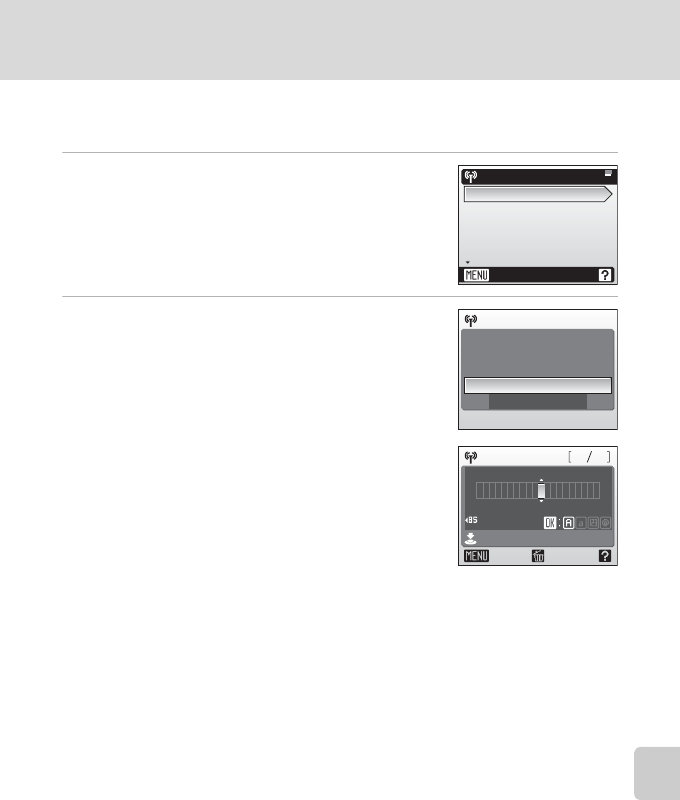
145
Transferring Pictures
Wireless Transfer Mode
Uploading Pictures to COOLPIX CONNECT
To use COOLPIX CONNECT, perform the following procedures.
1Choose [COOLPIX CONNECT] in step 3 of
“Establishing a Wireless Connection”
(c143) and press d.
2Enter your e-mail address correctly.
Choose [Input] in the sender information entry screen
and press d.
Enter your e-mail correctly in the address screen and
press the shutter-release button. Then enter your
(sender) name for the notification e-mail to recipients
and press the shutter-release button. For information
on how to enter characters, see “Entering Characters
on the Camera” (c148).
Function selection menu
COOLPIX CONNECT
Easy Transfer (PM)
Easy Trans. (no PM)
Shooting date
Selected Images
Back
Enter your alias and
email address
Input
Cancel
Enter sender info
Email
Confirm
Back Delete
xxx xxx. xxx
@
6411
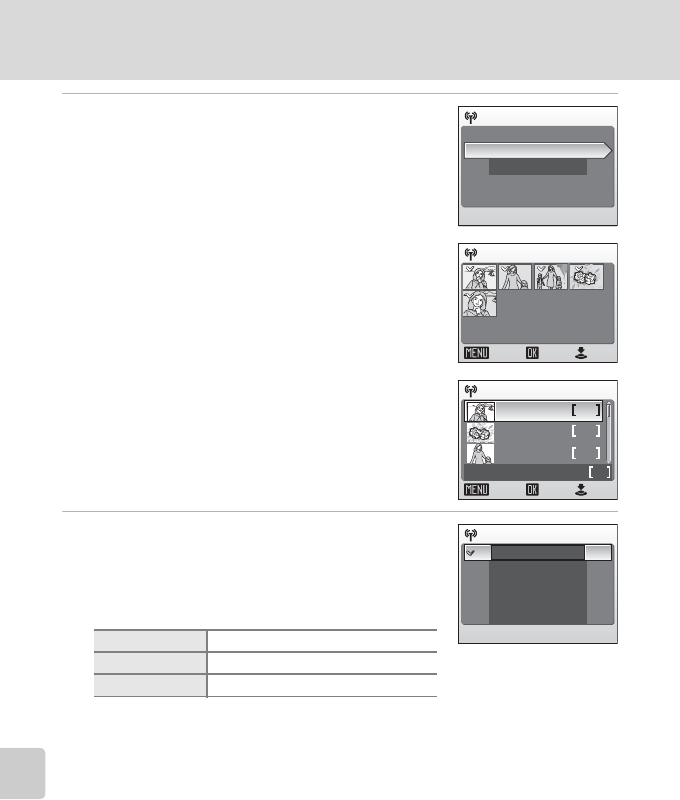
146
Transferring Pictures
Wireless Transfer Mode
3Choose [All images] or [Choose date]
and press d.
When choosing [All images], select the desired pic-
tures (up to 30) and press d to mark. Then press the
shutter-release button to apply selection.
When choosing [Choose date], select the shooting
date and press d to mark. Then press the shutter-
release button.
Select the desired pictures (up to 30) and press d to
mark. Then press the shutter-release button to apply
selection.
4Choose the size for the pictures to be
transferred and press the shutter release
button.
Choose the size for the pictures to upload and press
d to mark.
Photoprint 1,600 × 1,200 pixels
PC size 1,024 × 768 pixels
TV size 640 × 480 pixels
All images
Choose date
Picture selection
Select image
Confirm
ON/OFF
Back
5/30
Choose date
Confirm
images total
ON/OFF
10.10.2006 3
2
5
5
09.10.2006
08.10.2006
Back
Choose size
Photoprint
PC size
TV size
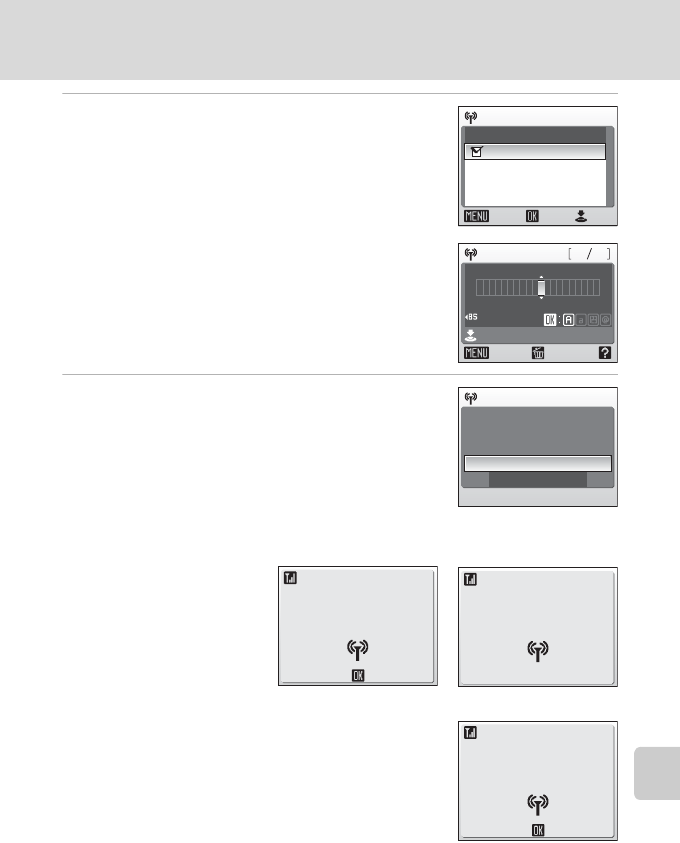
147
Transferring Pictures
Wireless Transfer Mode
5Choose recipient e-mail address and
press the shutter-release button.
Choose e-mail address and press d to mark.
Choose [New] and press d to add recipients. Enter e-
mail address correctly in the address screen and press
the shutter-release button. For information on how to
enter characters, see “Entering Characters on the
Camera” (c148).
6Choose [Yes] and press d.
The screens for connecting to the access point and connecting to the wireless LAN
will be displayed in order. To cancel transfer, press d.
When the transfer is complete, the message shown at
right will be displayed.
Choose address
New
Confirm
ON/OFF
Back
xxx xxx. xxx
@
Email
Confirm
Back Delete
xxx xxx. xxx
@
6411
Send mail?
Yes
No
Send mail
Cancel
Connecting to access point
Connecting to server
Mail sent. Closed
connection to
alias.
Select SSID
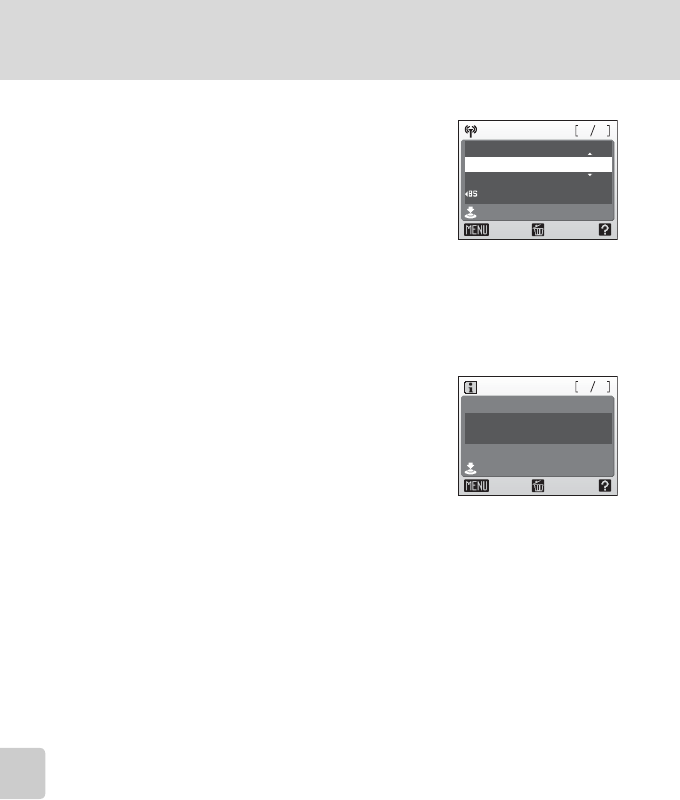
148
Transferring Pictures
Wireless Transfer Mode
jEntering Characters on the Camera
When using COOLPIX CONNECT service, you can set profiles
with the camera, without using the Setup Utility. From the
camera you can enter characters for information such as the
e-mail address (up to 64) and its (sender) name (up to 16), user
ID and password.
• Rotate the rotary multi selector clockwise to enter characters
(A to Z) in alphabetical order, or counterclockwise to enter in
reverse order.
• Press the rotary multi selector J to move the cursor right.
• Press the rotary multi selector I to move the cursor left. Press T to delete all the charac-
ters entered up to the cursor.
•Press d to change the character type in the following order: uppercase characters →
lowercase characters → numbers → symbols → uppercase characters, and so on.
• Press the shutter-release button to apply selection and return to the previous screen.
• Press the zoom control to v (l) to preview the entered
characters. Press m to return to the previous screen.
lEditing Recipient’s E-mail Address
• Using the Setup Utility to enter or edit e-mail addresses is easier. You can also enter or edit
a nickname for an e-mail address using the Setup Utility, making it easier to choose desti-
nations on the camera.
• To edit nicknames and e-mail addresses, connect the computer and camera, turn on the
camera, and start the Setup Utility. Then, choose [Edit address book] in the action selection
screen, and click [Next].
• Choose [Reset camera] in the action selection screen to clear all address book contents (all
profiles are also deleted).
WEP key
Confirm
Back Delete
ABCDEFGHIJKLMNOPQRS
2626
WEP key
Confirm
Back Delete
ABCDEFGHIJKLMNOPQAB
CDEF
2626
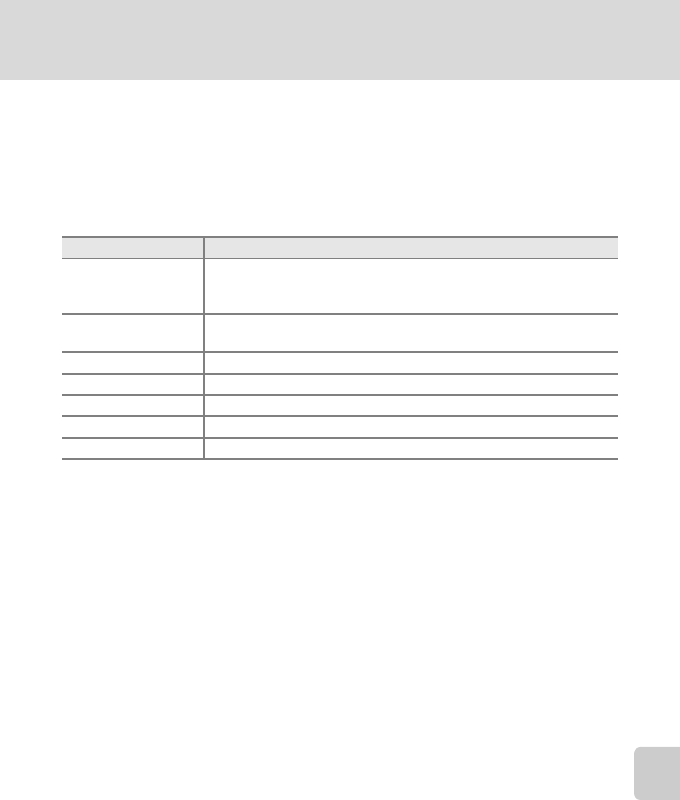
149
Transferring Pictures
Wireless Transfer Mode
Transferring Pictures to a Computer (PC Connection)
The following transfer method can be selected in step 3 of “Establishing a
Wireless Connection” (c143):
• Highlight an option and press d. The message “Connecting to (profile
name)” will be displayed while the camera connects.
• To exit before a connection is established, press d again.
Function selection menu
Description
Easy Transfer
(PM)
Transfer pictures and Pictmotion movies not yet saved in the
computer. Pictmotion movies take time to transfer and cannot
be transferred from a Macintosh.
Easy Trans.
(no PM)
Transfer pictures not yet saved in the computer. Pictmotion
movies cannot be transferred.
Shooting date Transfer all pictures taken on a specific recording date.
Selected Images Transfer only selected pictures.
Shoot & Transfer Immediately transfer taken pictures.
Marked images Transfer pictures with a E (transfer) icon (c112).
PC mode Transfer pictures to a profile device using a computer.
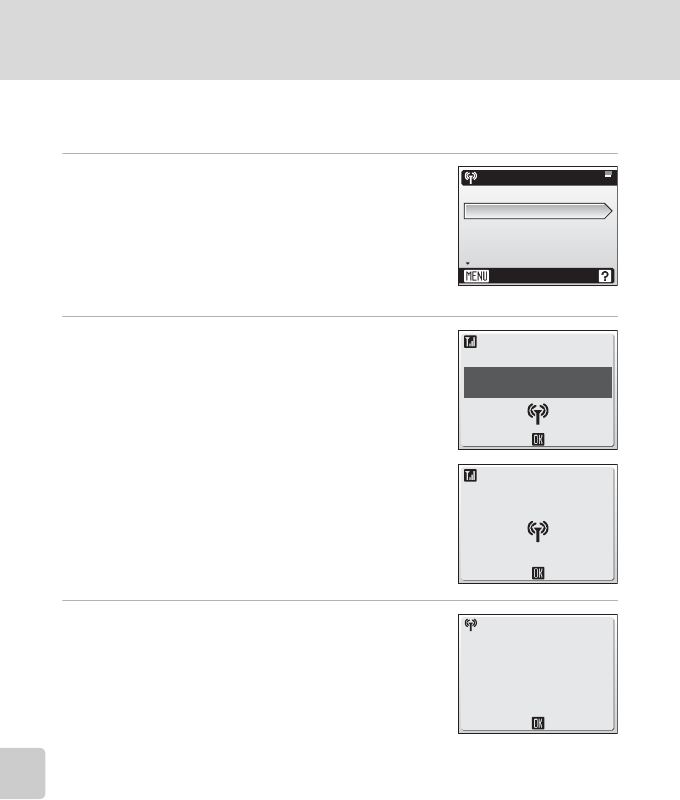
150
Transferring Pictures
Wireless Transfer Mode
Transferring Pictures Not Yet Saved on a Computer -
Easy Transfer
1Use the rotary multi selector to choose
[Easy Transfer (PM)] or [Easy Trans. (no
PM)] in step 3 of “Establishing a Wireless
Connection” (c143) and press d.
When multiple computers are set as profiles for the
infrastructure network, the profile selection screen is
displayed. Choose a profile and press d.
2Transfer pictures.
Pictures not yet saved on the computer will be trans-
ferred after the camera and computer are connected.
3When transfer is complete, press d to
return to the SSID selection menu.
To end wireless transfer mode, see “When Transfer is
Complete” (c144).
Function selection menu
COOLPIX CONNECT
Easy Transfer (PM)
Easy Trans. (no PM)
Shooting date
Selected Images
Back
Cancel
My Network
Connecting to
Profile-A
Cancel
0002
/
0004
Transferring images
to computer
Select SSID
Transfer completed.
Connection terminated.
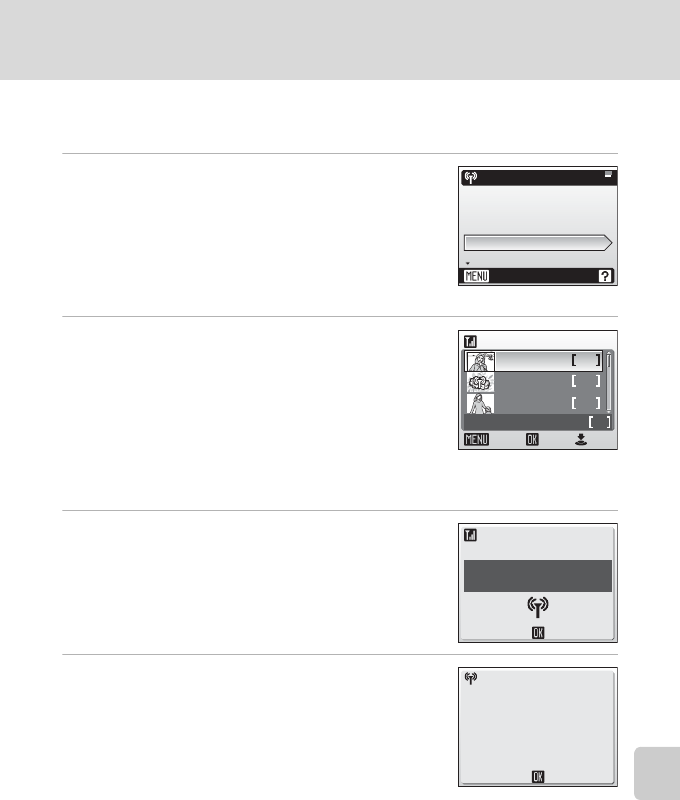
151
Transferring Pictures
Wireless Transfer Mode
Transferring Pictures Taken on Selected Date - Shooting
Date
1Use the rotary multi selector to choose
[Shooting date] in step 3 of “Establishing
a Wireless Connection” (c143) and
press d.
When multiple computers are set as profiles for the
infrastructure network, the profile selection screen is
displayed. Choose a profile and press d.
2Select the shooting date.
The shooting date menu will be displayed.
• Select the desired shooting date and press J to
apply selection. Multiple shooting dates can be
selected.
• The selected shooting date will be marked with the
n (wireless transfer) icon. Press J again to cancel
the selection (the n icon will disappear).
• Press d to complete selection.
3Transfer pictures taken on the selected
dates.
4When transfer is complete, press d to
return to the SSID selection menu.
To end wireless transfer mode, see “When Transfer is
Complete” (c144).
jNote on Transferring Pictures with [Shooting Date]
Pictures taken without the date and time set (c20, 117) cannot be chosen for transfer with
[Shooting date].
Function selection menu
COOLPIX CONNECT
Easy Transfer (PM)
Easy Trans. (no PM)
Shooting date
Selected Images
Back
Shooting date
Confirm
ON/OFF
10.10.2006 3
2
5
09.10.2006
08.10.2006
End
images total
5
Cancel
My Network
Connecting to
Profile-A
Select SSID
Transfer completed.
Connection terminated.
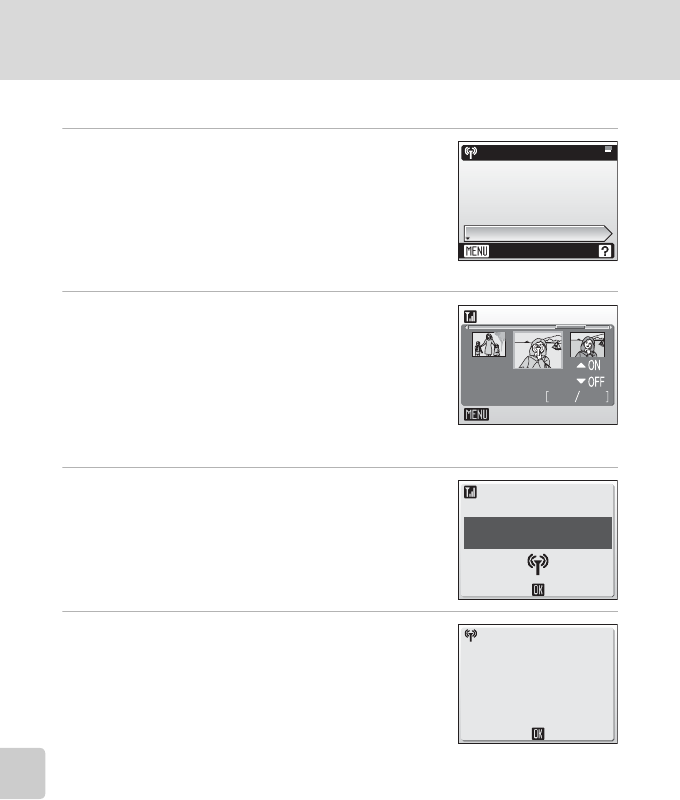
152
Transferring Pictures
Wireless Transfer Mode
Transferring Selected Pictures - Selected Images
1Use the rotary multi selector to choose
[Selected Images] in step 3 of “Establish-
ing a Wireless Connection” (c143) and
press d.
When multiple computers are set as profiles for the
infrastructure network, the profile selection screen is
displayed. Choose a profile and press d.
2Select the pictures to transfer.
The selected images menu will be displayed.
• Select the pictures to transfer and press G to apply
selection. Multiple pictures can be selected.
• The selected picture will be marked with the n
icon. Press H to cancel the selection (the n icon
will disappear).
• Press d to complete selection.
3Transfer the selected pictures.
4When transfer is complete, press d to
return to the SSID selection menu.
To end wireless transfer mode, see “When Transfer is
Complete” (c144).
jNote on the n icon
The n icon displayed in step 2 will disappear once transfer is complete (picture selection is
cleared each time transfer is completed).
Function selection menu
COOLPIX CONNECT
Easy Transfer (PM)
Easy Trans. (no PM)
Shooting date
Selected Images
Back
Selected Images
End
43
01.12.2006
12:00
Cancel
My Network
Connecting to
Profile-A
Select SSID
Transfer completed.
Connection terminated.
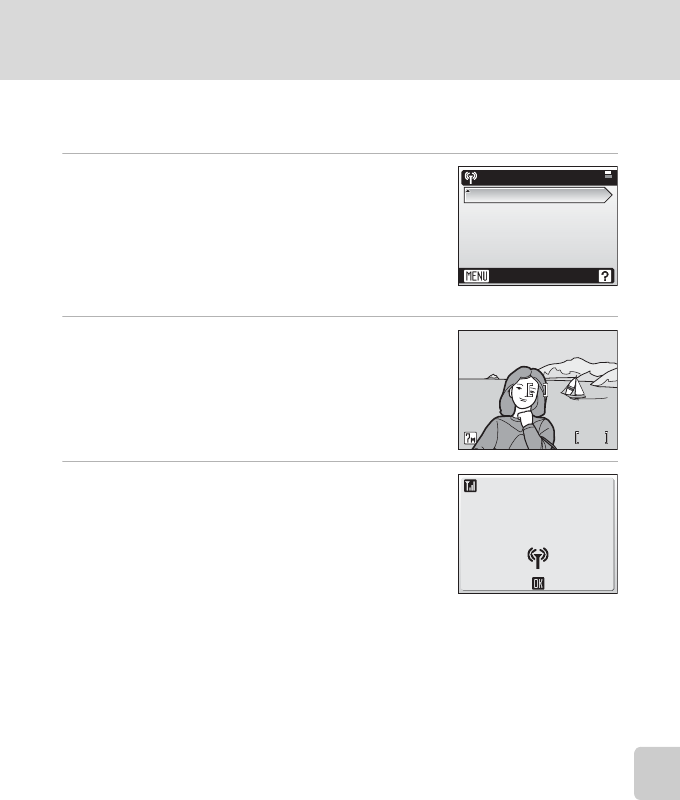
153
Transferring Pictures
Wireless Transfer Mode
Immediately Transferring Pictures Taken - Shoot &
Transfer
1Use the rotary multi selector to choose
[Shoot & Transfer] in step 3 of “Establish-
ing a Wireless Connection” (c143) and
press d.
When multiple computers are set as profiles for the
infrastructure network, the profile selection screen is
displayed. Choose a profile and press d.
2Enter shooting mode.
The shooting screen will be displayed.
• The camera enters L (auto) mode automatically.
• Press m in the shooting screen, and the shoot
and transfer menu will be displayed.
3Take a picture.
The just-taken picture will be transferred to the com-
puter. The camera returns to shooting mode (screen
in step 2) after transfer is complete. Note that pic-
tures cannot be taken while pictures are being trans-
ferred.
• If a confirmation dialog is displayed, select [Yes] to
transfer the picture. To cancel the transfer, select [No].
Function selection menu
Shoot & Transfer
Marked images
PC mode
Wireless Printing
Back
88
MM
M
Cancel
Transferring images
to computer
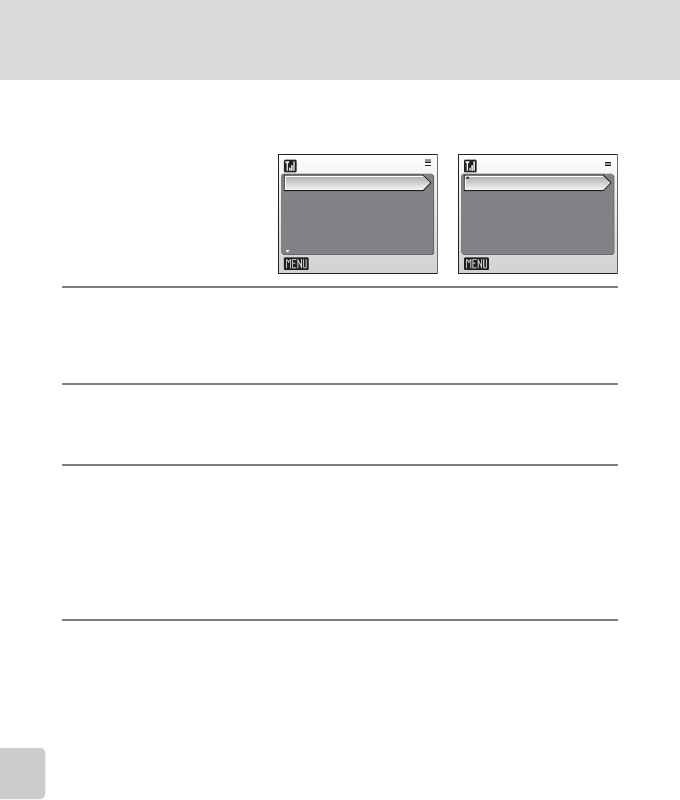
154
Transferring Pictures
Wireless Transfer Mode
lChanging Settings for Shoot and Transfer
Press m in the shooting screen (for shoot and transfer) and the shoot and transfer menu
will be displayed.
lSaving Pictures
If a communication error occurs while performing [Shoot & Transfer] with [Save Images] set to
[Off], pictures taken are not saved. When taking pictures for important occasions, setting
[Save Images] to [On] is recommended.
Confirm Transfer Off (default) Immediately transfers pictures taken to the com-
puter.
On
Displays a confirmation dialog prompting
whether to transfer pictures taken to the com-
puter each time a picture is taken.
Save Images Off (default)
Saves the picture taken only on the computer and
not to the internal memory or on the memory card.
On Saves the picture taken to the internal memory or
on the memory card.
Image Mode c97
White Balance c99
Exp. +/– c101
ISO Sensitivity c105
Color Options c105
AF Area Mode c106
Shoot & Transfer
Confirm Transfer
Save Images
Image mode
White balance
Exp. +/-
Exit
Shoot & Transfer
ISO sensitivity
Color options
AF area mode
Exit
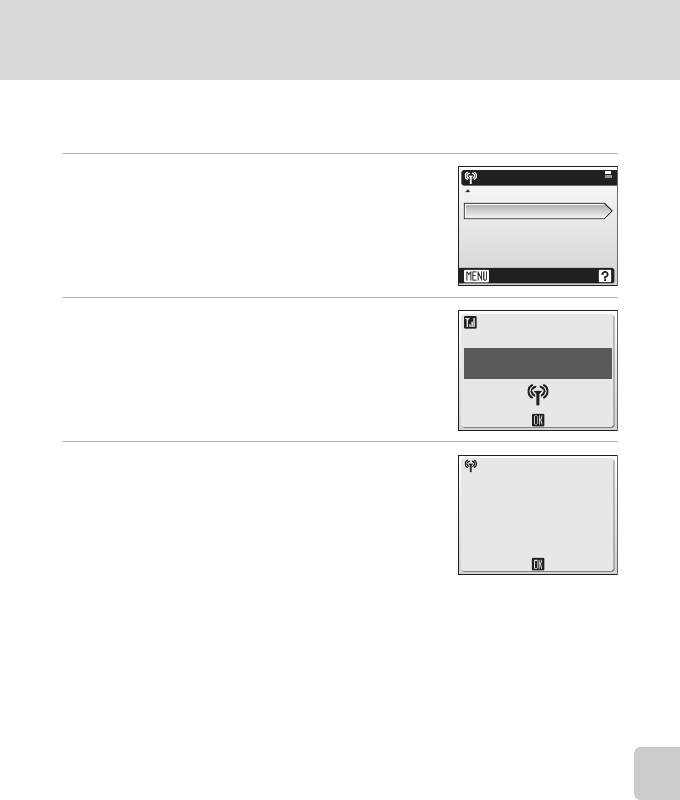
155
Transferring Pictures
Wireless Transfer Mode
Transferring Pictures Marked with the Transfer Icon -
Marked Images
1Use the rotary multi selector to choose
[Marked images] in step 3 of “Establish-
ing a Wireless Connection” (c143) and
press d.
2Transfer pictures.
Pictures marked with the g (transfer) icon (c112)
will be transferred.
3When transfer is complete, press d to
return to the SSID selection menu.
To end wireless transfer mode, see “When Transfer is
Complete” (c144).
Function selection menu
Shoot & Transfer
Marked images
PC mode
Wireless Printing
Back
Cancel
My Network
Connecting to
Profile-A
Select SSID
Transfer completed.
Connection terminated.
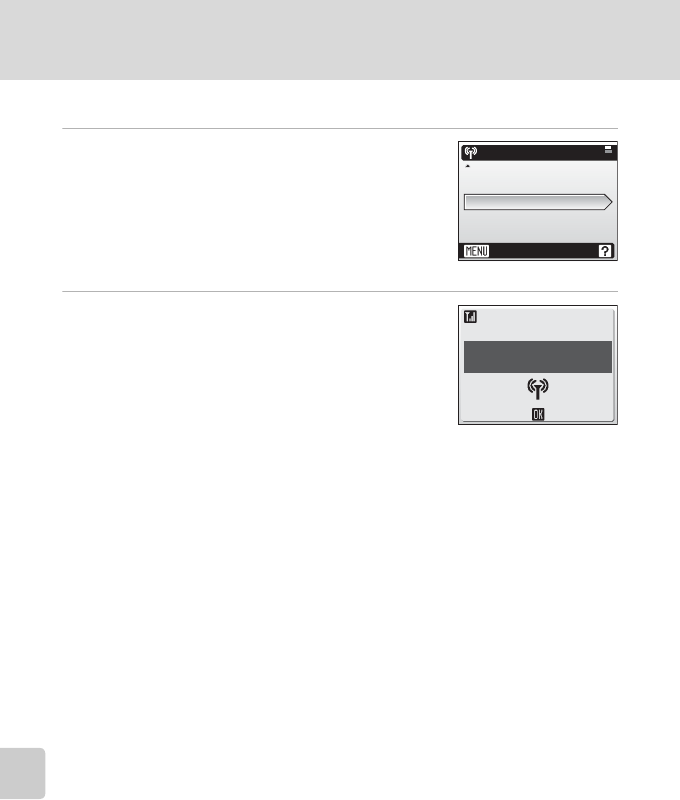
156
Transferring Pictures
Wireless Transfer Mode
Transferring Pictures Using a Computer - PC Mode
1Use the rotary multi selector to choose
[PC mode] in step 3 of “Establishing a
Wireless Connection” (c143) and press
d.
When multiple computers are set as profiles for the
infrastructure network, the profile selection screen is
displayed. Choose a profile and press d.
2Connect the camera to a computer.
The camera and computer will be connected.
• When the selected computer has PictureProject
installed, it will be launched automatically. To
transfer pictures, click the [Transfer] button in
PictureProject Transfer. See the PictureProject Ref-
erence Manual (on CD) for details.
• When the selected computer does not have PictureProject installed, drag and
drop pictures from the camera displayed on the computer.
• Pictmotion movies can be transferred (Windows only).
Function selection menu
Shoot & Transfer
Marked images
PC mode
Wireless Printing
Back
Select SSID
My Network
Connected to
Profile-A
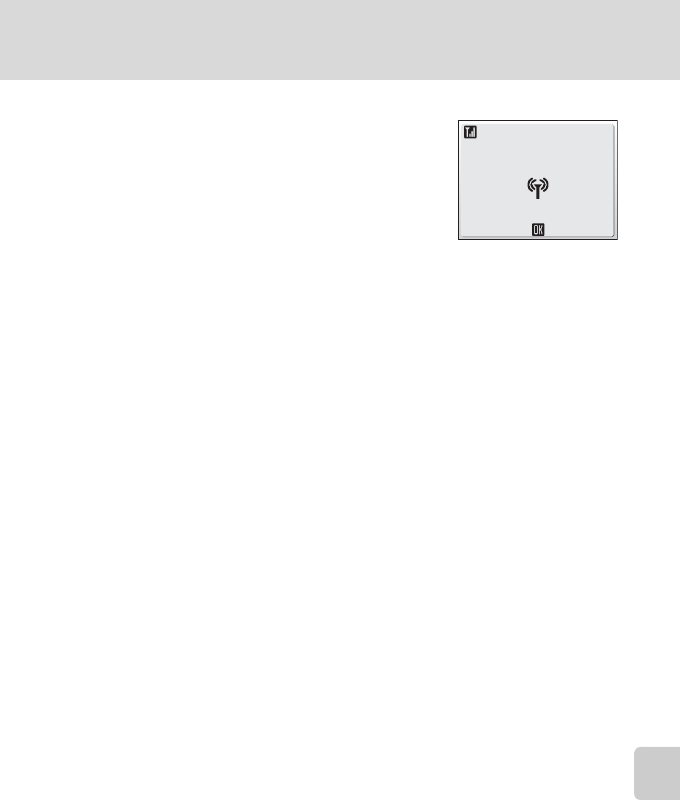
157
Transferring Pictures
Wireless Transfer Mode
jMessage Displayed During Transfer
The message shown at right is displayed in the monitor during
picture transfer. The antenna icon indicates signal strength
(5-levels). The icon changes to red when outside the network
area. When signal strength is poor, remove any obstacles
between the camera antenna and computer (or access point).
To cancel the current transfer, press d.
jNote on the Camera’s d (E) Button
Pictures marked with the E icon cannot be transferred in wireless transfer mode using the
camera’s d (E) button.
lSave Location of Transferred Images
• Pictures transferred to the computer are saved to the following location.
Windows XP: [Wireless Transfer] folder in [My Pictures] folder
Macintosh: [Wireless Transfer] folder in [Picture] folder
• A destination folder can be changed using the Setup Utility. Choose [Select destination
folder] in the screen in step 6 (c137) and choose a destination folder. Connection
between the camera and a computer is not necessary for this operation.
• When pictures are transferred wirelessly to a computer that has PictureProject installed, in
modes other than [PC mode], PictureProject automatically starts and the transferred pic-
tures will be displayed. Note that the save location can be changed.
• For computers without PictureProject installed, Explorer (for Windows) or Finder (for Macin-
tosh) starts and the save location will be displayed. Note that the save location cannot be
changed.
• If the camera is connected to a computer in [PC mode] without PictureProject installed,
drag and drop pictures from the camera icon or drive displayed on the computer to the
desired save location.
Cancel
0002
/
0004
Transferring images
to computer
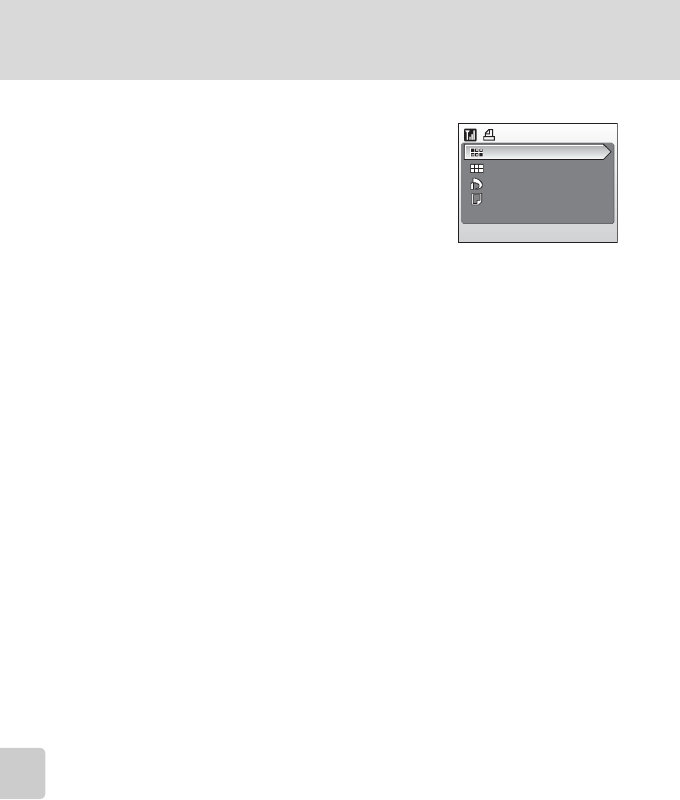
158
Transferring Pictures
Wireless Transfer Mode
Printing Pictures (Wireless Printing)
After selecting a profile or selecting [Function selec-
tion menu] > [Wireless Printing], press d. The wire-
less printing menu is displayed.
To select multiple pictures and print, perform the
same procedures as for direct printing (c90).
lSwitching the Printer
When using multiple printers, the printer can be switched by using the Setup Utility. Start the
Setup Utility and choose [Select printer] in the action selection screen. Connecting the com-
puter and camera is not necessary for switching the printer.
lThe PD-10 Wireless Printer Adapter
To print pictures without connecting the printer to a computer, connect the PD-10 wireless
printer adapter (available separately) (c133) to any PictBridge-compatible printer with a type
A (flat) USB connector.
When printing pictures via the PD-10 for the first time, display the profile list by following the
procedures in “Establishing a Wireless Connection” (c143), and then follow the steps
below:
1. Connect the PD-10 to the printer, turn on the printer and press the START button on the
PD-10.
2. Make sure that the LINK lamp on the PD-10 has turned greenish-yellow.
3. Press the camera’s m button. The message “Connecting to wireless printer adapter” will
be displayed. Set up profiles on the camera and PD-10 as described in the PD-10 instruction
manual, starting from step 3.
Once the profile is stored in the camera, pictures can be printed directly by selecting the PD-
10 in the profile list and pressing d.
For more information, consult the PD-10 instruction manual.
Wireless Printing
Print all images
Print selection
Paper size
DPOF printing

159
Technical Notes
Technical Notes
Optional Accessories
Approved Memory Cards
The following memory cards have been tested and approved for use in the
COOLPIX S7c:
* Cards rated for 10 MB/s (high speed)
Other cards have not been tested. For more details on the memory cards
listed above, please contact the manufacturer.
Rechargeable bat-
tery
Nikon EN-EL8 rechargeable lithium-ion battery
Battery charger MH-62 battery charger
AC adapter EH-64 AC adapter
Cradle MV-15 COOL-STATION
ImageLink-compati-
ble printer adapter
PV-11 dock insert
USB cable UC-E10 USB cable
A/V cable EG-E5000 audio/video cable
Wireless printer
adapter
PD-10 wireless printer adapter
SanDisk 64 MB, 128 MB, 256 MB, 512 MB, 1 GB, 256 MB*,
512 MB*, 1 GB*
Toshiba 64 MB, 128 MB, 256 MB, 512 MB, 1 GB, 128 MB*,
256 MB*, 512 MB*
Panasonic 64 MB, 128 MB, 256 MB, 512 MB, 1 GB, 256 MB*,
512 MB*, 1 GB*
Nikon 1GB*
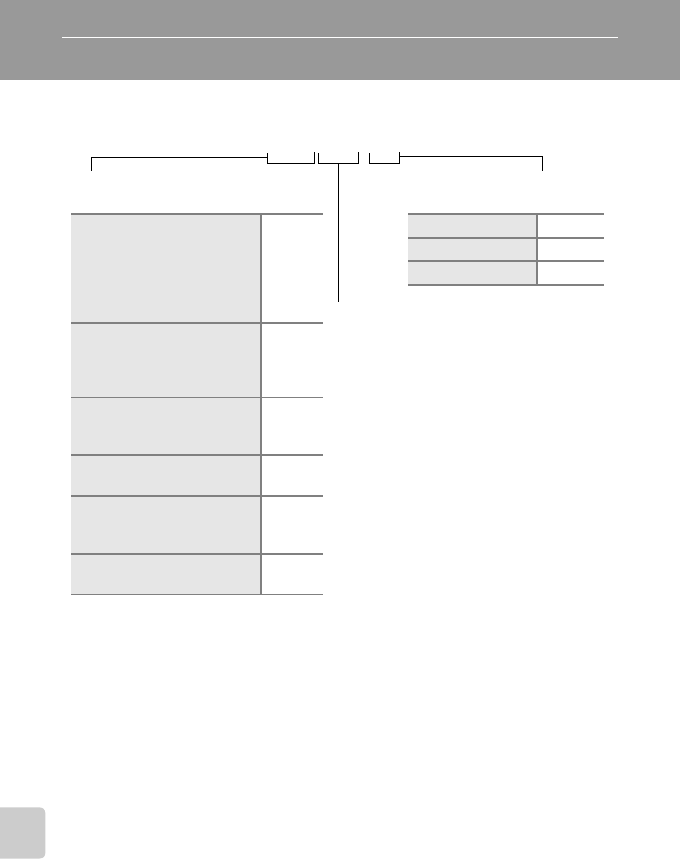
160
Technical Notes
Image File and Folder Names
Pictures, movies, and voice memos are assigned file names as follows:
• Files are stored in folders named with a folder number followed by a five-
character identifier: “P_” plus a three-digit sequence number for pictures
taken using panorama assist (e.g., “101P_001”; c47), “INTVL” for inter-
val timer photography (e.g., “101INTVL”; c103), “SOUND” or “SOUNE”
for voice recordings (e.g., “101SOUND”; c77), and “NIKON” for all
other pictures (e.g., “100NIKON”). When the number of files within a
folder reaches 9999, a new folder will be created. File numbers will be
assigned automatically starting with “0001”.
DSCN0001.JPG
Identifier
(not shown on camera monitor)
Original still pictures
(voice memo attachment
included), still pictures
for which electronic VR
was used during shoot-
ing, movies, voice memos
DSCN
Pictures compensated in
electronic VR (voice
memo attachment
included)
VSCN
Cropped copies (voice
memo attachment
included)
RSCN
Small copies (voice memo
attachment included) SSCN
D-Lighting copies (voice
memo attachment
included)
FSCN
Time-lapse or stop-
motion movies INTN
Extension
(signifies the file type)
Still picture .JPG
Movie .MOV
Voice memo .WAV
File number
(assigned automatically in ascending
order, starting with “0001”)

161
Image File and Folder Names
Technical Notes
• Files copied using [Copy] > [Selected images] or [Copy sound files] >
[Selected files] are copied to the current folder, where they are assigned
new file numbers in ascending order starting from the largest file number
in memory. [Copy] > [All images] and [Copy sound files] > [Selected files]
copy all folders from the source medium; file names do not change but
new folder numbers are assigned in ascending order starting from the
largest folder number on the destination medium (c113).
• Pictmotion movies (c65) are stored under the “NKSS” folder in folders
named with a three-digit folder number followed by “PRJCT” (e.g.,
“101PRJCT”). Each folder contains the picture and sound files for a single
Pictmotion movie.
• Folders can hold up to 200 pictures; if a picture is taken when the current
folder contains 200 pictures, a new folder will be created by adding one to
the current folder number. If a picture is taken when the current folder is
numbered 999 and contains 200 pictures or a picture numbered 9999, no
further pictures can be taken until the medium is formatted (c125) or a
new memory card inserted.
• Files for pictures taken when [Off] is selected for [Shoot & Transfer]
(c153) > [Save Images] in wireless transfer mode are named with the
four-digit identifier “STCN” and four-sequence numbers (e.g.,
“STCN0001.JPG”).

162
Technical Notes
Caring for the Camera
To ensure continued enjoyment of this Nikon product, observe the following
precautions when using or storing the device.
jKeep dry
The device will be damaged if immersed in water or subjected to high humidity.
jDo not drop
The product may malfunction if subjected to strong shock or vibration.
jHandle the lens and all moving parts with care
Do not apply force to the lens, lens cover, monitor, memory card slot, or battery chamber.
These parts are easily damaged. Applying force to the lens cover could result in camera mal-
function or damage to the lens. Should the monitor break, care should be taken to avoid
injury caused by broken glass and to prevent the liquid crystal from the display touching the
skin or entering the eyes or mouth.
jDo not point the lens at strong light sources for extended periods
Avoid pointing the lens at the sun or other strong light sources for extended periods when
using or storing the camera. Intense light may cause deterioration of the CCD image sensor,
producing a white blur effect in photographs.
jKeep away from strong magnetic fields
Do not use or store this device in the vicinity of equipment that generates strong electromag-
netic radiation or magnetic fields. Strong static charges or the magnetic fields produced by
equipment such as radio transmitters could interfere with the monitor, damage data stored
on the memory card, or affect the product’s internal circuitry.
jAvoid sudden changes in temperature
Sudden changes in temperature, such as occur when entering or leaving a heated building on
a cold day, can cause condensation to form inside the device. To prevent condensation, place
the device in a carrying case or a plastic bag before exposing it to sudden changes in temper-
ature.
jTurn the product off before removing or disconnecting the power
source
Do not remove the battery while the product is on, or while images are being recorded or
deleted. Forcibly cutting power in these circumstances could result in loss of data or in dam-
age to product memory or internal circuitry.

163
Caring for the Camera
Technical Notes
jThe AF-Assist Illuminator LED
The light-emitting diode (LED; c6, 123) used in the AF-
assist illuminator conforms to the following IEC standard:
kThe Battery
• Check the battery level when taking the camera out and charge the battery if necessary
(c18). Do not continue charging once the battery is fully charged, as this will result in
reduced battery performance. If possible, carry a fully charged spare battery when taking
pictures on important occasions.
• Do not use the battery at ambient temperatures below 0 °C (32 °F) or above 40 °C
(104 °F). During charging, the temperature should be in the vicinity of 5 to 35 °C (41 to
95 °F). Note that the battery may become hot during use; wait for the battery to cool
before charging. Failure to observe these precautions could damage the battery, impair its
performance, or prevent it from charging normally.
• On cold days, the capacity of batteries tends to decrease. Be sure that the battery is fully
charged before heading outside to take pictures in cold weather. Keep spare batteries in a
warm place and exchange as necessary. Once warmed, a cold battery may recover some of
its charge.
• Dirt on the battery terminals can prevent the camera from functioning.
• When the battery is not in use, remove it from the camera or battery charger and replace
the terminal cover. The camera and battery charger draw minute amounts of current even
when off; if left in place, the battery could be drained to the point that it no longer func-
tions. Turning the camera on or off while the battery is exhausted can result in reduced bat-
tery life. If the battery will not be used for an extended period, store it in a cool (15 to
25 °C / 59 to 77 °F), dry place. Recharge it at least once a year and run it flat before return-
ing it to storage.
• Replace the battery when it no longer holds a charge. Used batteries are a valuable
resource. Please recycle used batteries in accordance with local regulations.
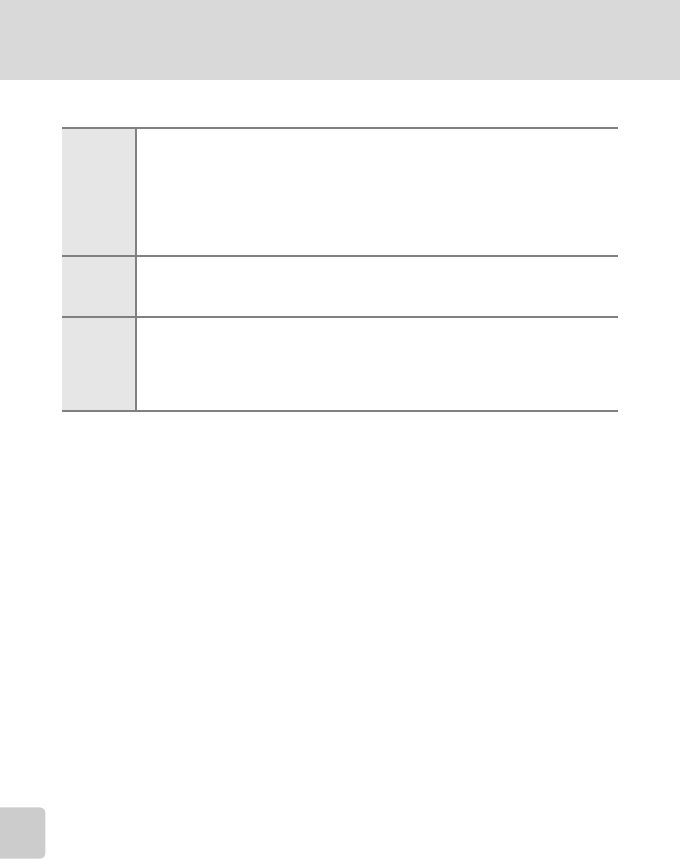
164
Caring for the Camera
Technical Notes
Cleaning
Do not use alcohol, thinner, or other volatile chemicals.
Storage
Turn the camera off when not in use. Check that the power-on lamp is off
before putting the camera away. Remove the battery if the camera will not
be used for an extended period. Do not store the camera with naptha or
camphor moth balls or in locations that:
• are next to equipment that produces strong electromagnetic fields, such as
televisions or radios
• are exposed to temperatures below –10 °C (14 °F) or above 50 °C (122 °F)
• are poorly ventilated or subject to humidities of over 60%
To prevent mold or mildew, take the camera out of storage at least once a
month. Turn the camera on and release the shutter a few times before put-
ting the camera away again.
kNotes on the Monitor
• The monitor may contain a few pixels that are always lit or that do not light. This is a char-
acteristic common to all TFT LCD displays, and does not indicate a malfunction. Images
recorded using the product will not be affected.
• When framing bright subjects, vertical comet-like streaks that whiten toward either end
may appear in the display. This phenomenon, known as “smear,” does not appear in the
final photograph and does not indicate a malfunction. Some smear may appear in movies.
• Images in the monitor may be difficult to see under bright lighting.
• The monitor is lit by an LED backlight. Should the monitor begin to dim or flicker, contact
your Nikon service representative.
Lens
Avoid touching glass parts with your fingers. Remove dust or lint with a
blower (typically a small device with a rubber bulb attached to one end
that is pumped to produce a stream of air out the other end). To remove
fingerprints or other stains that cannot be removed with a blower, wipe
the lens with a soft cloth, using a spiral motion that starts at the center of
the lens and working toward the edges. If this fails, clean the lens using a
cloth lightly dampened with commercial lens cleaner.
Monitor
Remove dust or lint with a blower. To remove fingerprints and other
stains, clean the monitor with a soft, dry cloth, being careful not to apply
pressure.
Body
Use a blower to remove dust, dirt, or sand then wipe gently with a soft,
dry cloth. After using the camera at the beach or seaside, wipe off any
sand or salt with a dry cloth lightly dampened with fresh water, then dry
thoroughly. Note that foreign matter inside the camera could cause dam-
age not covered by the warranty.

165
Technical Notes
Error Messages
The following table lists the error messages and other warnings displayed in
the monitor, as well as the solutions for dealing with them.
Display Problem Solution c
S (blinks) Clock not set. Set clock. 117
wBattery running low. Prepare to charge or
change battery.
14
Warning!
Battery exhausted
w
Battery exhausted. Charge or change bat-
tery.
14
p (● blinks red) Camera cannot focus. • Refocus.
• Use focus lock.
28, 29,
106
Warning!!
please wait for the
camera to finish
recording
y
Camera cannot perform
other operations until
recording is complete.
Message clears from dis-
play automatically when
recording is complete.
–
Memory card is write
protected.
x
Write-protect switch is in
“lock” position.
Slide write-protect to
“write” position.
23
No card present Pictmotion mode
selected when no mem-
ory card is inserted.
Insert memory card. 22
This card cannot be
used
x
Error accessing memory
card.
• Use approved card.
• Check that connectors
are clean.
• Confirm that memory
card is correctly
inserted.
159
22
22
Warning!
This card cannot be
read
O
Card is not format-
ted
O
Format
No
Memory card has not
been formatted for use in
camera.
Choose [Format] and
press d to format card,
or turn camera off and
replace card.
23

166
Error Messages
Technical Notes
Out of memory
M or O
Memory card is full. •
Choose smaller image size.
• Delete pictures or
sound files.
•
Insert new memory card.
•
Remove memory card
and use internal memory.
97
23, 76,
80
22
23
Image cannot be
saved
M or O
Error occurred while
recording picture.
Format internal memory
or memory card.
125
Camera has run out of
file numbers.
• Insert new memory
card.
• Format internal mem-
ory or memory card.
22
125
Cannot edit selected pic-
ture.
Select picture that sup-
ports crop D-Lighting or
small picture.
54
Picture cannot be used
for welcome screen.
Choose picture 640 ×
480 pixels or larger.
–
Cannot copy picture. Delete pictures from des-
tination.
111
Sound file cannot be
saved
M or O
Camera has run out of
file numbers.
Select [Reset all] after
either inserting new
memory card or format-
ting internal memory or
memory card.
22,
125,
127
Image has already
been modified.
D-Lighting cannot be
used.
u
Image cannot be
enhanced using
D-Lighting.
Copies from D-Lighting,
crop, or small picture
option cannot be
adjusted using
D-Lighting.
56
Cannot record
movie.
Time out error while
recording movie.
Choose memory card
with faster write speed.
159
Memory contains no
images
r
No pictures available for
playback.
––
No sound file. No sound file available
for playback.
––
Display Problem Solution c

167
Error Messages
Technical Notes
File contains no
image data
r
File not created with
COOLPIX S7c.
View file on computer or
other device.
–
This file cannot be
played back.
All images are hid-
den
Date and time are not set
for pictures to be dis-
played by calendar mode
or list-by-date mode.
––
Pictmotion cannot
be created.
Error occurred when cre-
ating Pictmotion movie.
Start creating Pictmotion
movie from the beginning.
65
Pictmotion cannot
be played back.
Pictmotion files have
been deleted or moved.
Delete affected Pictmo-
tion movie.
67
This image cannot be
deleted
r
Picture is protected. Disable protection. 111
New city is in the
current time zone
u
Destination in same time
zone as home.
– 119
Initializing lens.
Cannot focus.
y
Camera cannot focus.
Wait until message has cleared
from display and camera has
zoomed all the way out.
–
Lens error
u
Lens error. Turn camera off and then
on again. If error persists,
contact retailer or Nikon
representative.
24
Lens cover error Finger or other obstruc-
tion prevents lens cover
from opening.
Turn camera off and
remove obstruction.
4, 162
Cannot reduce blur. Image cannot be
enhanced by vibration
reduction.
• Picture is considerably
blurred
• Shutter speed too slow
•
Picture was taken with a dif-
ferent camera, with Multi-
shot 16, or with date imprint
•
Picture was taken imme-
diately after the camera
was turned on or reacti-
vated from standby mode
57
Display Problem Solution c

168
Error Messages
Technical Notes
This image has been
retouched. Cannot
retouch to reduce
blur.
Image cannot be com-
pensated using vibration
reduction.
Copies from small pic-
ture, crop, or vibration
reduction option cannot
be adjusted using vibra-
tion reduction.
57
Communications
error
E
USB cable disconnected
during transfer or print-
ing.
If PictureProject displays
error, click [OK] to exit.
Resume operation after
turning camera off and
reconnecting cable.
83, 88
[USB] option incorrect. Choose correct [USB]
option.
83, 84
PictureProject did not start.
––
No images are
marked for transfer
s
No pictures selected for
transfer.
Select pictures for trans-
fer in the playback menu
and try again.
86,
112
Transfer error
E
Transfer error. • Check battery level.
• Check that USB cable is
connected.
24
83
System error
u
Error has occurred in
camera’s internal cir-
cuitry.
Turn camera off, remove
and reinsert battery, and
turn camera on. If error
persists, contact retailer
or Nikon representative.
17, 24
Printer error
check printer status
u
Running out of ink or
printer error.
Check printer. After
checking the ink or solv-
ing the problem, select
[Resume] and press d to
resume printing.
(Depending on the error,
[Resume] may not be
available.)
–
Display Problem Solution c

169
Error Messages
Technical Notes
Wireless Transfer Mode
Display Problem Solution c
Transfer error Error during image trans-
fer.
Check signal strength.
Move the camera closer
to the profile device or
remove obstruction
between the camera and
device.
–
Profile not regis-
tered. Set up profile.
No profile devices are
configured for wireless
transfer.
Configure profile devices
using Wireless Camera
Setup Utility or PD-10
wireless printer adapter.
134,
158
Battery exhausted.
Transfer terminated.
Battery ran out during
image transfer.
Recharge battery, turn
camera on again and set
it to wireless transfer
mode.
18
Failed to connect to
(SSID/profile device)
Selected profile cannot
be used.
• IP address saved in the
camera may be incor-
rect. Confirm settings
using Wireless Camera
Setup Utility.
• Change firewall set-
tings.
134,
158

170
Error Messages
Technical Notes
Connection error. Wireless connection to
the profile was termi-
nated.
Check signal strength.
Move the camera closer
to the profile device or
remove obstruction
between the camera and
device.
–
User information
incorrect
Camera is not certified to
connect to the wireless
network.
Start Wireless Camera
Setup Utility, connect
camera and computer,
and reconfigure to con-
nect to the network.
134
Mailbox is full The online album is full. Delete unnecessary pic-
tures.
–
Service not available Cannot use COOLPIX
CONNECT network ser-
vice.
Start Wireless Camera
Setup Utility, connect
camera and computer,
and reconfigure to con-
nect to the network.
134
Display Problem Solution c

171
Technical Notes
Troubleshooting
If the camera fails to function as expected, check the list of common prob-
lems below before consulting your retailer or Nikon representative. Refer to
the page numbers in the right-most column for more information.
Display, Settings and Power Supply
Problem Cause/Solution c
Monitor is blank • Camera is off.
• Battery is exhausted.
• Standby mode for saving power: press
the shutter-release button halfway.
• Flash lamp blinks red: wait until flash
has charged.
• USB cable is connected.
• A/V cable is connected.
• Time lapse or interval timer photogra-
phy in progress.
24
24
25, 28
33
83
82
Monitor is hard to read • Adjust monitor brightness.
• Monitor is dirty. Clean monitor.
• Monitor has dimmed to save power.
Monitor brightens when controls are
used.
120
164
25
Camera turns off without warn-
ing
• Battery is low.
• Camera has turned off automatically
to save power.
• Battery is cold.
24
163
[Format memory] > [Format]
option not available
Battery is low. 24,
125
Camera clock is not correct • Clock battery exhausted: recharge
clock battery. Pictures recorded before
clock has been set will have time
stamp of “00.00.0000 00:00”; movies
will be dated “01.09.2006 00:00.”
• Check camera clock regularly against
more accurate timepieces and reset as
required.
20
117
No indicators displayed in moni-
tor
[Hide info] is selected for [Photo info].
Select [Show info].
120
[Date imprint] not available Camera clock has not been set. 20,
117

172
Troubleshooting
Technical Notes
Electronically Controlled Cameras
In extremely rare instances, unusual characters may appear in the monitor and the camera
may stop functioning. In most cases, this phenomenon is caused by a strong external static
charge. Turn the camera off, remove and replace the battery, and then turn the camera on
again. In the event of continued malfunction, contact your retailer or Nikon representative.
Note that disconnecting the power source as described above may result in the loss of any
data not recorded to internal memory or the memory card at the time the problem occurred.
Data already recorded will not be affected.
Shooting
Date not appearing on pictures
even when [Date imprint] is
enabled
Date does not appear on movies or on
pictures taken using P, N, F, [Contin-
uous], or when option other than [Off] is
selected for [BSS].
41, 45,
47, 70,
102,
104
Camera settings reset Backup battery is exhausted; all settings
were restored to their default values.
118
Problem Cause/Solution c
No picture taken when shutter-
release button is pressed
• Camera is in playback mode: press
o.
• Menus are displayed: press m.
• Battery is exhausted.
• Flash lamp blinks: flash is charging.
30
11
24
33
Camera cannot focus • Subject is low in contrast, dominated
by repeating geometric patterns, cov-
ers too small an area of the frame, or
contains many fine details, objects of
sharply differing brightness, or objects
at different distances from the cam-
era. Use focus lock to focus on
another subject at same distance.
• Focus error. Turn camera off and then
on again.
29
24
Problem Cause/Solution c

173
Troubleshooting
Technical Notes
Pictures are blurred • Use flash.
• Use anti-shake mode.
•Use A.
• Use tripod and self-timer.
32
49
104
34
Bright specks appear in pictures
taken with flash
Flash is reflecting off particles in air. Turn
flash off.
33
Flash does not fire Flash is off. Note that flash turns off
automatically in T modes other than
[Time-lapse movieA] and [Stop-motion
movie], some scene modes, when [Con-
tinuous] or [Multi-shot 16] is selected for
[Continuous], or when option other than
[Off] is selected for [BSS].
32,
37,
70,
102,
104
Optical zoom cannot be used Optical zoom cannot be used while
recording movies.
70
Digital zoom cannot be used Digital zoom is not available in assist
modes, or when [Multi-shot 16] is
selected for [Continuous].
37,
102
[Image mode] not available [Image mode] cannot be adjusted when
[Multi-shot 16] is selected for [Continu-
ous].
102
No sound when shutter is
released
• [Off] is selected for [Sound settings] >
[Shutter sound] in setup menu.
•P or T mode is selected, option
other than [Single] is selected for
[Continuous], or option other than
[Off] is selected for [BSS].
123
41, 70,
102,
104
AF-assist illuminator does not
light
• [Off] is selected for AF assist option in
camera setup menu.
• AF-assist illuminator turns off auto-
matically in some modes.
123
37
Pictures appear smeared Lens is dirty. Clean lens. 164
Colors are unnatural White balance does not match light
source.
99
Randomly spaced bright pixels
(“noise”) appear in image
Shutter speed too slow. Noise can be
reduced by:
• Using flash
• Fixing the sensitivity
•
Choosing scene mode with noise reduction
32
105
39-47
Problem Cause/Solution c

174
Troubleshooting
Technical Notes
Playback
Pictures are too dark
(underexposed)
• Flash is off.
• Flash window is blocked.
• Subject is beyond flash range.
• Adjust exposure compensation.
• Subject is backlit. Select L ([Back
light] scene mode) or use fill flash.
32
26
32
101
32, 46
Pictures are too bright
(overexposed)
Adjust exposure compensation. 101
Unexpected results when flash
set to A (auto with red-eye
reduction)
In-Camera Red-Eye Fix may, in very rare
cases, be applied to areas not affected
by red-eye. Set flash to z (auto) or C
(fill-flash) and try again. Note that red-
eye reduction is the default setting for
one-touch portrait, B, and D modes.
32,
39,
42, 50
Problem Cause/Solution c
File cannot be played back • File has been overwritten or renamed
by computer or other make of camera.
• Time lapse or interval timer photogra-
phy in progress: pictures cannot be
played back until recording is com-
plete.
–
Cannot zoom in on picture Playback zoom cannot be used with
movies, small pictures, or pictures that
have been cropped to below 320 × 240.
–
Cannot record voice memo Voice memos cannot be appended to
movies.
76
Cannot use crop, D-Lighting, or
small picture options
These options cannot be used with mov-
ies and may not be available with pic-
tures created with other cameras. Select
picture that supports crop, D-Lighting,
or small picture.
76, 54
Cannot create new Pictmotion
movie
Camera may be unable to create Pictmo-
tion movies using pictures recorded with
other cameras. Other cameras may be
unable to play Pictmotion movies cre-
ated with COOLPIX S7c.
–
Problem Cause/Solution c

175
Troubleshooting
Technical Notes
Custom Pictmotion background
music tracks are not listed
Memory card contains no background
tracks. If background tracks were
deleted when memory card was format-
ted, copy tracks to card again.
68
Pictures not displayed on televi-
sion
• Choose correct video mode.
• A/V cable and USB cable are both con-
nected to the COOL-STATION: discon-
nect USB cable.
126
–
PictureProject does not start
when camera is connected
• Camera is off.
• Battery is exhausted.
• USB cable is not correctly connected.
• Appropriate [USB] option is not
selected.
• Camera is not recognized by the com-
puter.
• Computer is not set to launch
PictureProject automatically.
See the supplied PictureProject Refer-
ence Manual (on CD) (silver) for more
information on PictureProject.
24
24
83
84
–
–
Cannot mark pictures for transfer No more than 1,000 pictures can be
marked for transfer. Use the [Transfer]
button in PictureProject to transfer pic-
tures.
85
Transfer marking does not
appear
Pictures were marked for transfer using
another model of camera. Mark pictures
for transfer using COOLPIX S7c.
86,
112
Cannot transfer pictures d cannot be used to transfer pictures
from internal memory when [Mass stor-
age] is selected for [USB] or if memory
card is locked. Transfer pictures using
the [Transfer] button in PictureProject.
23,
126
Cannot transfer Pictmotion mov-
ies
• Pictmotion movies cannot be trans-
ferred to Mac OS.
•d cannot be used to transfer Pictmo-
tion movies. Use the [Transfer] button
in PictureProject.
–
–
Problem Cause/Solution c

176
Troubleshooting
Technical Notes
Wireless Transfer
Problem Cause/Solution c
The camera is not detected by
the Wireless Camera Setup Util-
ity.
• Set the camera to L (auto) mode.
• Select [PTP] for [Interface] > [USB] in
the setup menu.
24,
126
SSID is not displayed. • Configure a profile device.
• SSID is set to hide.
• Signal strength is poor.
• Move the camera closer to the access
point or computer.
• Remove obstruction between the
camera and profile device.
• Adjust the direction of the camera so
it can receive a better signal.
134
Connection to the access point or
server failed.
• A profile for home wireless LAN is set
in the procedure for public wireless
LAN.
• Connect the computer and camera
and start the Wireless Camera Setup
Utility. Then choose the action
[Rename/Delete profiles], choose the
profile from the list, and click [View
Profile] to confirm the information.
142
Wireless transfer was terminated
during image transfer, and trans-
fer failed.
• Turn the camera off and on again, and
try again.
• Battery is running out.
17, 18
Pictmotion movies were not wire-
lessly transferred.
• [Easy Trans. (no PM)] is selected in
wireless transfer menu.
• Pictmotion movies cannot be trans-
ferred from a Macintosh.
150

177
Technical Notes
Supported Standards
•DCF: Design Rule for Camera File System is a standard widely used in the
digital camera industry to ensure compatibility among different makes of
camera.
•DPOF: Digital Print Order Format is an industry-wide standard that allows
pictures to be printed from print orders stored on the memory card.
•Exif version 2.2: This camera supports Exif (Exchangeable Image File For-
mat for Digital Still Cameras) version 2.2, a standard that allows informa-
tion stored with photographs to be used for optimal color reproduction
when images are output from Exif-compliant printers.
•PictBridge: A standard developed cooperatively by the digital camera and
printer industries, allowing photographs to be output directly to a printer
without connecting the camera to a computer.
•ImageLink: The ImageLink standard allows pictures taken with a digital
camera to be printed directly on a household printer, without using a com-
puter. The camera can be connected directly to any ImageLink-compatible
printer for one-touch picture printing.

178
Technical Notes
Specifications
Nikon COOLPIX S7c Digital Camera
Type Compact digital camera
Effective pixels 7.1 million
CCD 1/2.5-in. CCD; total pixels: 7.41 million
Image size (pixels) • 3,072 × 2,304 [High(3072A)/Normal(3072)]
• 2,592 × 1,944 [Normal(2592)]
• 2,048 × 1,536 [Normal(2048)]
• 1,024 × 768 [PC screen(1024)]
• 640 × 480 [TV screen(640)]
Lens 3× Zoom-Nikkor ED lens
Focal length F=5.8–17.4 mm (35-mm [135] camera-format equivalent:
35–105mm)
f/-number F2.8–F5.0
Construction 12 elements in 10 groups
Digital zoom Up to 4× (35-mm [135] camera-format equivalent: 420 mm)
Autofocus (AF) Contrast-detect AF
Focus range (from
lens)
• 30 cm (1 ft.)–∞
• Macro close-up mode: 4 cm (1.6 in.)–∞ (wide zoom position)
Focus-area selection Center, manual (99 focus area)
AF-assist illumination Class 1 LED product (IEC 60825-1 Edition 1.2-2001); max.
output: 1,600 µW
Vibration reduction Electronic
Monitor 3.0 in., 230,000-dot, wide viewing-angle low-temperature
polysilicon TFT LCD with 5-level brightness adjustment
Frame coverage
(shooting mode)
Approximately 97% horizontal and 97% vertical
Frame coverage
(playback mode)
Approximately 100% horizontal and 100% vertical
Storage
Media Internal memory (14 MB); Secure Digital (SD) memory cards
File system DCF, Exif 2.2, and DPOF compliant
File formats Compressed: JPEG-baseline-compliant
Movies: QuickTime
Audio files: WAV

179
Specifications
Technical Notes
Exposure
Metering 256-segment matrix, center-weighted, spot, spot AF area
Exposure control Programmed auto exposure with exposure compensation
(–2.0 to +2.0 EV in steps of 1/3 EV)
Range W: 0.0 to +15.9 EV
T: +1.6 to +17.6 EV
Shutter Mechanical and charge-coupled electronic shutter
Speed 2–1/500 s
Aperture Electronically controlled ND filter selection
Range 2 steps (f/2.8 and f/7.9 [W])
ISO sensitivity
ISO 50, 100, 200, 400, 800, 1600, Auto (auto gain to ISO 50–800
equivalent)
Self-timer 10 seconds, 3 seconds
Built-in flash
Range W: 0.3–7.5 m / 12 in.–24 ft. 6 in.
T: 0.3–4.0 m / 12 in.–13 ft.
Flash control Sensor flash system
Interface USB
Video output Can be selected from NTSC and PAL
I/O terminals Multi connector (supports ImageLink)
Wireless
Standards
IEEE 802.11b/g (standard wireless LAN protocol), ARIB STD-
T66 (standard for low power data communications systems)
Communications
protocols
IEEE 802.11g: OFDM
IEEE 802.11b: DBPSK, DQPSK, CCK
Range (line of sight) Approximately 20 m/67 ft. (varies with location)
Operating frequency
2412–2462 MHz (11 channels)
Data rates* IEEE 802.11g: 6, 9, 12, 18, 24, 36, 48, and 54 Mbps
IEEE 802.11b: 1, 2, 5.5, and 11 Mbps
Security TKIP, 128/64-bit (104/40-bit) WEP
Access protocols Infrastructure/ad-hoc
Supported
languages
Czech, Danish, German, English, Spanish, French,
Indonesian, Italian, Dutch, Norwegian, Polish, Portuguese,
Russian, Finnish, Swedish, Chinese (Simplified and
Traditional), Japanese, Korean, Thai
Power sources • One rechargeable Nikon EN-EL8 lithium-ion battery
(supplied)
• EH-64 AC adapter (supplied)

180
Specifications
Technical Notes
* Based on Camera and Imaging Products Association (CIPA) standards for measuring
the life of camera batteries. Measured at 25 °C (77 °F); zoom adjusted with each
shot, flash fired with every other shot, image mode set to Normal. Number of shots
may differ depending on conditions such as the interval between shots, menu display
time or image playback time.
• Unless otherwise stated, all figures are for a camera with fully-charged
EN-EL8 battery operated at an ambient temperature of 25 °C (77 °F).
Charging time Approximately 2 hours
Battery life Approximately 200 shots (EN-EL8)*
Dimensions 100.5 × 60 × 21 mm/3.9 × 2.4 × 0.8 in. (W × H × D,
excluding projections)
Weight 140 g (4.9 oz) without battery or memory card
Operating environment
Temperature 0 to +40 °C (+32 to 104 °F)
Humidity Less than 85% (no condensation)

181
Specifications
Technical Notes
MV-15 COOL-STATION
PV-11 Dock Insert
EH-64 AC Adapter
EN-EL8 Rechargeable Li-ion Battery
jSpecifications
Nikon will not be held liable for any errors this manual may contain. The appearance of this
product and its specifications are subject to change without notice.
Interface
USB
I/O terminals
DC in, digital terminal (USB), audio-video out, camera con-
nector
Operating temperature
0–40 °C (32–104 °F)
Approximate dimen-
sions
111.5 × 28 × 50.5 mm/4.4 × 1.1 × 2.0 in. (W × H × D,
excluding projections)
Approximate weight
52 g (1.8 oz)
Approximate dimen-
sions
135.5 × 22.5 × 63 mm/5.3 × 0.9 × 2.5 in. (W × H × D,
excluding projections)
Approximate weight
32 g (1.1 oz)
Rated input
100–240 V AC, 50/60 Hz, 0.18–0.1 A
Rated capacity
18–22 VA
Rated output
DC 4.8 V/1.5 A
Operating temperature
0–40 °C (32–104 °F)
Approximate dimen-
sions
41 × 23.5 × 79 mm /1.6 × 0.9 × 3.1 in. (W × H × D,
excluding projections)
Length of cord
Approximately 1.7 m (5 ft. 7 in.)
Approximate weight
110 g (3.9 oz), excluding power cable
Type
Rechargeable lithium-ion battery
Rated capacity
3.7 V/730 mAh
Operating temperature
0–40 °C (32–104 °F)
Approximate dimen-
sions
35 × 47 × 5 mm/1.4 × 1.9 × 0.2 in. (W × H × D, excluding
projections)
Approximate weight
17 g (0.6 oz), excluding terminal cover

182
Technical Notes
Index
Symbols
F Anti-shake mode 49
F Anti-shake mode/electronic vibra-
tion mode 7, 49, 57
d Apply selection button 7
L Auto mode 24–31
J Calendar mode 60
T Delete button 11, 30, 53
i D-Lighting button 6, 56
l Help 13
K High-sensitivity shooting mode 36
L List-by-date mode 61
m Menu button 11
D Mode button 7, 10
T Movie mode 10, 11, 70, 71
m One-touch portrait button 6, 50
P Pictmotion mode 65
i Playback mode 10, 11, 31
k Playback zoom 53, 55
n Scene mode 11, 37–42
o Shooting/playback button 11,
30, 55
j Thumbnail playback 52, 55
E Transfer button 83, 85, 112
q Voice playback mode 79
O Voice recording mode 10, 77, 115
y Wait icon 165
n Wireless transfer mode 130
x Zoom control 6, 26, 35, 76, 79,
89
A
A/V cable 82
A/V-out connect 82
AC adapter 15
Accessories 159
Ad-hoc mode 131
AE-L 48
AF area mode 106
AF assist 123
Anti-shake mode 49
Assist modes 37, 38–42
Auto off 124
Auto transfer 126
Auto-focus mode 75
B
Back light (L) 46
Backlit subjects 32, 46
Battery 16
Battery level indicator 165
Battery-chamber/memory card slot
cover 7
Beach/snow (H) 44
Best shot selector 45, 104
Blur 173
Brightness 120
BSS 107
C
Cable connector 85, 88
Cleaning
Body 164
Lens 164
Monitor 164
Close up (M) 45
Close-up 35, 45
Color options 105, 107
Computer 82–86, 126
copying pictures to 82–85
Confirm Transfer 154
Continuous 102, 107
COOLPIX CONNECT 130, 145
COOL-STATION 14
Copy 113
Copy (O) 46
Crop 55
Cyanotype 105
D
Date 20–21, 117, 121
printing 94
Date counter 122

183
Index
Technical Notes
Date imprint 121
Daylight saving time 117
DCF 177
DC-IN connector 14
Delete 111
Design rule for Camera File System 177
Digital Print Order Format 93–94, 177
D-Lighting 56
Dock insert 95
DPOF 177
DSCN 160
Dusk/dawn (J) 44
E
Easy Transfer 150
Electronic VR 57, 75, 106
E-mail 97
Entering characters 148
Error messages 165–168
Exif version 2.2 177
Exposure compensation 101
Extension 160
F
Face-priority AF 51
File names 160
Fill flash 32
Fireworks show (K) 46
Firmware version 129
Flash 32, 127
lamp 7, 33
mode 32
Flash mode 107
Focus 8, 28
area 8, 28
face-priority 50
Folder names 160
Format 23, 125
Framing 26
assist 37–42
guides 38–42
FSCN 160
Function selection menu 143
H
High-sensitivity shooting mode 36
Home wireless LAN 131
I
Image mode 37, 97
ImageLink-compatible printer 95
Infrastructure mode 131
Interface 82–88, 126
Internal memory 8–9, 22, 98, 125
capacity 98
formatting 125
ISO sensitivity 105
J
JPEG 178
JPG 160
L
Landscape (E) 40
Language 20, 126
Lens 6, 164
M
Macro close-up 35
Marked images 155
Memory card 8–9, 22, 98, 159
approved 159
capacity of 98
formatting 125
Inserting and removing 22
slot 22
Menus 115
Monitor 7, 8–9, 24, 120, 164
brightness 120
indicators in 8–9
Monitor settings 120
MOV 160
Movie menu 71
Movie mode 70
Movie options 72
maximum movie length 72

184
Index
Technical Notes
Pictmotion 72
small size 72
smaller size 72
Stop-motion movie 72
Time-lapse movie 72
TV movie 72
Movies 70, 76
deleting 76
playback 76
recording 70
Multi connector 7
Museum (N) 45
N
Night landscape (G) 45
Night portrait (D) 37
O
One-touch portrait mode 50
menu 51
taking pictures 50
P
Panorama 47–48
Panorama assist (F) 47
Party/indoor (C) 44
PC mode 156
PictBridge 87–93, 177
Pictmotion by muvee 65
Playback 30, 52–58
menu 108–113
thumbnail 52
zoom 53
Playback menu 108–113
Portrait (B) 39
Power switch 6
Power-on lamp 6, 24
Print set 93, 108
Print size 98
Protect 111
Q
Quick startup 116
R
Record orientation 124
Red-eye reduction 33
Reset all 127
Rotary multi selector 7, 12
Rotate image 112
RSCN 160
S
Save Images 154
Scene modes 37
Selected Image 152
Self timer 34, 107
Self-timer lamp 6, 34
Setup menu 114–129
Shoot & Transfer 153
Shooting date 151
Shooting menu 96–105
Shutter-release button 6
Slide show 110
Small picture 58
Smear 164
Sound settings 123
Sports (P) 41
SSCN 160
SSID 132, 141, 143
Strap, Camera 6
Sunset (I) 44
Support information 2
T
Television 82
connecting to 82
Thumbnail playback 52
Time zone 20–21, 117, 119
Transfer 85
mark 86, 112, 126
Transfer marking 112
pictures for 112, 126
Tripod 7

185
Index
Technical Notes
U
USB 126
cable 85, 88
connection 83–84, 126
V
Video mode 126
Voice Memos 59
Voice recordings
Copying 81
making 77
menu 78
Playing 79
W
WAV 160
Welcome screen 114
White balance 99, 107
preset 100
Wireless Camera Setup Utility 131
Wireless LED 6
Wireless Printer Adapter PD-10 158
Wireless Printing 158
Wireless transfer mode 130
Z
Zoom 26
control 6
indicator 8
playback 53

(En)
Printed in Japan
Fuji Bldg., 2-3 Marunouchi 3-chome, TR6H03(11)
Chiyoda-ku, Tokyo 100-8331, Japan 6MA22311--
No reproduction in any form of this manual, in whole or in
part (except for brief quotation in critical articles or
reviews), may be made without written authorization from
NIKON CORPORATION.
The Nikon Guide to Digital Photography
with the
En
DIGITAL CAMERA